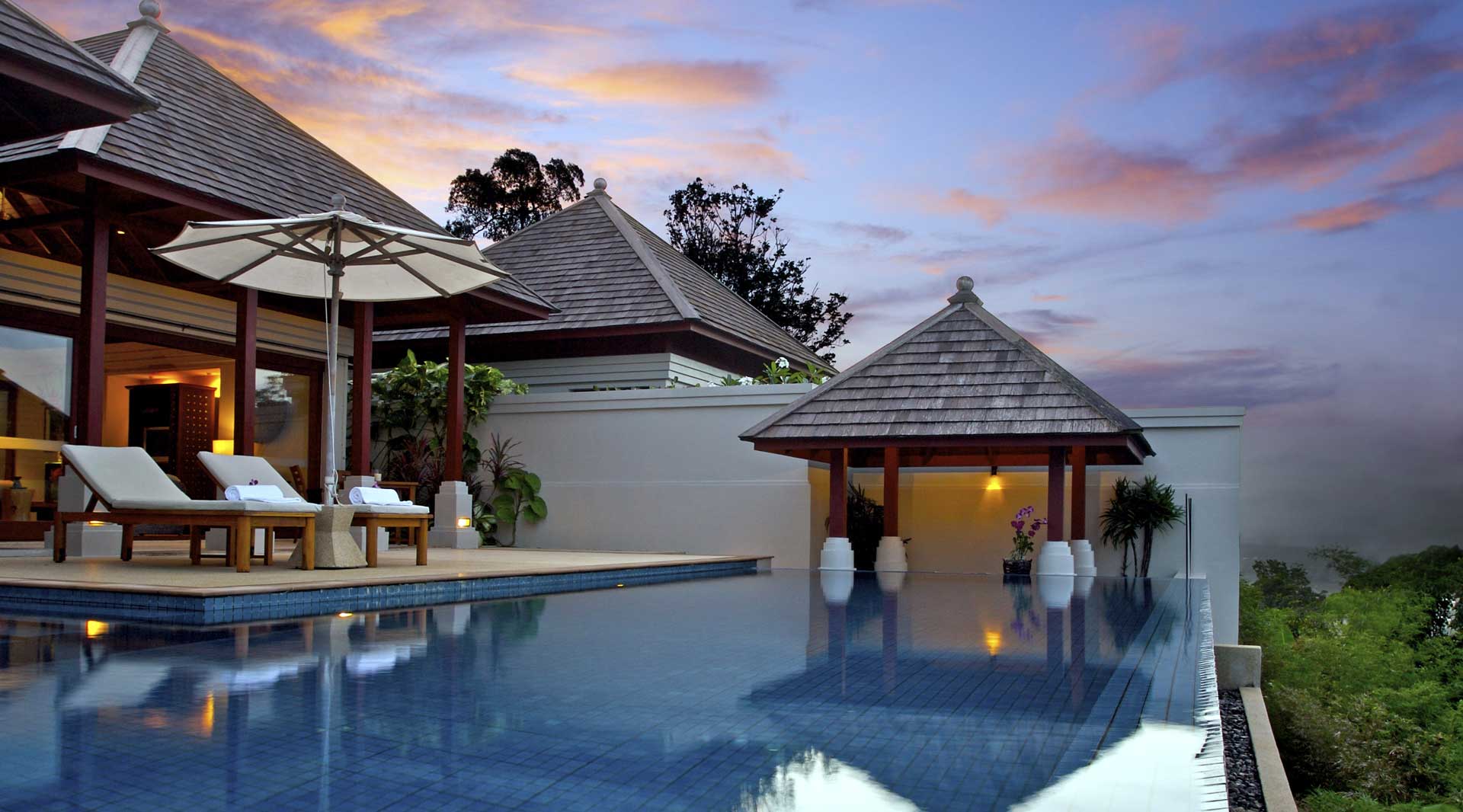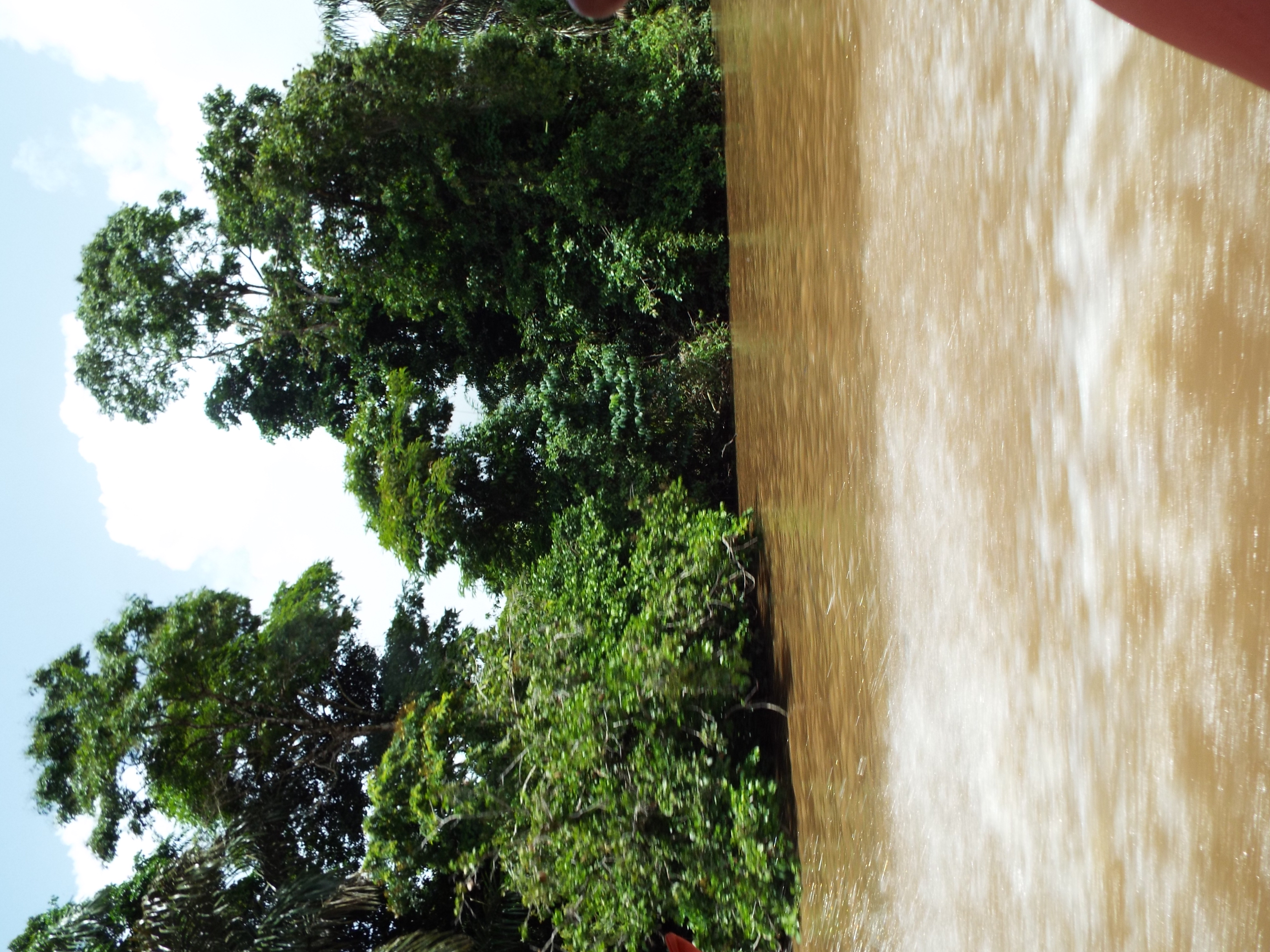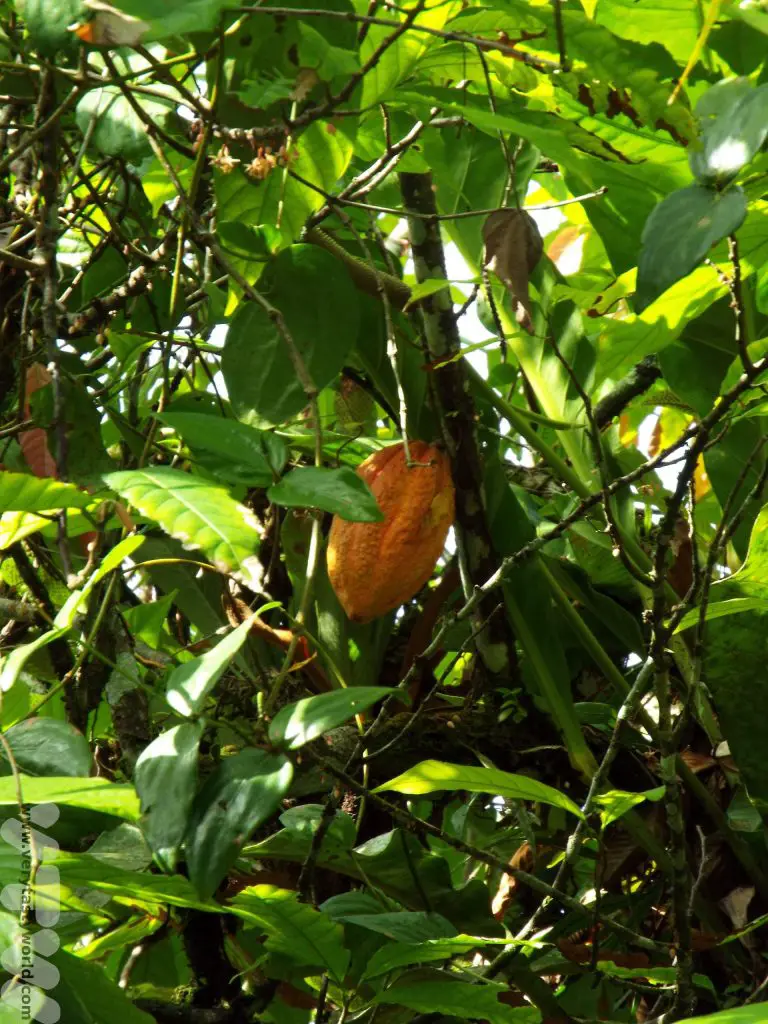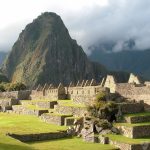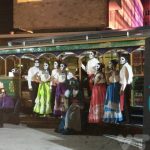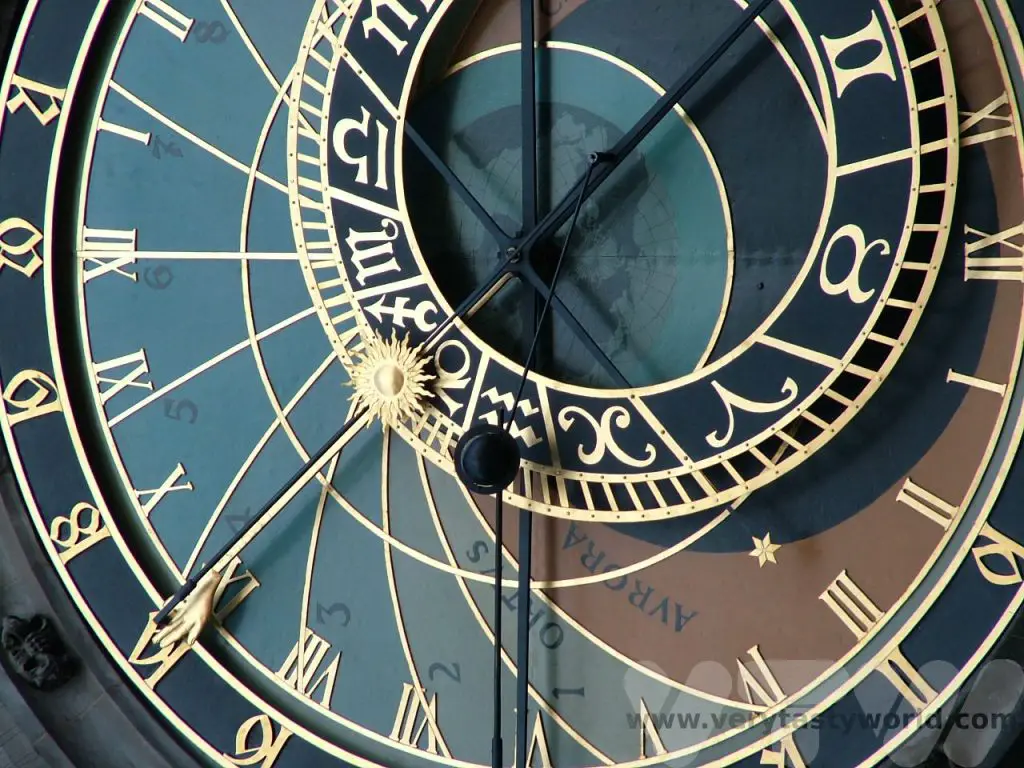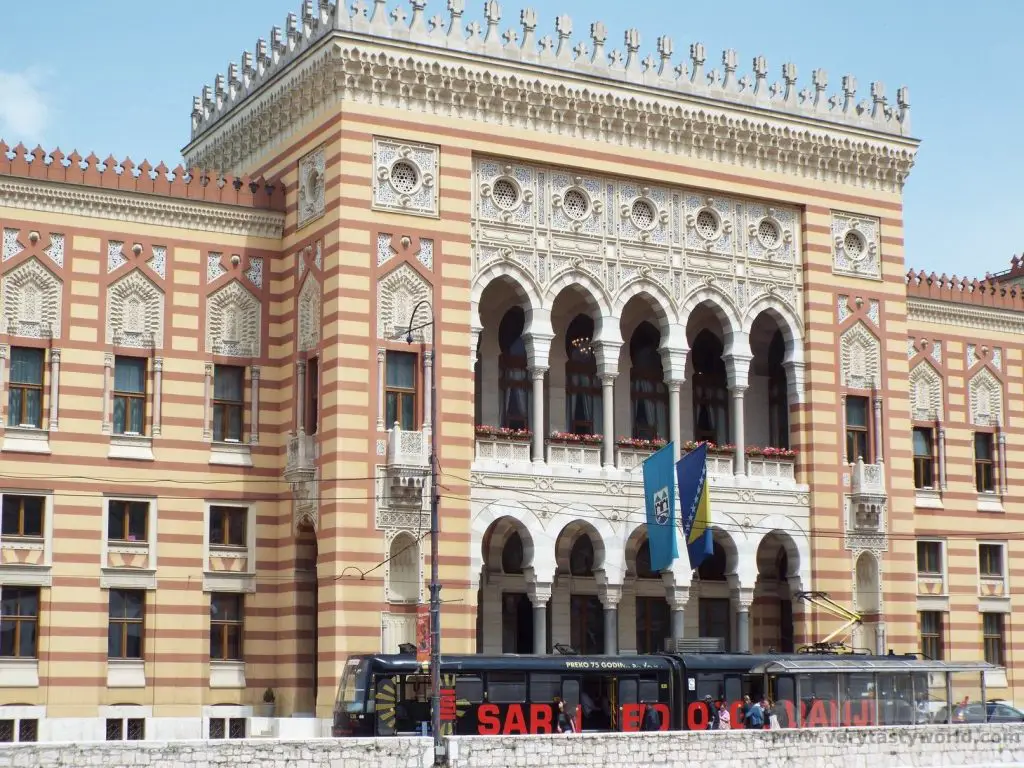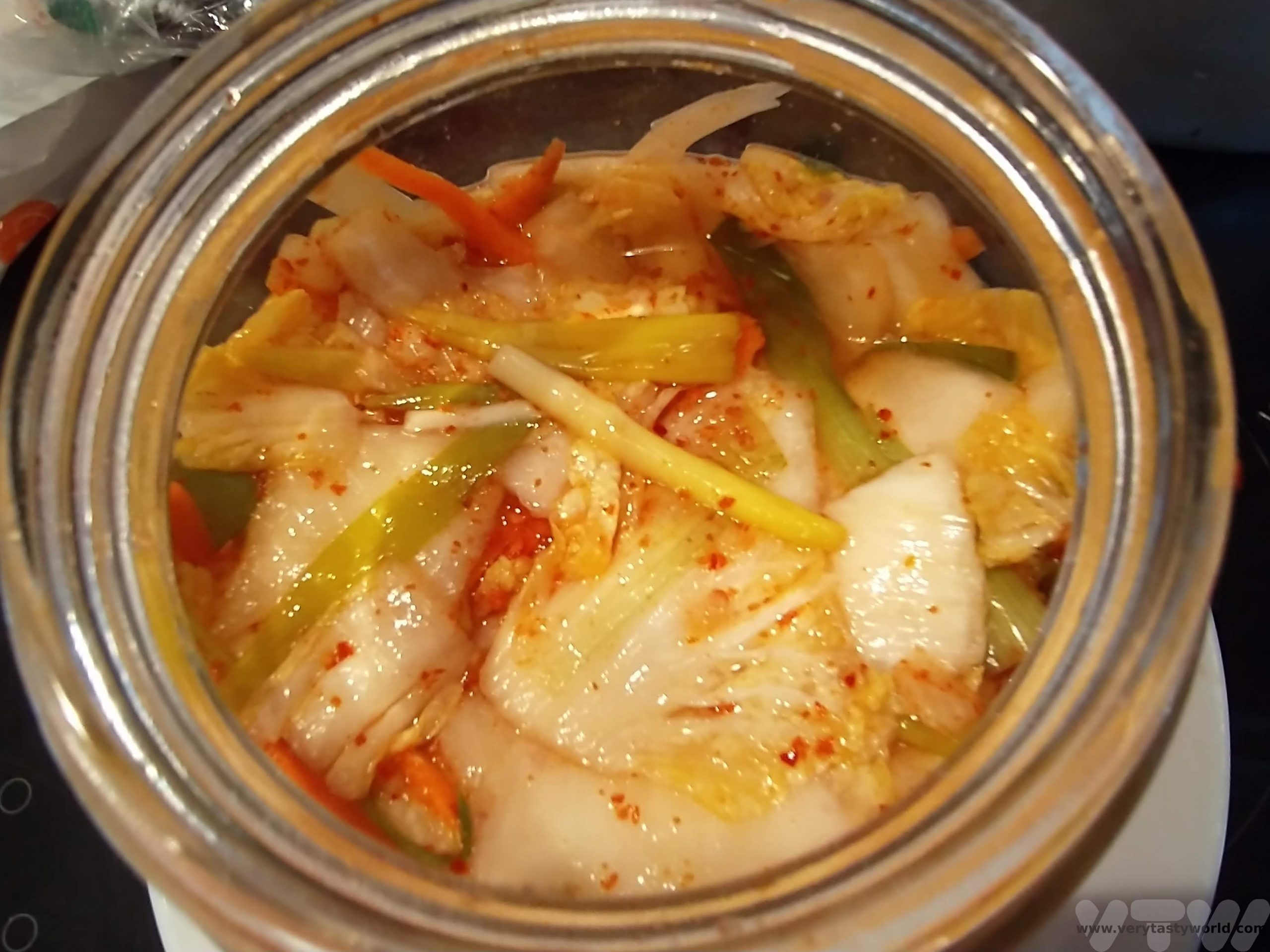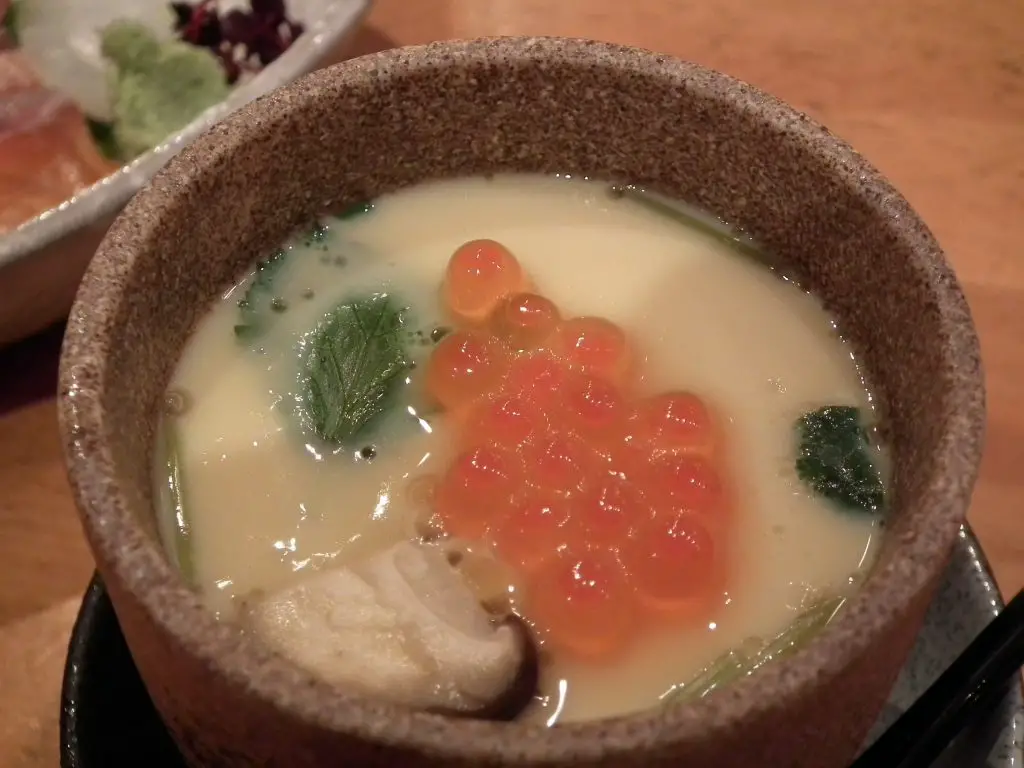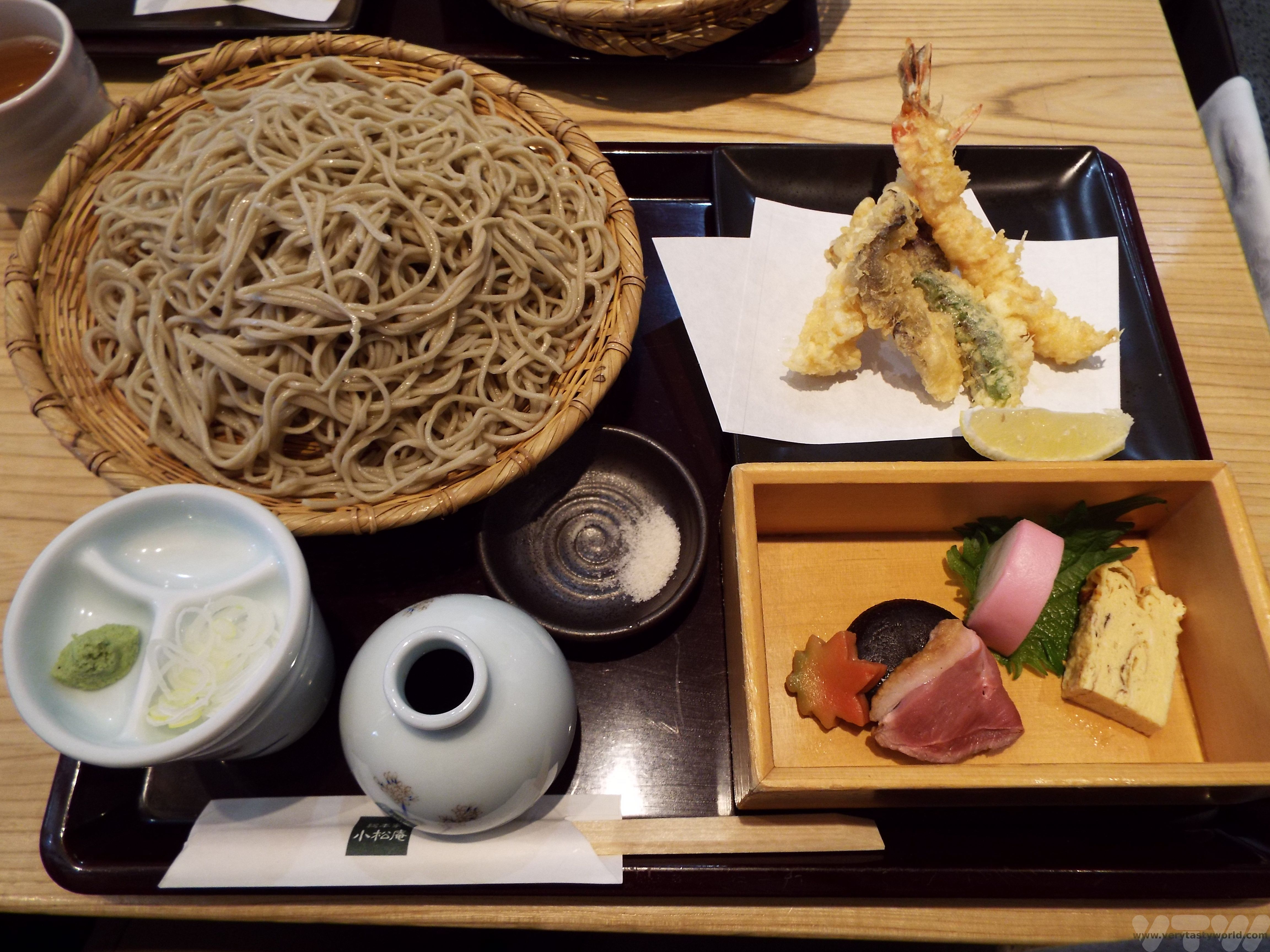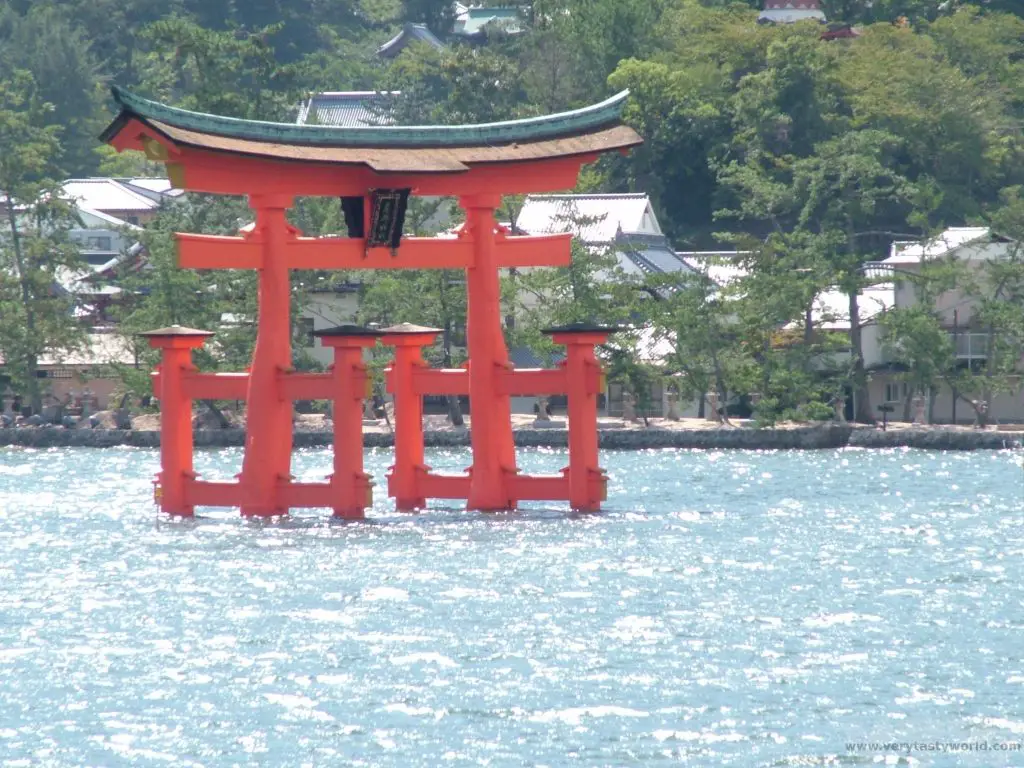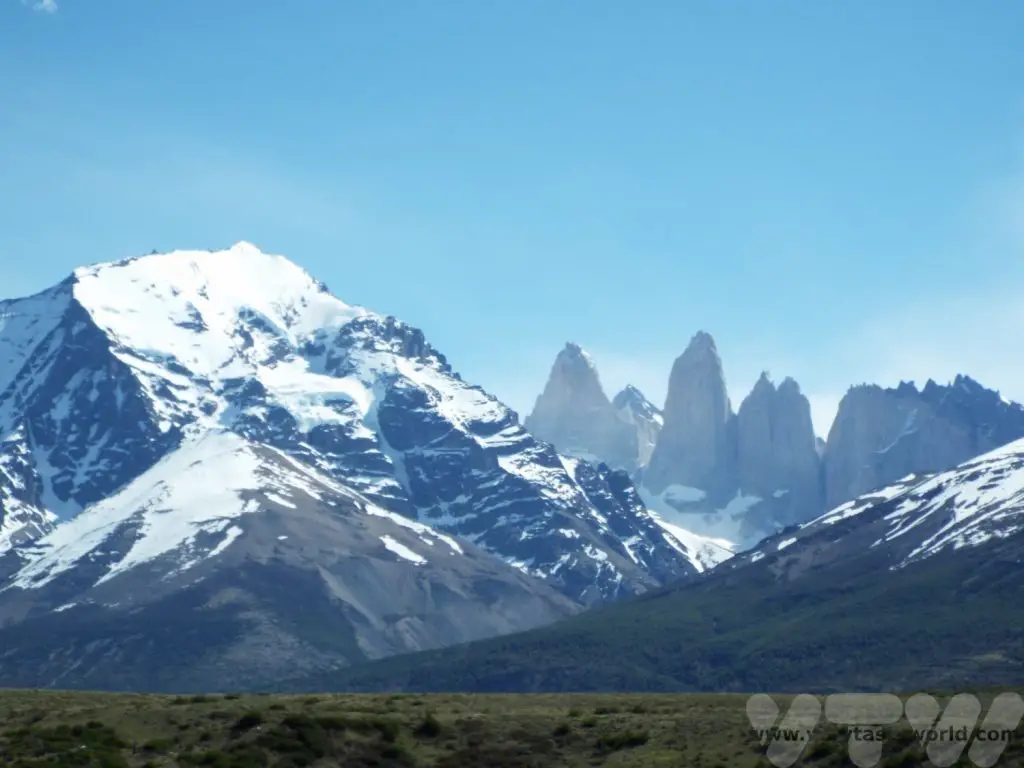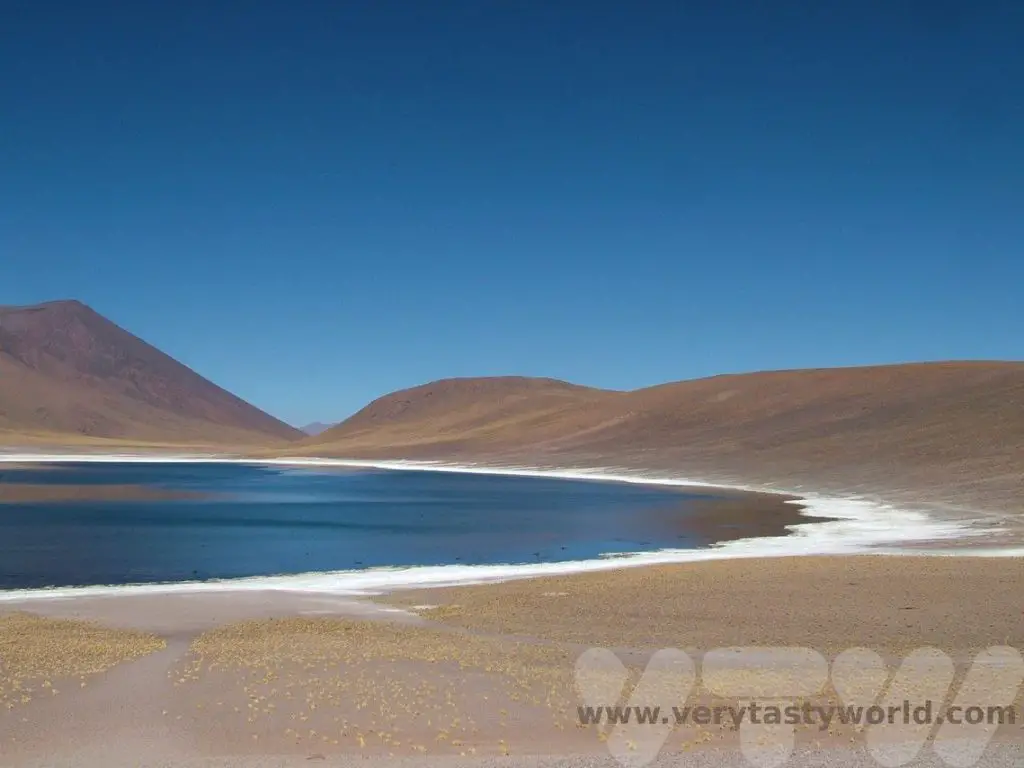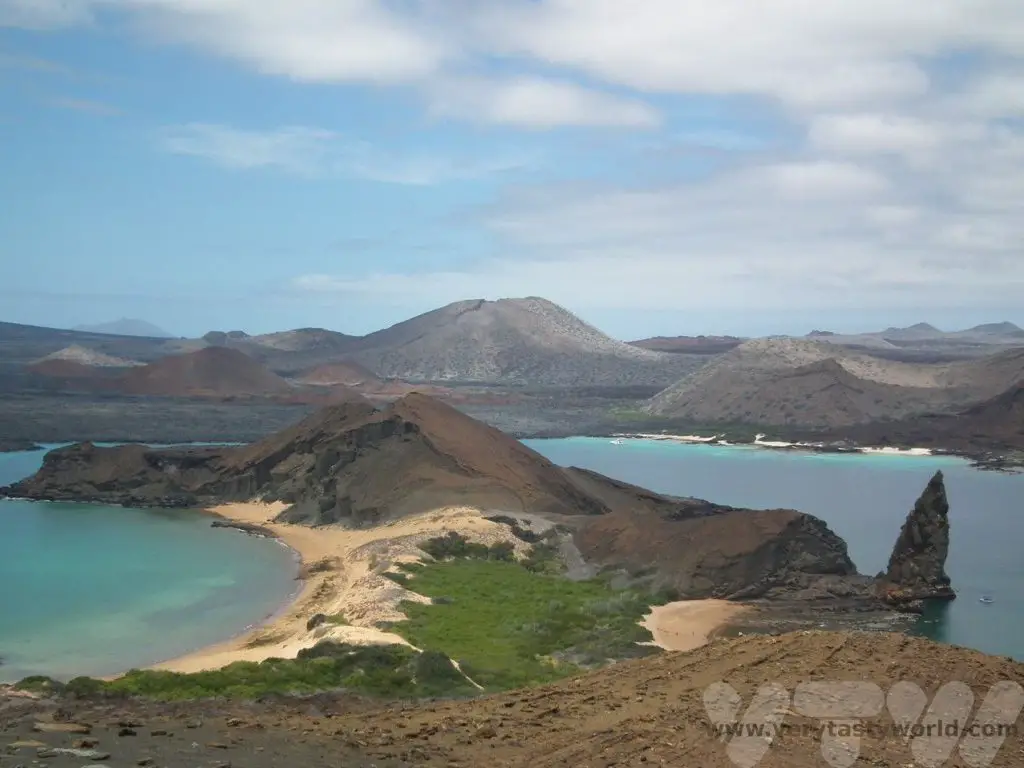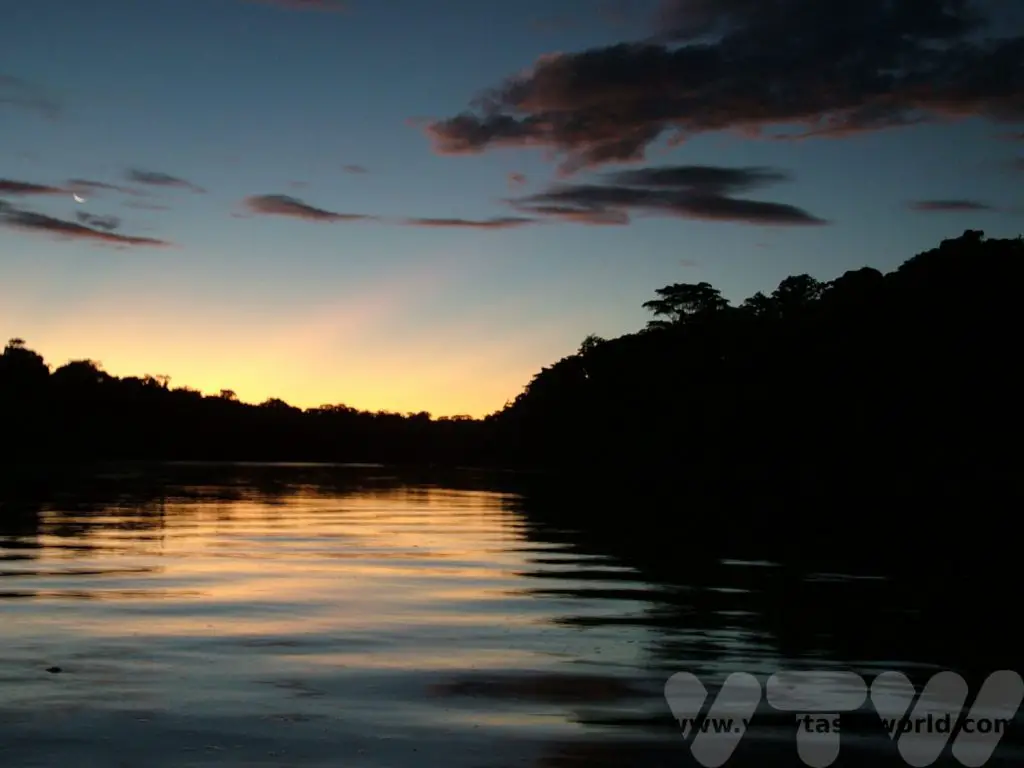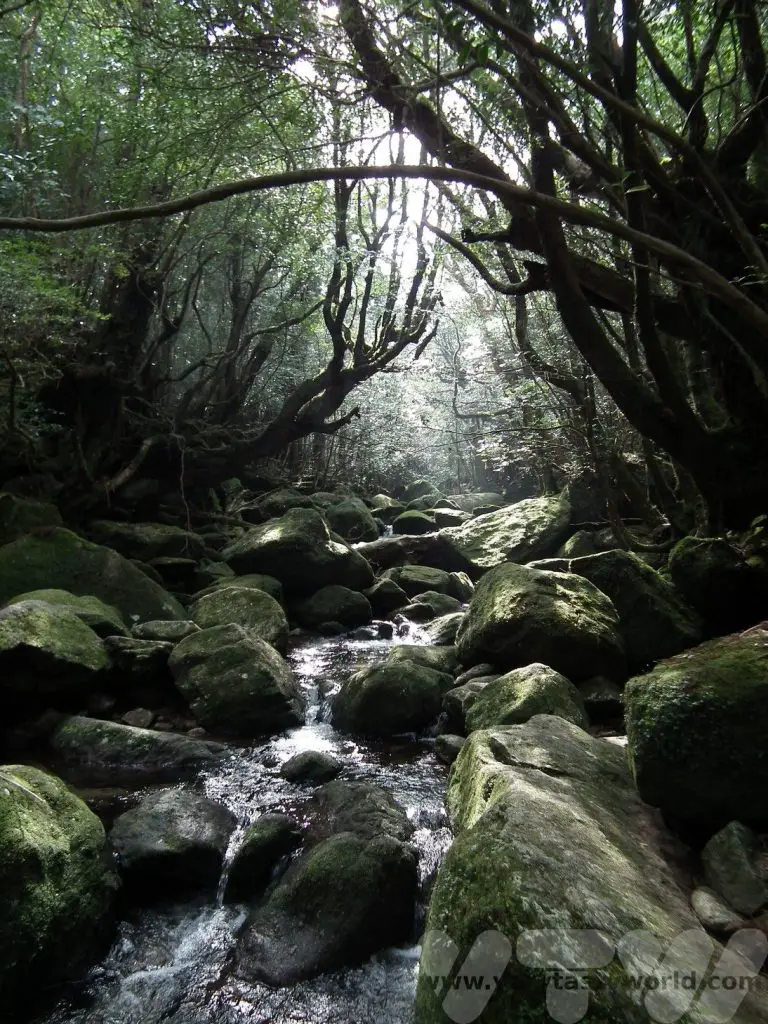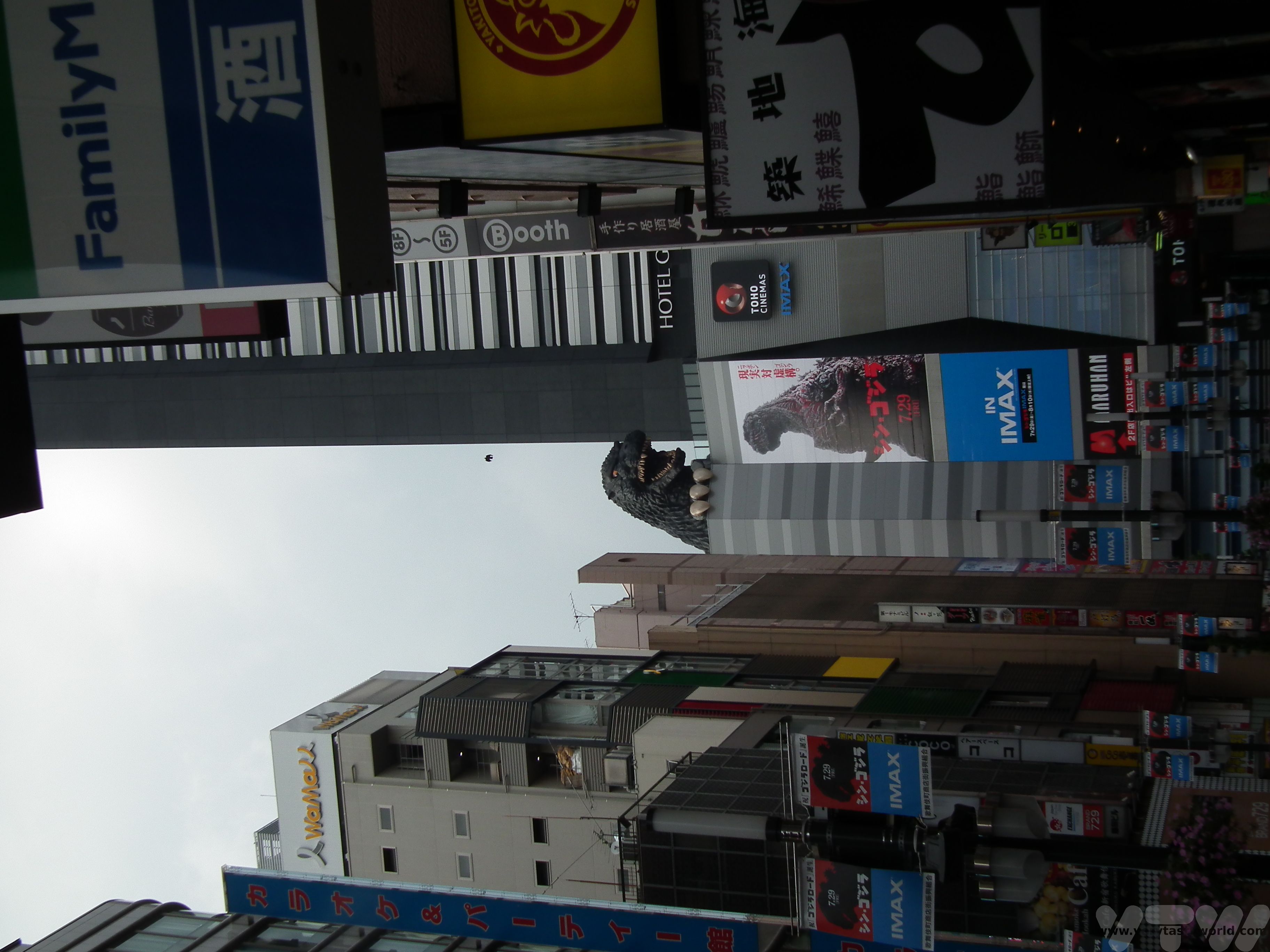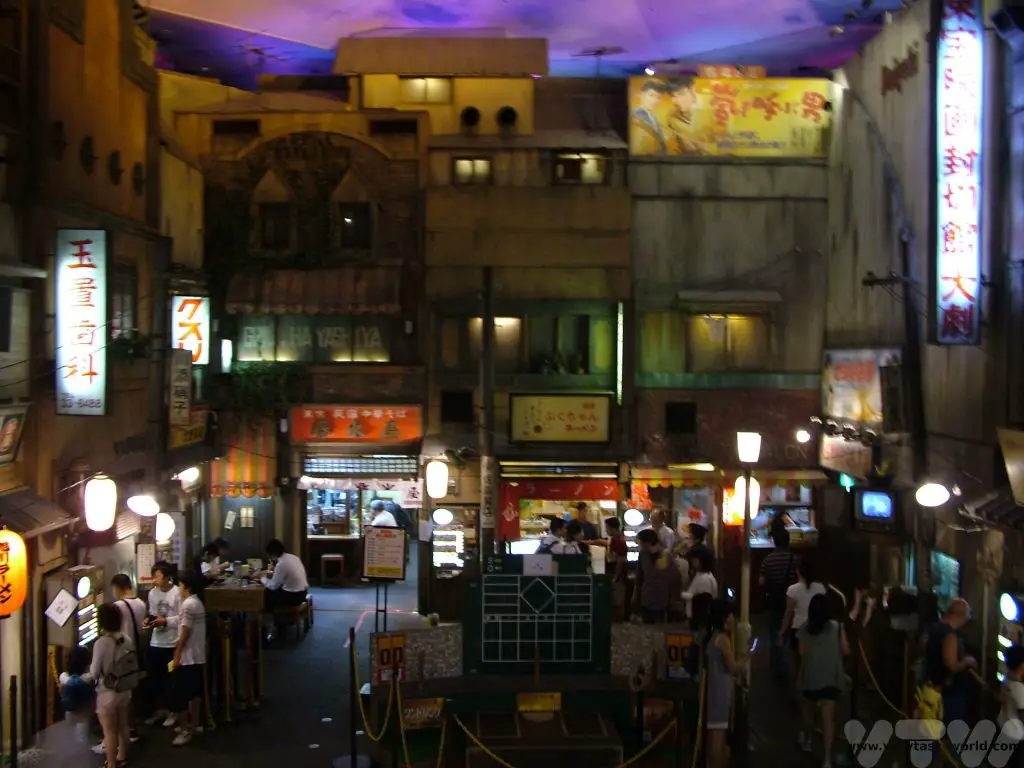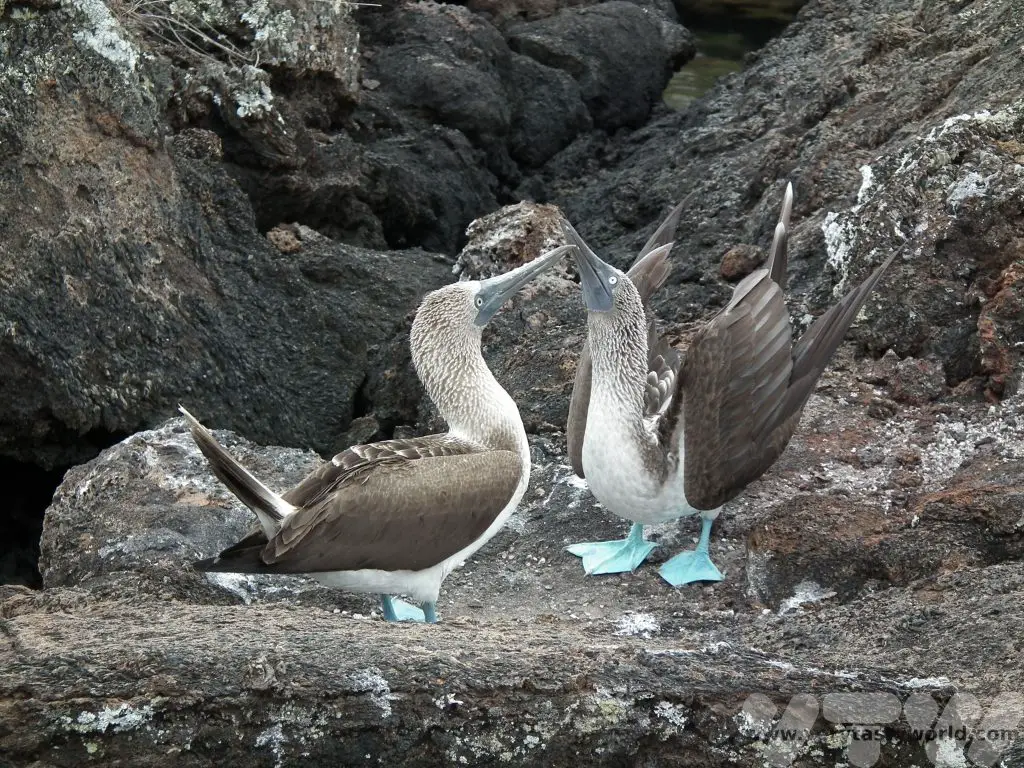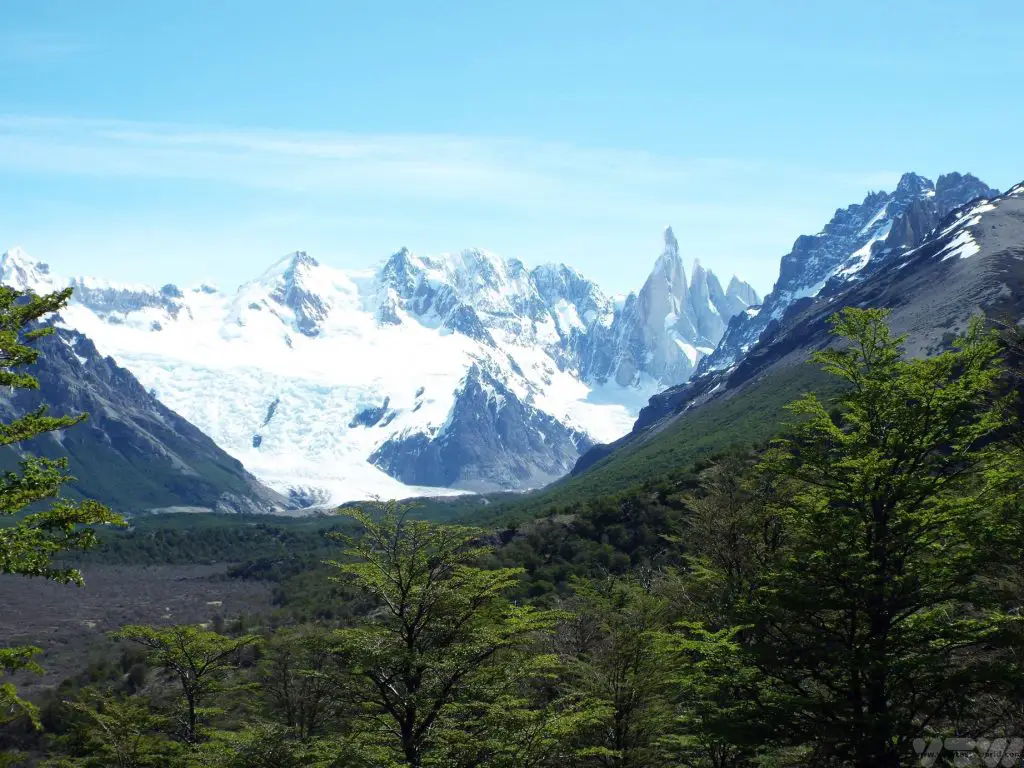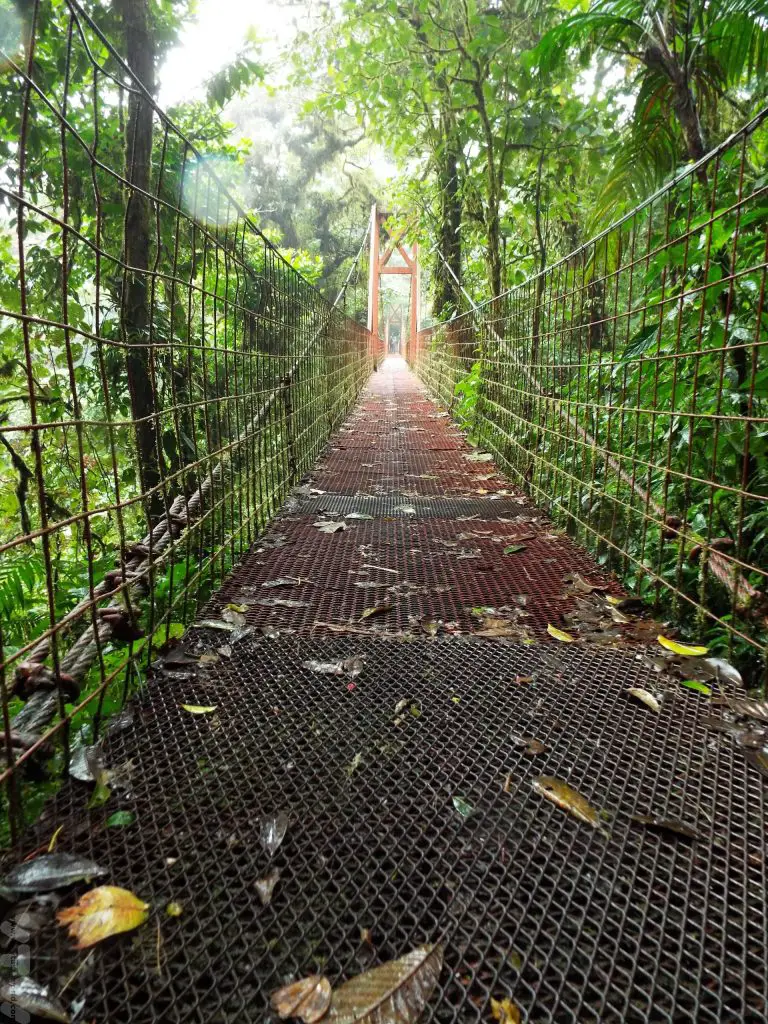Setsubun Food – Bean Throwing Day
Feb 3rd is Setsubun in Japan. Which means that it’s mame maki, or bean throwing, day. Setsubun is one day before Risshun – the first day of spring in the lunar calendar. It’s not considered to be the official new year, which is celebrated on the 1st January, but rather a new start. There are various ceremonial activities associated with the festival, including setsubun food.
Traditionally people throw roasted soy beans (fuku mame) at home, with the shout of ‘oni wa so to’ (get out demons!) and ‘fuku wa uchi’ (come in happiness!) Sometimes the beans are just thrown out of the front door but they may also be thrown at a family member wearing an oni – demon – mask. If people eat the number of fuku mame that’s equal to their age it’s believed that they will be healthy and happy for the year ahead.
Bean throwing ceremonies also take place at shrines across Japan. The Senso-ji temple in Asakusa will have thousands of visitors arrive to take part. Celebrities and sometimes sumo wrestlers are known to turn up to some of the events.
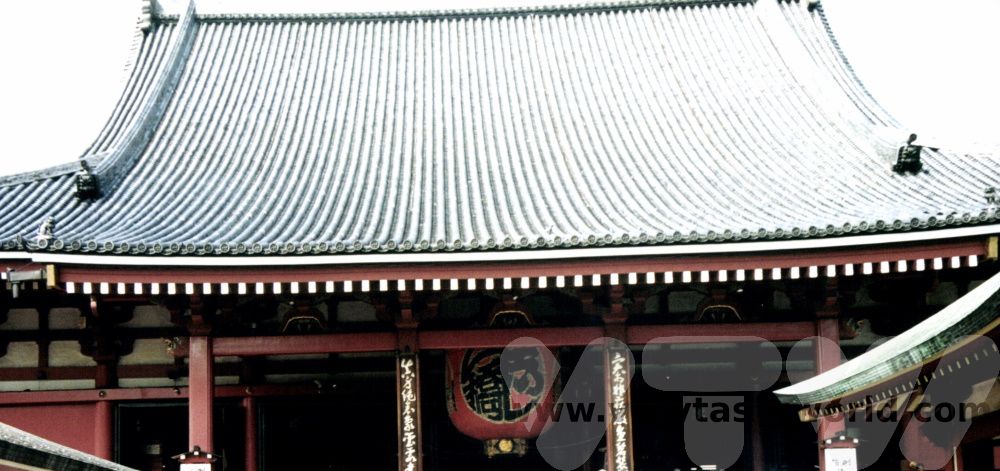
Setsubun Food Tradition
Over the years a foodie setsubun tradition has developed. This is thought to have originated in the Kansai region, in Osaka (always a great place for foodies!) and has become more popular throughout Japan over the years.
It involves eating ehomaki (good luck direction rolls) which are sushimaki rolls that haven’t been cut up. The idea is to eat the roll while facing in the lucky direction. You will need a compass because the direction is quite specific. Last year was the year of the rabbit and therefore the direction was south-south-east. 2024’s direction is east-northeast for maximum luck.

We often make maki rolls using a bamboo rolling mat. They are the easiest sushi to make, even for clumsy cooks such as we. When you’ve had a go at making nigiri or gunkan sushi you realise why it takes 10 years to train as a sushi chef!
There are lots of options for ehomaki filling. One of our favourites is maguro tuna with spicy kimchi and mayo.



- Recipe: Simmered Shiitake Mushrooms

- How to Use Public Transport in Japan

- RECIPE Oyakodon Donburi

- Planning a Trip to Japan

- The Makanai: Cooking for the Maiko House

- Setsubun Food – Bean Throwing Day

- The Gassho Farmhouses of Rural Japan
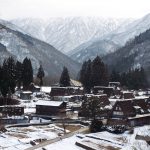
- Recipe: Japanese Simmered Pork Belly – Buta no Kakuni

- RECIPE: How to Make Umeboshi


- RECIPE Oyakodon Donburi
- Zero Waste Recipes Before Your Holiday
- RECIPE: Vegetable Biryani Tamil Nadu Style
- RECIPE: Vegan Wild Garlic Pesto
- Recipe: Venetian Pasta Sauce
- RECIPE: Biryani Raita Recipe
- RECIPE: How to Make Costa Rica’s Gallo Pinto
- Recipe: Japanese Simmered Pork Belly – Buta no Kakuni
- RECIPE: How to Make Umeboshi
The Food of The Azores
The Azores are a tiny archipelago in the middle of the Atlantic Ocean and an autonomous region of Portugal. Their location means that they are an absolute magnet for marine life viewing because they have resident whales and dolphins, as well as many migratory species, such as the blue whale, which pass close by to the islands each year. We spent a week on Sao Miguel, the largest island, enjoying whale/dolphin watching excursions as well as some activities on the island, such as mountain biking and kayaking. But we didn’t realise what a great foodie destination the islands are. In between the activities we enjoyed some fantastic food of the Azores.
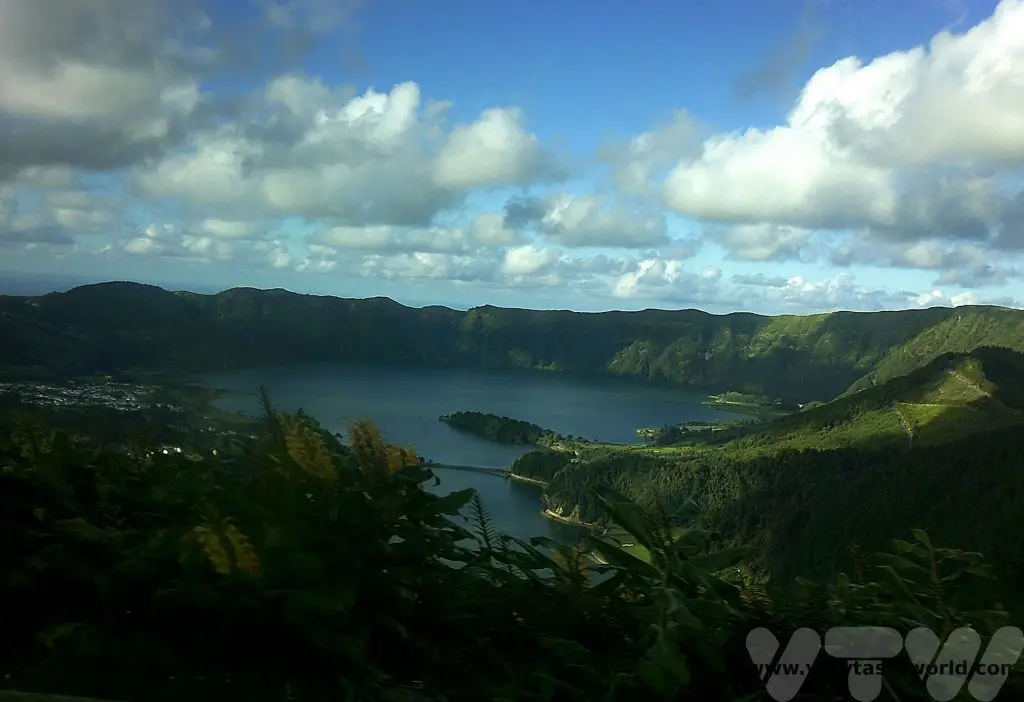
We stayed in the main town of Ponta Delgada. It’s a pretty place and has all amenities within walking distance.
Cheese – Food of the Gods!
One of the things we noticed when travelling through the beautiful green countryside was the number of cows and also fields of ripening corn. The corn is actually more likely to be grown to feed cows than people.
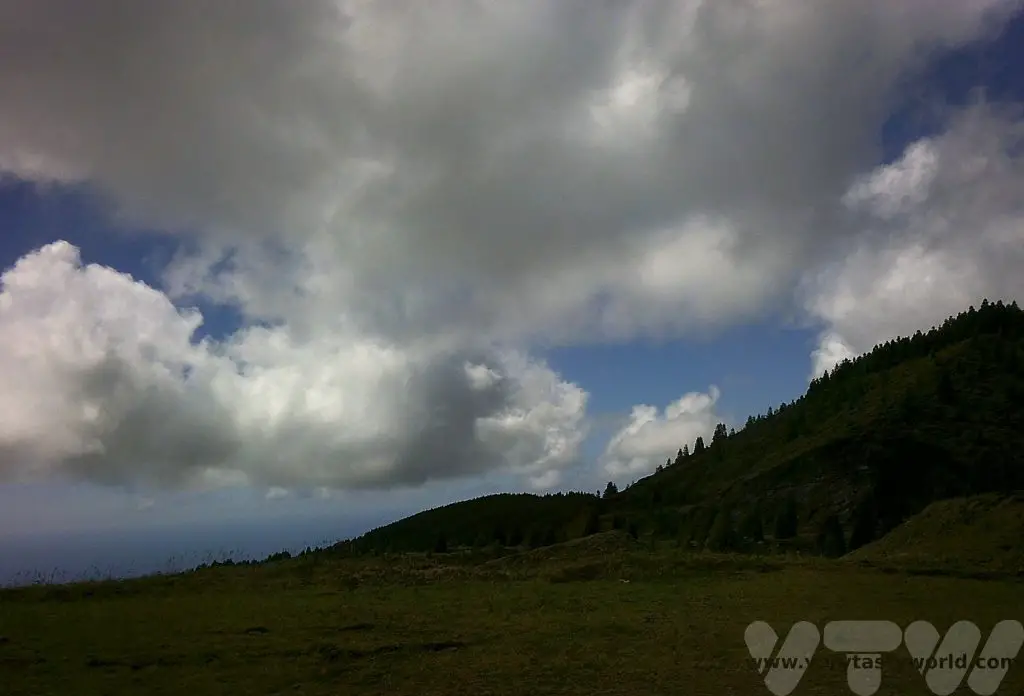

With mild winters and lots of rain the vegetation is lush and that’s perfect for the cows who produce rich milk that is turned into cheese. We were surprised to learn that around 50% of Portugal’s cheese is produced in the Azores.
Another striking feature of the landscape is the plethora of hydrangeas that line the roads. The cows tend to ignore them so they become natural fences that look glorious in the height of summer. We visited just after they were at their best but they still looked very pretty.
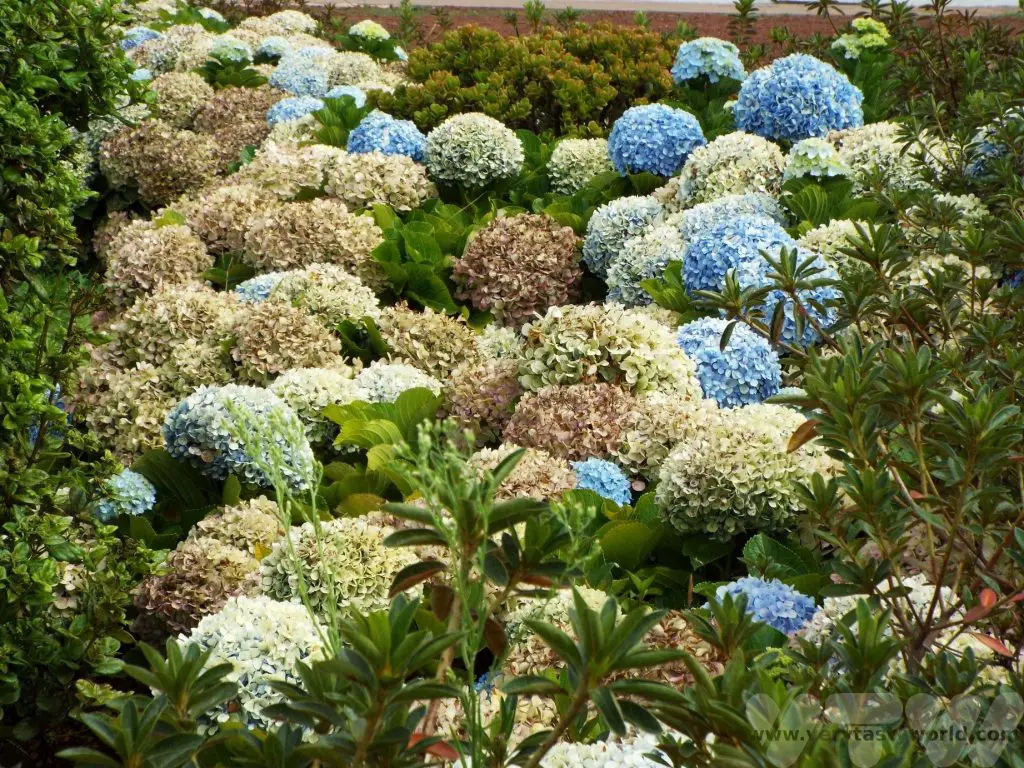
There are various cheese shops in Ponta Delgada – King of Cheese and Prince of Cheese – they aren’t modest about the quality of the product!
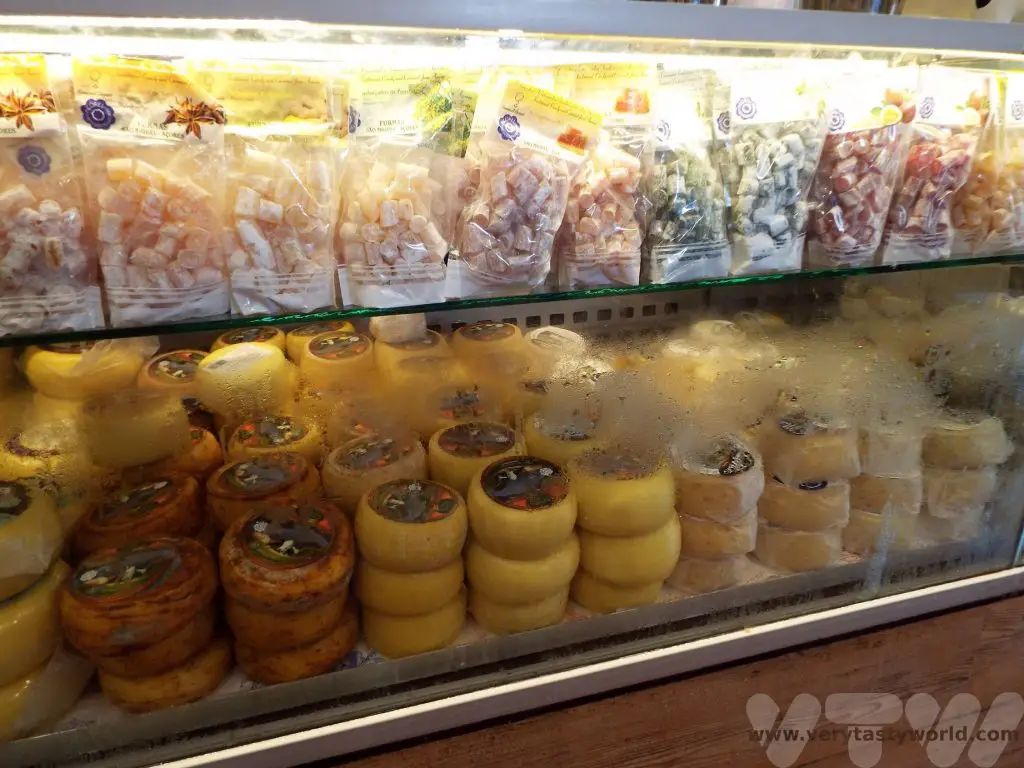
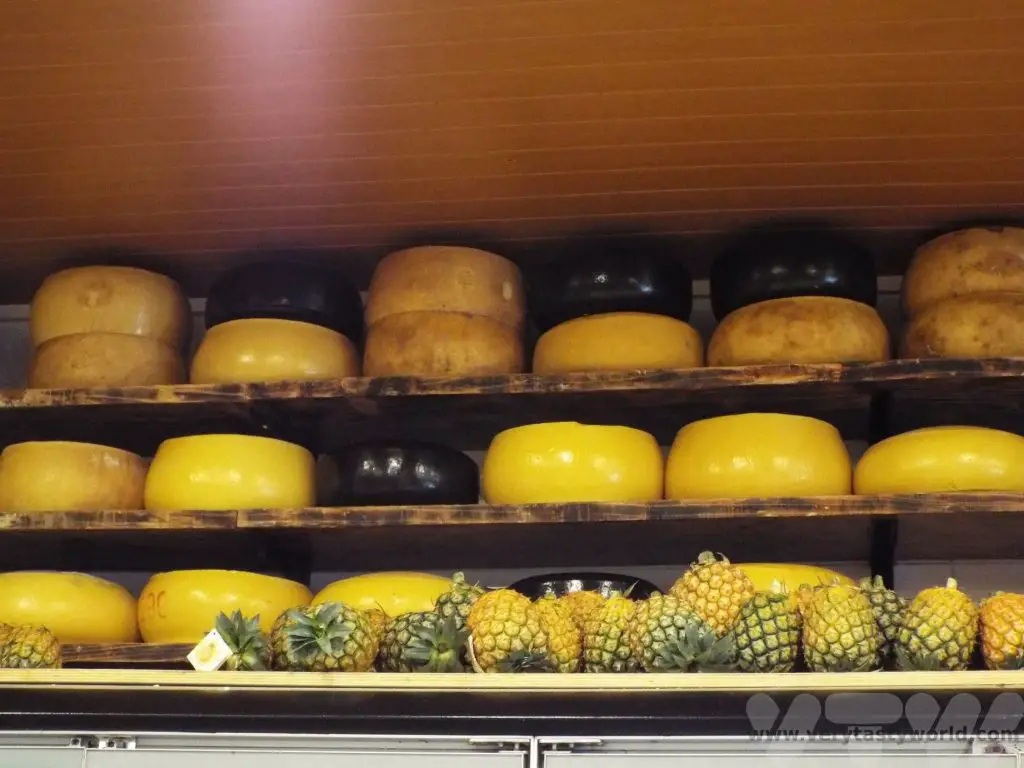
It’s fun visiting the shops – you can let them know about your cheesy preferences and they will recommend particular flavours and offer you a sample. We were keen to bring some cheese home and they were able to vacuum pack some very large slices for us so that we could store them in our hotel fridge and get them on the flight home. They survived very well and made sure that we weren’t going to run out of cheese for several weeks.
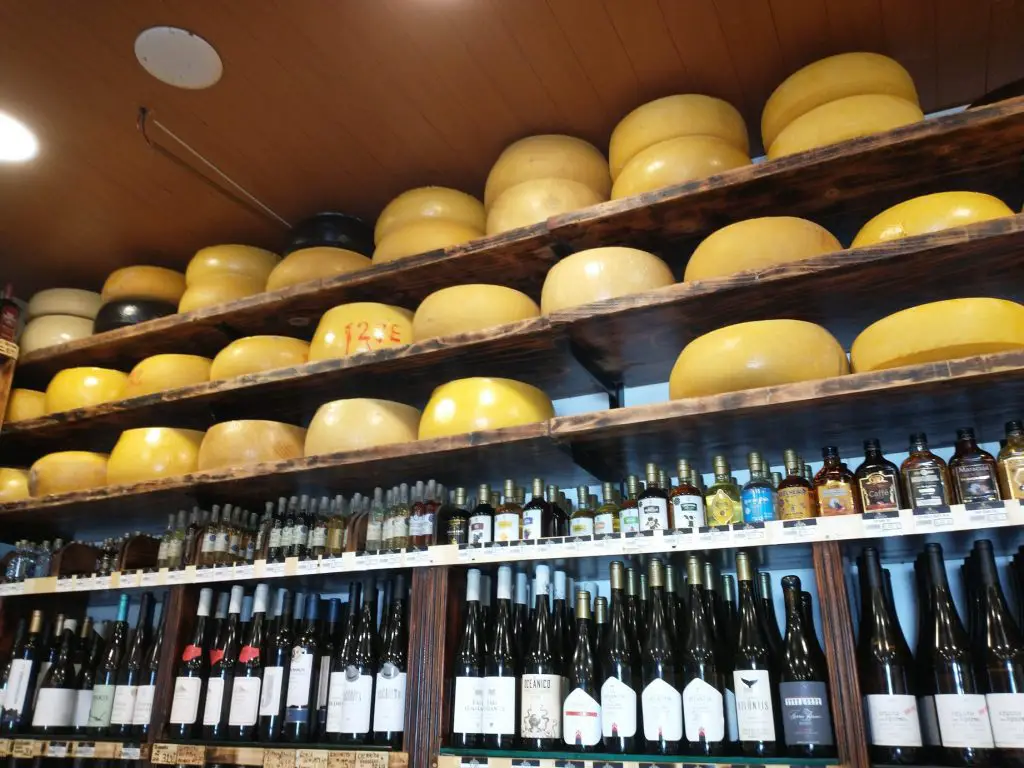

Sao Michel has a black rind and is the premier cheese of the island we were staying on. It’s a hard, very mature cheese with a lovely sharp flavour.
Sao Jorge cheese is produced on the Azorean island of the same name. It is a semi-hard cheese made from unpasteurised milk. It is milder than the other cheeses, with a nutty flavour


Vaquinha is from the island of Terceira. This one has a surprising initial creaminess for a hard cheese but this eventually flakes slightly. It is very mature, is almost spicy and has a real kick to the flavour!
Cheese is often provided as an appetiser at restaurants but this isn’t matured cheese, it is queijo fresco. It doesn’t have the fullest of flavour, in fact it’s pretty bland, so it is served with pimenta da terra (red pepper paste) which gives it a real pzazz, and it’s eaten with fresh bread. We were able to bring back a bottle of pimento de terra home with us.
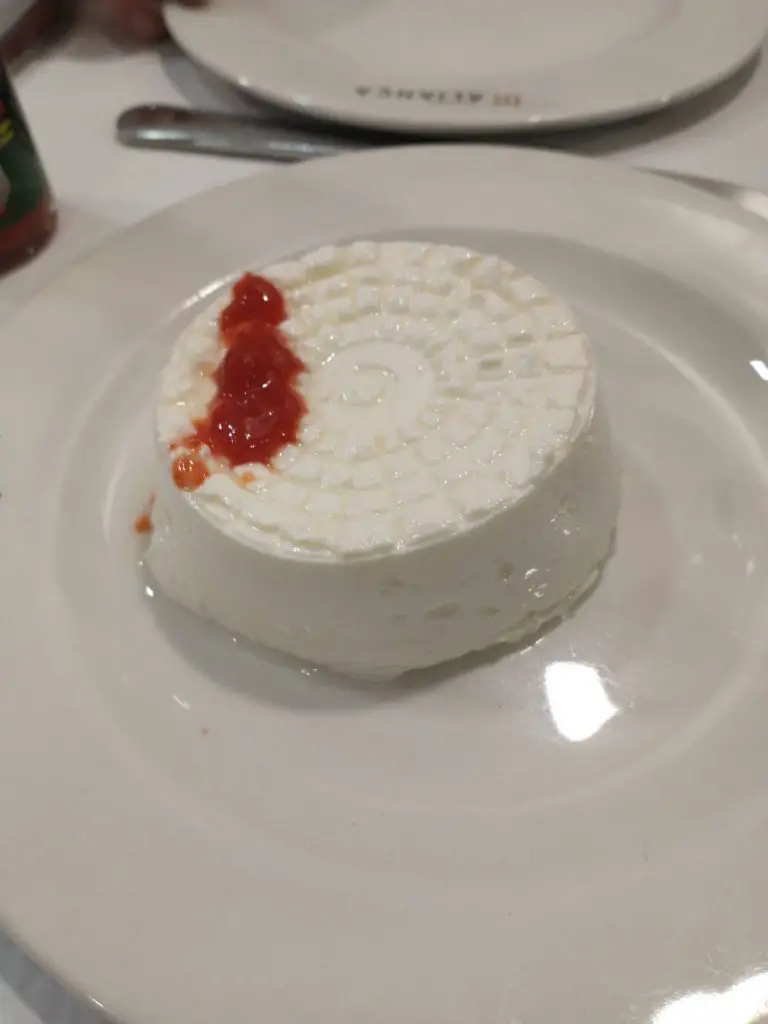
What Goes Well with Cheese? Pineapple of Course!
There is a pineapple plantation, located just outside Ponta Delgada, easily within walking distance of the city centre. You can visit the greenhouses and see the pineapples growing.
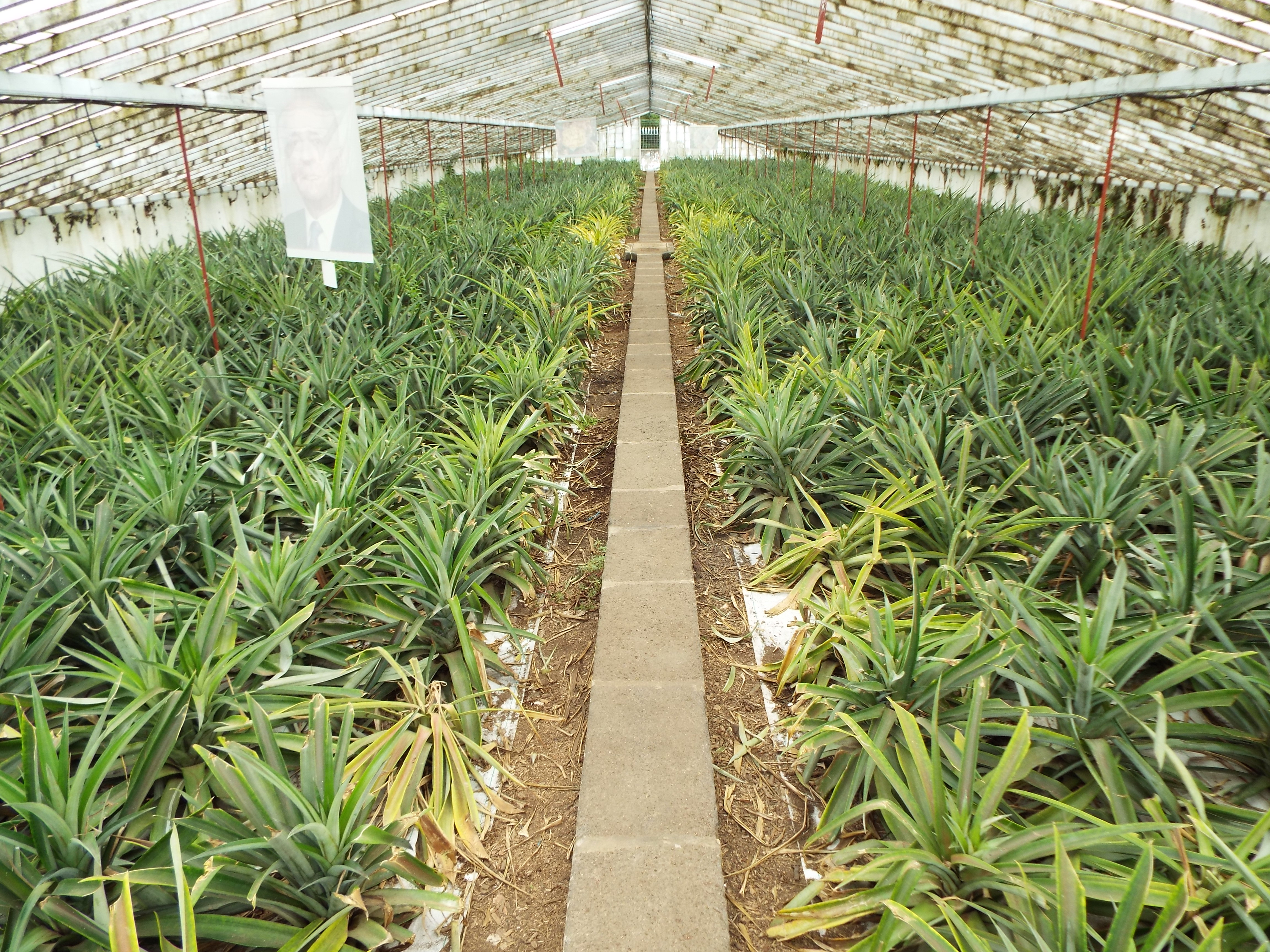
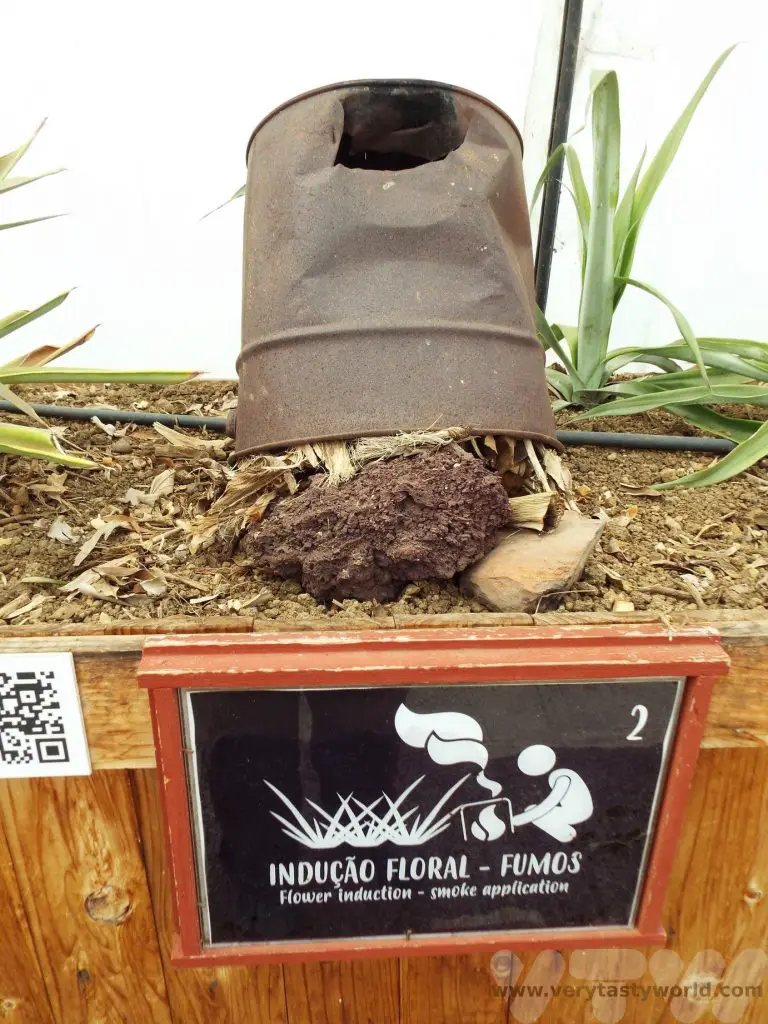
There are also some displays and videos which show the process for growing these fruit. It’s interesting that they use a smoking process to trigger the flowering of the plant.
And there’s a café on site which offers a complimentary shot of pineapple liqueur and a teeny piece of toast with pineapple jam.
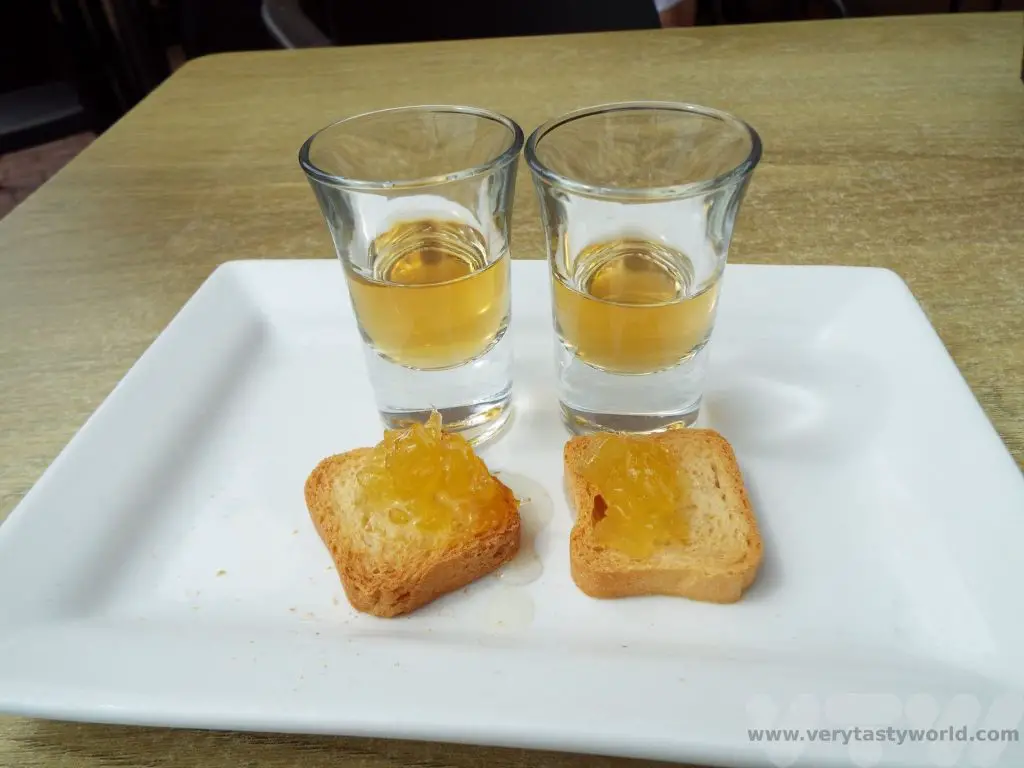
And, as we hadn’t had elevenses or lunch, we thought it would be rude not to enjoy a pineapple gelato, washed down with a caipirinha, a delicious cocktail made with crushed pineapple, lime and rum.
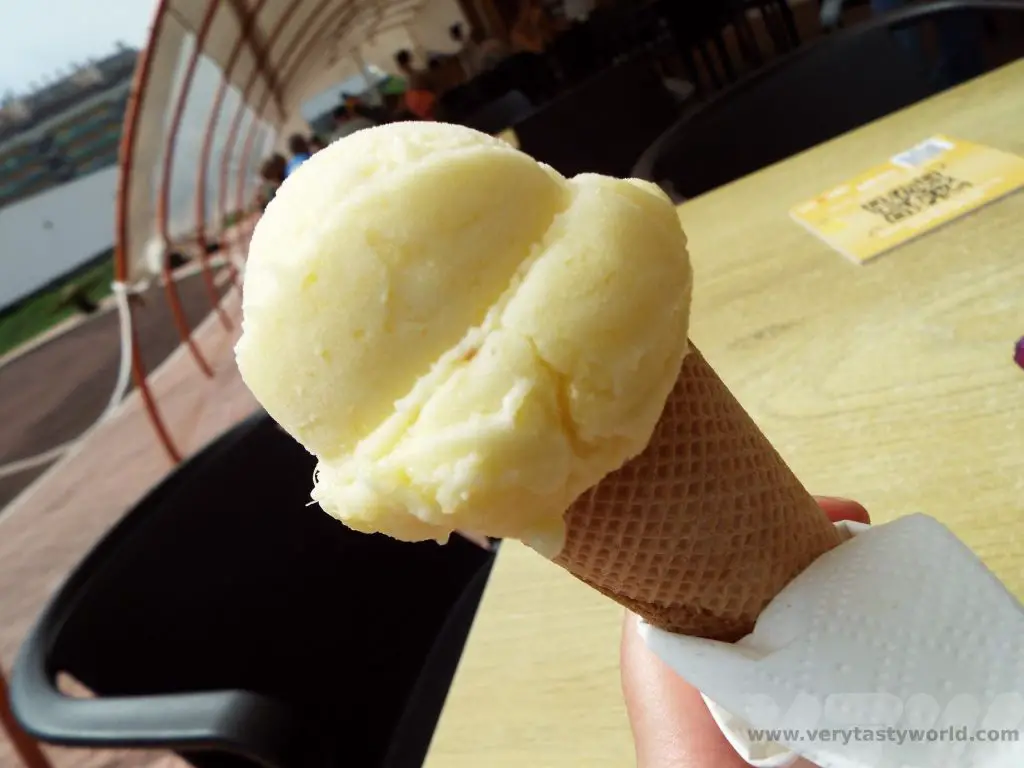
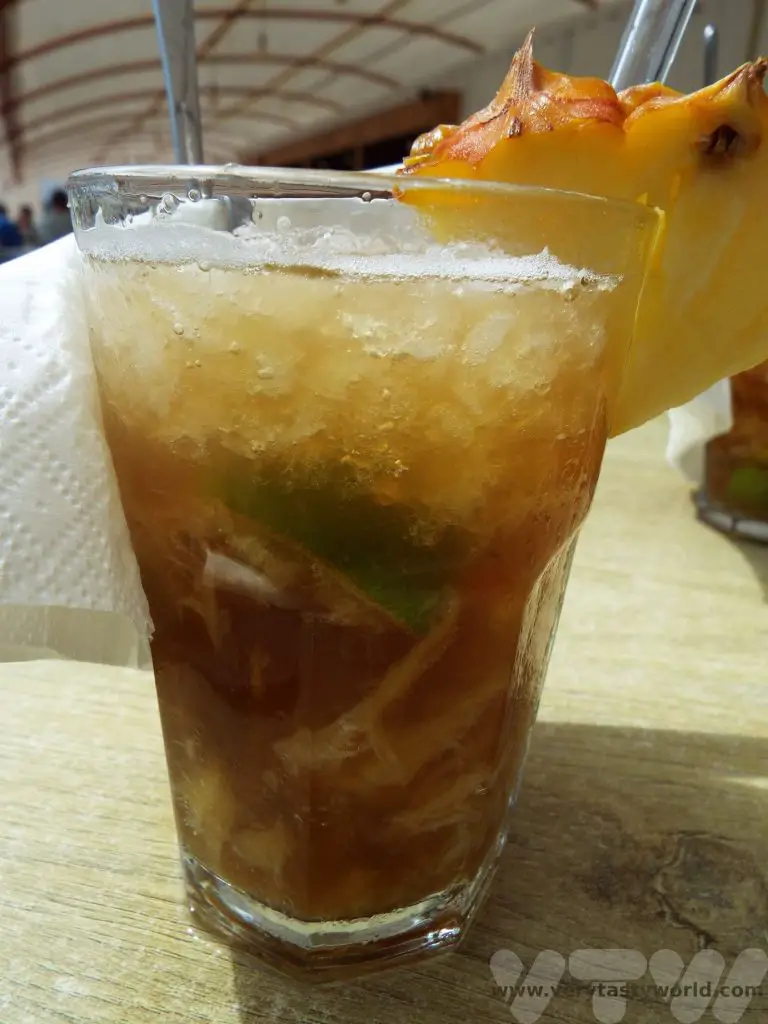
Everything Stops For Tea
The Azores also have a tea plantation, located on the north coast of Sao Miguel. The Gorreana Tea Factory was established in 1883 and is one of only two tea plantations in Europe. It’s possible to visit the factory and do a self guided tour.
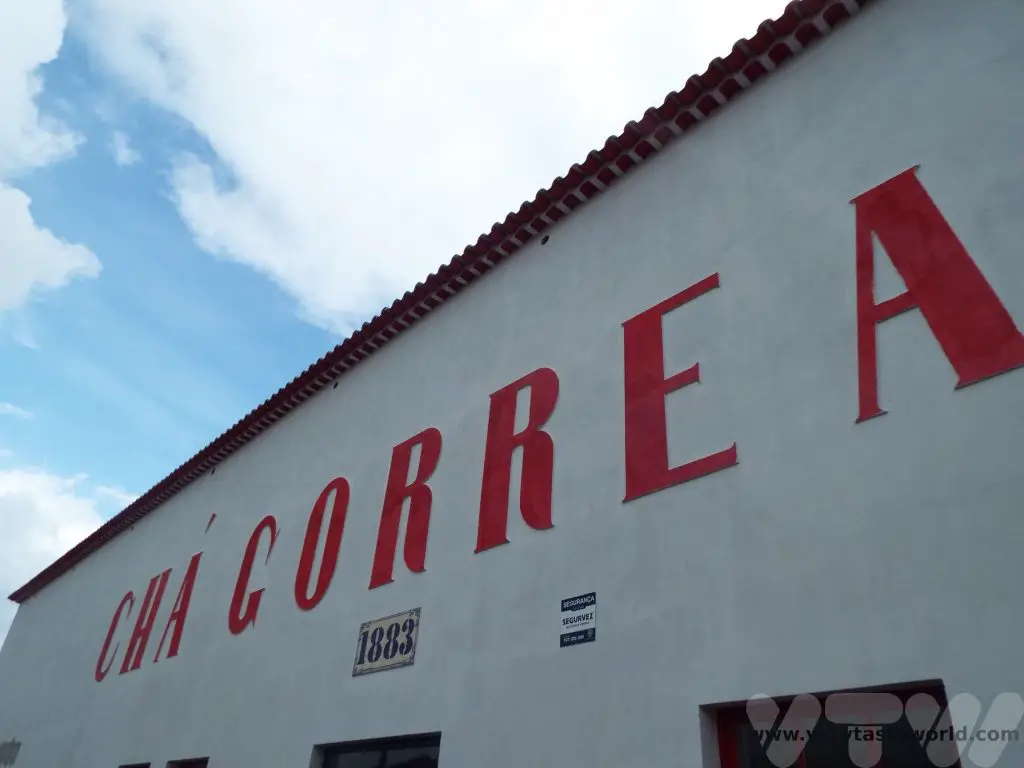
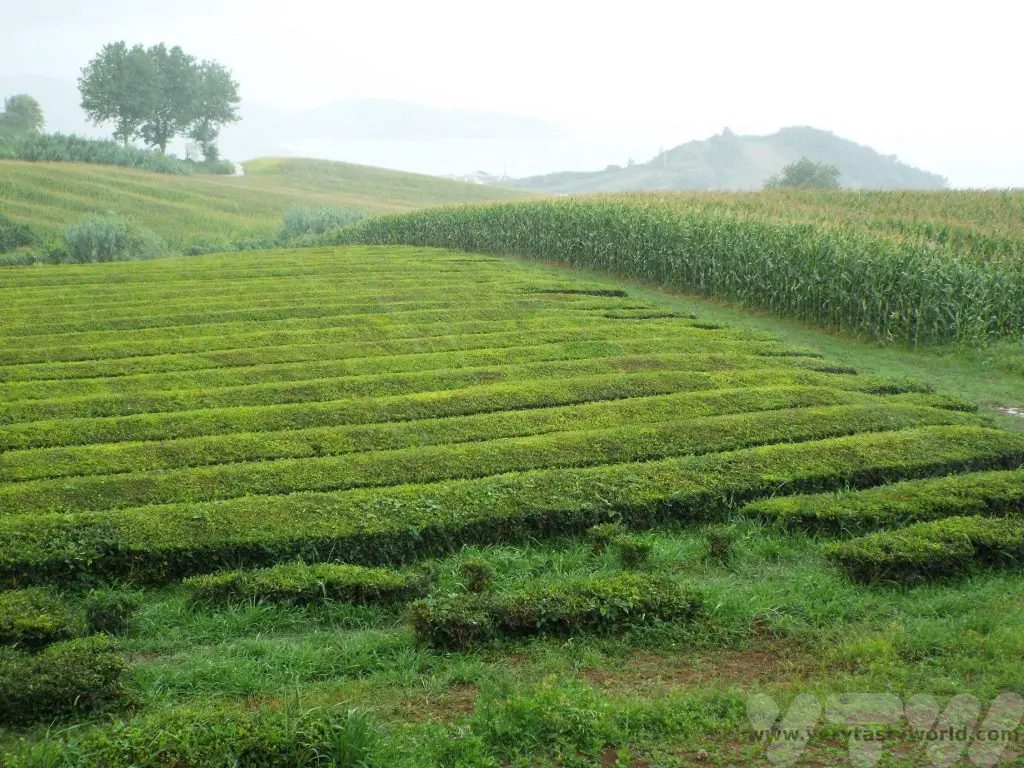
There are infographics showing how the tea is processed and you can enjoy a cup of their tea as well as visit the inevitable shop and café. They produce both green and black tea. Both taste good.
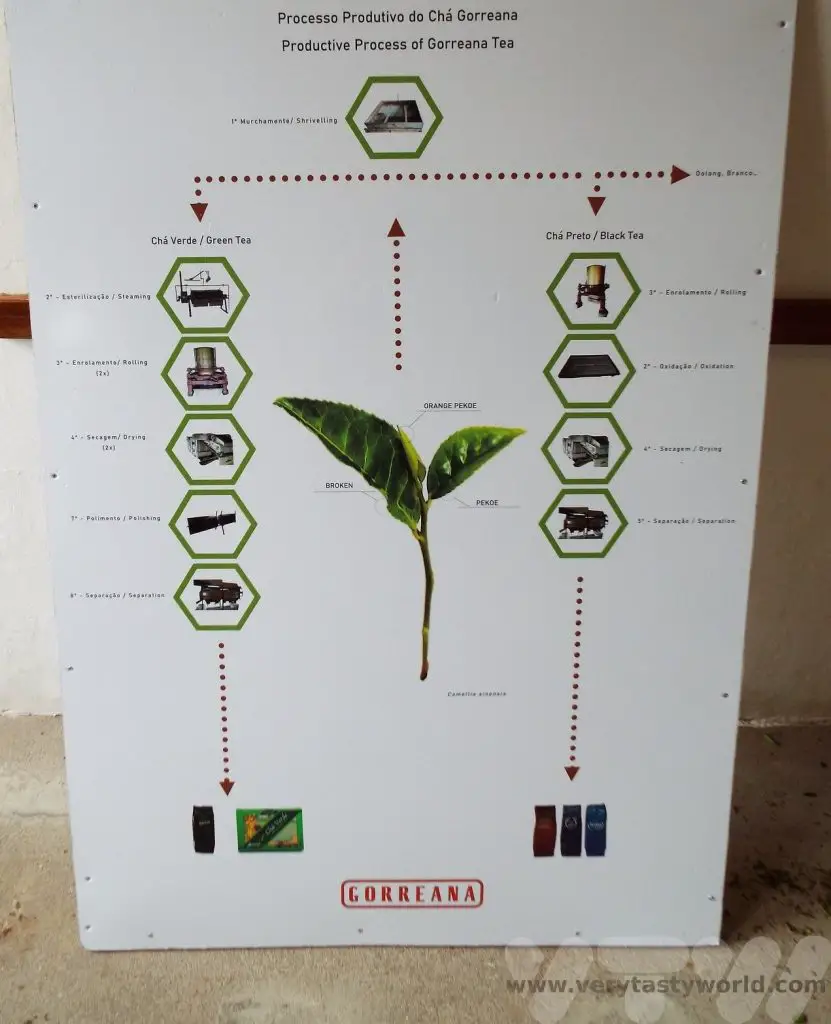
It’s lovely to be able to see the original machinery in action.
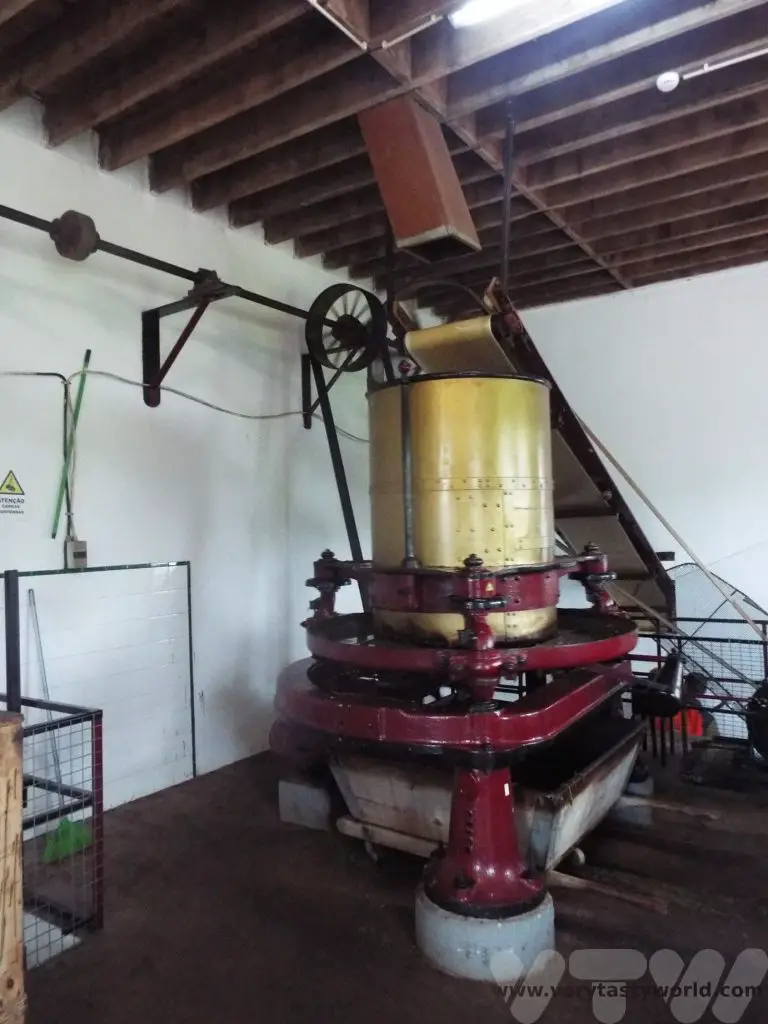
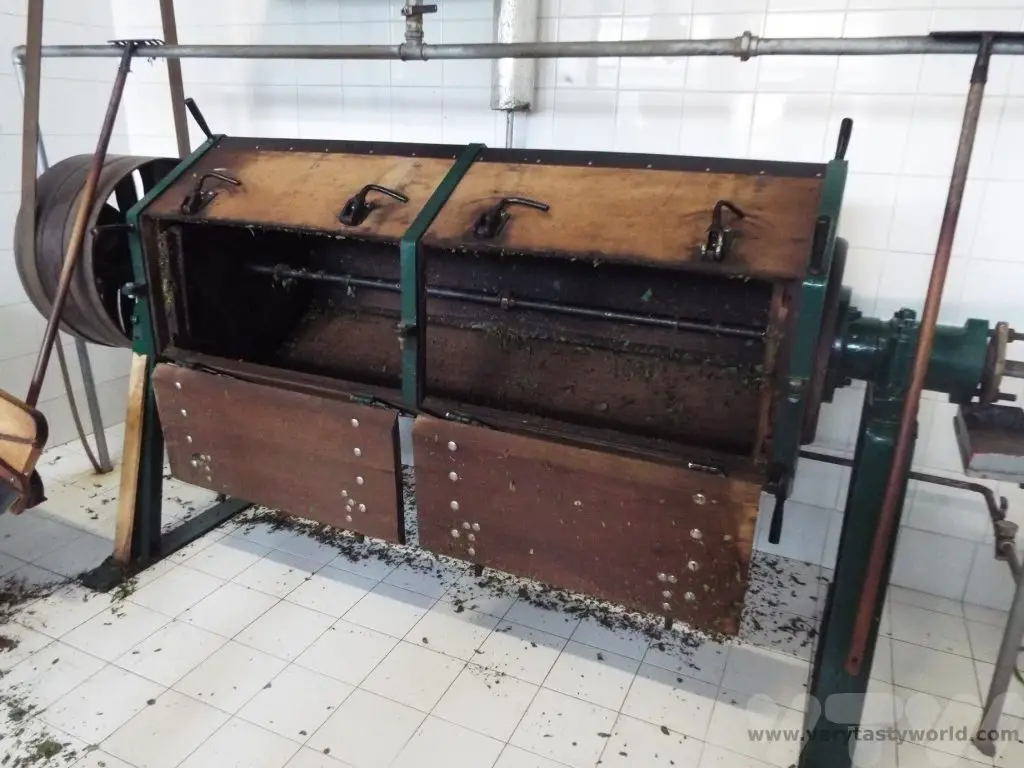
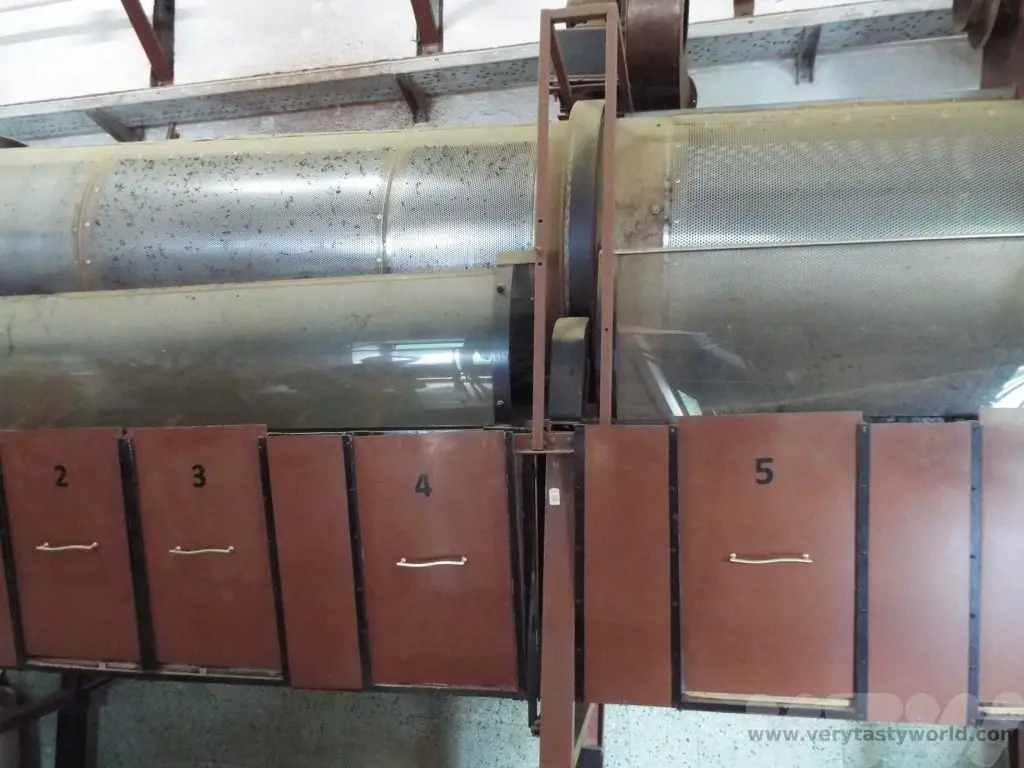
Volcanic Cozido das Furnas
The Azores are volcanic islands and some areas are still very geologically active. We enjoyed a day trip to Furnas towards the eastern end of the island.
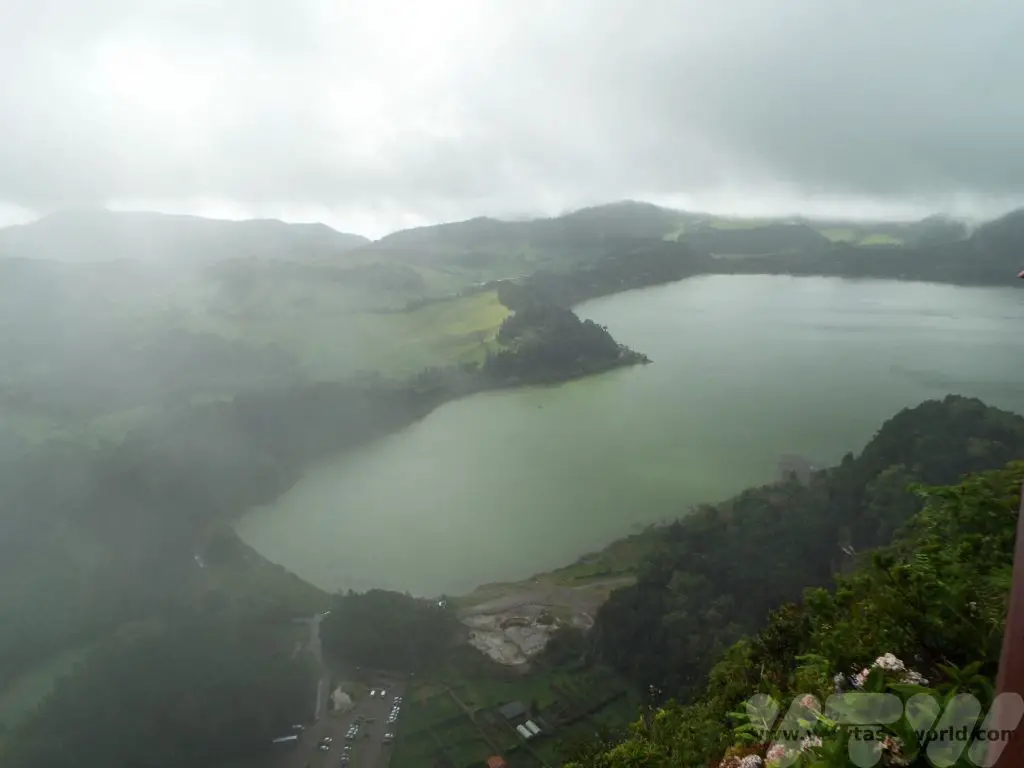
The local town has fumeroles which regularly steam, squirt and belch hot water. The area has a distinct whiff of rotten eggs due to the sulphur. Some of the water has a yellow colour (see the photo below on the right). This is not geological but local people put in bags of corn on the cob to cook.
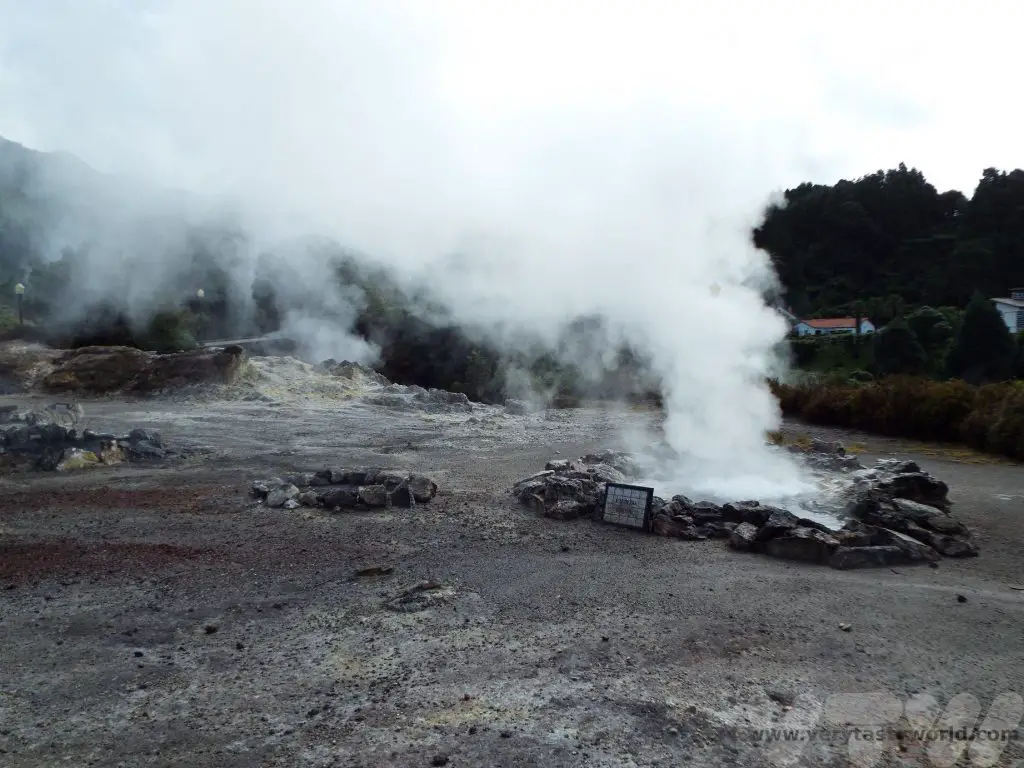
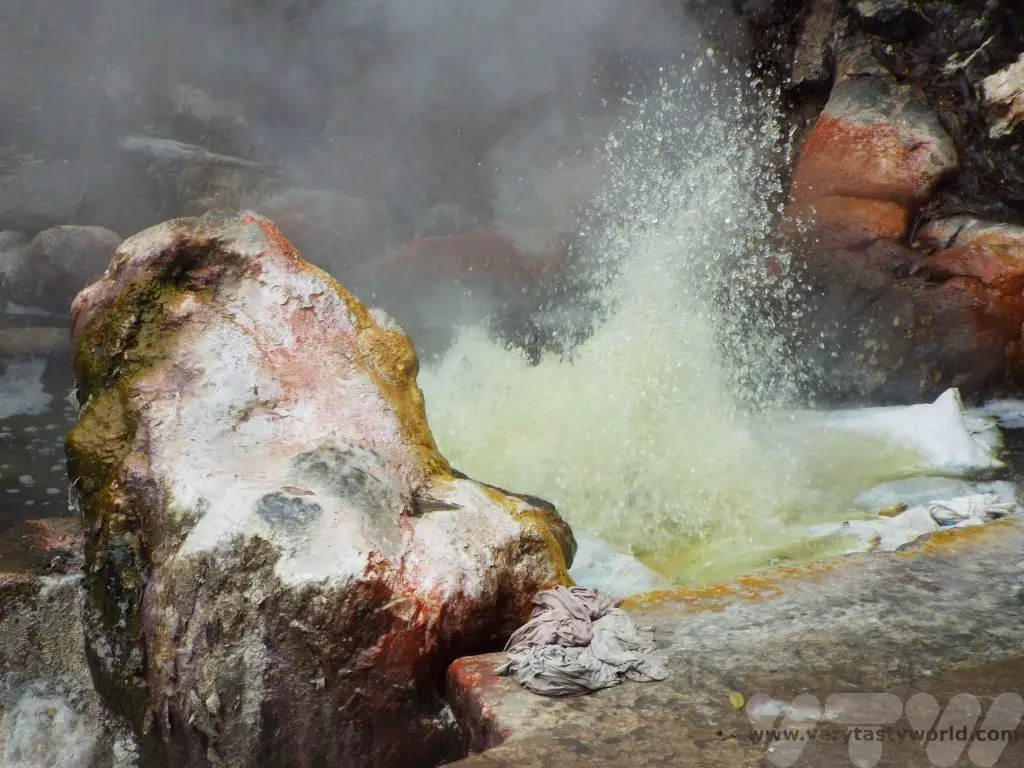
Taro plants, known as elephant ears, grow in the warm water. These have bulbous corms (like a tuber) which are edible and similar to sweet potatoes.
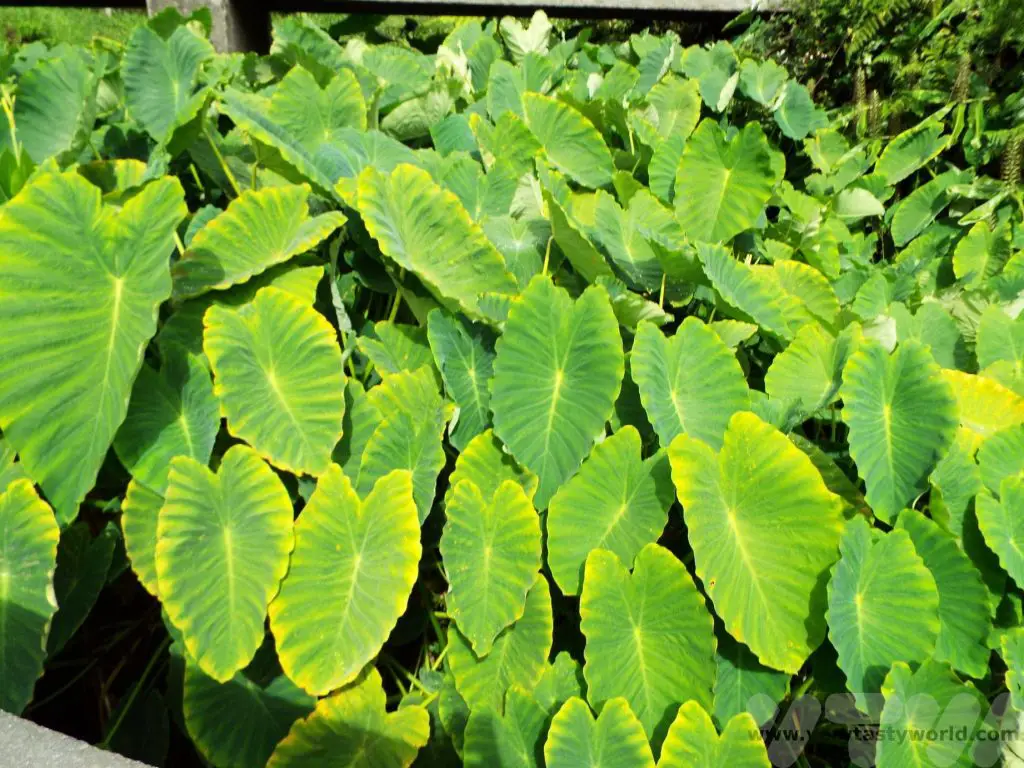
There are also some drinking fountains where you can taste the local water – it tastes very minerally and is an acquired taste for some. It’s also odd drinking warm water. These fountains are located just metres apart but the flavour of the water is surprisingly different!
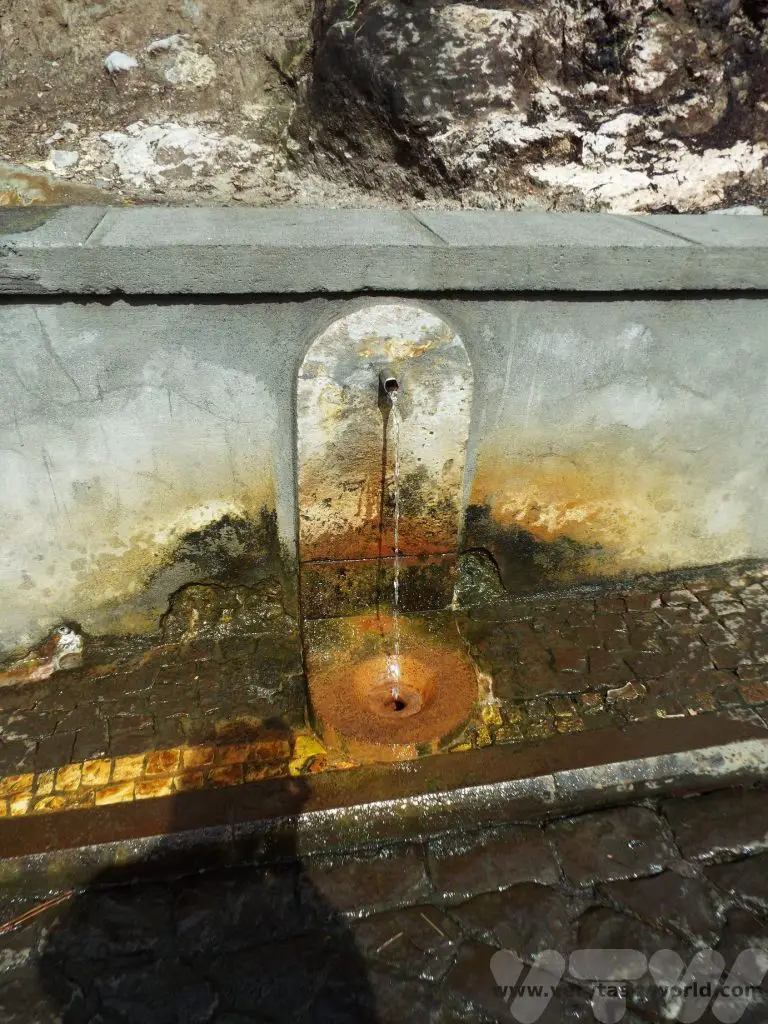
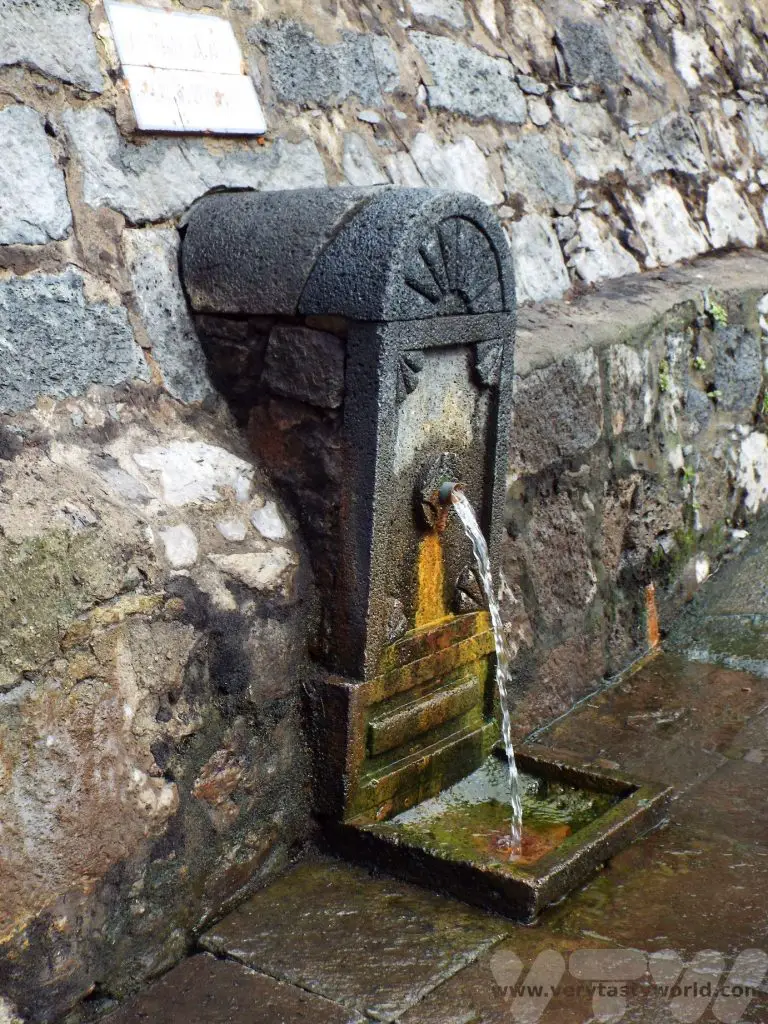
Most trips take you to a viewing point to see Furnas lake, and then you descend to the lake itself. You’re not allowed to swim in the lake but it’s possible to go boating on it. And walking around the area reveals some more of the steaming landscape.
There are a number of fenced off areas containing mounds of soil with name tags. On closer inspection these tags bear the names of various restaurants. Lunch!
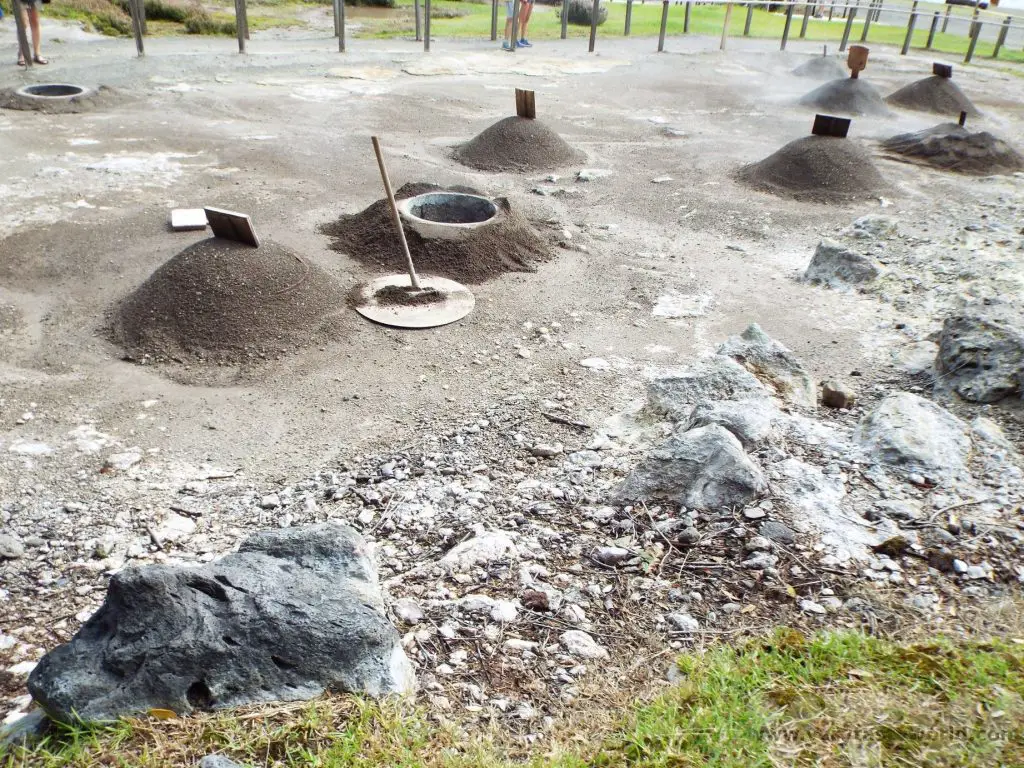
Every morning the restaurants prepare meat and vegetables and place them in a large pot. At 5am these pots are buried in the volcanic soil. Around six hours later a parade of vans arrive (and that’s the cue to grab a place by the fence if you want to take photos) and each restaurant owner will dig out their pots (or invite a hapless tourist to help) from the perfect slow cooker which has been cooking the food using free energy from the ground. It’s a brilliant system. And the site isn’t restricted to restaurants. Local people can hire a hole and bring their own food for a picnic/meal later in the day.
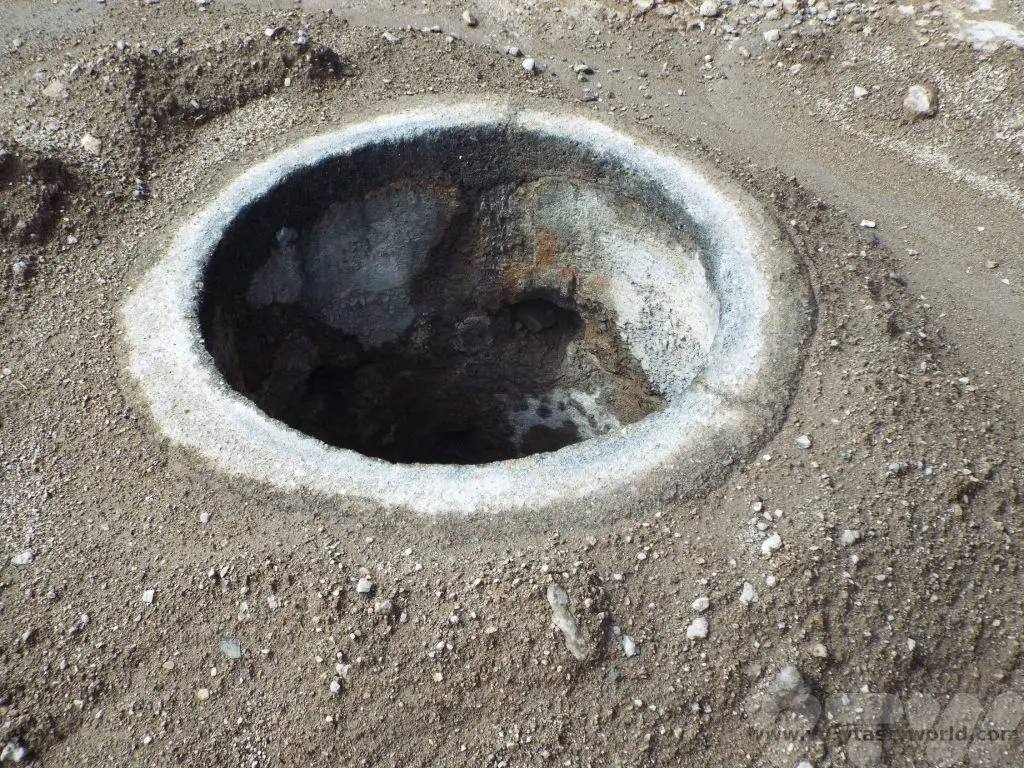
Back in town, the food is then served in the respective restaurants. A platter of meats and a platter of vegetables. (Vegetarians/vegans – the meat and veg will have been cooked together so if you want a veggie cozido, ask in advance and an unadulterated pot of pure veg can be supplied.)
The meats comprised pork, sausage, chicken, beef and blood sausage (Morcela) – all so soft and tender it could be cut with a spoon. It melted in the mouth.
The vegetables were potatoes, carrots, cabbage (which was served in large chunks so that it didn’t disintegrate during the cooking process) and the elephant ear yams.
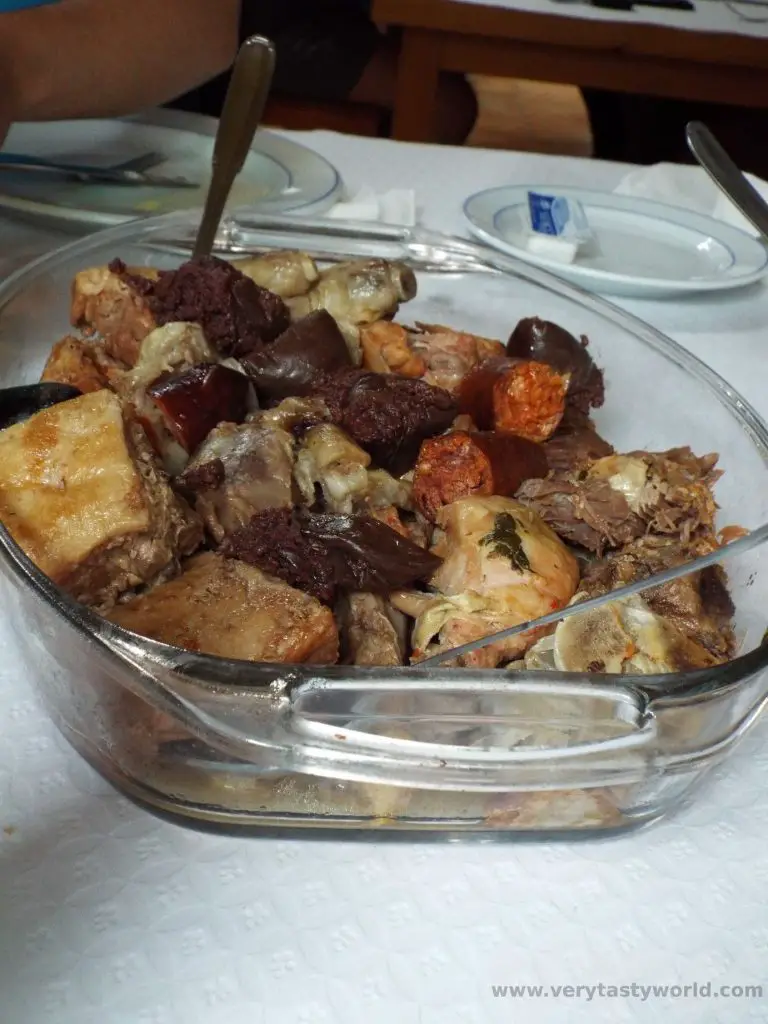
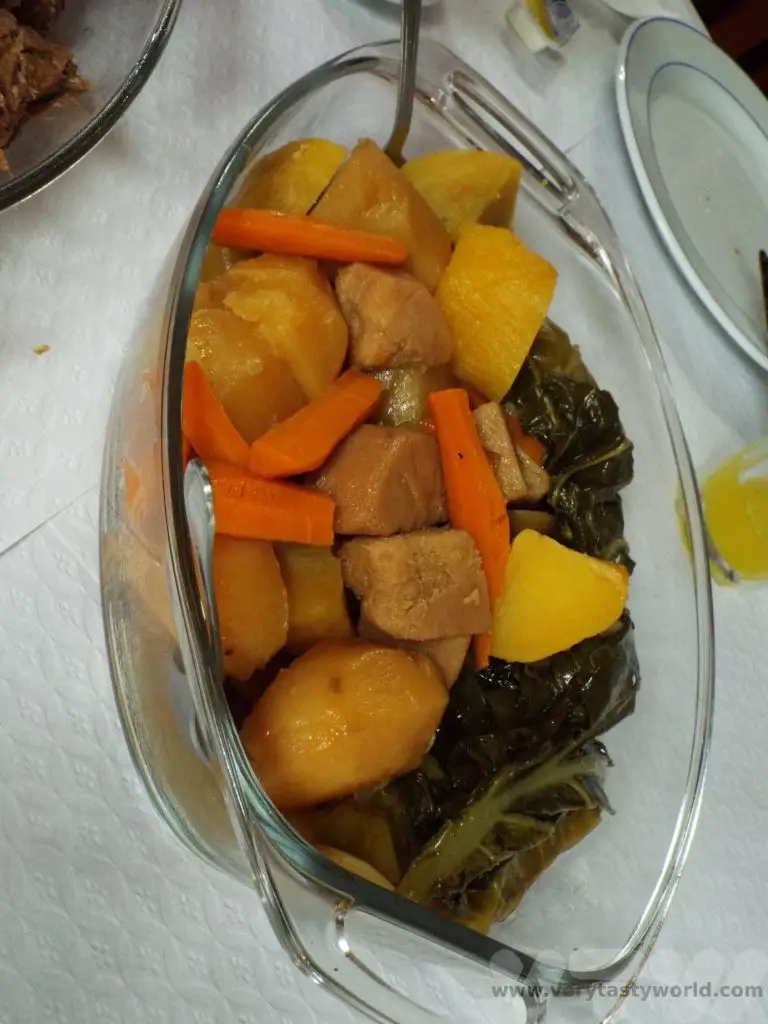
Cozido doesn’t have any additional flavours added – the food is served just as it comes out of the pot. But while it doesn’t offer complexity, the juices of the meat provide lots of flavour and you really get to enjoy the taste of the meat and vegetables. And it really is a feast!
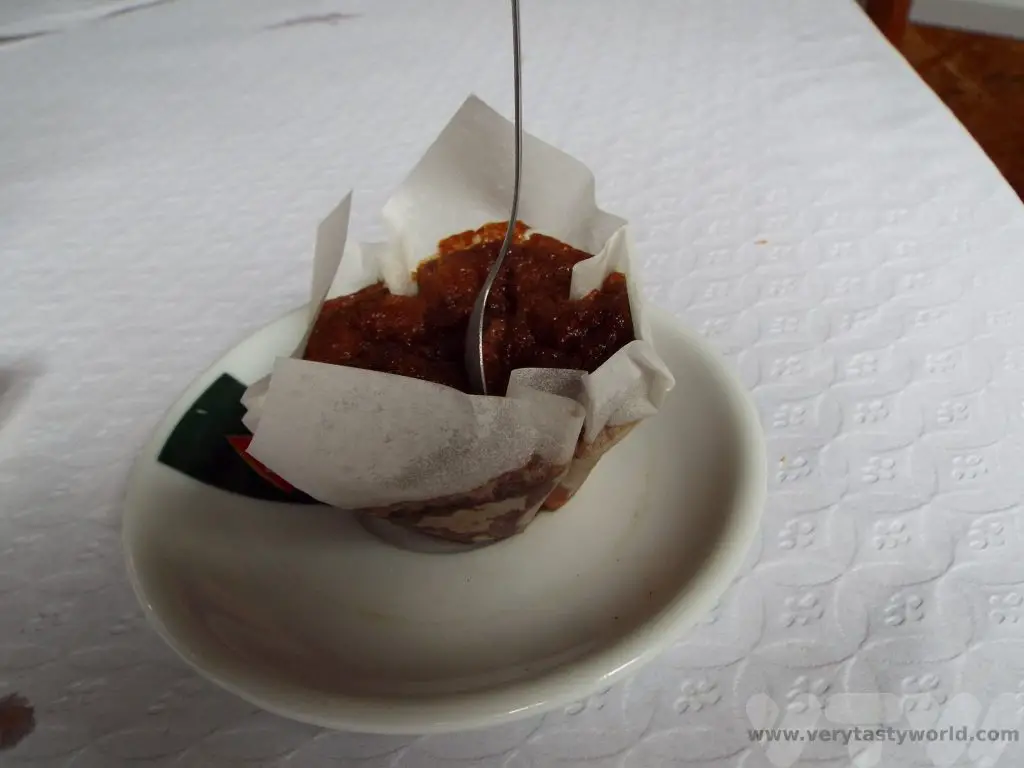
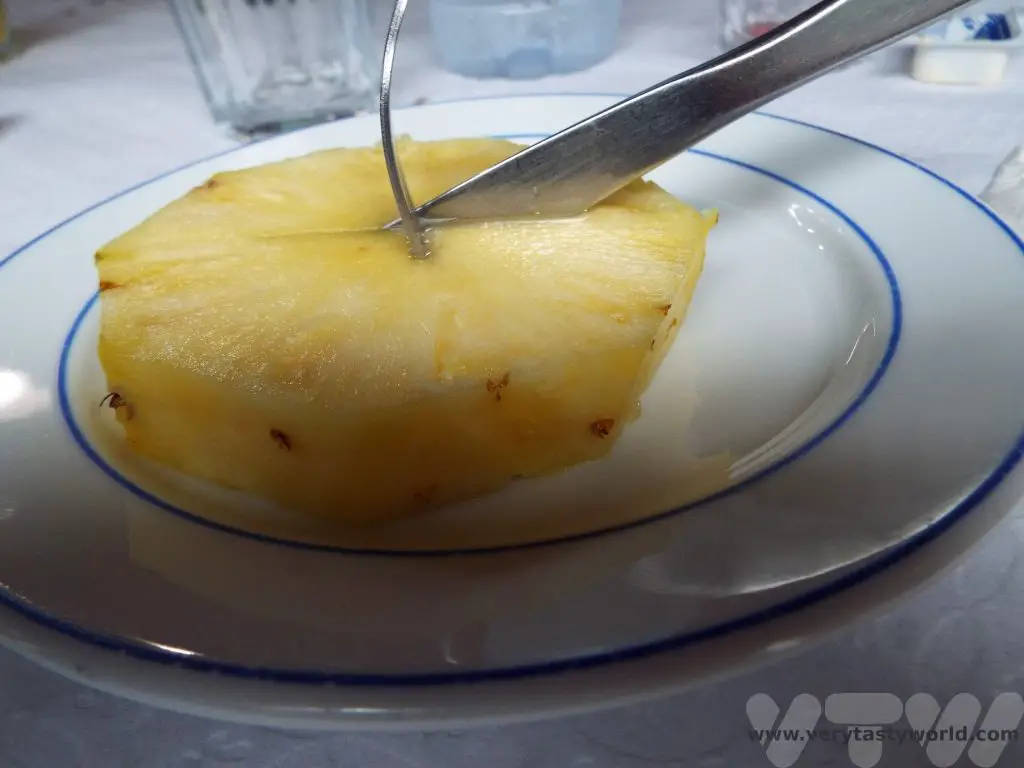
All washed down with local wine and a nice honey cake (if still hungry) or a slice of delicious local pineapple (if that’s all you can manage) for dessert, it filled us up for the rest of the day.
A Little Bit of Foraging
While the hydrangeas add glorious hues to the countryside and are very much welcomed, Sao Miguel has a more invasive plant – the yellow wild ginger – which is far less popular. It spreads quickly and does take over the landscape very quickly.
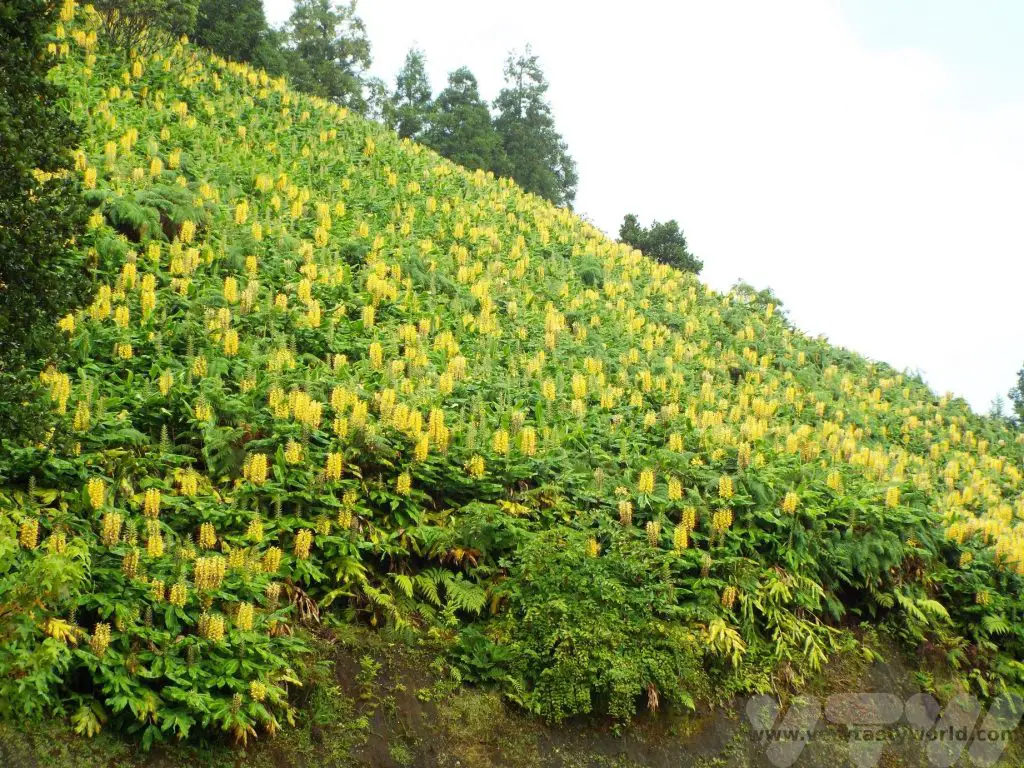
The local university is looking into uses for the plant and it’s looking hopeful that the fibrous leaves may be a useful material to replace use of some plastics in future. It is a good pollinator and inside the long yellow flowers is a drop of nectar. You can pick the flower, bite off the end – by a couple of centimetres – and spit that out. Then suck on the flower and you can taste the sweetness.
Dining on San Miguel – Ponta Delgada
First of all, if you want to dine at a particular restaurant, book! We visited at the end of the busy season and struggled to get a table at the best restaurants for an evening meal. At one of the restaurants we pretty much bagged the last table. We arrived five minutes before opening and people were already queuing for a walk-in but were politely turned away. Another option is to visit the restaurants at lunchtime when it should be easier to get a table.
Our favourites were Gastronomo and Michel. Both are deservedly popular and offered foods of the Azores that were local specialities. We received a very warm welcome in each place.
Gastronomo, R. da Boa Nova
Their queijo fresco and pimenta da terra were freshly made (some restaurants provide you with the cheese on a plate and a bottle of sauce) and served on a ginger plant leaf (one of the uses for the invasive plant) accompanied by home-made bread, including a sweet bread (a bit like a brioche) which was a wonderful contrast to the cheese and chilli.
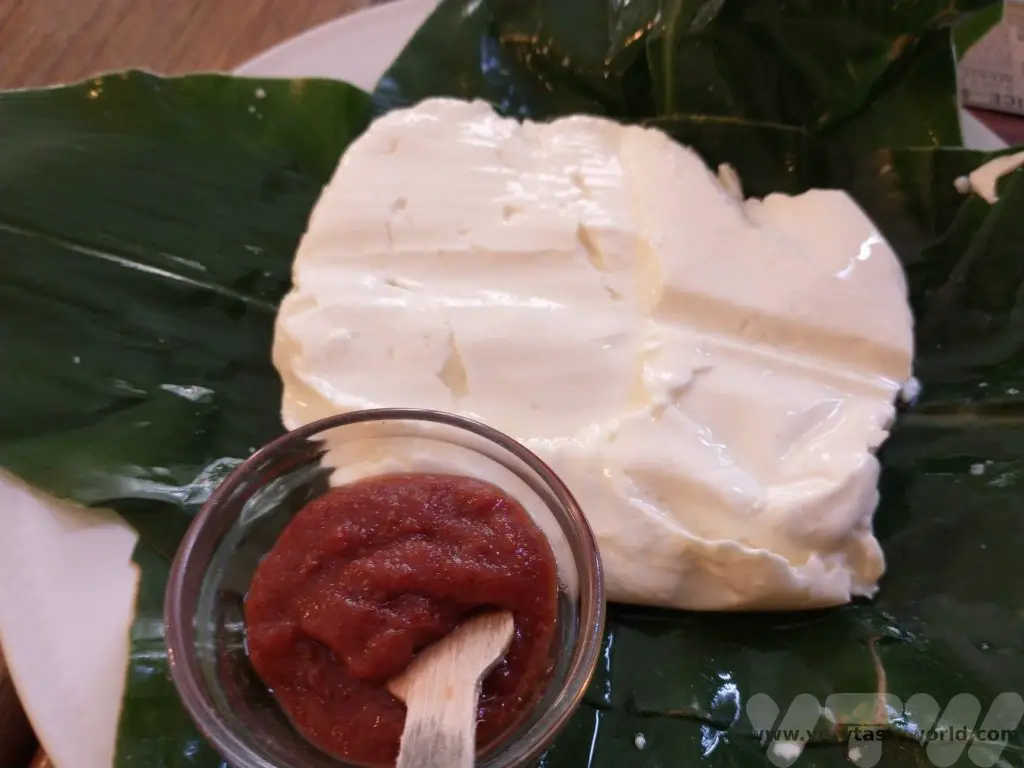

We shared a starter of black pudding and local pineapple which was an absolutely delicious combination of sweet and savoury flavours. The black pudding – a blood sausage – was one of the best we have eaten.
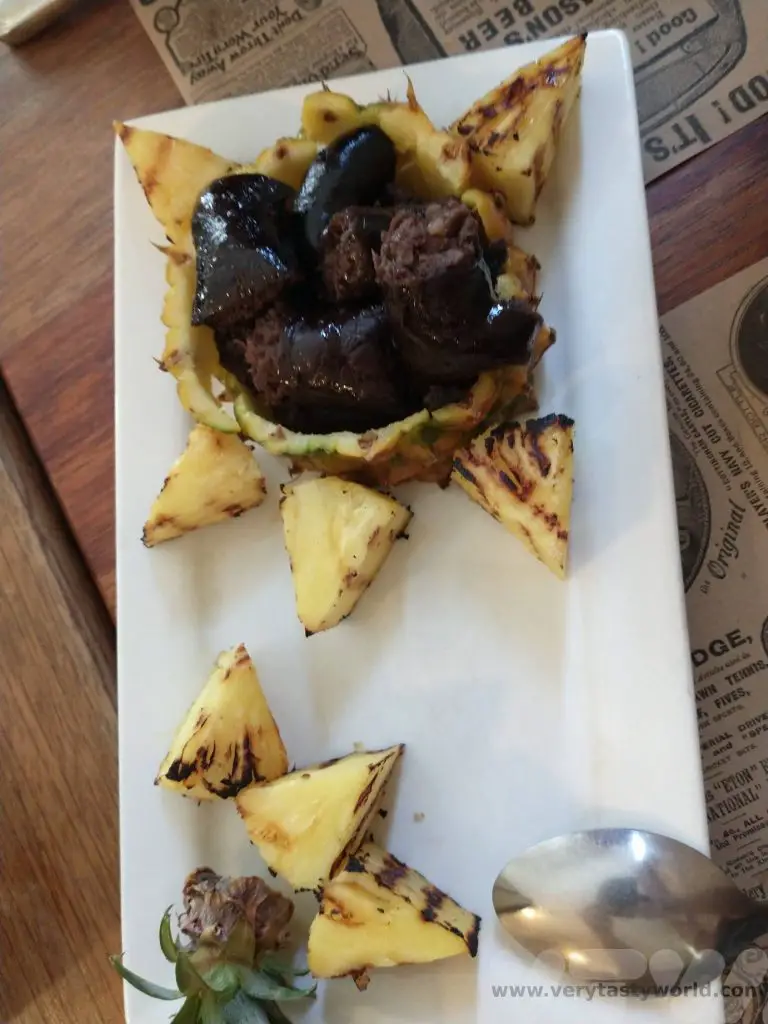
The Azoreans have a particular way of cooking steak. Bife steak with garlic and pimento and a fried egg.
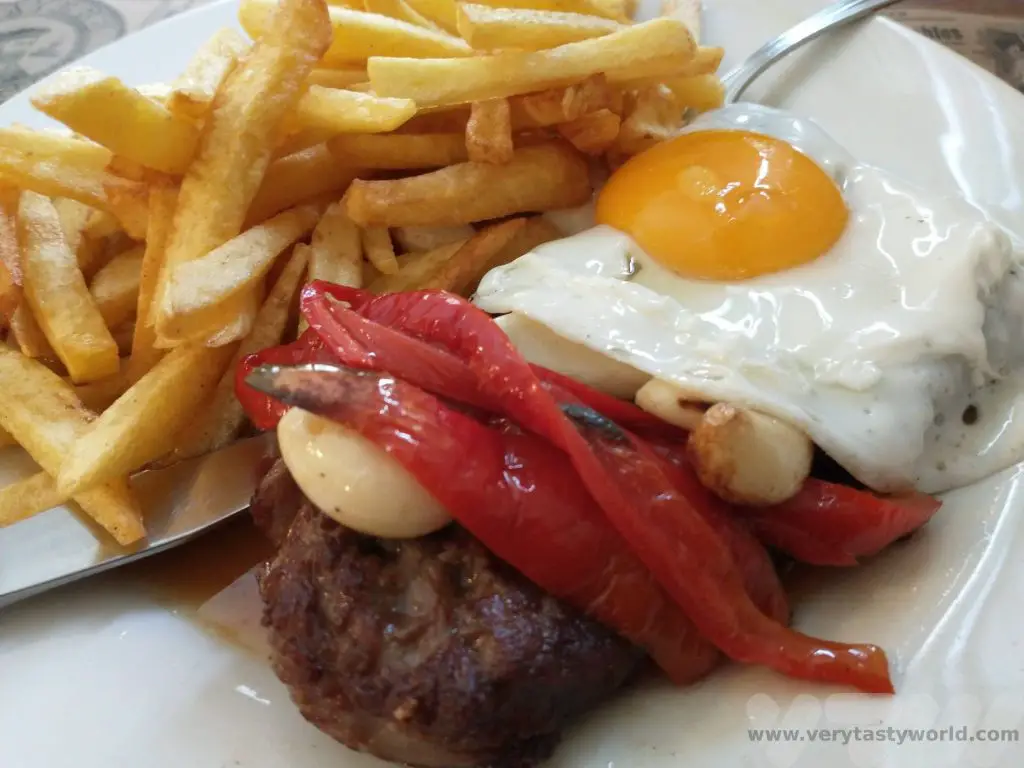
Bacalhau is not specifically Azorean but is a hugely well known Portuguese dish. It comprises salt cod, cooked with eggs and olives and served on fries.
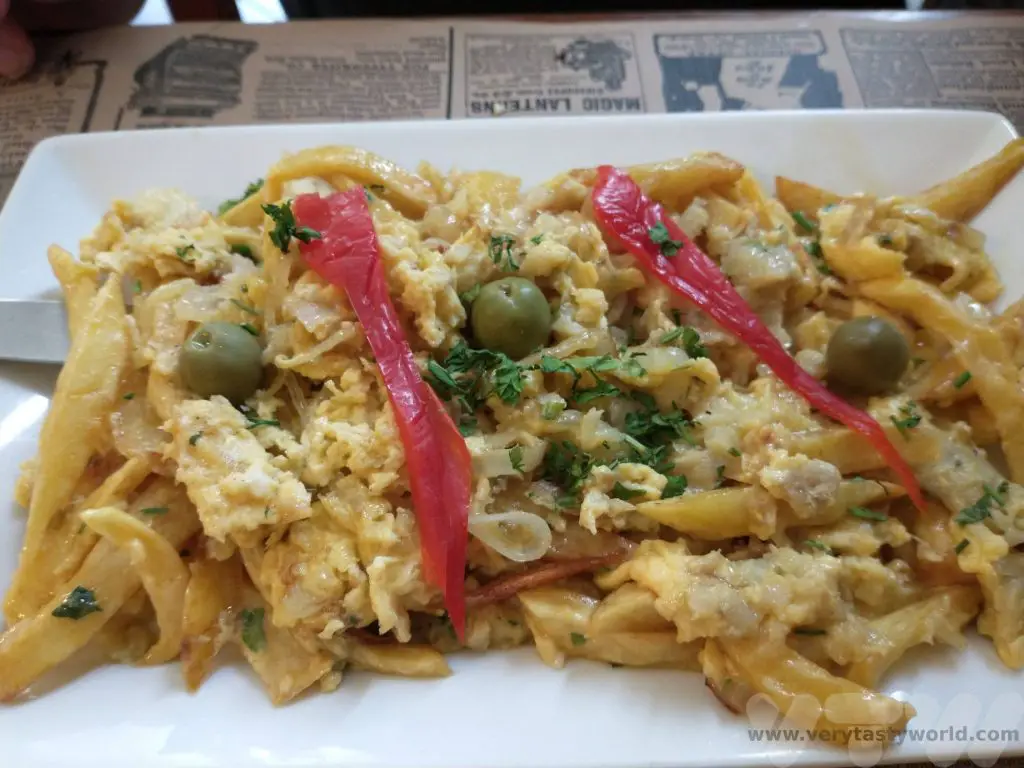
Michel, Rua Engº José Cordeiro Antiga da Calheta
We tried Azorean limpets and local shrimp to start with. Limpets are shellfish that are incredibly common all over Europe and, although we knew they were edible, had never seen them on a menu before. They have a tougher texture than a lot of shellfish but they were tasty.
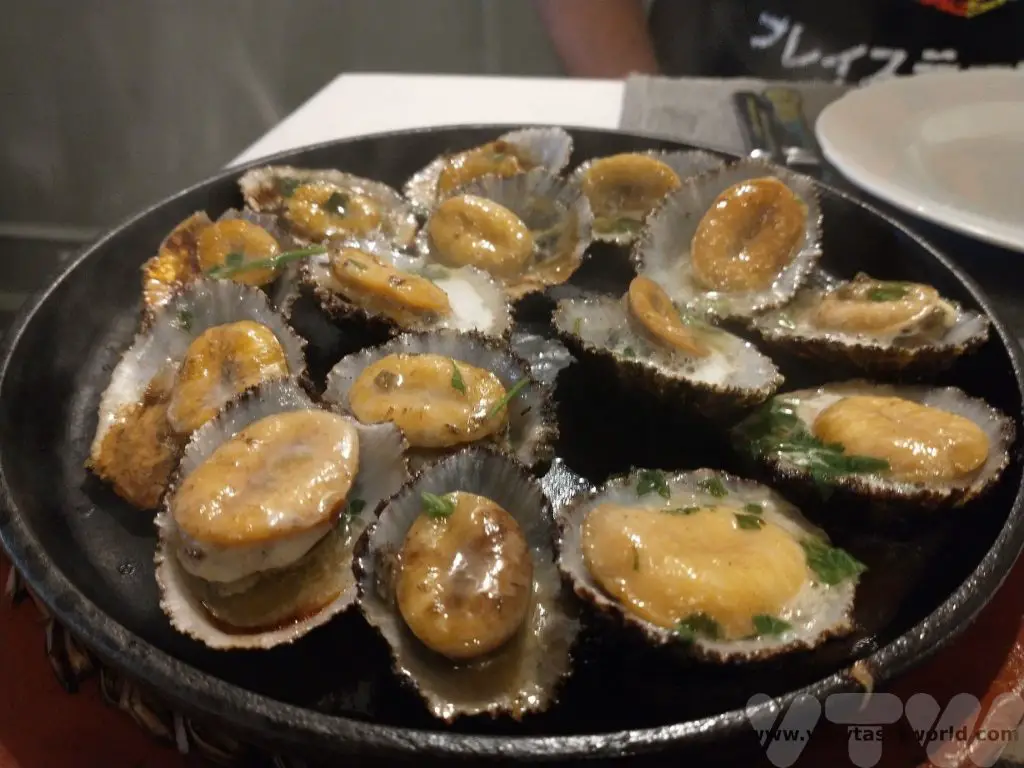
Pork and mashed yam (the elephant ears) and vegetables was utterly delicious.

As was the oven roast lamb.
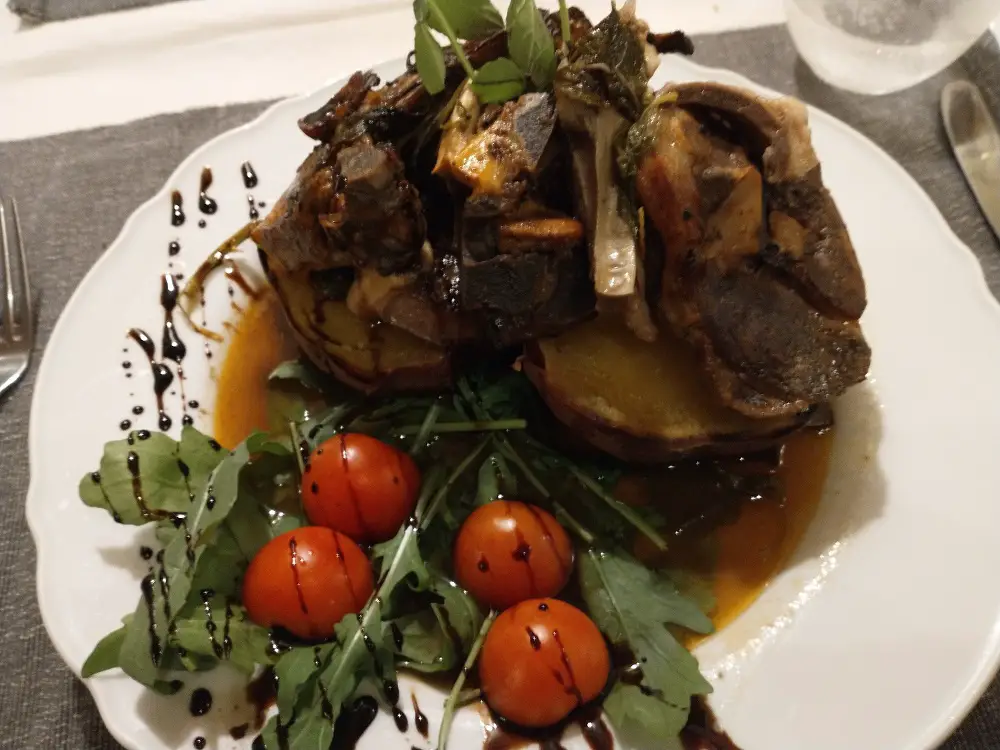

Costa Rica Wildlife Sanctuary – Caño Negro
Beautiful Costa Rica is well known for its amazing wildlife. This relatively small country in Central America has twenty-three national parks, three of which are UNESCO sites. We took a trip from the east coast to the west, visiting many wildlife parks. The tourism infrastructure is really well developed with easy transportation between locations and many tour operators that can offer trips to various attractions.
Please note that this post contains affiliate links. If you click through and decide to make a purchase we will make a small commission, at no extra cost to you, which will help towards the costs of running this site.
Having enjoyed Tortuguero, where we had been lucky to see a greenback turtle nesting, we moved onto La Fortuna de San Carlos, close the Arenal volcano, in the middle of the country. It is an ideal location to use as a base to explore this region and there are loads of exciting activities to undertake in the area, from caving to wildlife viewing.
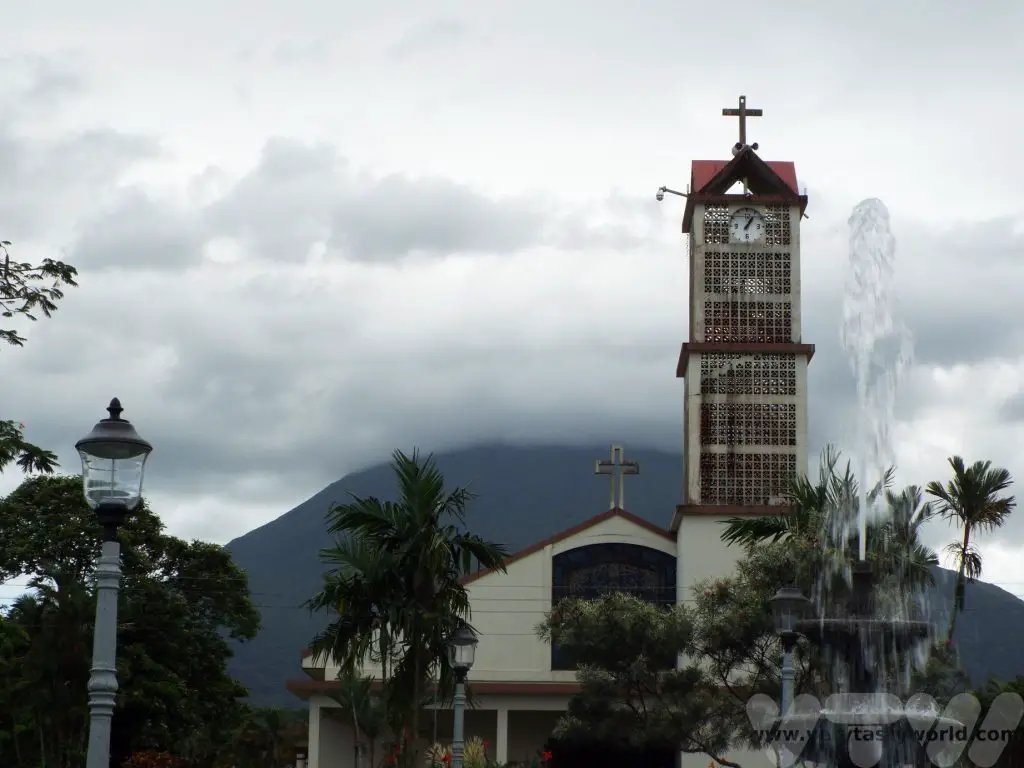
One of the trips we enjoyed was to the Caño Negro wildlife sanctuary. As with most tours in Costa Rica, there are companies in La Fortuna that can arrange the trip and will pick you up from your hotel or guest house.
It’ll take a couple of hours to get there from La Fortuna. Our guide was a naturalist who was not only knowledgeable about the local wildlife but was also really keen to tell us all about the fruit that grows in the region as well.
The Caño Negro, close to the Nicaraguan border, is a Costa Rica wildlife sanctuary which has the status of a national park, a Ramsar wetland of international importance, and one of the most biologically diverse areas in the country.
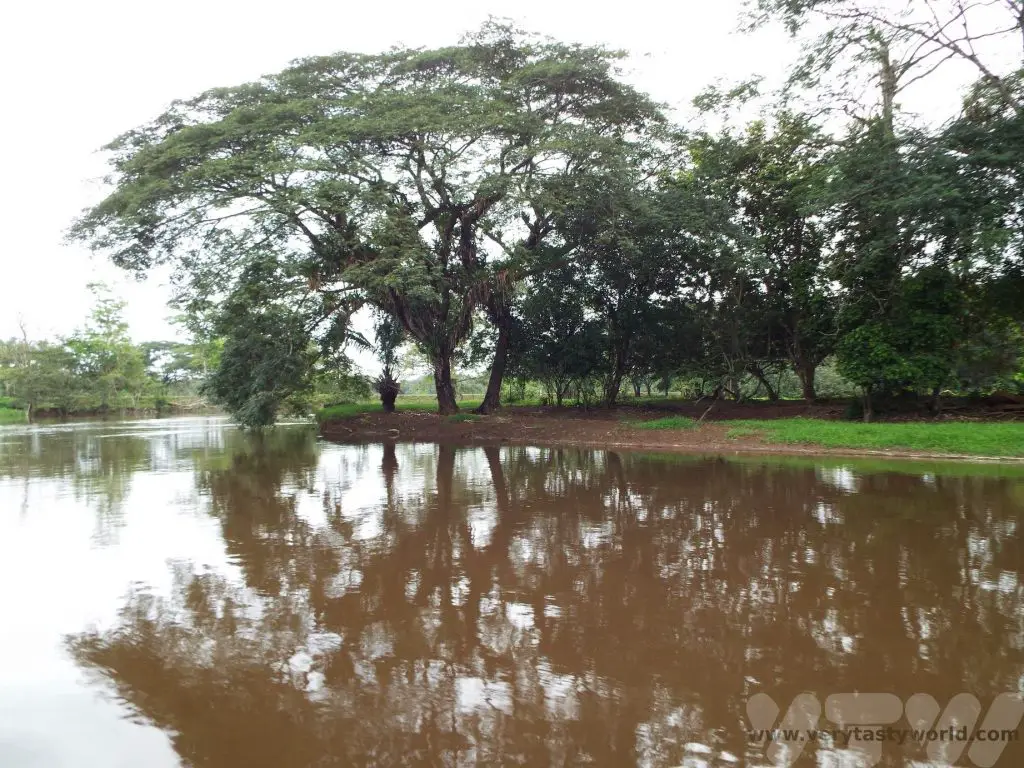
Boat Trip on the Río Frío
Once at the Caño Negro you can board a boat and enjoy a fascinating cruise up and down the Río Frío.
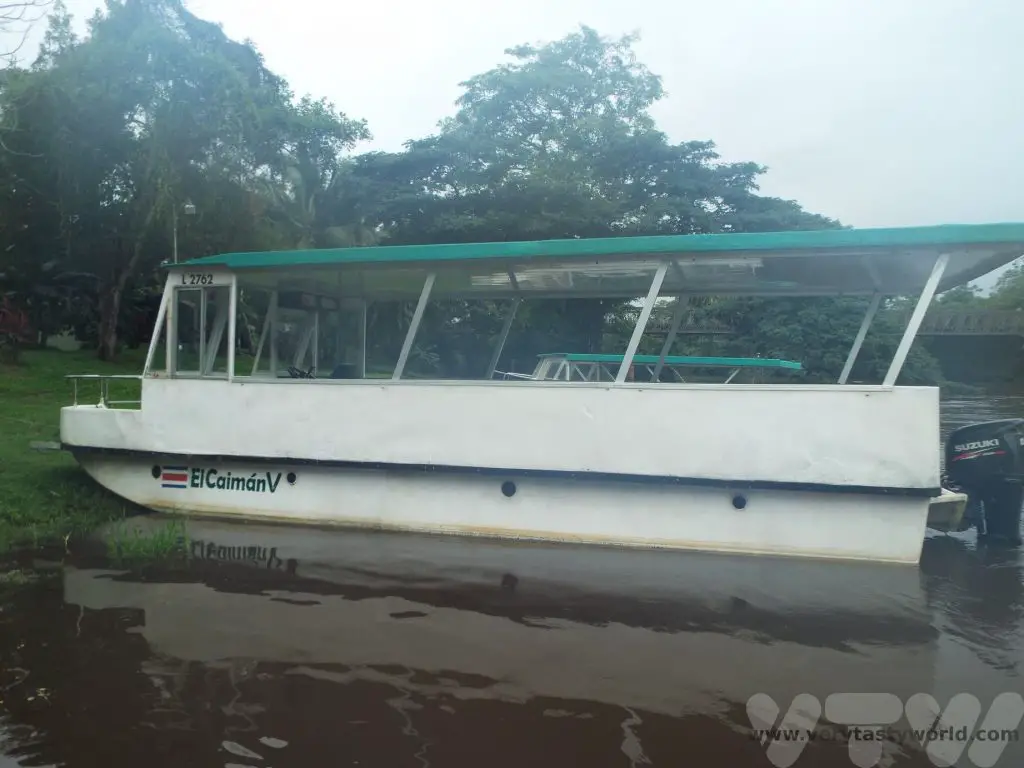
Wildlife viewings are pretty much guaranteed. Good guides will be able to spot plenty of birds, reptiles and mammals and, importantly, be able to point them out so that you can take pictures. Of course, you may not get to see the more elusive residents: the cougars, jaguars and ocelots, but there were plenty of monkeys, iguana, caiman, beautiful birds and, of course, sloths to see.
Howler monkeys are the loudest monkeys in the area. Their calls can travel 5km! They use the vocalisation to communicate with each other and establish territory.
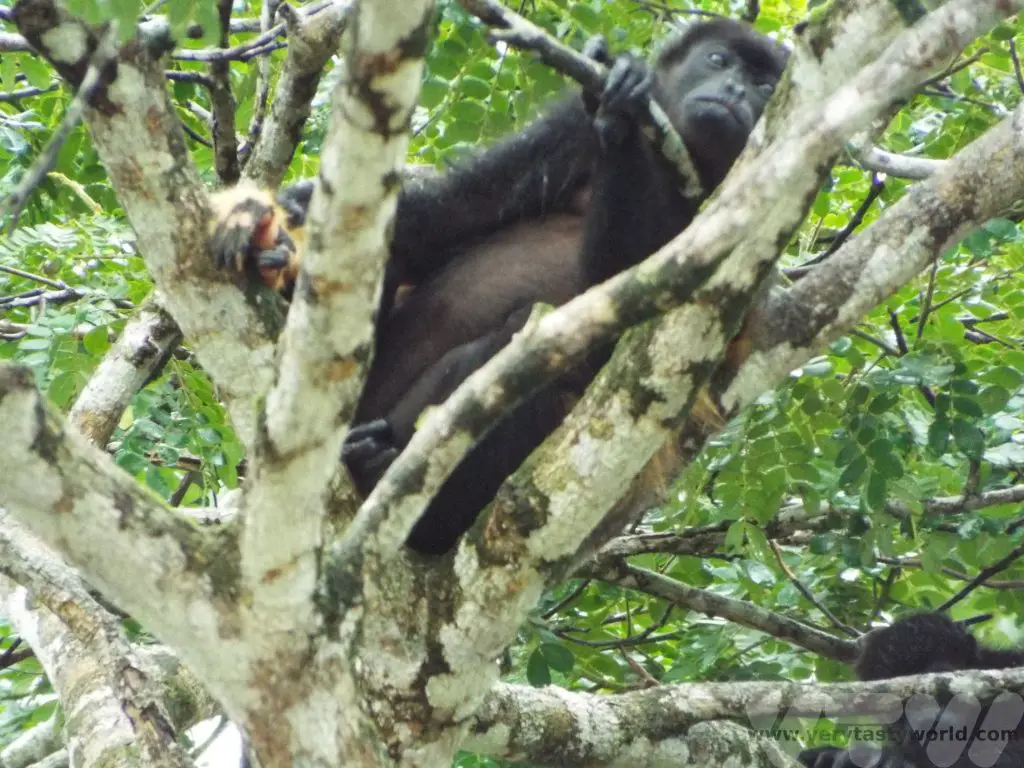
White faced monkeys, also known as capuchin monkeys, look adorable but are very naughty. They are regarded as the most intelligent of the monkeys in the region but can be quite vicious, fighting over the fruit in the trees and stealing from each other.
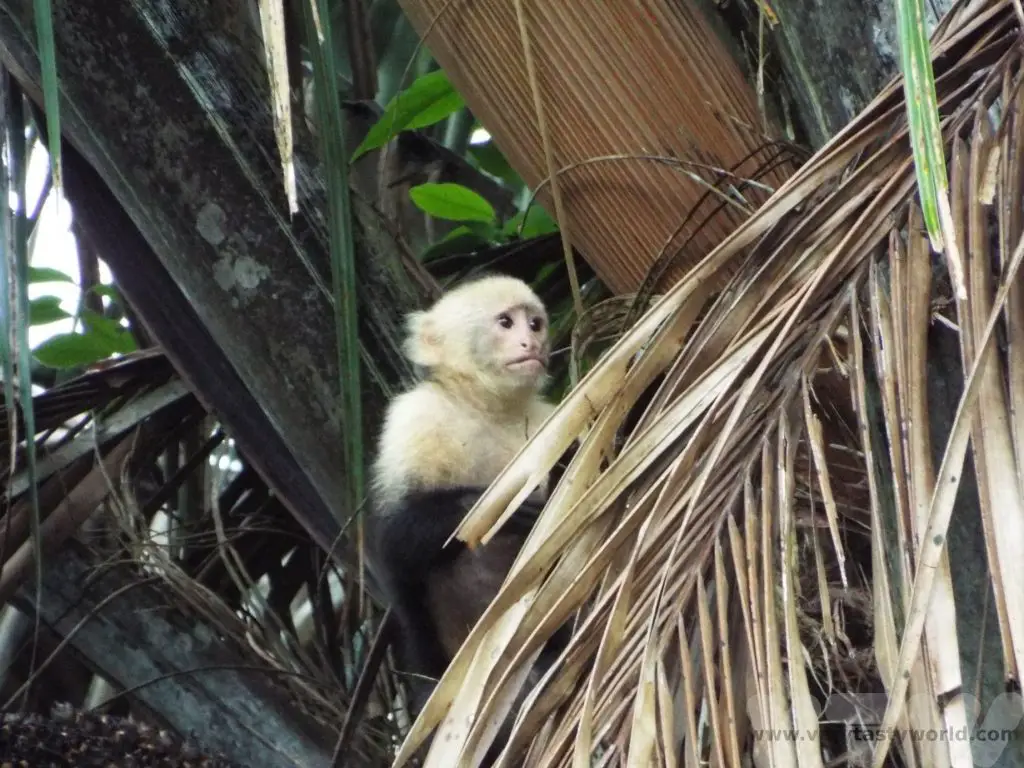
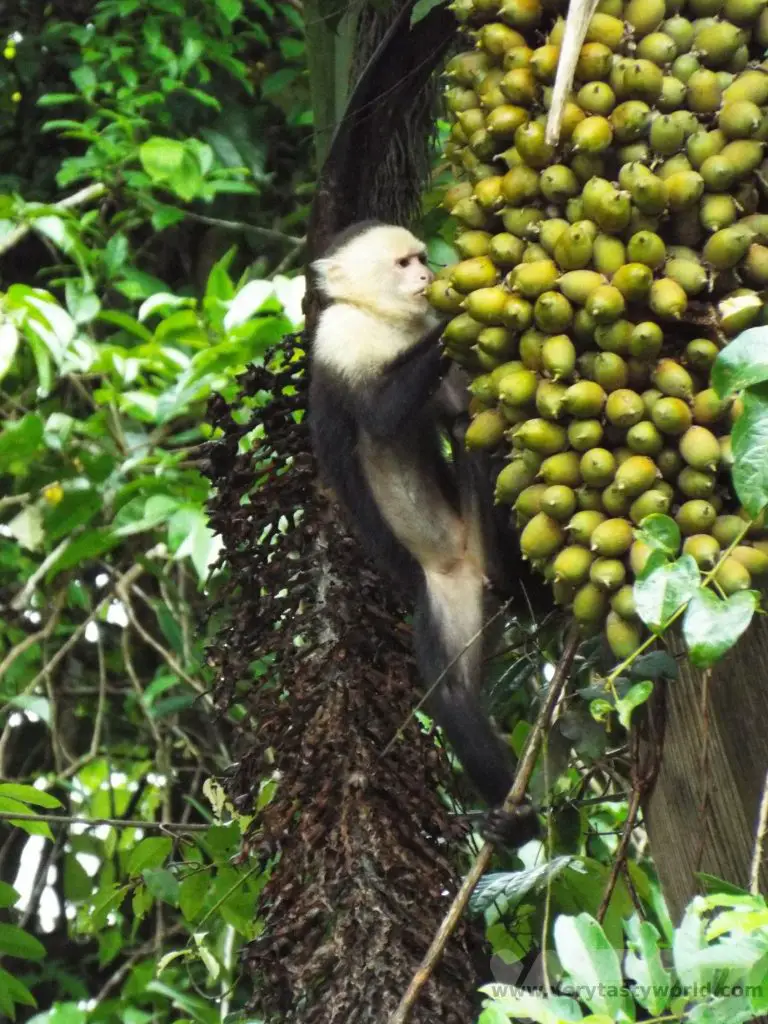
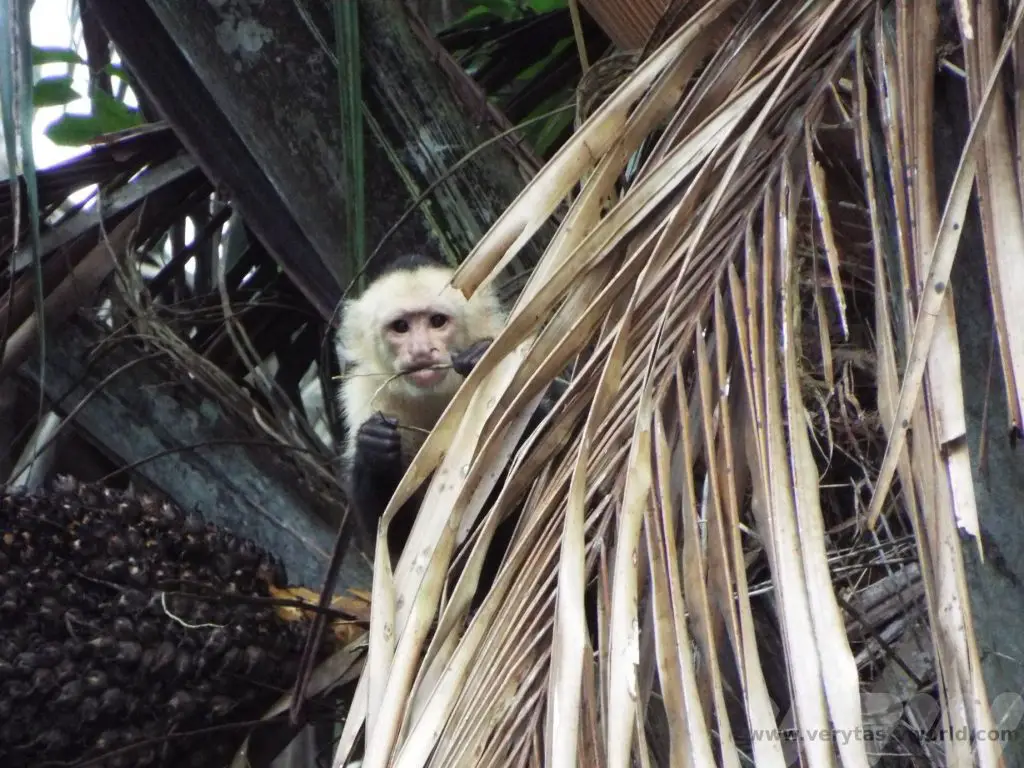
This beautiful kingfisher got lucky catching a fishy snack.
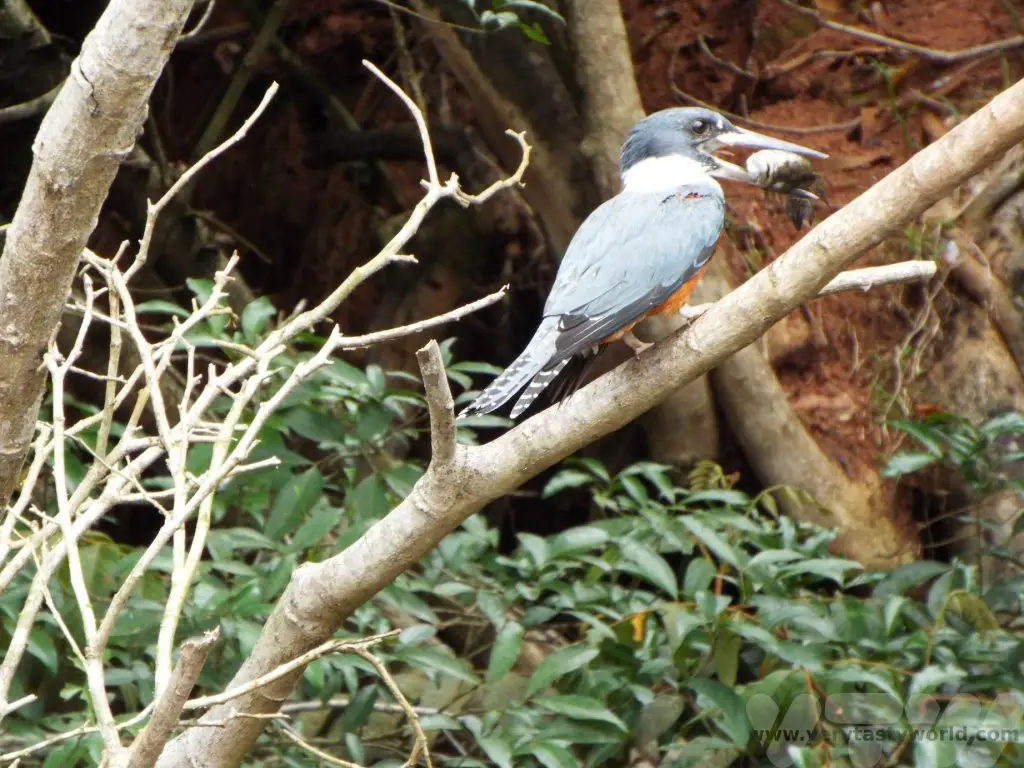
And this egret was having a good wade searching for food.
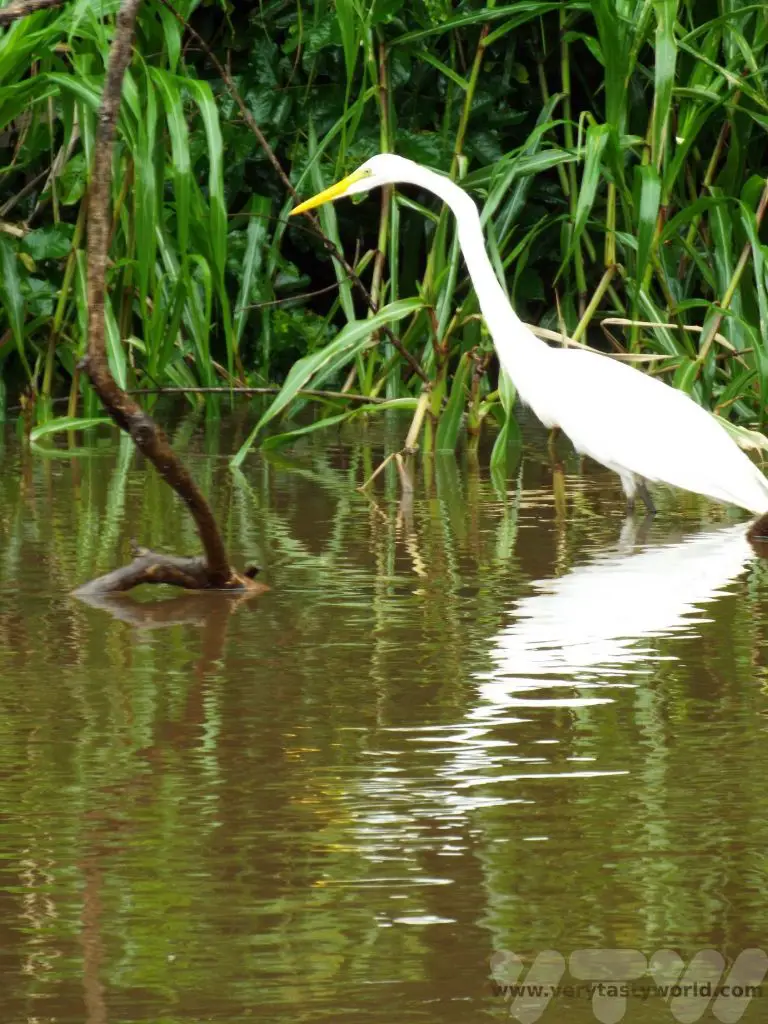
And there were plentiful iguana hanging around in trees and on the surrounding fields.
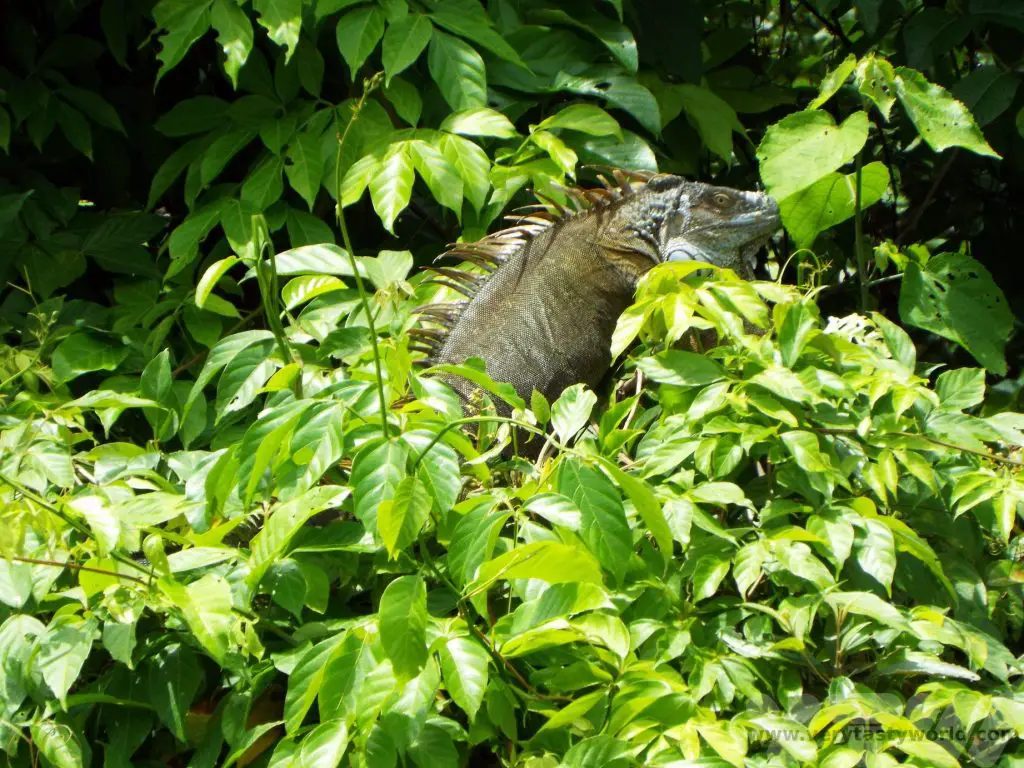


The anhinga is also known as the snake bird because when it swims in the water you can only see its elongated neck, which has the appearance of a snake gliding through the river.
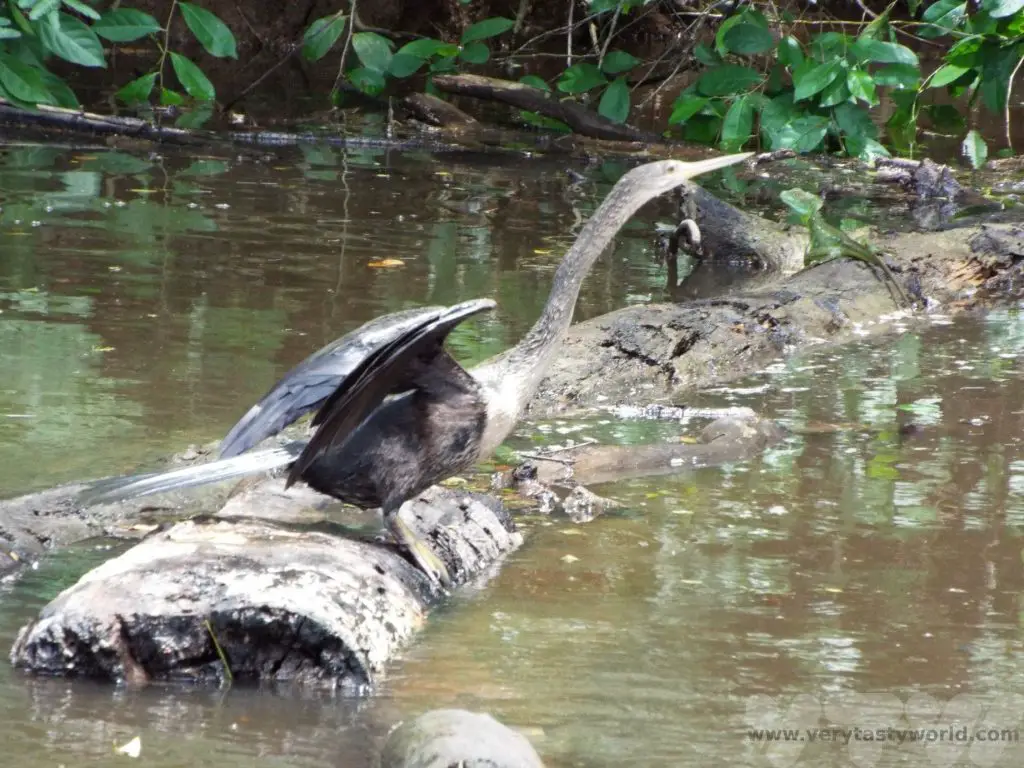
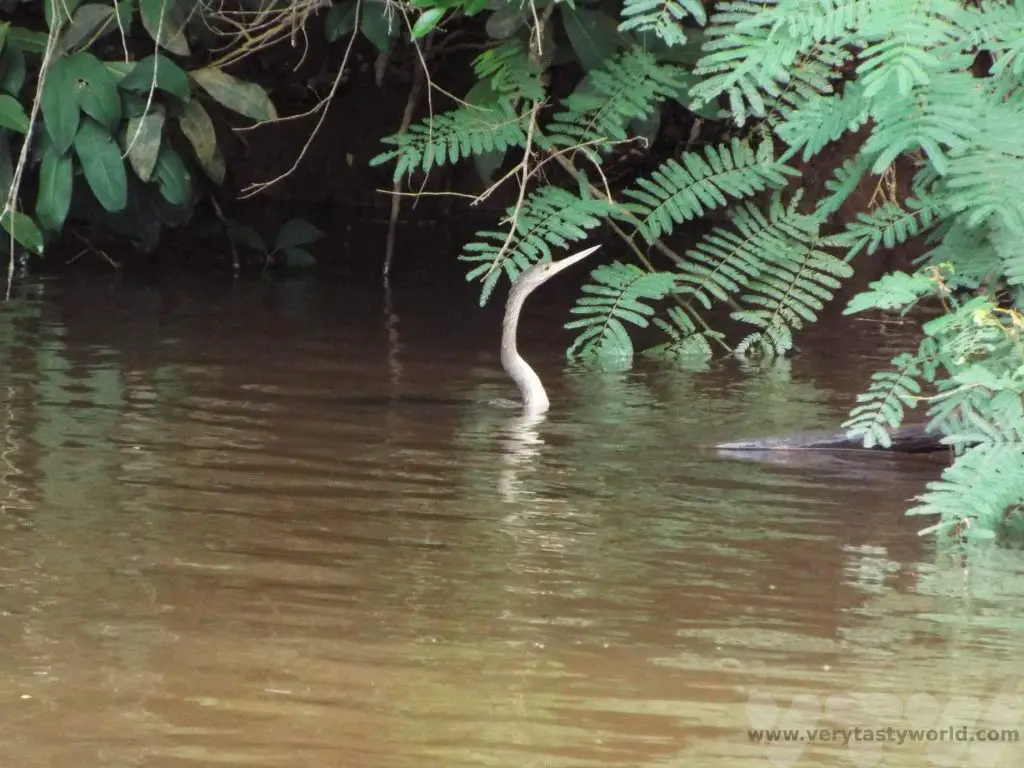
The Jesus lizard, or to give it its correct name, basilisk lizard, derives its moniker from being able to run across the water on its rear legs. It is possible for the species to do this because they have little scales on their back toes which form webs that trap water and air bubbles underneath them. If they run quickly enough the bubbles underneath these webs prevent them from sinking into the water. The lizards are able to swim if they go too slow.
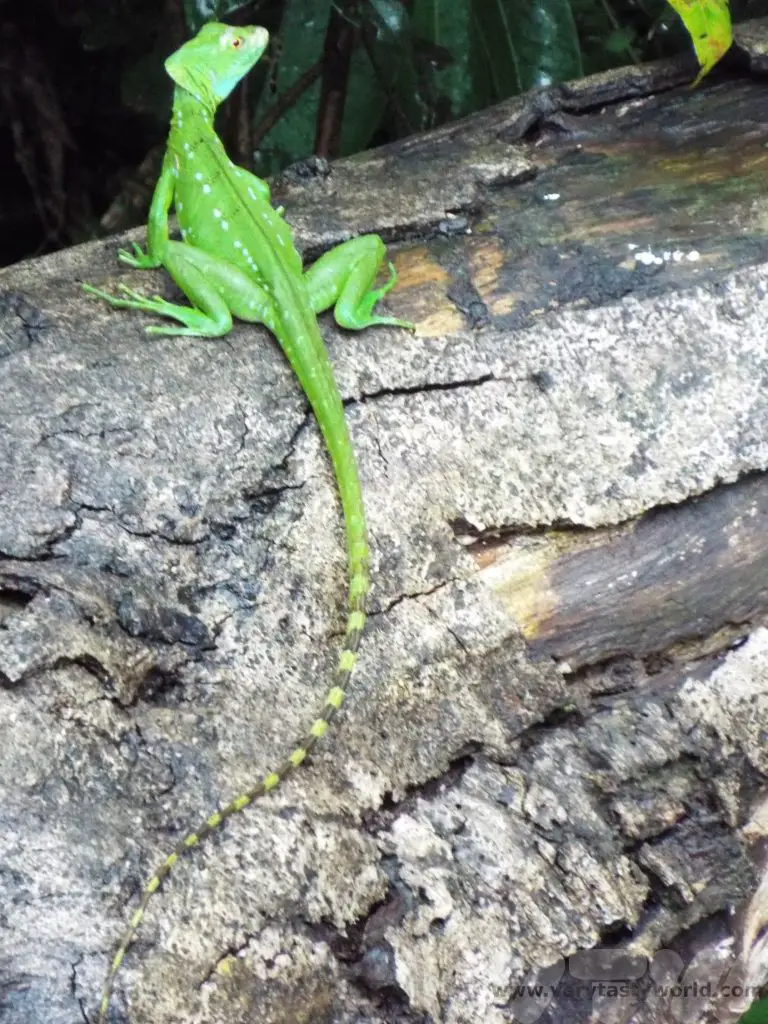
We sailed past a nonchalant caiman.

Sloths are probably the creature that most visitors to Costa Rica definitely want to see. On this excursion we saw a Two-Toed sloth, hanging around in the tree, which is what sloths do best.
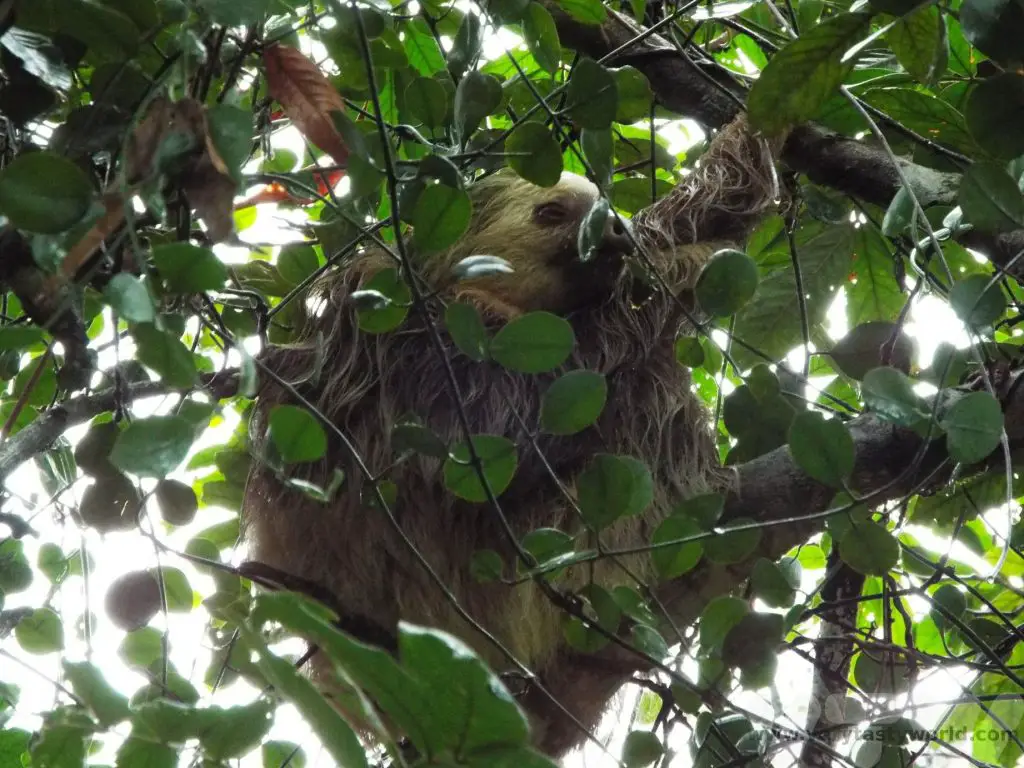
There are two species of sloth in Costa Rica: Two-Toed and Three-Toed. (We did see the Three-Toed Sloth, but on the Pacific coast, not on this river trip.) They are absolutely fascinating creatures – they appear to be incredibly lazy but this is largely because they have a very slow metabolism and most of their time is spent in the tree canopies. They have a multi-chambered stomach that is capable of digesting tough leaves but the digestion process takes a very long time. Once they are up a tree they will stay there for several days, only coming down for a poo, which happens once week. Pretty much everything else happens in the trees – eating, sleeping, mating, even giving birth.
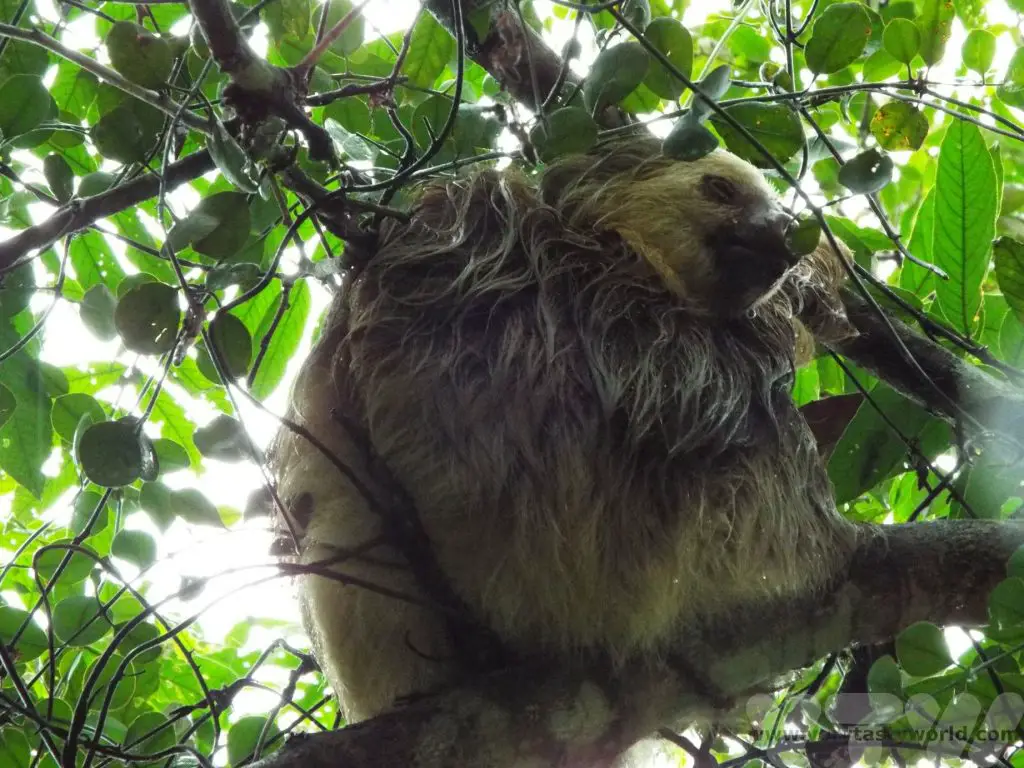
They are often covered in green algae, with which they have a symbiotic relationship, the algae providing them with some nutrition. In turn, the sloth’s fur, which retains water well, is an idea environment for the algae to thrive. It also helps provide camouflage – the sloth’s natural predators include ocelot and jaguar.
The species have been around for 65 million years, so there’s probably something to be said for taking things easy in life!
A Downpour
The river trip was hugely enjoyable but as we were travelling in the mid-season in June/July (it is rainy but not hurricane weather) we did experience something of a downpour. When it rains in Costa Rica, it rains! (Some areas we visited receive around 5000mm annually.) The showers at this time of year are extremely heavy but usually short-lived, lasting no more than twenty minutes to half an hour. The boat had a roof and our captain kindly rescued some kayakers who were enjoying their gentle paddle on the river until they got a complete soaking! They were hugely relieved when we picked them up and they stepped aboard looking somewhat bedraggled. We always recommend bringing wet weather gear if travelling at this time of year.
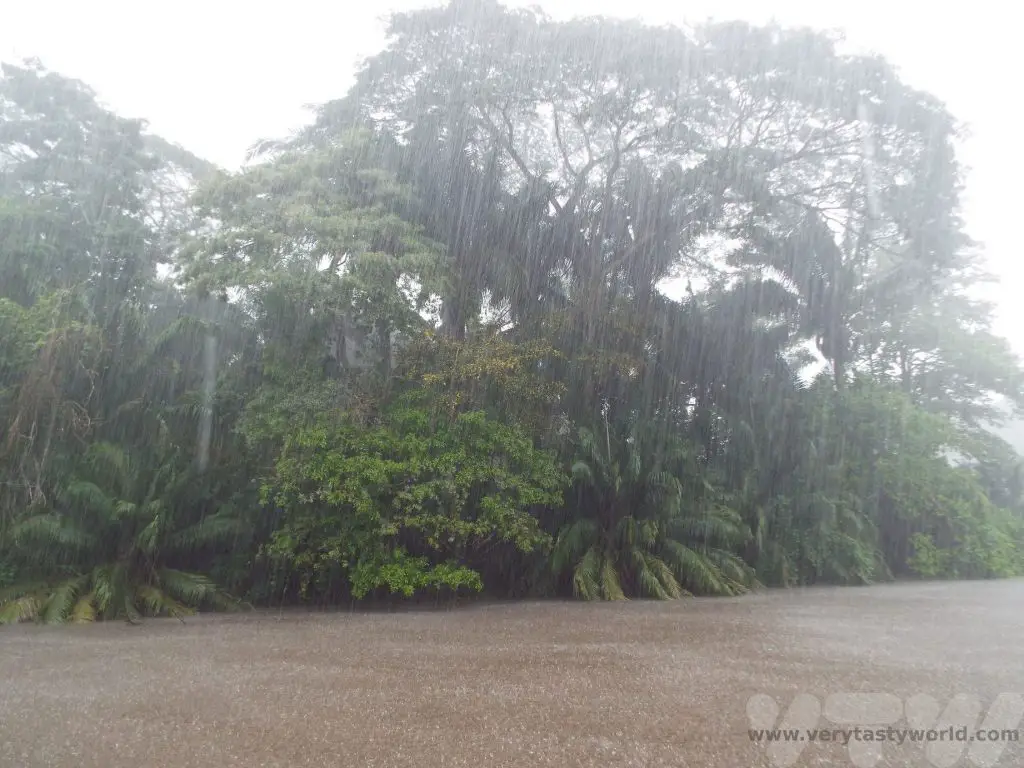
Feeling Fruity
After the boat trip through the wildlife sanctuary, lunch was provided. It was quite common at the end of most excursions we enjoyed in the country. We were treated to a fruit feast.
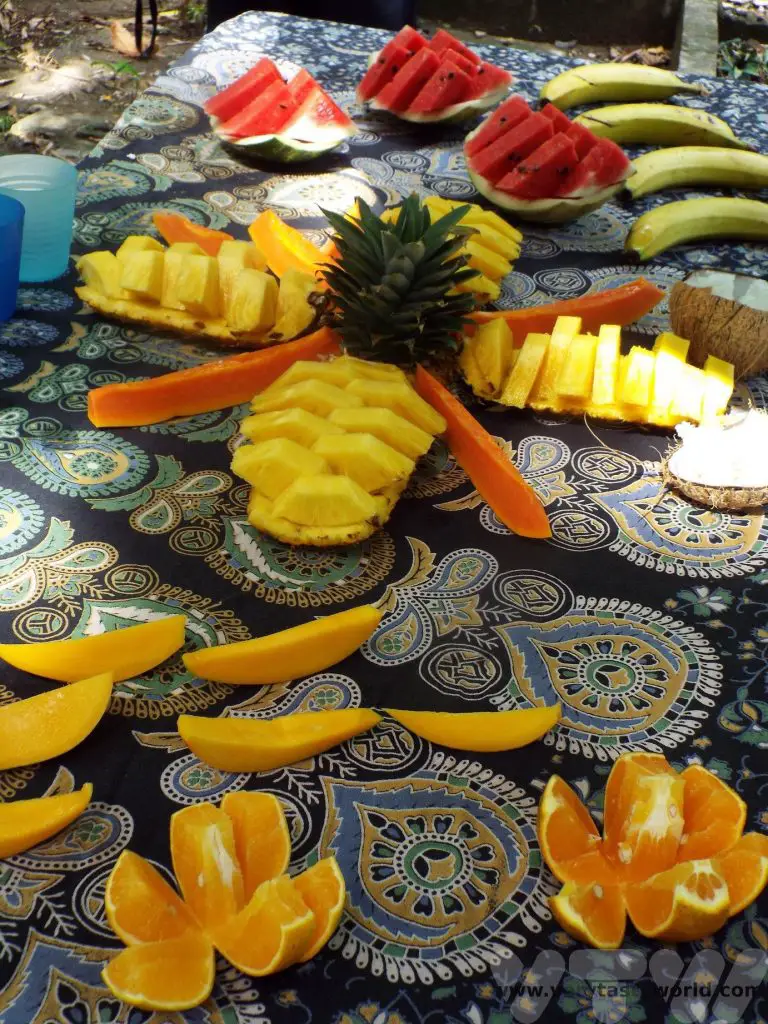
One of the wonderful things about Costa Rica is the utter deliciousness of the fruit. Around the Arenal Volcano area the soil is incredibly fertile and on our way to Caño Negro we saw vast plantations growing all sorts of fruit. In fact, the tour guide stopped the minibus a couple of times to buy some fruit from local sellers, so that he could offer us a taste. He also provided a running commentary throughout the journey telling us about the fruit industry in Costa Rica.
The pineapples were a revelation. Even the freshest pineapples we’ve ever eaten in the UK (often from Costa Rica!) were nothing compared to the organic local fruit. Most pineapples that are grown for export are treated chemically where they are stored (they can last up to a year) and ripened after they have arrived at their destination. It is such a shame that so many pineapples are grown this way – it isn’t good for the environment and the fruit’s flavour isn’t as good as it could be. Compare that to an organic pineapple and the taste is completely different. The local fruit had a really rich vibrant flavour, both sweet and tart.
The pineapple is actually a flowering plant. Only one flower grows each year per plant and it is only possible to gain a pineapple in three successive years. The first year’s is the biggest and these are the ones that are usually exported overseas. The second year’s pineapple is smaller and would generally be used for the local market or taken to a processing factory where it would likely end up in a tin. The third year’s fruit will be very small and will become juice.
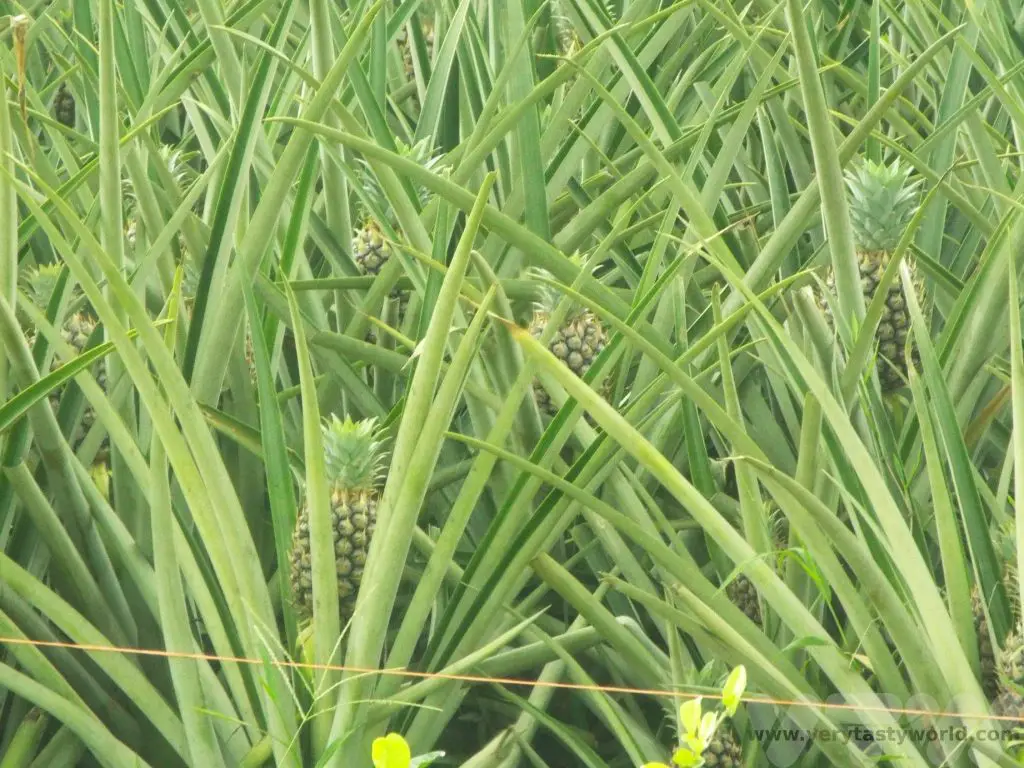
There’s a perception in many western countries that oranges should actually be orange. But many oranges aren’t as luridly orange as those classic fruit from Seville. The oranges in Costa Rica might not look the part but taste just fine. Bananas are another fruity staple of Costa Rica and plantations can be seen all over the country.
Many of the fruits grown in the country are familiar as they are exported around the world. However, there are some more unusual offerings which we were delighted to discover. Rambutan, also known as Mamon Chino, which apparently translates to Chinese Sucker, is a bizarre looking tropical fruit. You have to peel the pretty and colourful soft spikes to reveal the clear coloured flesh. They look similar to grapes or lychees and have a comparable texture although the flavour is very different, sweet and slightly sour, and nowhere near as perfumed as a lychee. There’s a seed inside that you need to be aware of – don’t bite too hard!
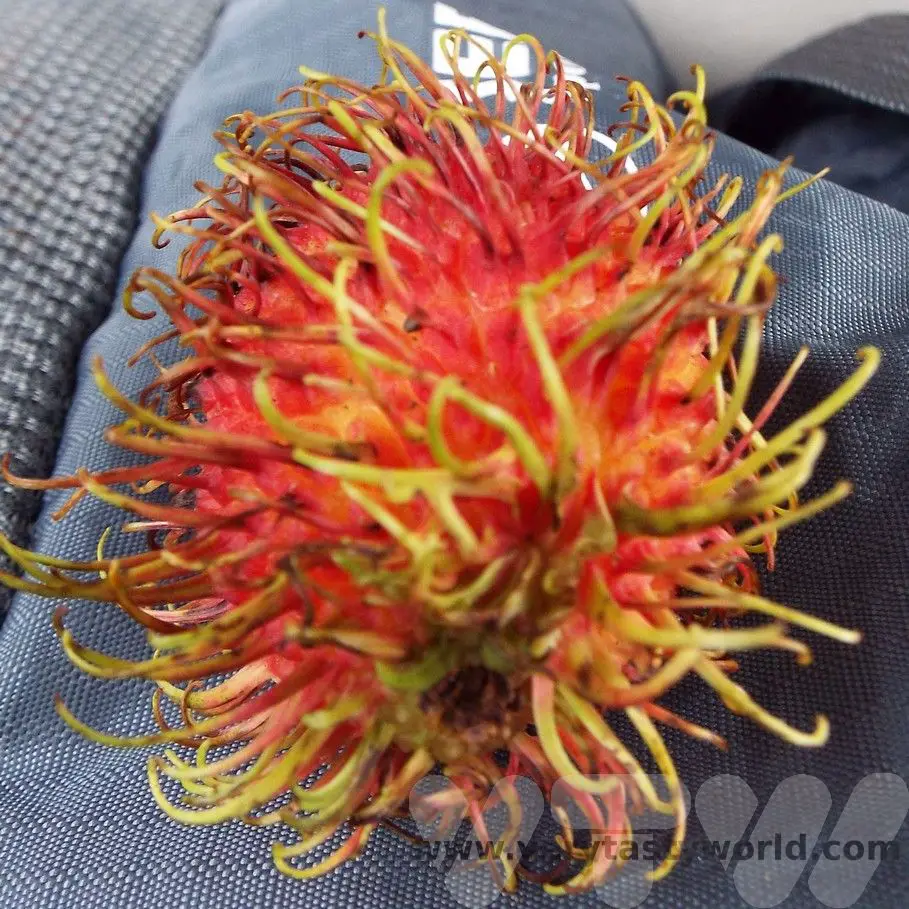
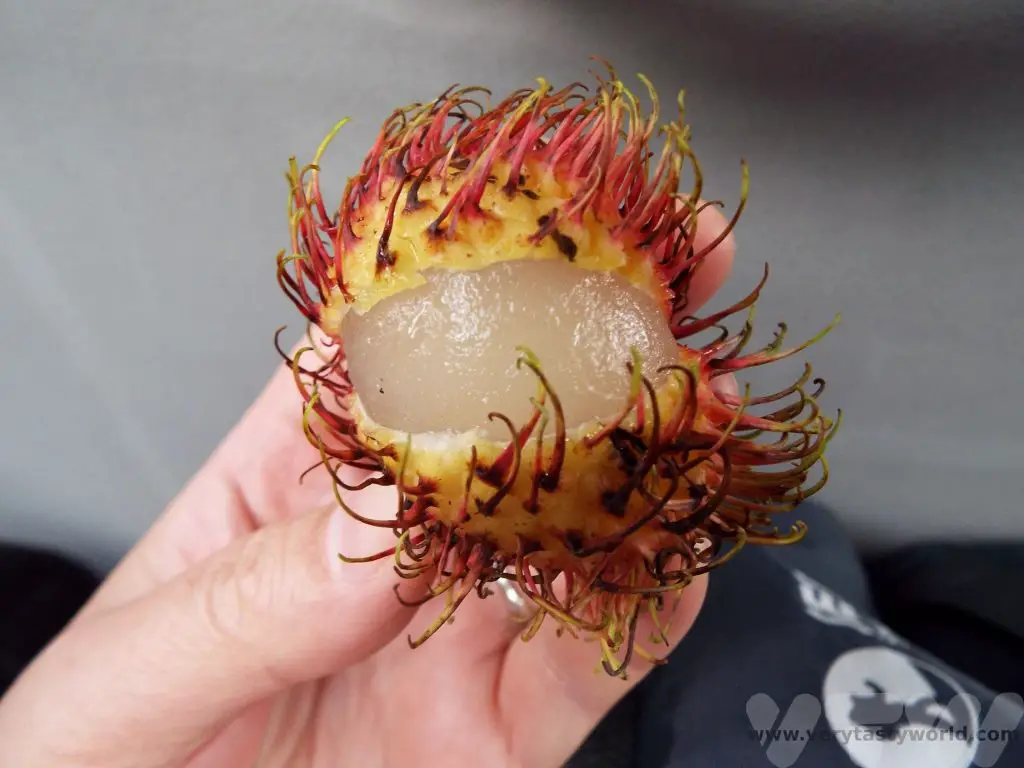
Noni is smelly and tastes bitter but apparently has health benefits. It’s not a fruit you would eat for pleasure. Some people mix it with other fruits in smoothies to disguise its flavour.

In Costa Rica you are guaranteed to enjoy at least ten of your ‘five a day’.
Related Posts You May Enjoy

- Best Time To Visit Machu Picchu 2024 Update
- A 2 Week Patagonia Itinerary
- Day of the Dead in Campeche
- A Galapagos Land Based Itinerary
- RECIPE: How to Make Costa Rica’s Gallo Pinto
- A Tasty Puebla Food Tour
- Costa Rica Wildlife Sanctuary – Caño Negro
- Visit Torres del Paine National Park in Patagonia
- Atacama Desert Itinerary
1 Day in Mostar, Bosnia and Herzegovina
We have recently returned from a holiday travelling through Croatia and Bosnia Herzegovina, two countries that we have long wanted to visit. We decided to take a fly-drive trip, flying in and then hiring a car so that we could have flexibility touring through these two beautiful countries. We spent 1 day in Mostar exploring this beautiful city with its iconic bridge.
Driving in Bosnia and Croatia
We flew into Dubrovnik in Croatia (as that worked best for our flights from the UK) and then hired a car at the airport. It’s always worth pre-booking the hire car. Driving in both countries is pretty easy – the roads are generally good (they are better in Croatia which has a more established tourism infrastructure) and, even better, usually free of traffic. Due to the mountainous nature of region dual carriageways were rare and the drives were leisurely but the scenery throughout each drive was spectacular. We kept to the speed limit – and be aware that there are speed cameras, particularly close to schools in towns – but were overtaken on quite a few occasions.
An ordinary driving licence was fine for driving in Croatia but we needed to obtain an International Driving Permit (1968 version, available from Post Offices in the UK for £5.50) in order to drive in Bosnia Herzegovina. It was also important to ensure that the car hire company provided the car’s registration and insurance paperwork as we could have been asked to show it to police or customs officials at any time, particularly in Bosnia.
Border crossings were generally easy – we just needed to join the queue for cars and simply hand over our passports at the first check-in booth and then answer any questions as the next one, the customs booth. In Bosnia Herzegovina proof of Covid vaccination was needed (at the time of travelling). We had printed our Covid passes out so they were easily to hand but a mobile phone app would have been just as good. Our itinerary took us in and out of both countries. After an overnight stay in Mali Ston we headed into Bosnia Herzegovina.
Bosnia and Herzegovina’s History
Bosnia Herzegovina has a long and complex history. Its location in the Balkans is often described as the crossroads between south and south-east Europe. Populated by south Slavic people it was annexed into the Ottoman Empire, who brought Islam to the area, in the middle of the 15th century. Hence the population comprises Serb (Orthodox Christians), Croat (Catholic) and Bosniak (Muslim) peoples. This is reflected in the multitude of churches and mosques that can be seen throughout the region.
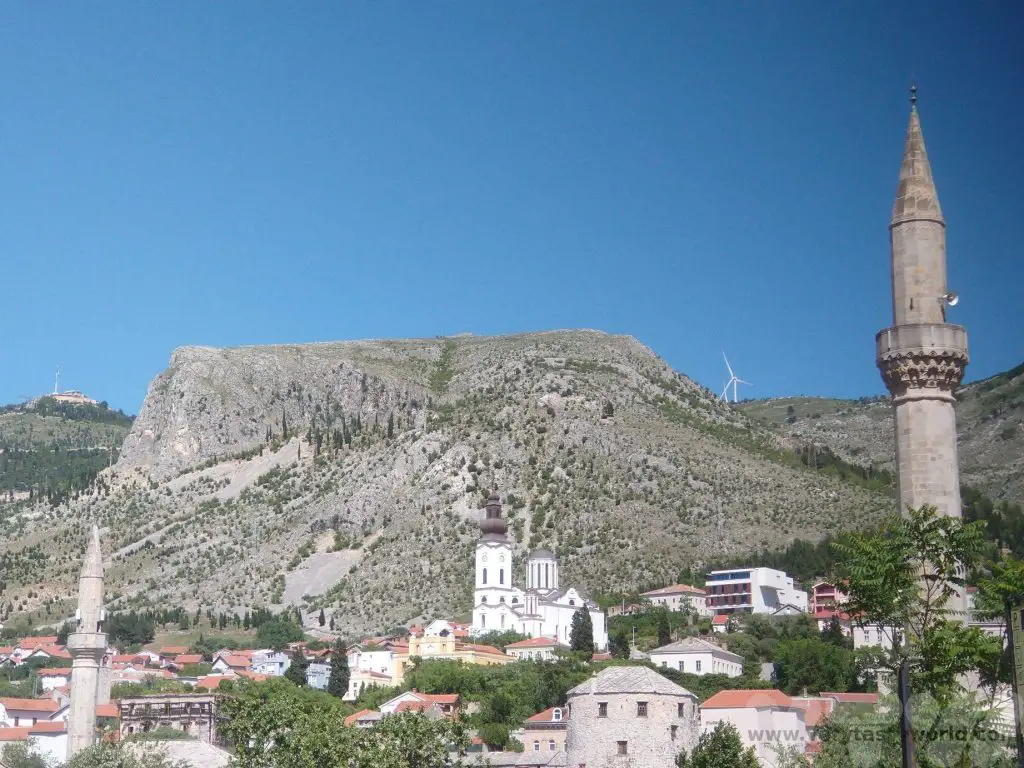
Mostar is the main (in fact, the only) city in Herzegovina. (The northern region of the country is Bosnia, with Sarajevo as its capital, and Herzegovina is the south.) Mostar is located on the Neretva river, surely one of the world’s most beautiful rivers, with its crystal clear turquoise water. The city is most famous for the Stari Most bridge that crosses the river. It was commissioned by Suleiman the Magnificent in 1557 and completed somewhere between 1566 and 1567.
It was the widest constructed arch in the world at the time at 30 metres long and 4 metres wide. The drop to the water is around 20 metres depending on the river level. The Ottomans were clever in that this was the only bridge spanning the river for several centuries – the word Mostar derives from ‘mostari’ – bridge keepers – so that the authorities could impose tolls on the traders who needed to cross as they moved their goods through the region. The bridge is flanked by two impressive towers.
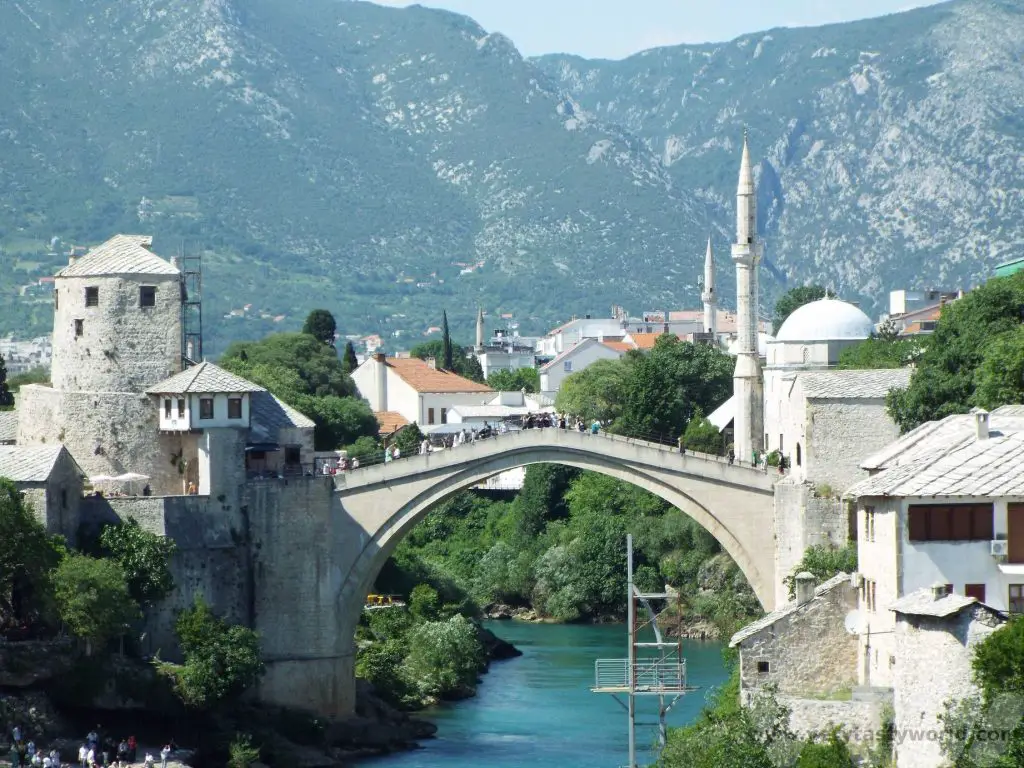
Following the decline of the Ottoman Empire and then the annexation of Bosnia Herzegovina by the Austro-Hungarian Empire in 1909, the Kingdom of Yugoslavia was established in 1929 after World War 1. This became the Socialist Federal Republic of Yugoslavia, under the rule of Josip Broz Tito, following World War 2. The region remained stable until the breakup of Yugoslavia in the early 1990s. Following Slovenia and Croatia’s respective secessions from Yugoslavia, Bosnia Herzegovina held an independence referendum in February 1992. The outcome was in favour but, while most Bosnian Croats and Muslim Bosniaks had voted, the referendum had been boycotted most of the Bosnian Serbs, a significant proportion of the population. A series of events following this led to war breaking out between the different groups. It lasted until December 1995.
It is incredibly difficult to summarise – let alone truly understand – the complexities of the war but what is undeniable is how horrific it was. This was a war that happened during our lifetime – we remember from seeing news reports on the television at the time. We spoke to a number of local people – from all ethnicities – during our time in Bosnia Herzegovina and they told us about their experiences living through the war, notably the Siege of Sarajevo. Following the peace declaration, the government structure in Bosnia Herzegovina has become incredibly complex with representatives from each ethnic group holding positions of power. For example, the country has three presidents: a Bosniak, a Serb, and a Croat.
One of the consequences of the war for Mostar was the destruction of the Stari Most bridge in December 1993. It was not only considered to be a strategic bridge (the other bridges crossing the river in Mostar were also destroyed) but also a cultural icon. The bridge was rebuilt after the war using funding from a variety of sources and many different countries contributed to the fund. The aim was to reconstruct the bridge in identical style and using similar materials (some salvaged from the original bridge where possible). It was reopened in 2004.
1 Day in Mostar – A Walking Tour
When visiting a new city, particularly when we are touring and short on time, we enjoy taking a walking tour. There are usually lots of options available but we especially like the ‘free tours’ which are run by local guides (who will expect a tip at the end of the tour and absolutely deserve one) who can show you the main places to visit in Mostar, explain the history of the area and give some personal insight into the country. They are also the perfect people to recommend local food and restaurants.
We started at the Spanish Gymnasium, which is the first public school in Mostar (the word derives from the European term for high school rather than being an exercise centre). It’s about a 20 minute walk from the centre of the city and is a good meeting point as its orange colour is very easy to spot. It is a working school so entering the building isn’t possible.
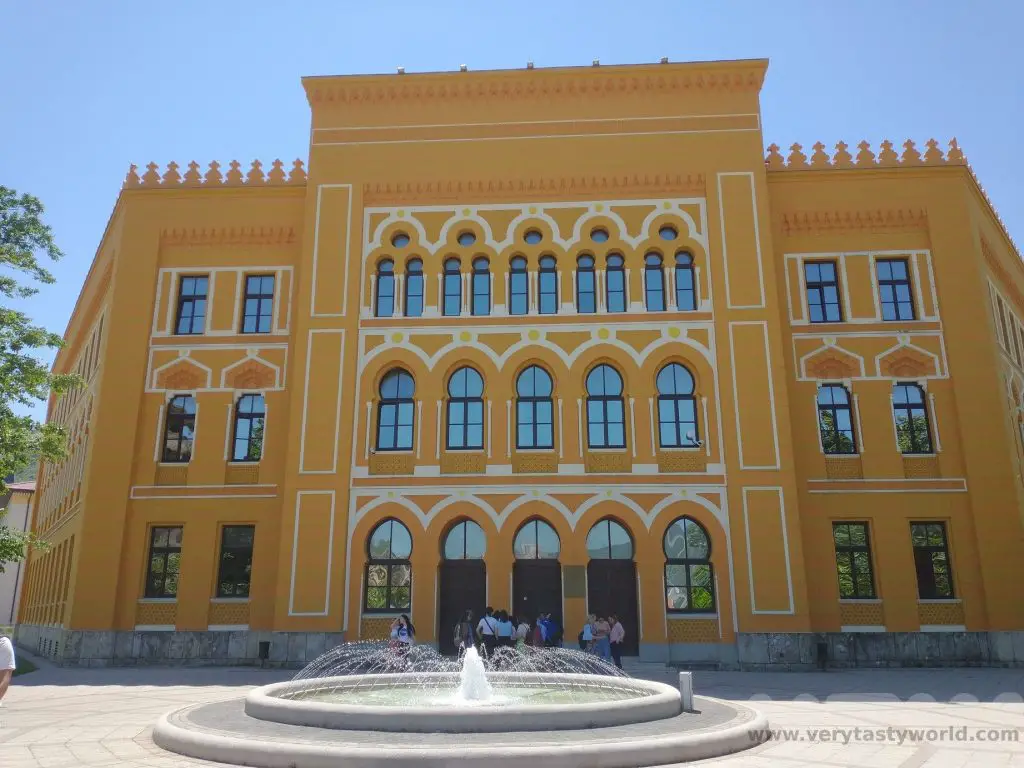
The gymnasium is located next to the Zrinjevac City Park, which is a pretty park that has a rather unusual statue. We really weren’t expecting to see a life-sized (well, apparently it’s 4cm short of life-sized) statue of Bruce Lee. Apparently he was chosen as a symbol of diversity and couldn’t be perceived to have an affiliation with any of the local ethnicities, but rather represented “loyalty, skill, friendship and justice.”

When walking around Mostar the scars of the war remain. We walked through the former financial district – many of the buildings are still shells. Our guide explained that while reconstruction work had taken place following the war, the capital Sarajevo had received more money to rebuild. There was still a lot of work that needed to be undertaken throughout Bosnia and Herzegovina.
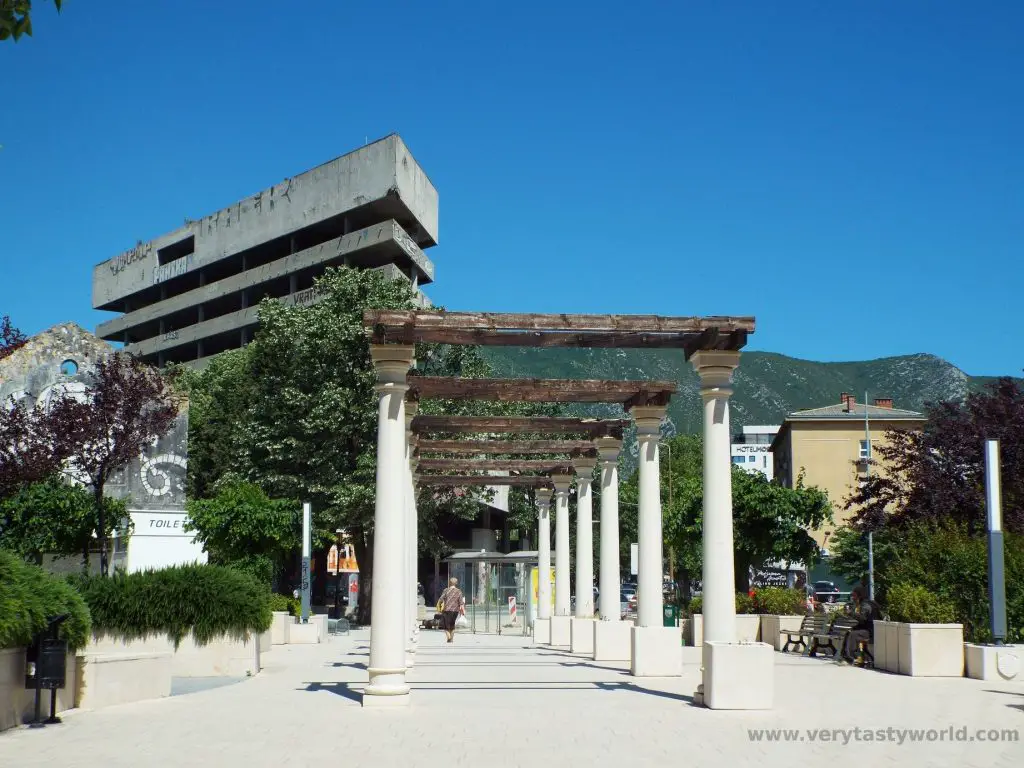
Walking across the Most Musula bridge we could see good views to the hills above. Although walking up to the summit would ensure a magnificent panorama of the city, the area sadly still contains land-mines.
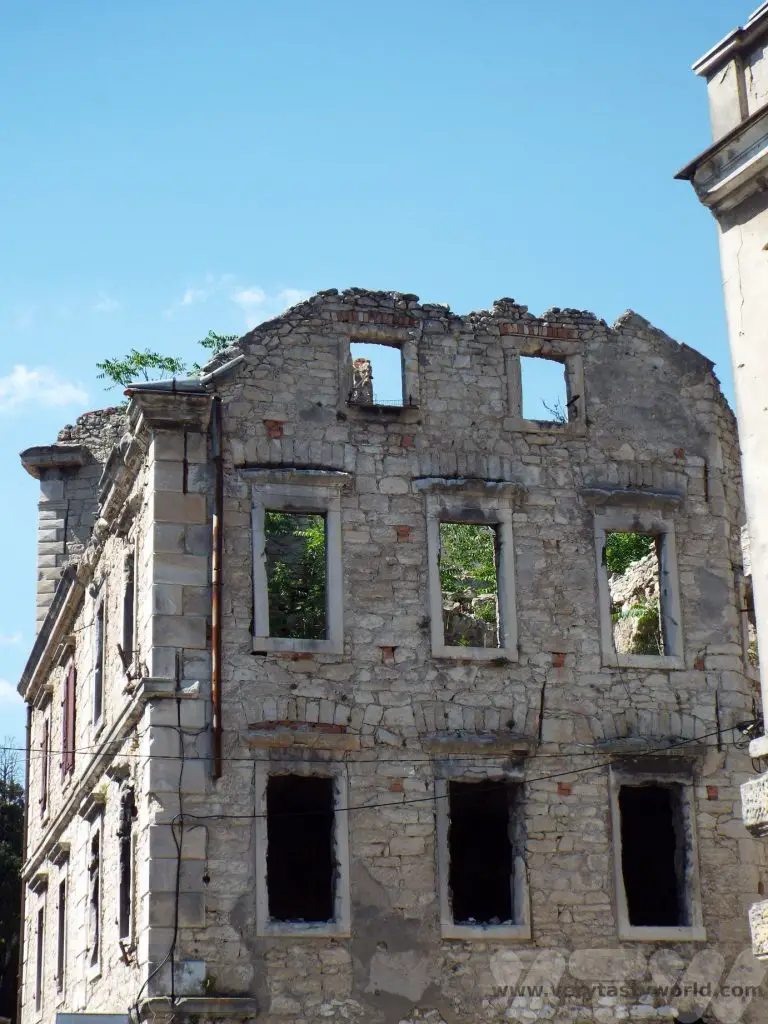
We then headed towards the older part of the city. The Karadoz Bey Mosque is one of the largest mosques in the region and dates from the same year as the Stari Most bridge.
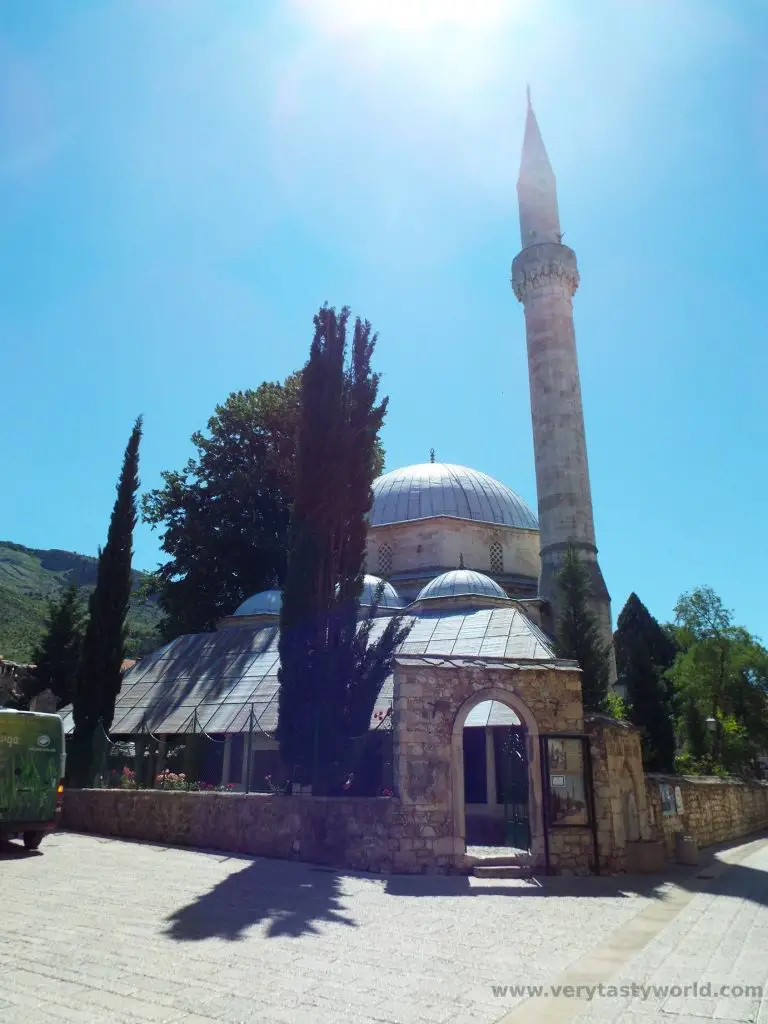
It is possible to visit the Koski Mehmed Pasha Mosque. It is located on a side street just away from the main street.

Outside is a fountain traditionally used for washing before entering the mosque to pray.

For visitors it costs 4 Euros to enter the mosque and a further 4 Euros to climb the minaret. Photos were allowed and, although we asked if they would like us to remove our shoes and cover our heads, we were told that it wasn’t necessary.

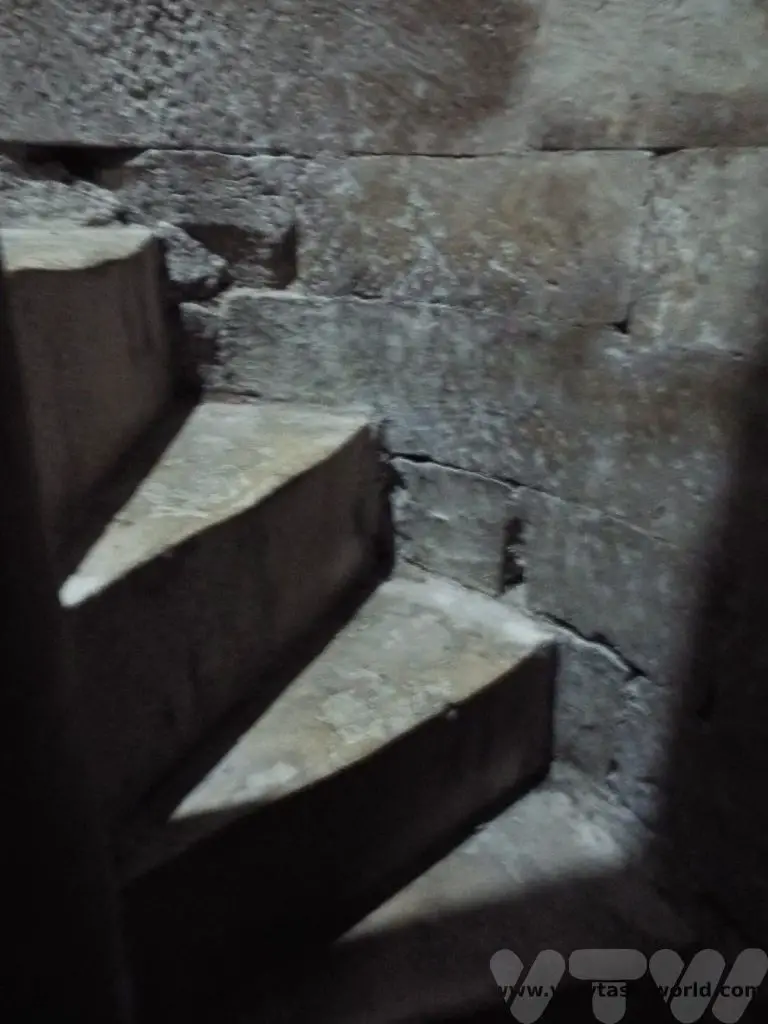
The interior of the mosque itself is quite compact and the climb to the top of the minaret was fairly claustrophobic.
However the view across the river to the bridge was spectacular. The balcony of the minaret was pretty narrow so we were lucky that there was only one other visitor there. You can also enter the small garden adjacent to the mosque for more river views.
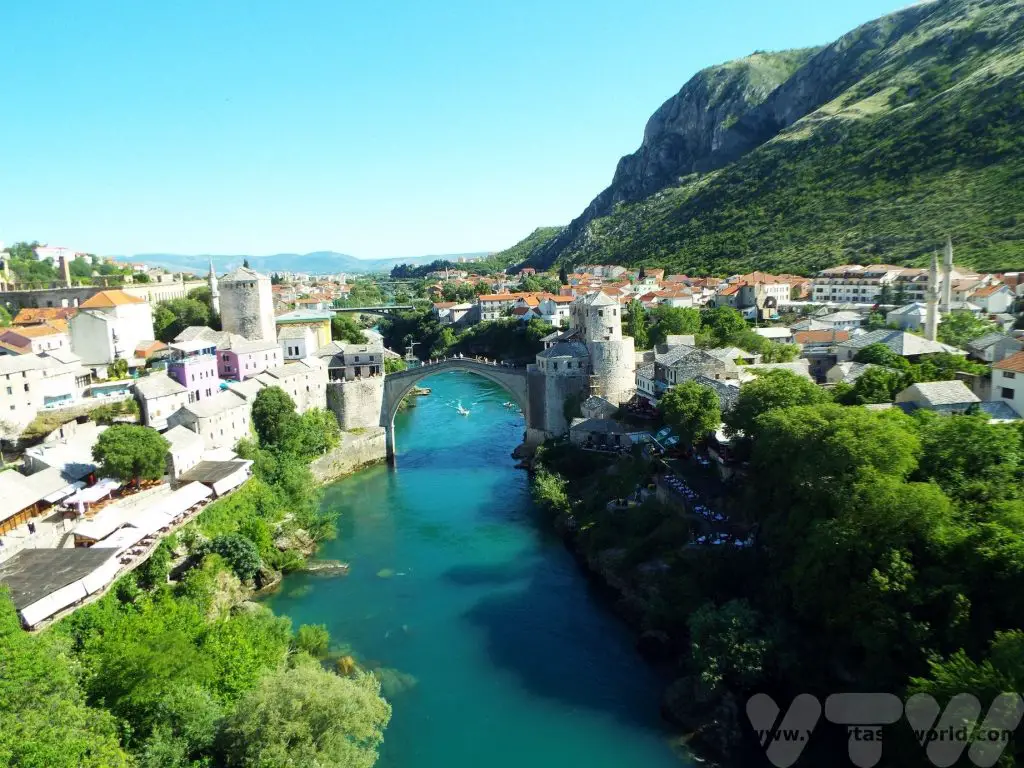
Wandering through the old town, there are lots of shops and restaurants. It is very touristy and can get crowded during the day. There are also a couple of museums in this area, The Museum of War and Genocide Victims 1992-1995 and also the Bridge Museum, which we were keen to visit, but sadly it was closed. There were reminders of the war as we walked through the streets.


Approaching Stari Most again we crossed the river over the old bridge. The steps can be quite slippery.
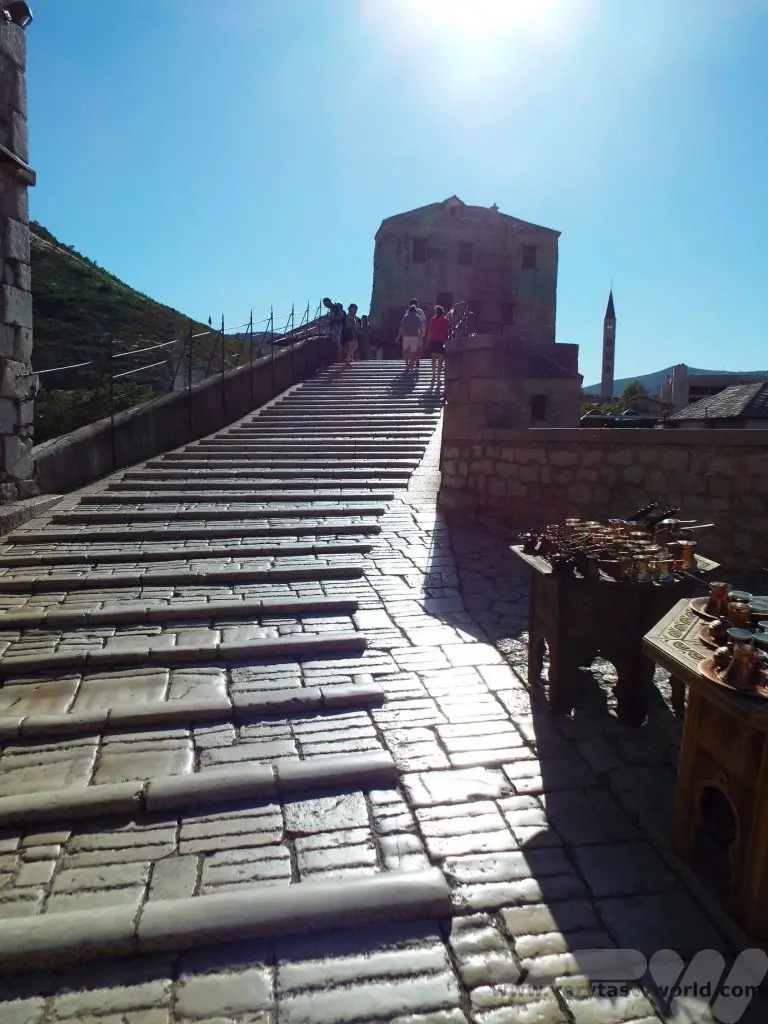
One thing that is very popular is watching locals who dive from the bridge into the crystal clear water below. You’ll see them hanging around at the top of the bridge, sitting on the top railing, and they will usually dive once they have raised enough money – normally in the region of 50 Euros – from tourists. You will be able to tell when they are ready to dive when either one of them dons a wetsuit or they start splashing themselves with cold water because the temperature of the river is extremely cold, especially in spring and early summer. We were some distance from the bridge, upriver, when we saw a diver preparing to go. Despite the camera being focussed and on full zoom, we only managed to capture the splash! There are diving competitions held in Mostar each year.
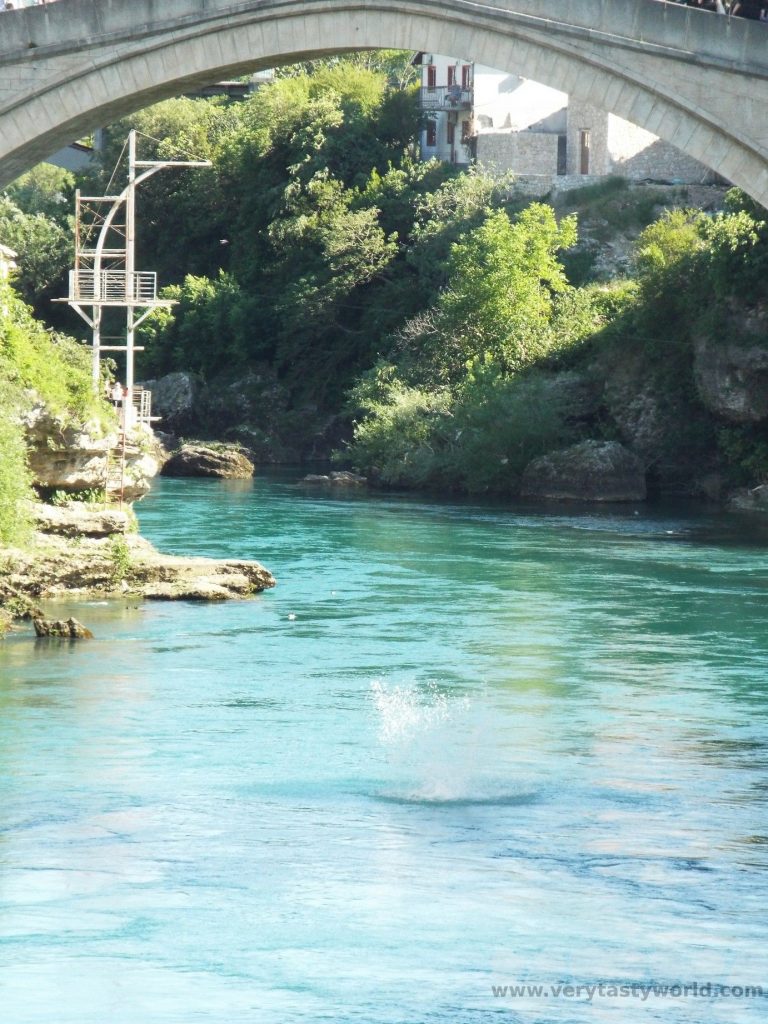
It’s worth noting that the bridge is a focal point for tourists and, because the city is only a couple of hours’ drive away from Croatia, it gets very busy during the late morning and afternoon as day trippers arrive in their coachloads. The surrounding streets and bazaars will be teeming with people. So staying overnight to explore the area and view the bridge when it’s less busy is definitely recommended.
Our walking tour concluded by another stone bridge – the Crooked Bridge – just a five minute walk away from Stari Most. It dates from 1558. It was strategically important because it allowed traffic to be controlled from the towers of the old bridge. This, too, is a reconstruction – sadly the original was destroyed during floods in 1999, but it was rebuilt in 2002.
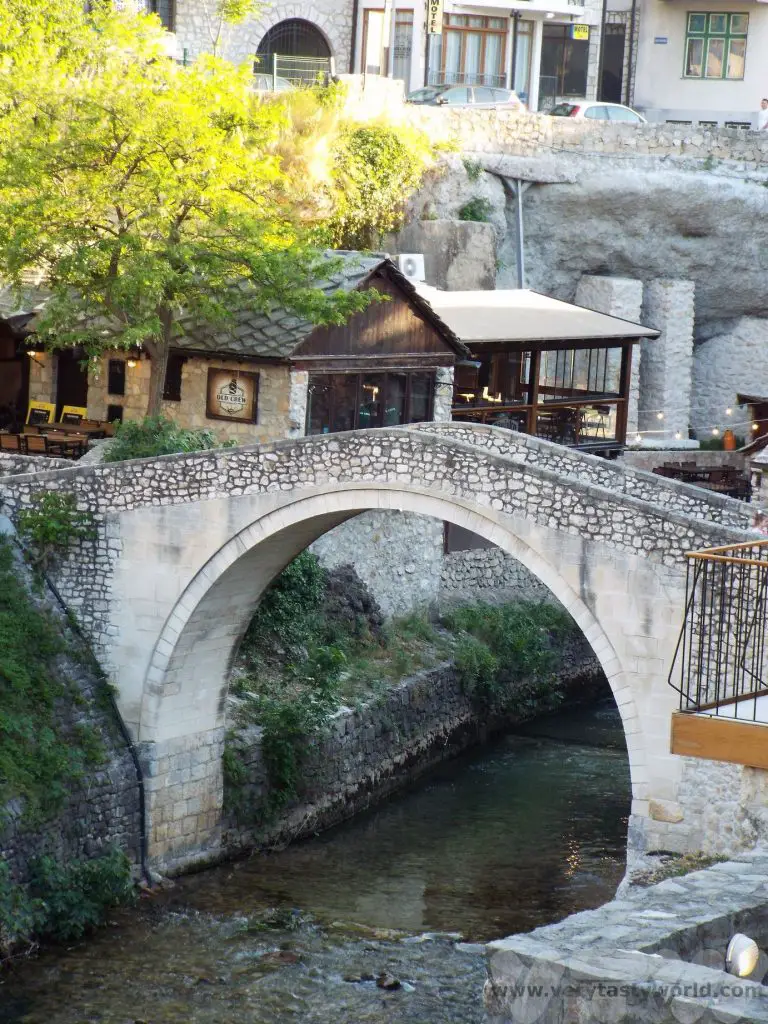
Dining Out in Mostar
There are loads of eateries offering tasty food in Mostar. The restaurants closest to the bridge, or those with a good view of it, are likely to be more expensive than those in the surrounding streets. Mostar was our first introduction to Bosnian cuisine. The national dish is considered to be cevapi – little meaty sausages/kebabs served inside a bread called somun which is a flatbread like pitta but has a really nice focaccia-like spongey texture. It’s served with chopped raw onions, which are quite sweet in flavour rather than being too pungent. You usually get a choice of a small portion (5 little sausages) or larger portion (10 little sausages). Many of the dishes we tried in both Bosnia Herzegovina and Croatia were accompanied by ajvar, a condiment made from red peppers (it isn’t spicy).
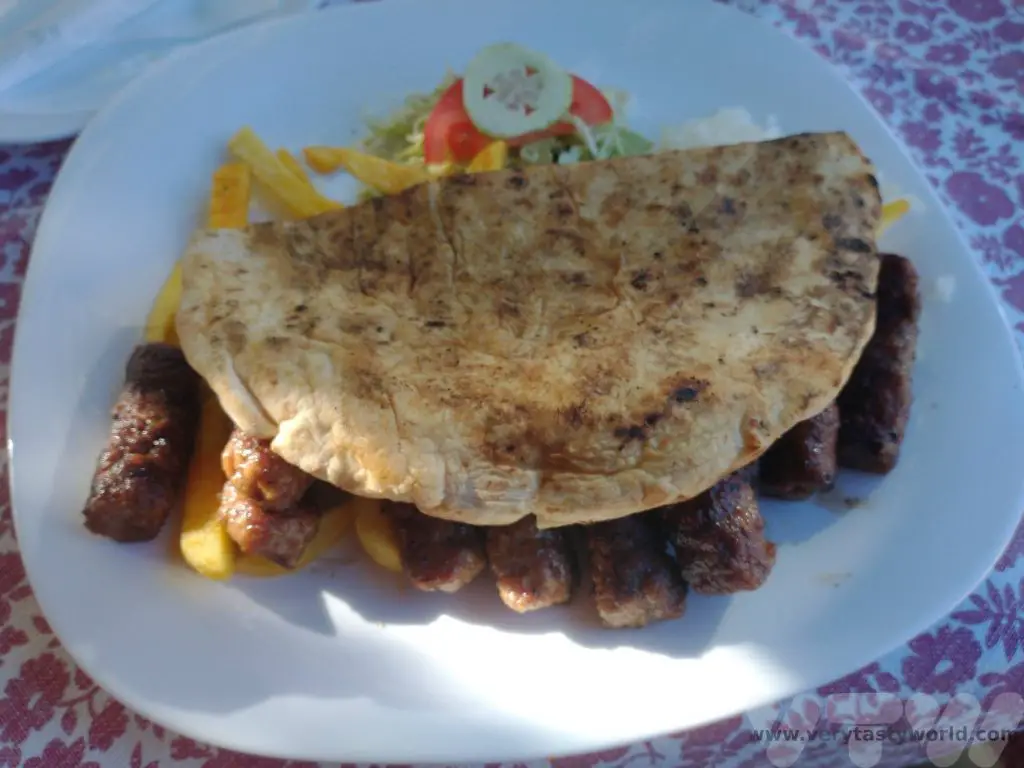
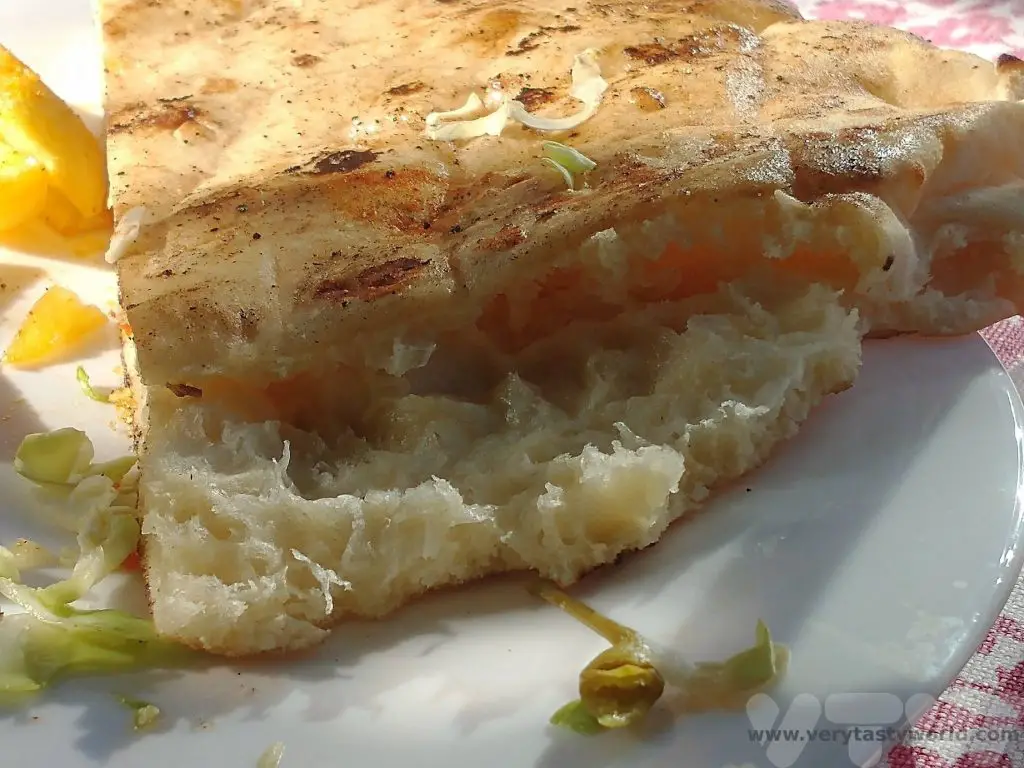
There are plenty of sweet dishes on offer as well. Baklava is a familiar dessert, a sweet, filo-based pastry, filled with layers of nuts and a sweet syrup, popular across the region and the Middle East. We particularly enjoyed hurmasica, a pastry doused in lemon-flavoured sugar syrup. It comes in an oblong shape and is very sweet but really delicious with a nice gooey cake-like texture.

And a meal wouldn’t be complete without a cup of incredibly strong, rich, sweet coffee. Coffee culture is very important in this part of the world.
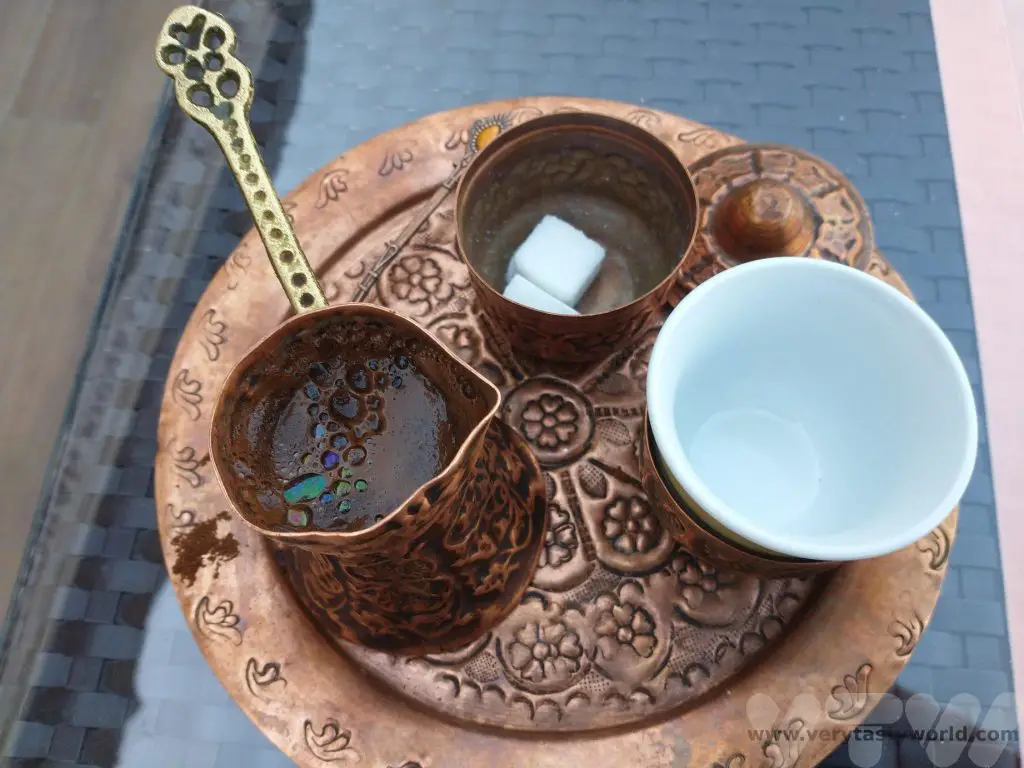
There was also a very good craft beer emporium in Mostar,on Gojka Vukovica, close to the Crooked Bridge. It had a wide variety of local beers on offer, brewed in both Mostar and Sarajevo. We particularly enjoyed Marakuja, an American Pale Ale, Onano Maze, a rich porter, Darkness, a dry Irish Stout and Kukambera, a cucumber-infused lager which was really refreshing on a hot spring day.
And if you’re after something stronger, rakija is the local brandy made from fermented fruit. Its alcohol content can range from around 40% to 60%. It’s not uncommon for local people to make their own rakija. One of the guides we met told us that it was the cure for all ailments! What’s nice about it is that, even though the alcohol content is strong, you don’t just get a blast of booze, the flavours of the base fruit really do come through – it’s a pleasant tipple.
After dinner, when the day trippers have melted away, it’s lovely to wander through the city at night. The bridge and local buildings are lit up beautifully and Mostar becomes a much more peaceful place.
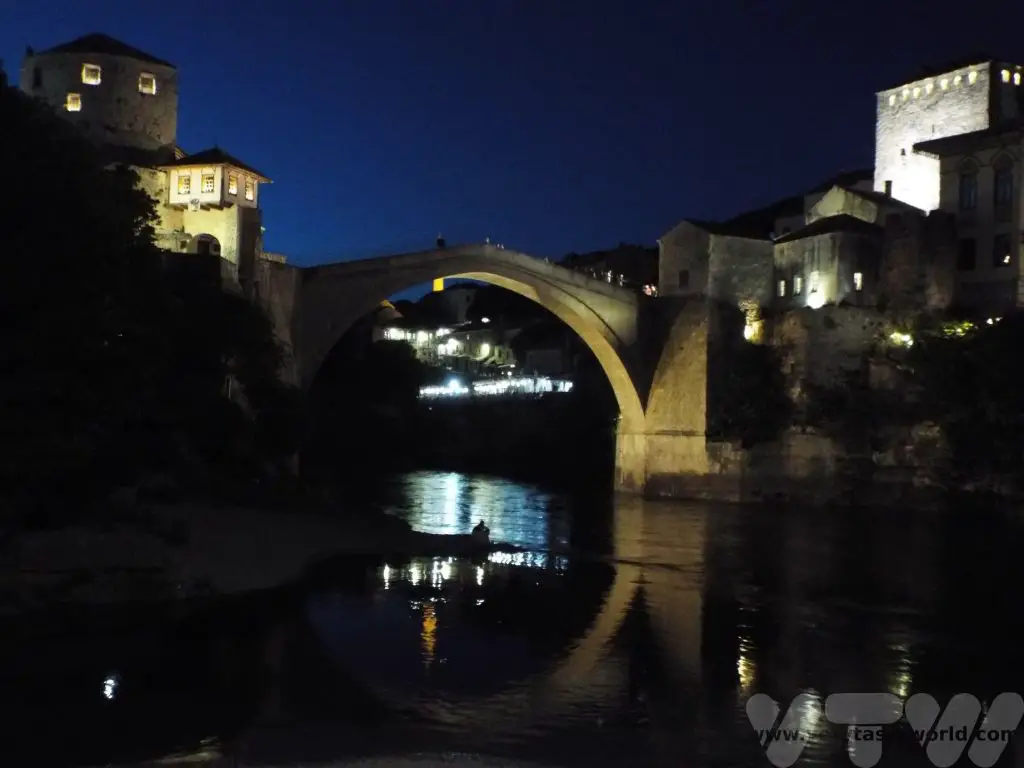
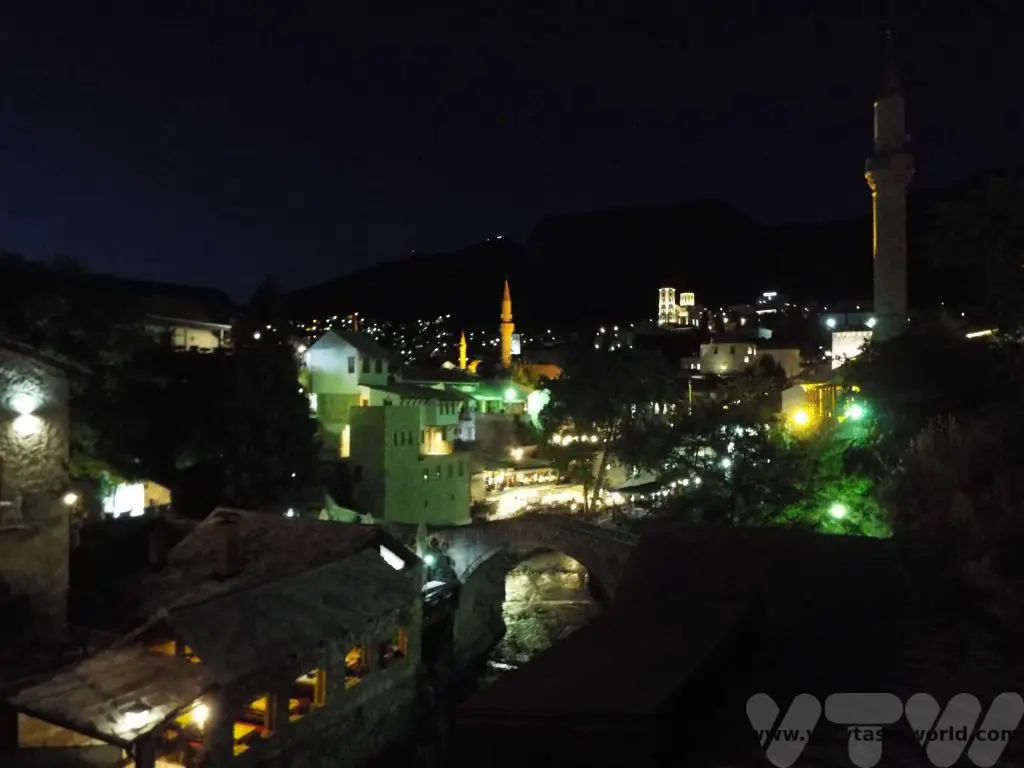
It is possible to see many sights in just one day in Mostar. We recommend staying overnight if you can, or at least waiting until the evening to see the iconic bridge beautifully lit up.
Related Posts You May Enjoy

RECIPE: Salmorejo
Andalusian Cold Tomato Soup
In Spain, cold soups are perfect for a hot summer’s day. Gazpacho is probably the most well known – a blend of fresh tomatoes and other vegetables, such as cucumber, peppers and garlic. Salmorejo is another cold soup, which also originated in Andalusia. We first tried it in a tapas restaurant when we visit Seville and absolutely loved it. It is a blend of tomatoes but has the addition of bread which thickens the soup. It’s a great soup that also helps to avoid food waste as it works really well if the bread is slightly stale.
In the UK tomatoes aren’t that great. Supermarkets often sell perfectly round, perfectly red tomatoes that basically taste of water. We go to our local market for our toms or grow our own. (And home grown always taste better.) What is great about Salmorejo is that even if the tomatoes are a bit insipid, the flavourings ensure that the dish will be delicious.
Our recipe for salmorejo is really easy to make but you will need a blender. This will serve four if part of a wider tapas meal/starter or two hungry people. Also, it’s the sort of soup that you can make first thing in the morning and let the flavours infuse during the day. It even tastes great after being in the fridge overnight.
Ingredients
About 10 ripe tomatoes
3 slices of stale white bread
Clove of garlic (or another if you like garlic but we prefer subtle garlic here)
Good slosh of extra virgin olive oil
Salt and pepper
1 boiled egg per 2 servings
Couple of slices of ham
Method
First of all the tomatoes need to be skinned. The easiest way to do this is to cut a cross at the end of the tomato (the opposite end to the stalk). It doesn’t need to be precise and it doesn’t matter if you cut into the tomato’s flesh -it’s all going to be blended anyway.

Pour boiling water over the tomatoes and let them sit in the water for a couple of minutes. Then transfer them to a bowl of cold water.
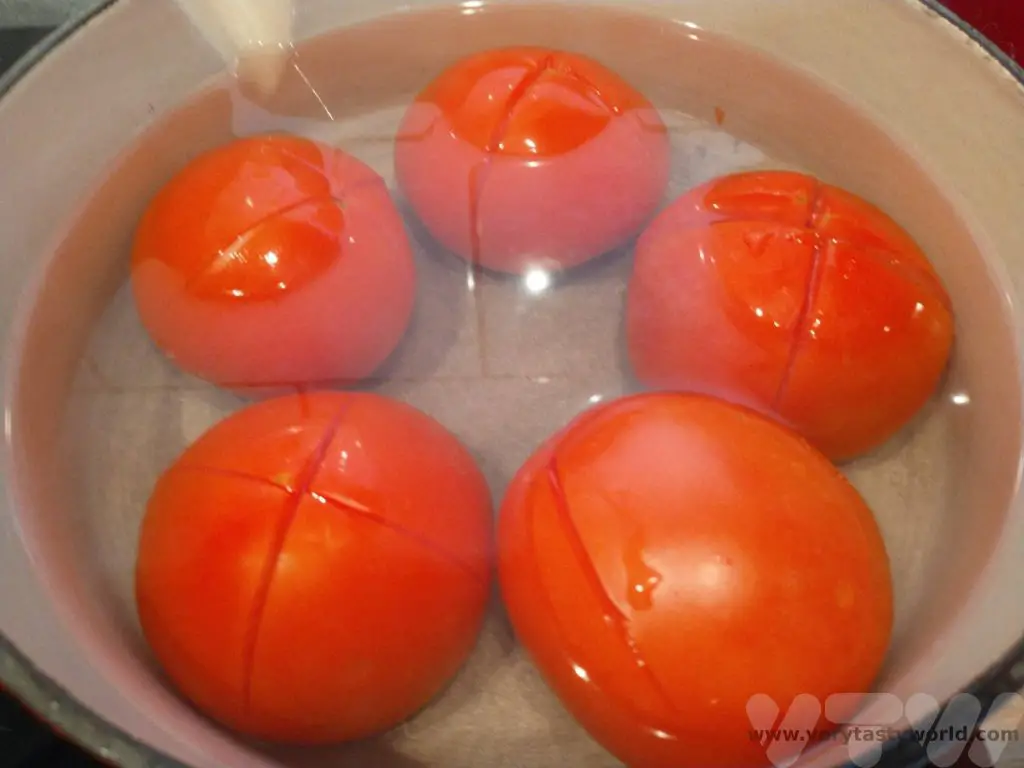
Grab a corner where the slice was made and the skins should just peel away. It’s not the end of the world if you don’t get all the skin off.
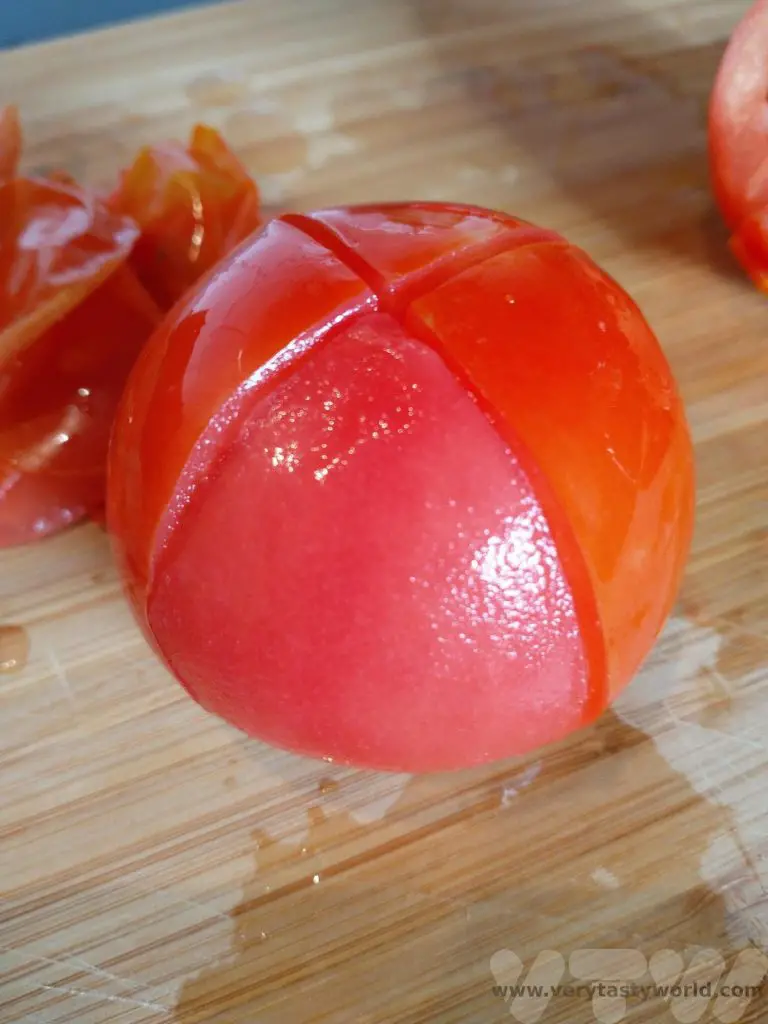
Put the tomatoes in the blender and give them a quick whiz.
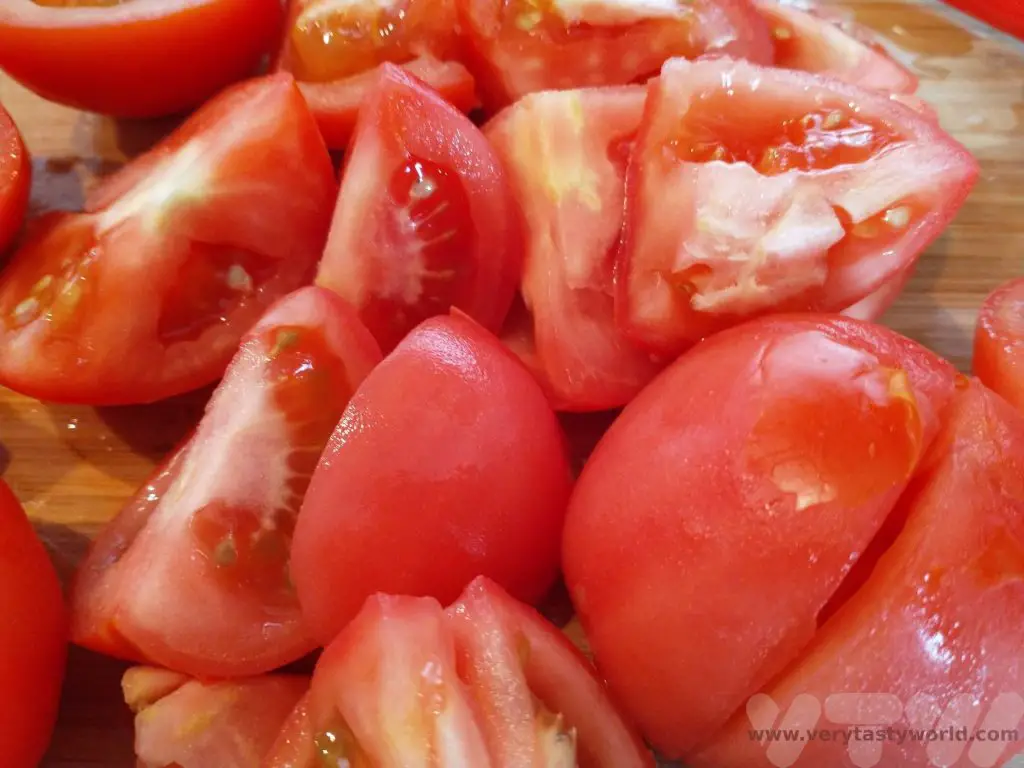
Then tear the bread slices and add those, along with the garlic, oil, salt and pepper.

Blend again until you have a smooth, thick soup.

Pour into a jug then put into the fridge and let the flavours infuse.
Serve into individual bowls and garnish with chopped boiled egg and/or chopped ham.
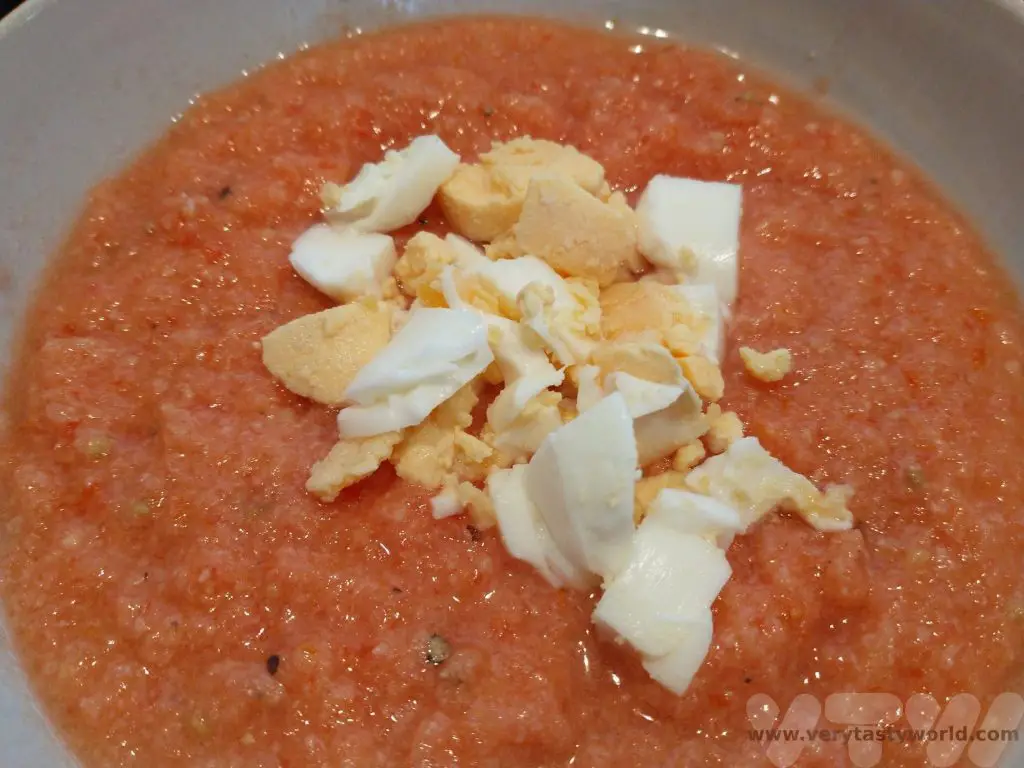

- RECIPE Oyakodon Donburi
- Zero Waste Recipes Before Your Holiday
- RECIPE: Vegetable Biryani Tamil Nadu Style
- RECIPE: Vegan Wild Garlic Pesto
- Recipe: Venetian Pasta Sauce
- RECIPE: Biryani Raita Recipe
- RECIPE: How to Make Costa Rica’s Gallo Pinto
- Recipe: Japanese Simmered Pork Belly – Buta no Kakuni
- RECIPE: How to Make Umeboshi
RECIPE: Japanese Fried Chicken Karaage
Fried chicken is one of life’s great pleasures. And Japanese fried chicken karaage is no exception. In Japan, it is a tradition to eat fried chicken from KFC on Christmas Day before the traditional new year celebrations commence. However, we feel that JFC offers far superior fried chicken.
Always use chicken thigh meat. It has so much more flavour than breast meat and is guaranteed to be juicier and more succulent.

Making karaage isn’t difficult but it also isn’t a quick process. However the results are definitely worth taking the time to make the dish. The chicken absolutely needs to be marinated – this adds so much flavour. The word karaage refers to the cooking technique, that is frying the food in oil. You don’t need equipment such as a deep fat fryer – a frying pan will be just fine.
Recipe for Japanese fried chicken karaage:
Ingredients
Serves 4
800g boneless chicken thigh (skin-on is fine), each thigh cut into 4 pieces
For the marinade
4 tbs soy sauce
1 tbs mirin (if you can’t get this, add a little more sake/wine and a tsp of sugar)
1 tbs cooking sake (or white wine if you can’t get that)
1 inch of ginger (finely grated)
1-2 cloves of garlic (finely grated) depending on how garlicky you like your food
For the coating
Potato starch. If you can’t get this, fine rice flour or even cornflour will be fine. (Icing sugar would not!) We didn’t have quite enough potato starch so mixed in a little rice flour. About a cup’s worth (275ml) – as much as you need to coat all the chicken.
For the cooking
Vegetable oil (enough to get about 1 cm depth of oil in your pan)
Method
Place the chicken thigh pieces in a bowl and add the soy sauce, mirin, sake, ginger and garlic. Mix well and leave to marinate for at least an hour.

Pour the oil into a frying pan until it’s about 1 cm deep. Heat up. The oil will be hot enough when you put a little flour into it and it sizzles.
When the chicken has had a chance to acquire those lovely flavours pour the potato starch into a bowl.

Take each piece of chicken, dip both sides in the flour, shake any excess off, and then carefully place in the oil.

Repeat for further pieces of chicken. Do not overfill the pan – this is a process whereby the chicken should be cooked in batches. We tend to use a clock method – put a piece of chicken at the top, then go round the pan putting further pieces in in a clockwise direction so we know which piece was put in first. Cook the chicken for 5-7 minutes, turning occasionally, until the pieces are golden brown.
Then remove from the oil and place on kitchen paper to soak up excess oil. You can transfer the chicken from the first batches into a heatproof bowl in the oven set on a low heat to keep them warm.

Start the next batch and repeat until all the chicken has been cooked.

Serve with Japanese mayo. It’s not at all healthy but it’s oh, so decadent and delicious! If you’re feeling more health conscious, shredded cabbage is a popular accompaniment.

Karaage chicken is also yummy when served cold the following day. It often features in bento boxes.
Related Posts You May Enjoy

- RECIPE Oyakodon Donburi
- Zero Waste Recipes Before Your Holiday
- RECIPE: Vegetable Biryani Tamil Nadu Style
- RECIPE: Vegan Wild Garlic Pesto
- Recipe: Venetian Pasta Sauce
- RECIPE: Biryani Raita Recipe
- RECIPE: How to Make Costa Rica’s Gallo Pinto
- Recipe: Japanese Simmered Pork Belly – Buta no Kakuni
- RECIPE: How to Make Umeboshi
Hiking In El Chaltén, Patagonia
When travelling in Argentinian Patagonia, Los Glaciares National Park is an essential place to visit. While El Calafate is the focal town, with its stunningly beautiful lake and spectacular glaciers, such as the Perito Moreno glacier, nearby, the small town of El Chaltén is also well worth a visit. The main activity in the area is walking and enjoying the great outdoors, so whether you’re a manic mountaineer, a high-spirited hiker, a rapturous rambler or simply savour a serious stroll, El Chaltén has gorgeous scenery and walks available for all abilities. Here’s a guide to some gentle hiking in El Chaltén.
Getting To El Chaltén
El Chaltén is located around 220km north of El Calafate and it’s a three to four hour bus ride from there. Buses run several times a day from the bus station. It’s worth booking a ticket in advance, especially during busy seasons. The buses are large and comfortable. The journey is exceptionally pretty as it takes you through beautifully picturesque scenery.
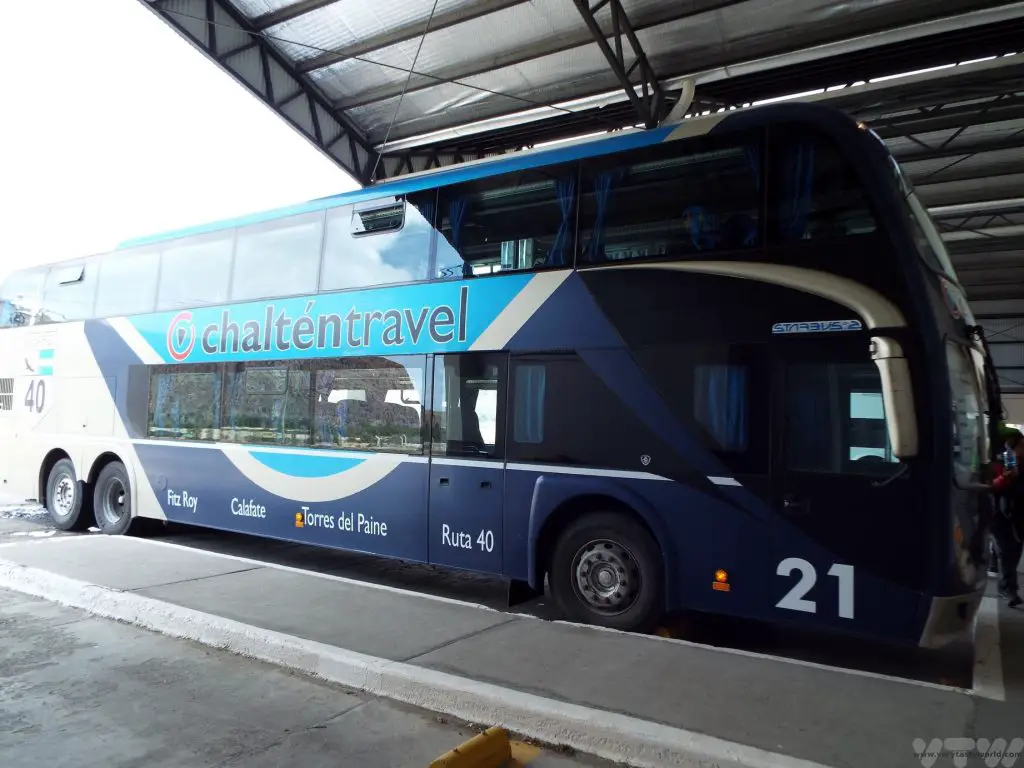
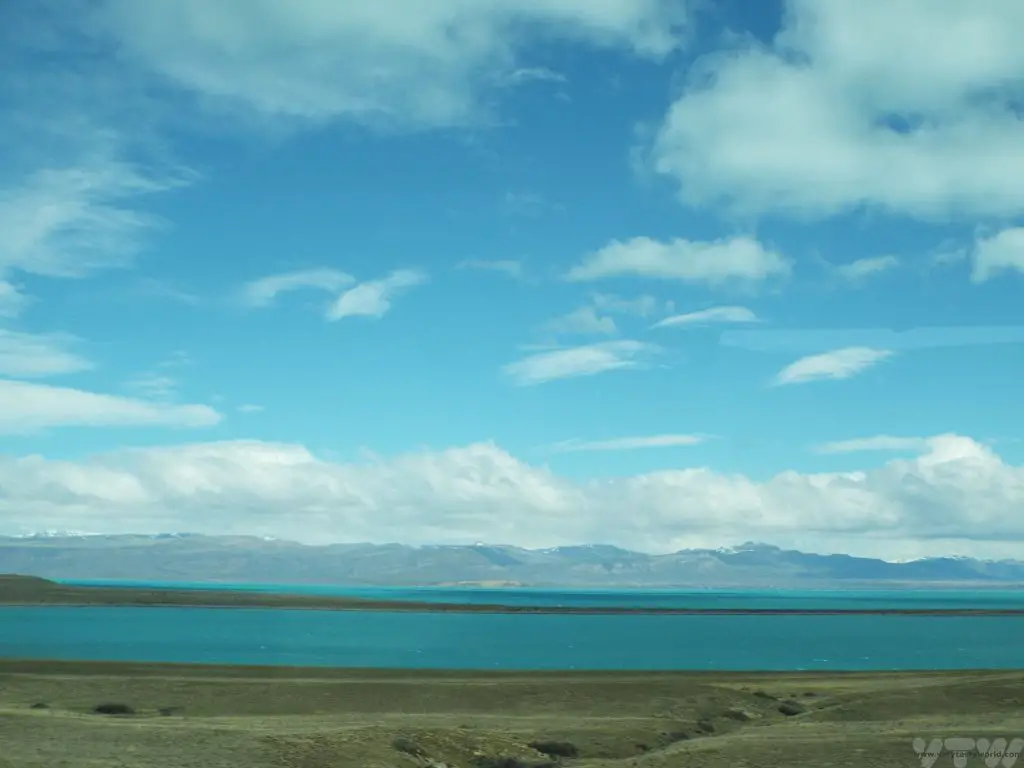
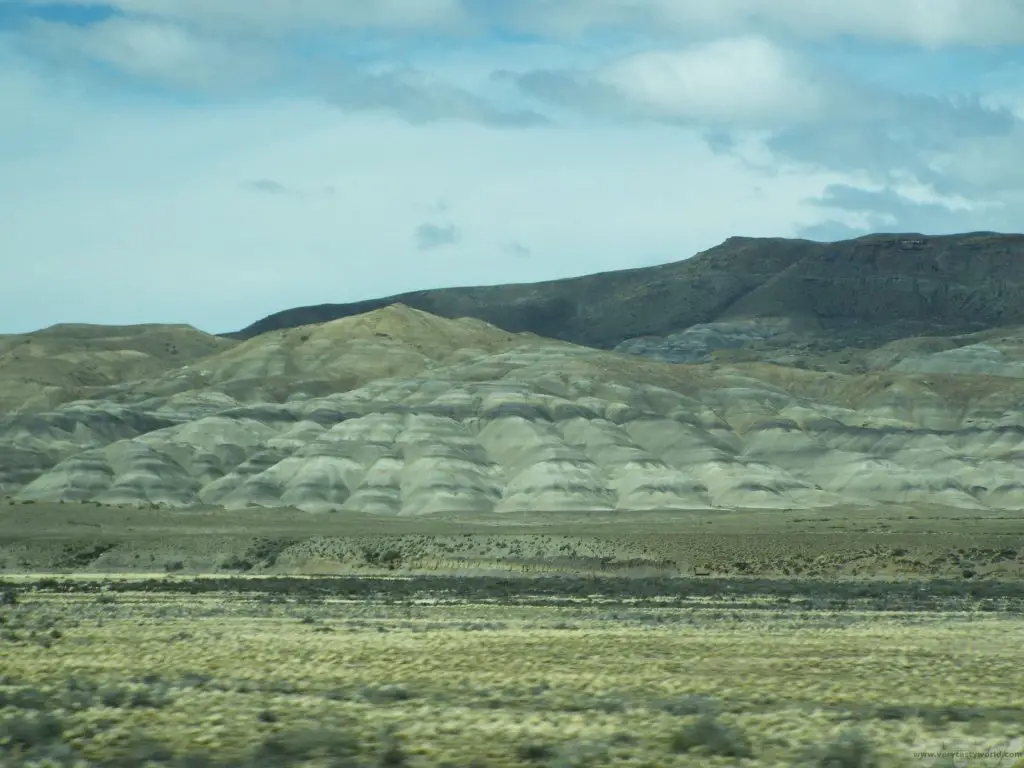
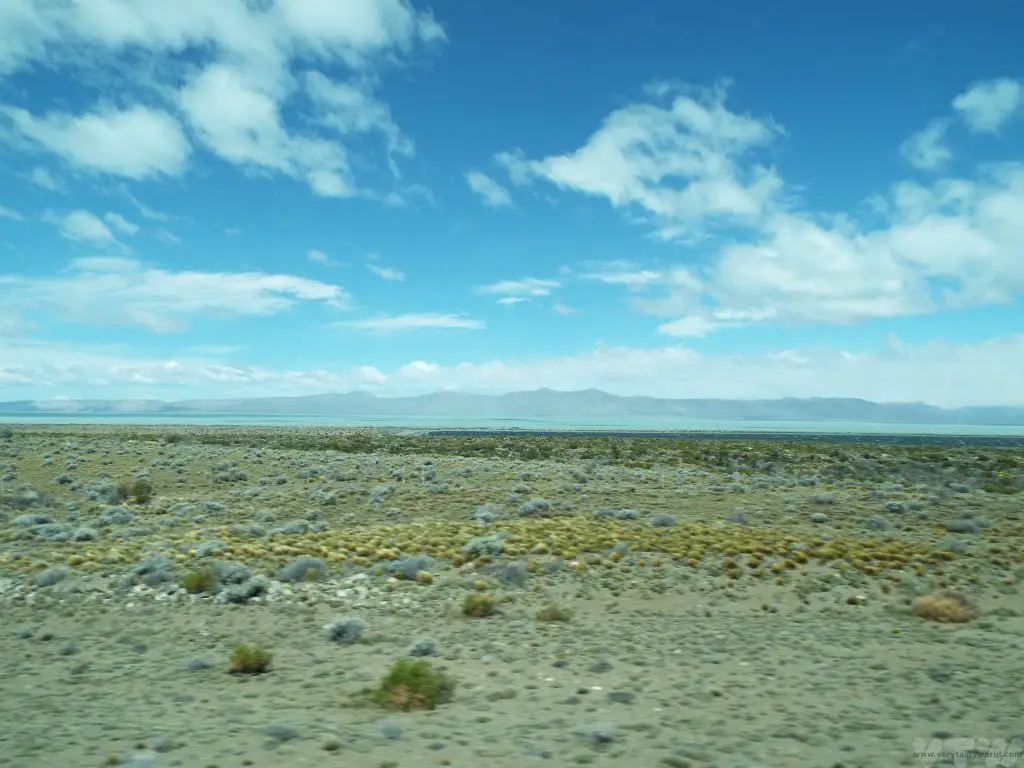
When you arrive, the bus will actually stop at the tourist centre just outside the town so that you can get an orientation talk (available in English and Spanish and there’s no charge for this) and pick up a hiking map. Then it’s back onto the bus for about 2 minutes to cross the Fitz Roy river before arriving at the bus station where you disembark.
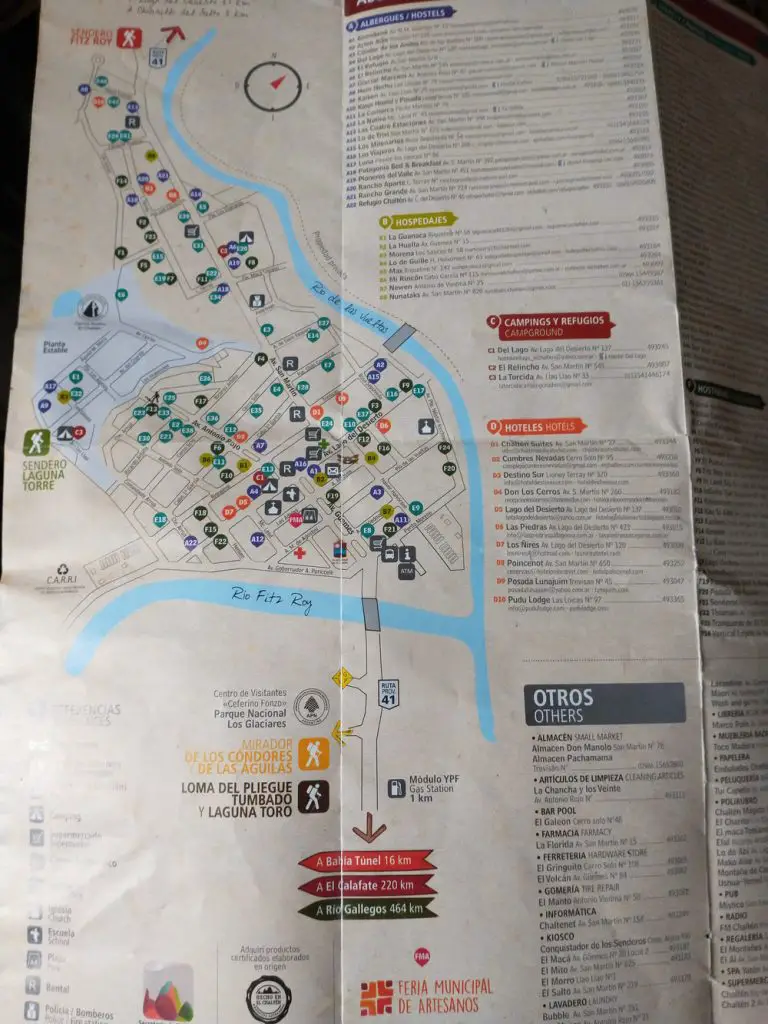
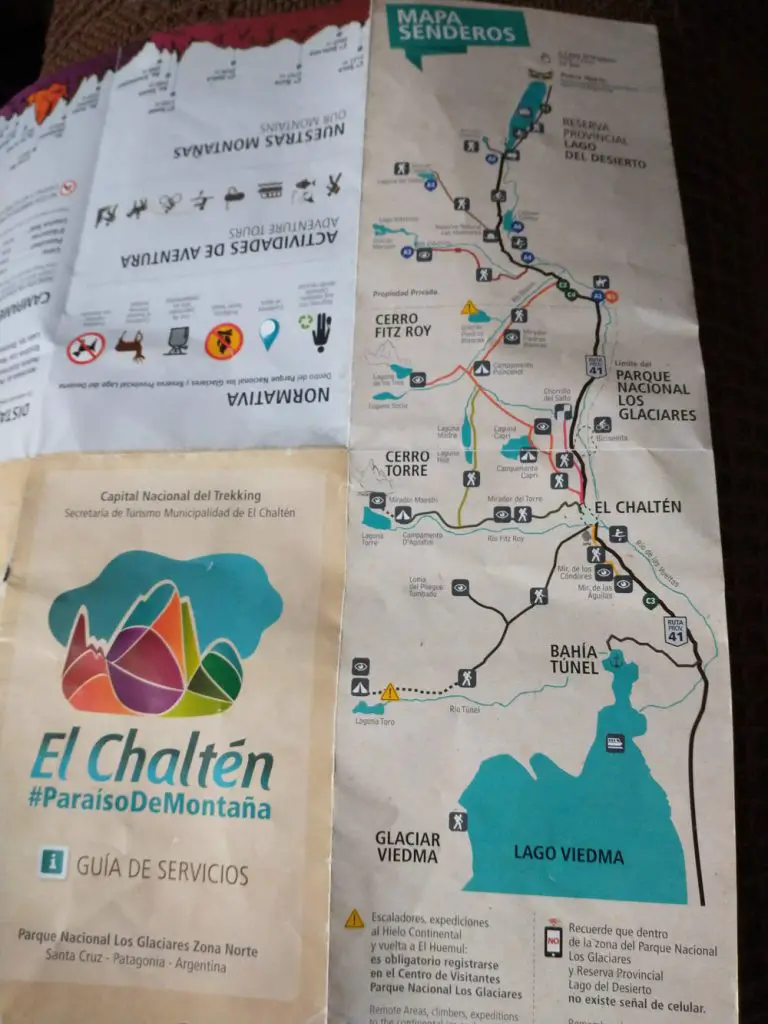
The town itself is small and very easy to get around on foot. There are plenty of accommodation options as well as a variety of restaurants and cafés to suit all budgets and, just up the road from the bus station, a craft beer emporium that offers a range of interesting beer – perfect for a post-hike tipple. There are also some outdoor equipment shops just in case you spontaneously decide to go climbing and have forgotten to bring your gear.
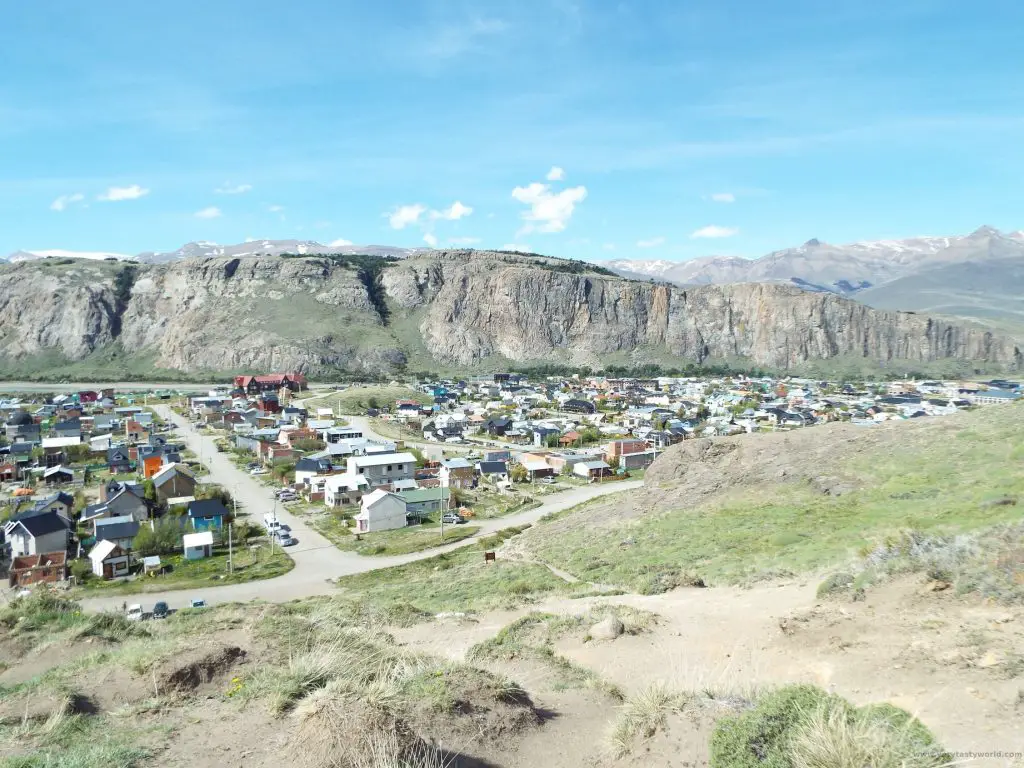
We stayed at the charming Hosteria Lago Viedma which is run by two lovely ladies. The home-cooked breakfast was the best we had in Argentina: freshly baked bread, eggs cooked to order and lovely home-made biscuits/cakes. They had loads of hiking advice and also kindly rearranged our bus tickets for us when it was clear that the weather wasn’t going to be on our side on the final day and we had a long wait before our bus was due to leave.
Hiking in El Chaltén – A Couple of Hikes
Hiking in El Chaltén ranges from short and easy walks to some that are more challenging, and the map gives an indication of distance and difficulty. Not only do the B&Bs offer good hiking advice, they can often offer a packed lunch if you are planning to go out hiking all day. Empanadas (like pasties) are perfect – easy to carry, they will happily hold their shape inside your backpack and they taste delicious.
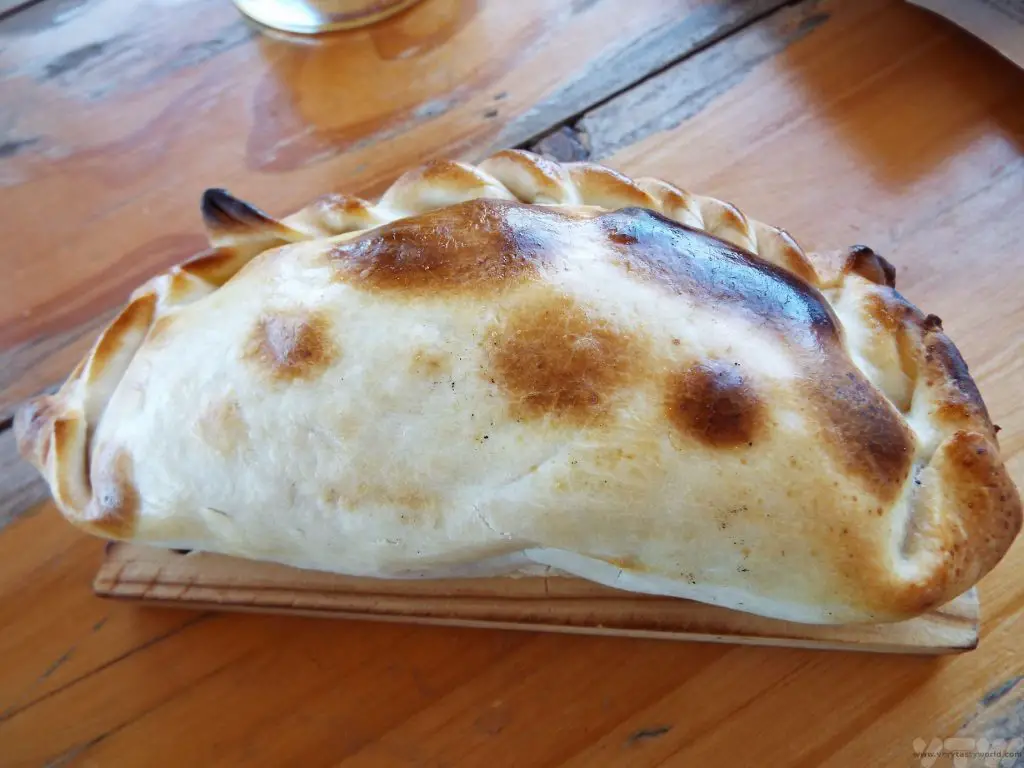
Beware the weather. It can be very changeable, indeed part of some hikes may be closed on particularly windy days. We recommend wearing layers of clothes as the wind can be really chilly but you warm up quickly if you’re on an energetic hike, so may want to discard layers as you go.
The information booklet at the visitor’s centre gives lots of information about all the hikes, including distance, time to reach the end and difficulty level.
You need to be a really experienced climber to climb the iconic Mount Fitz Roy but don’t panic – there are loads of amazing hikes, with varying levels of difficulty, even for the casual walker. There are lakes, waterfalls, spectacular views of mountain peaks and lots of other hikers to chat with along the way. The walks have signposts for the hike itself as well as viewing points and the trails are well maintained.
Laguna Torre hike is an easy-moderate hike where you can get fantastic views of the area, including a view of Mount Fitz Roy.
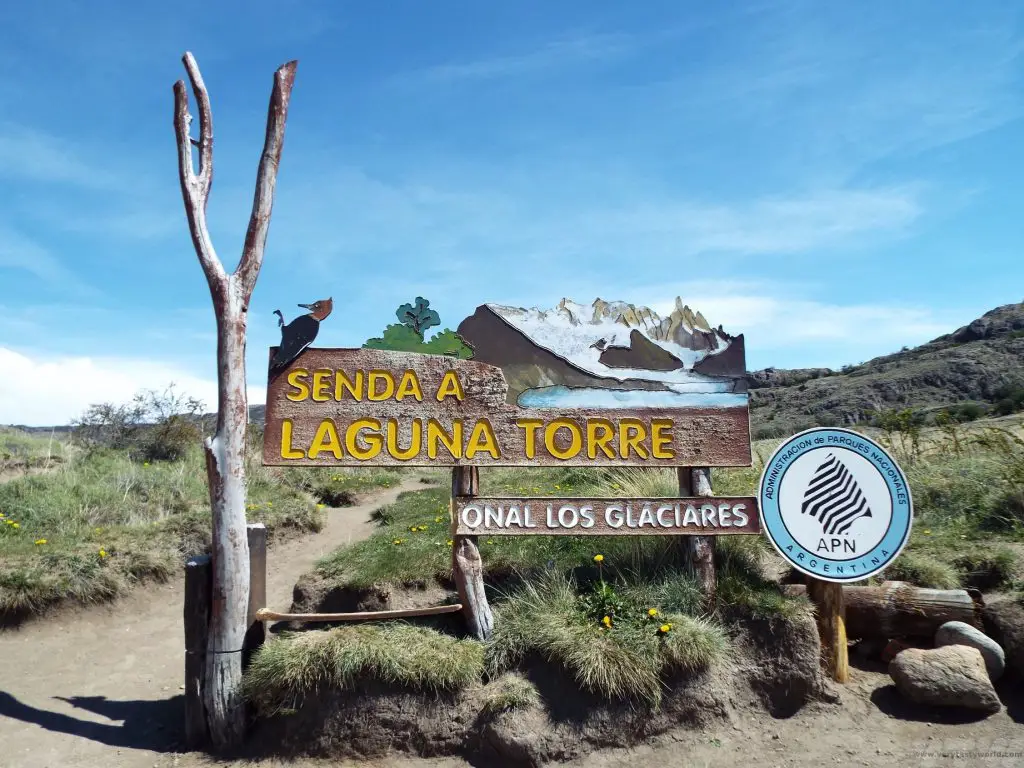

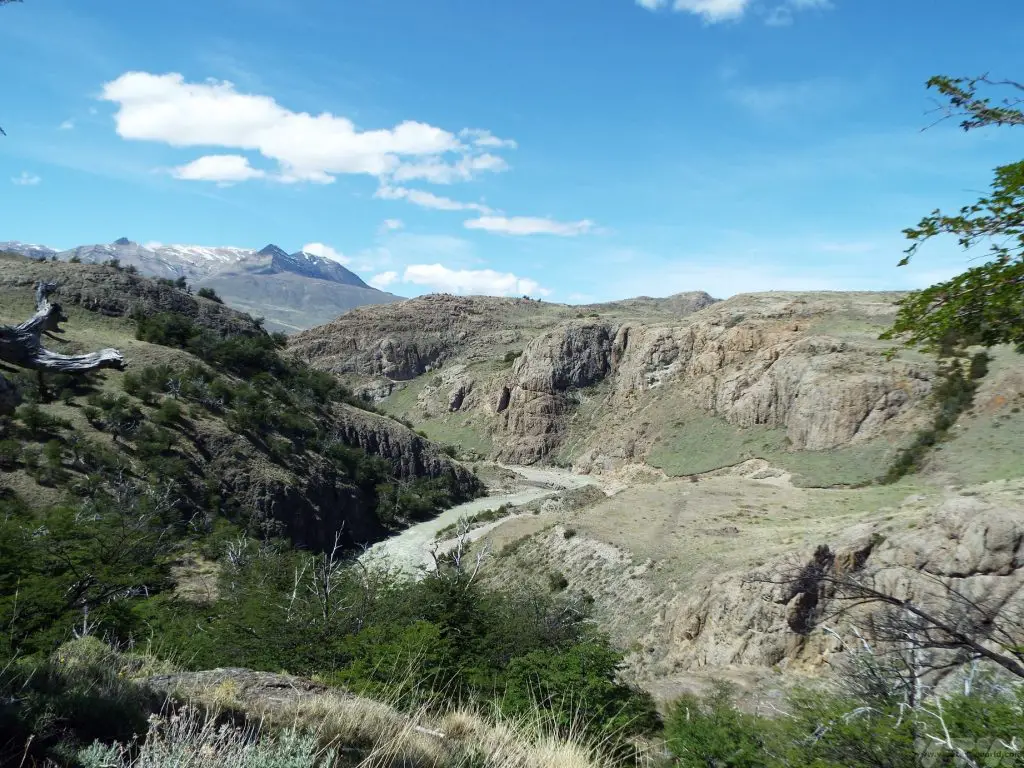
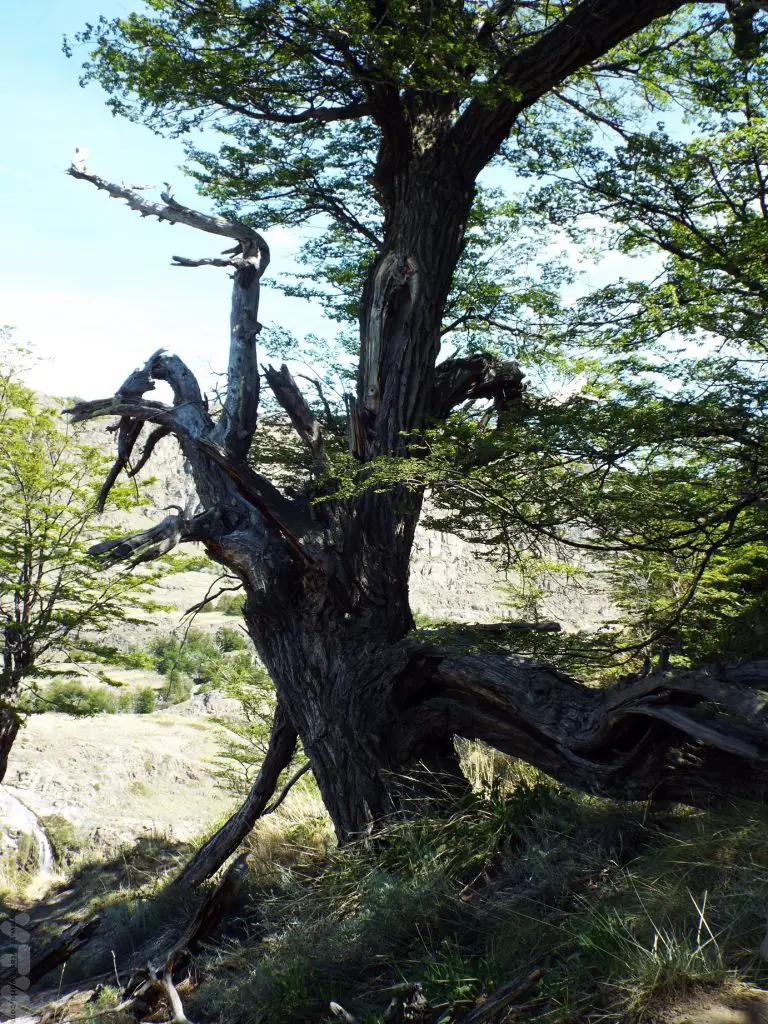
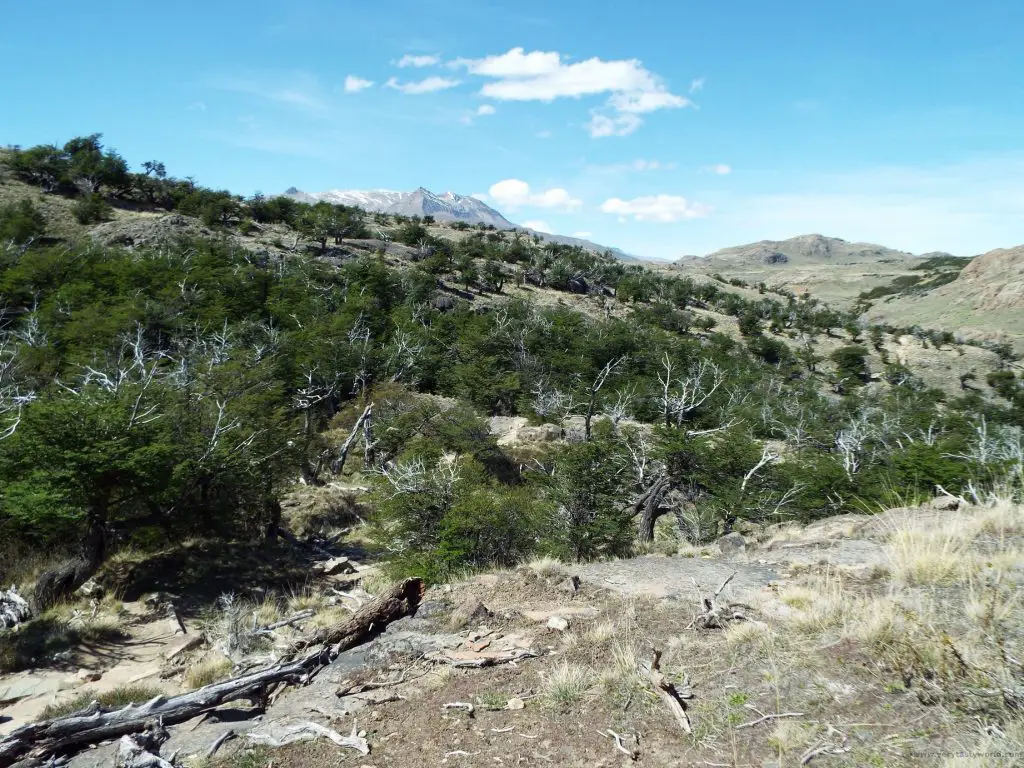
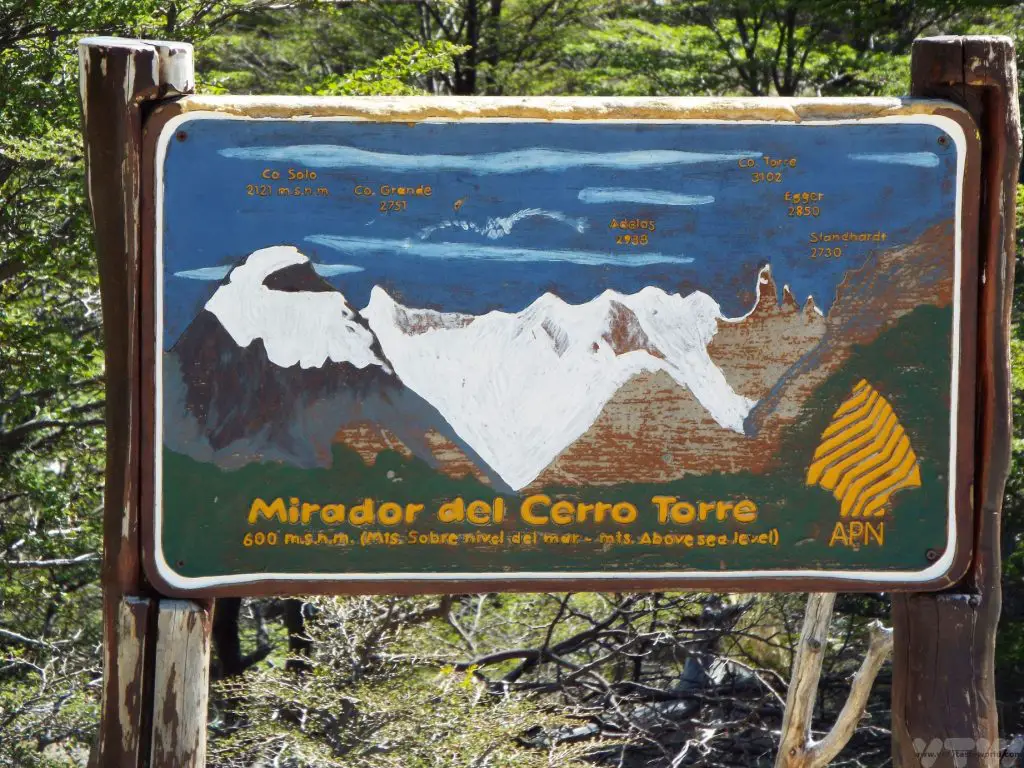
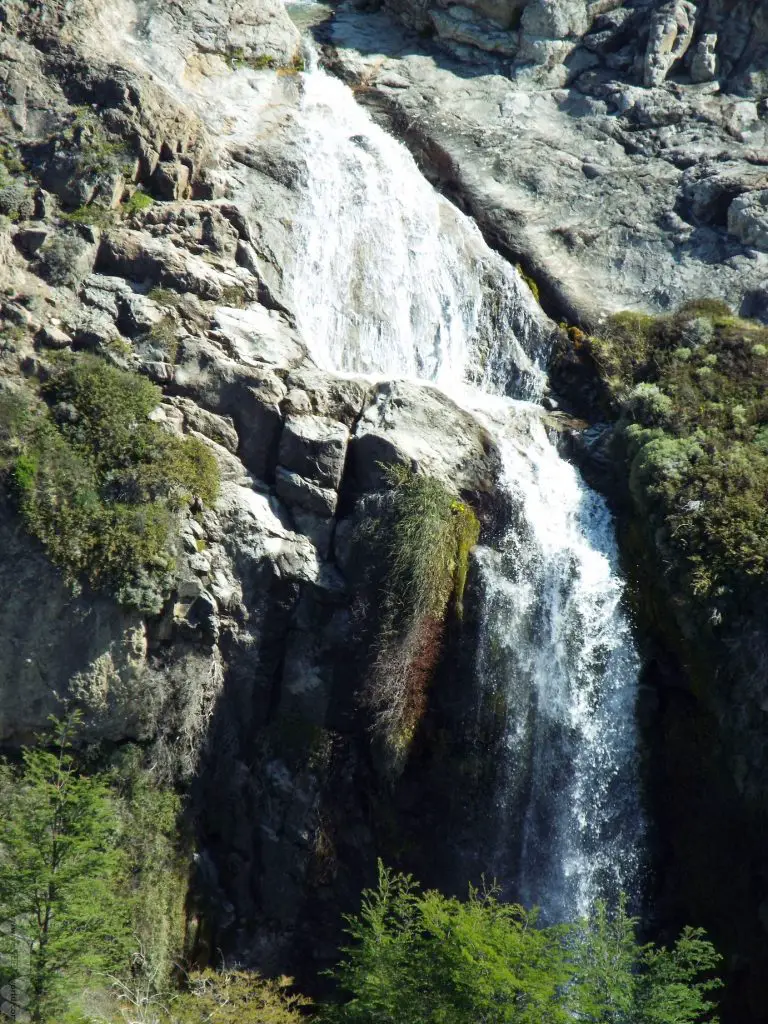
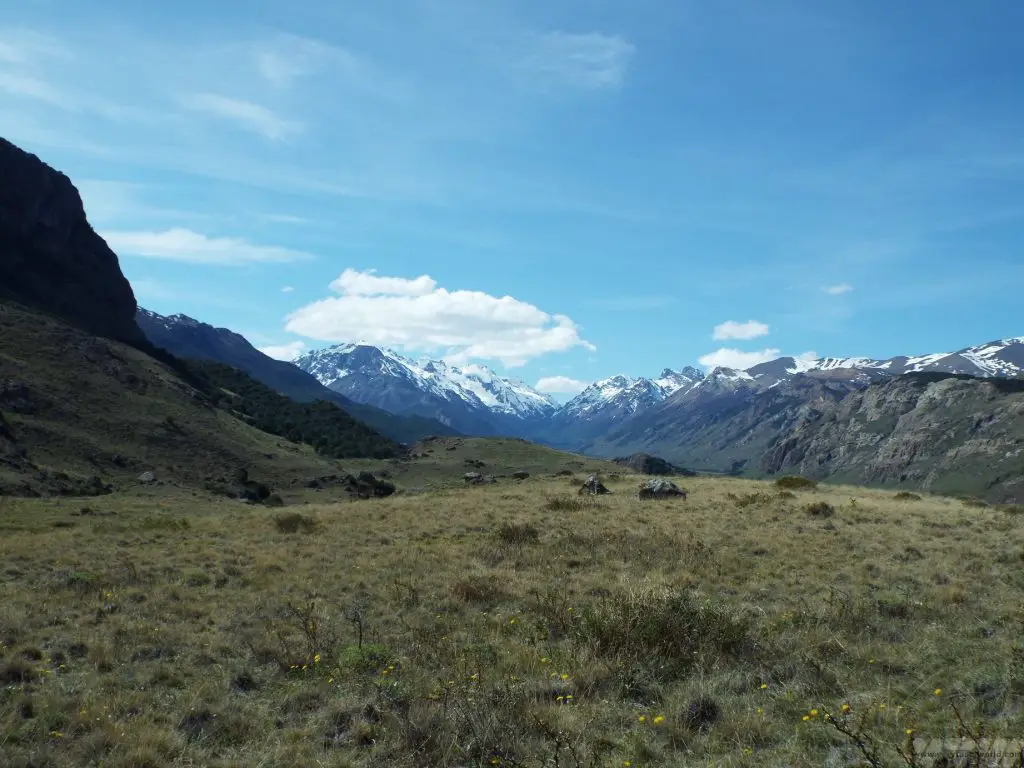
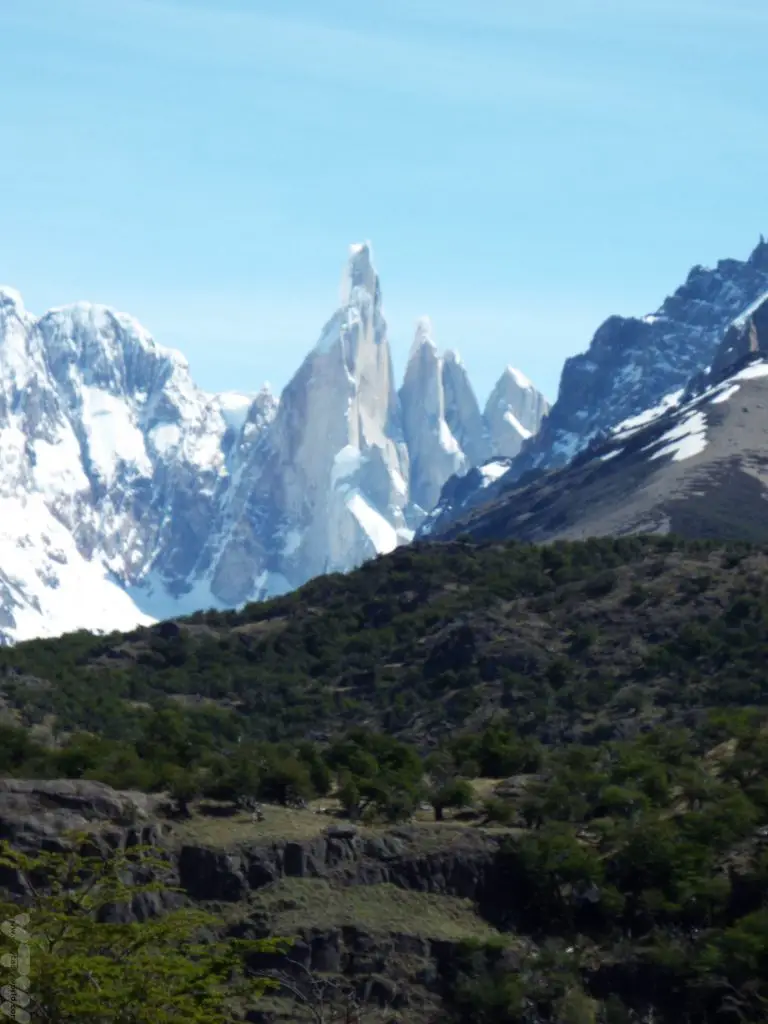

Sendero del Fitz Roy hike is a little more challenging. The starting point is at the north of the town; just walk along the main road until you see the sign.
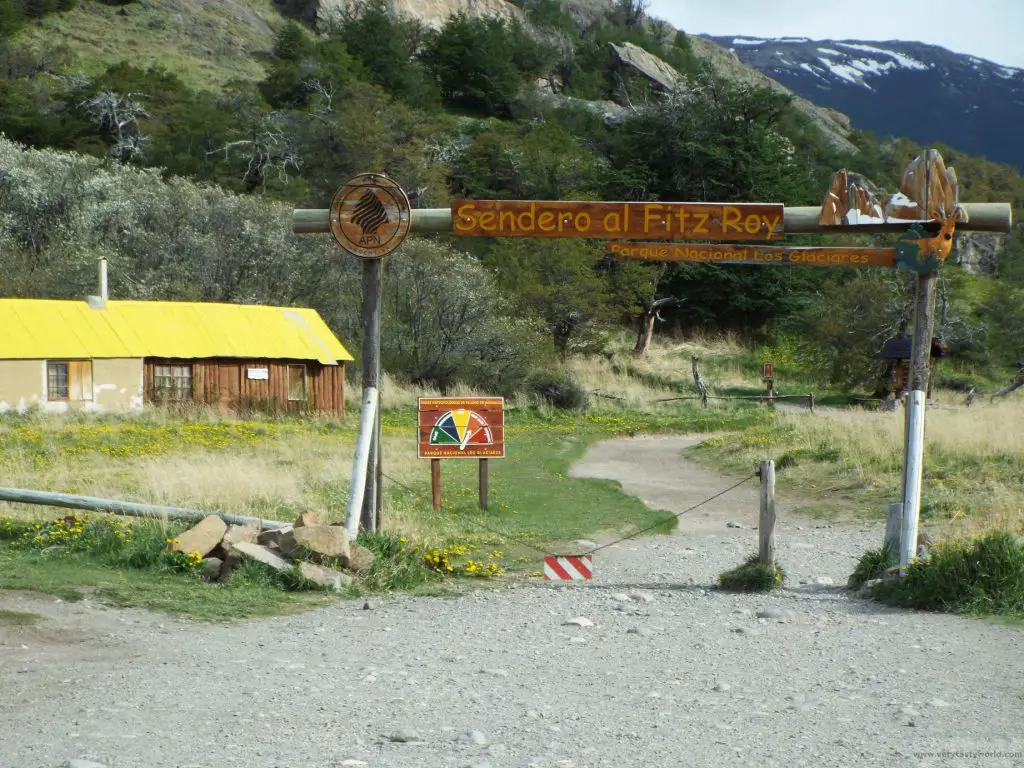
The first part of the hike climbs uphill then is relatively flat for several kilometres. It has lovely views of the mountains, lakes and glaciers all the way along. The very last section has a steep ascent and is not advisable if the weather, particularly the wind, is unfavourable. It’s around 10km each way and there are some alternative routes for the trip back so that you can see additional landscapes.
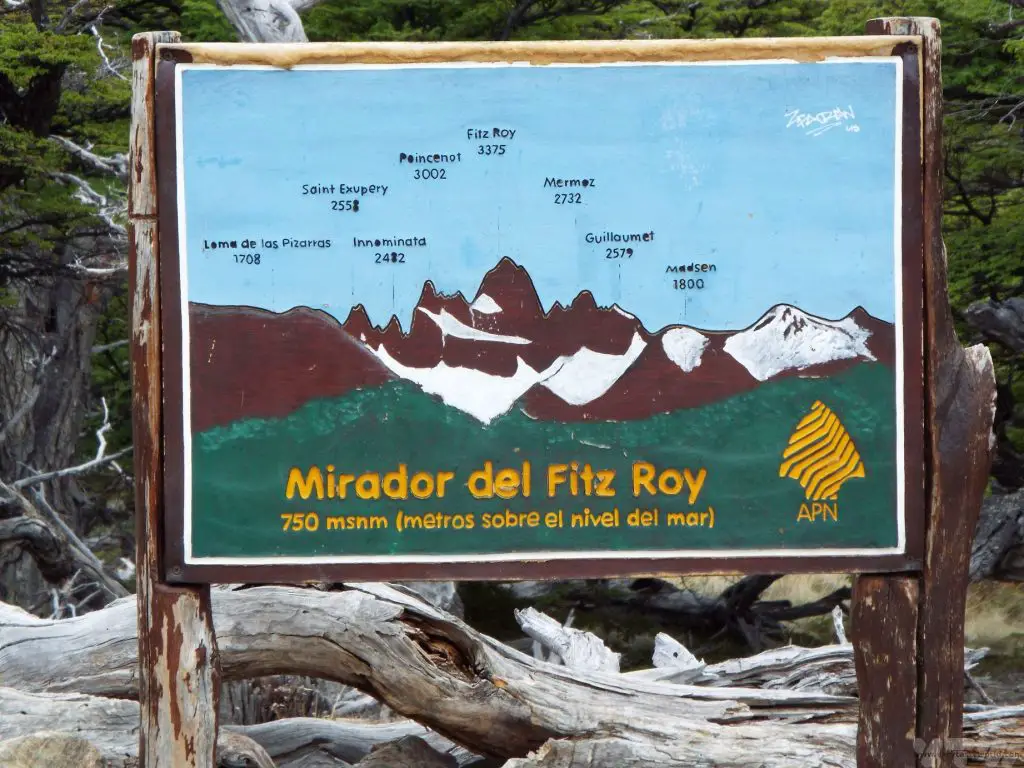
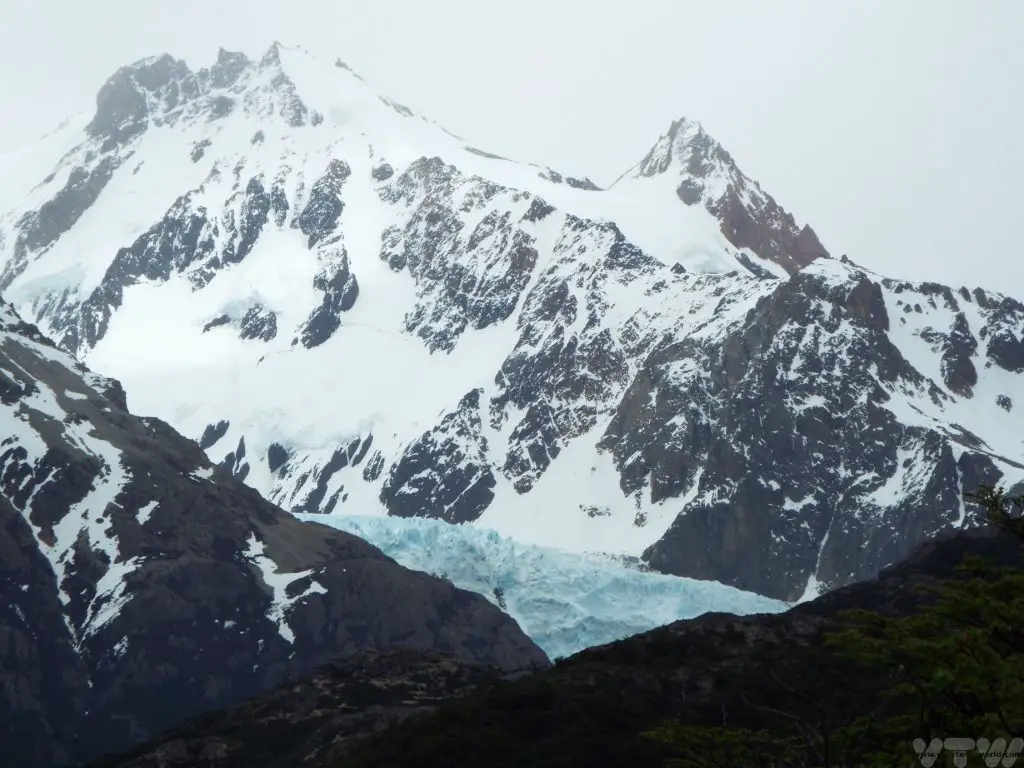
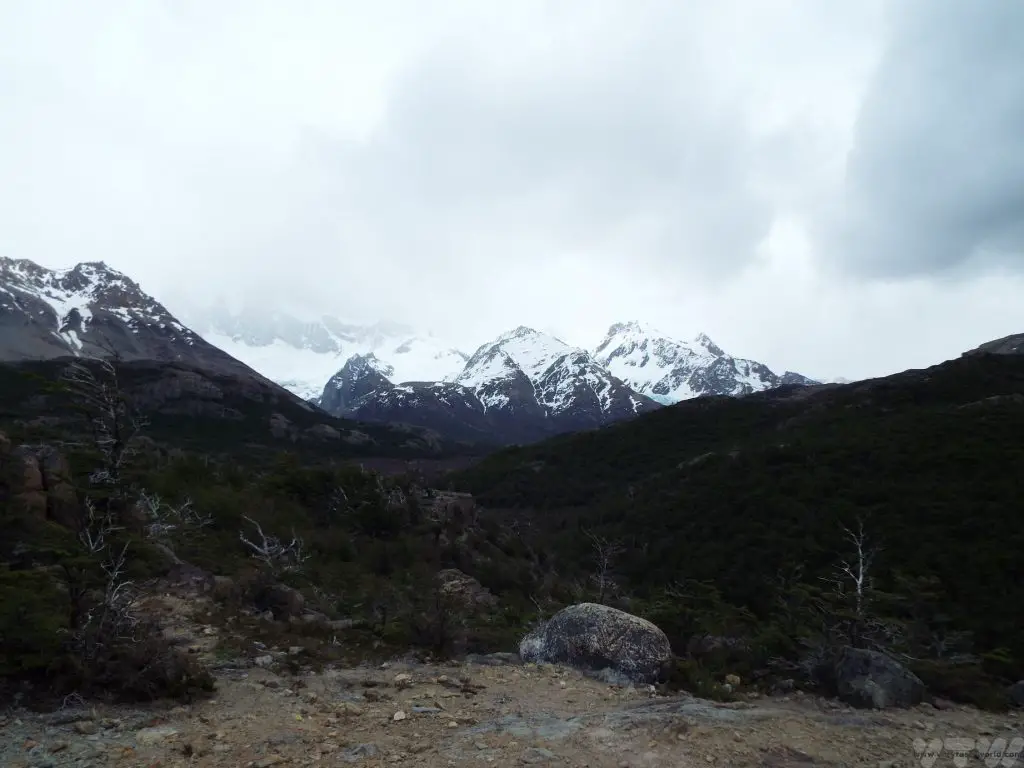

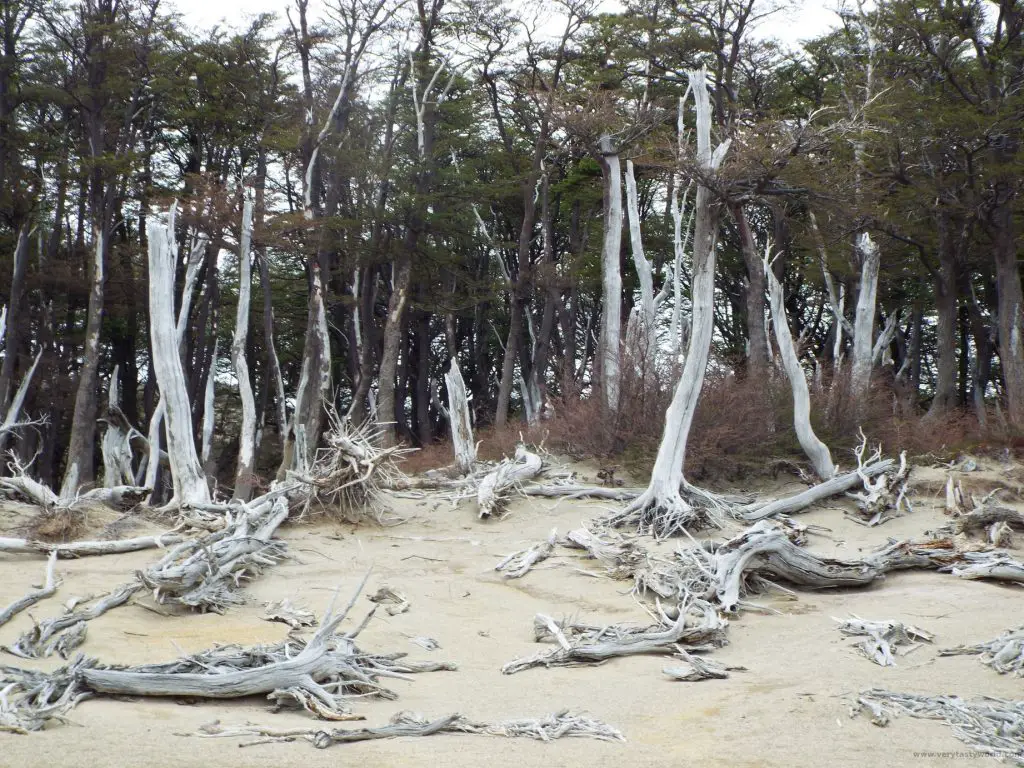
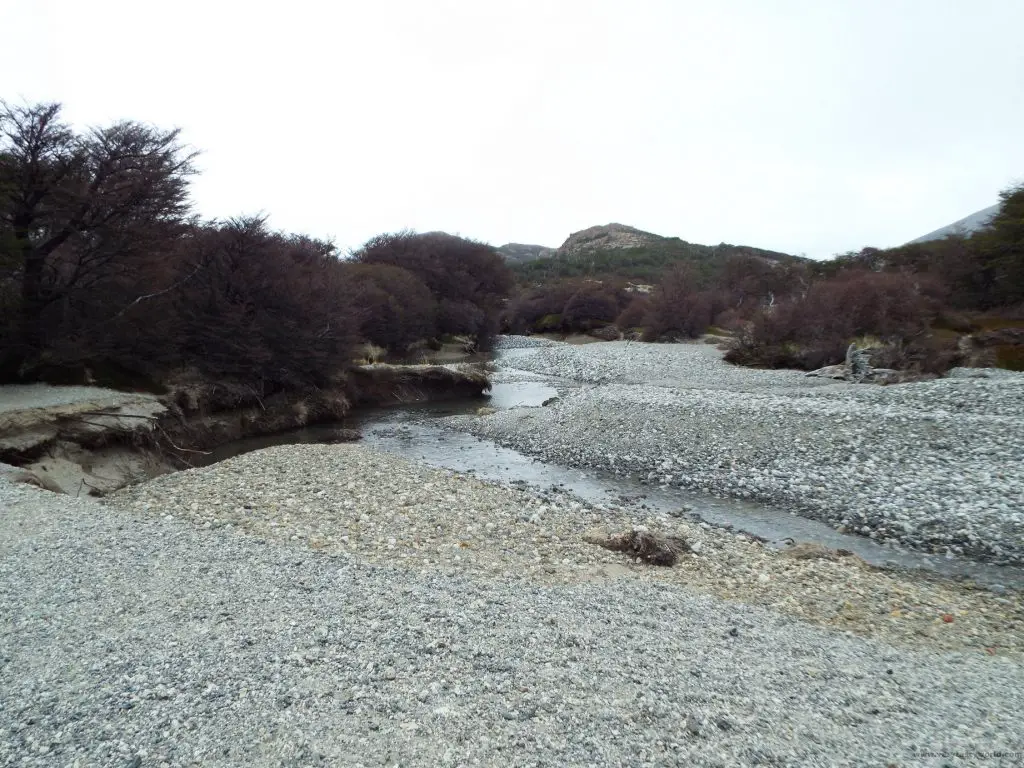
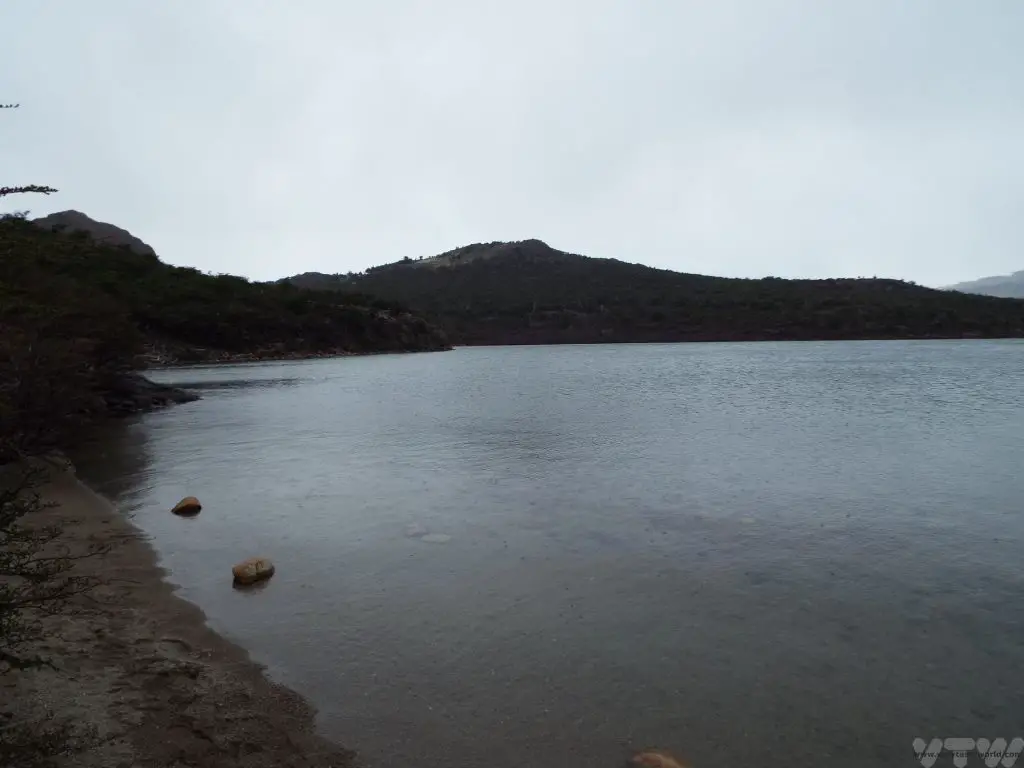
One of the loveliest things about walking in the area is that the water is absolutely pure. If you feel thirsty you can simply fill your water bottle directly from any of the streams and rivers that flow in abundance through the landscape. Cold, fresh, delicious water straight from the glacier/ground is a real treat.

There is also plenty of wildlife to see – condors circling the sky or a common snipe.
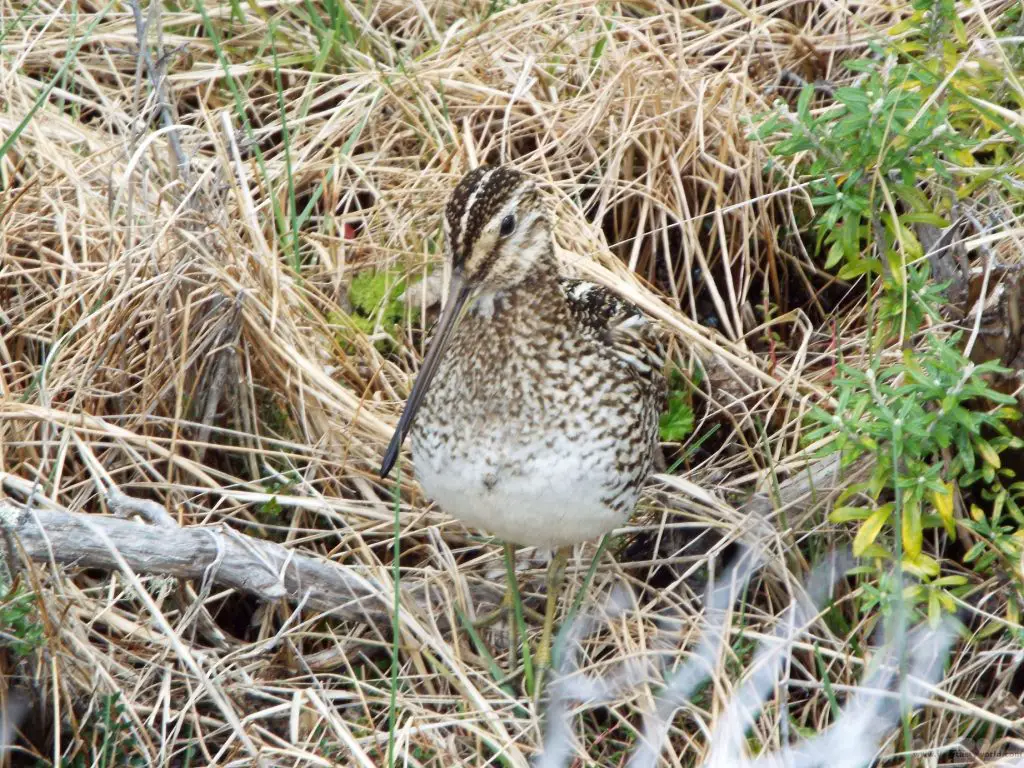
After a 20km hike, food and beer is always welcome.
Eating and Drinking in El Chalten
There isn’t a huge amount to do in town after hiking in El Chaltén but there are a number of bars and restaurants offering decent food and there are a couple of places to have a pint – or three – of craft beer.
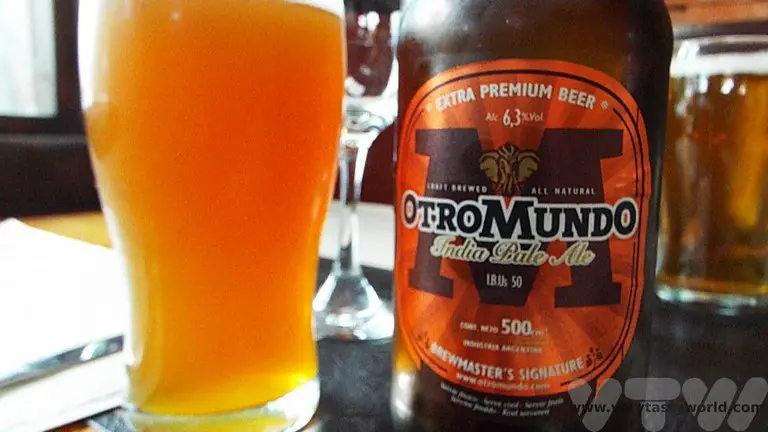
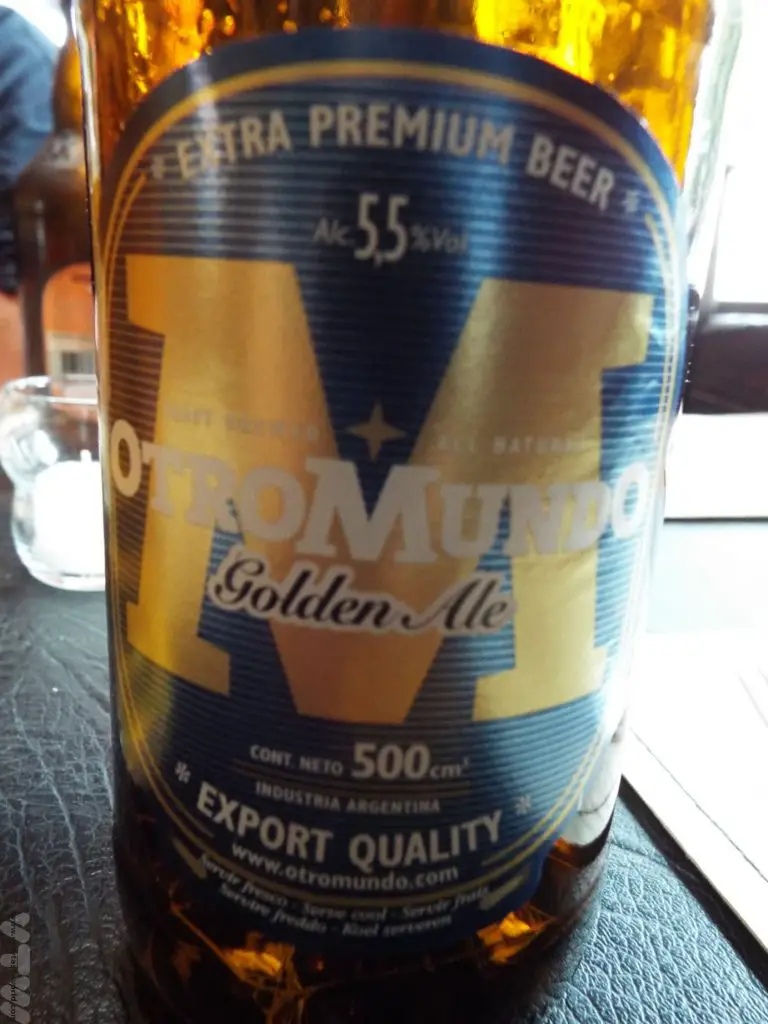
We enjoyed traditional Patagonian fare at El Muro, located on Avenida San Martin. It’s quite difficult to be vegetarian in Argentina as meat forms a large part of the diet. Indeed, we ate so much meat during our time there, we started craving salads. It’s also worth noting that many restaurants provide bread with your meal free of charge and we found that the food was so filling we just didn’t need to order any additional carbs. Patagonia is rightly famous for its lamb. Slow cooked over an open fire, it just melts in the mouth.
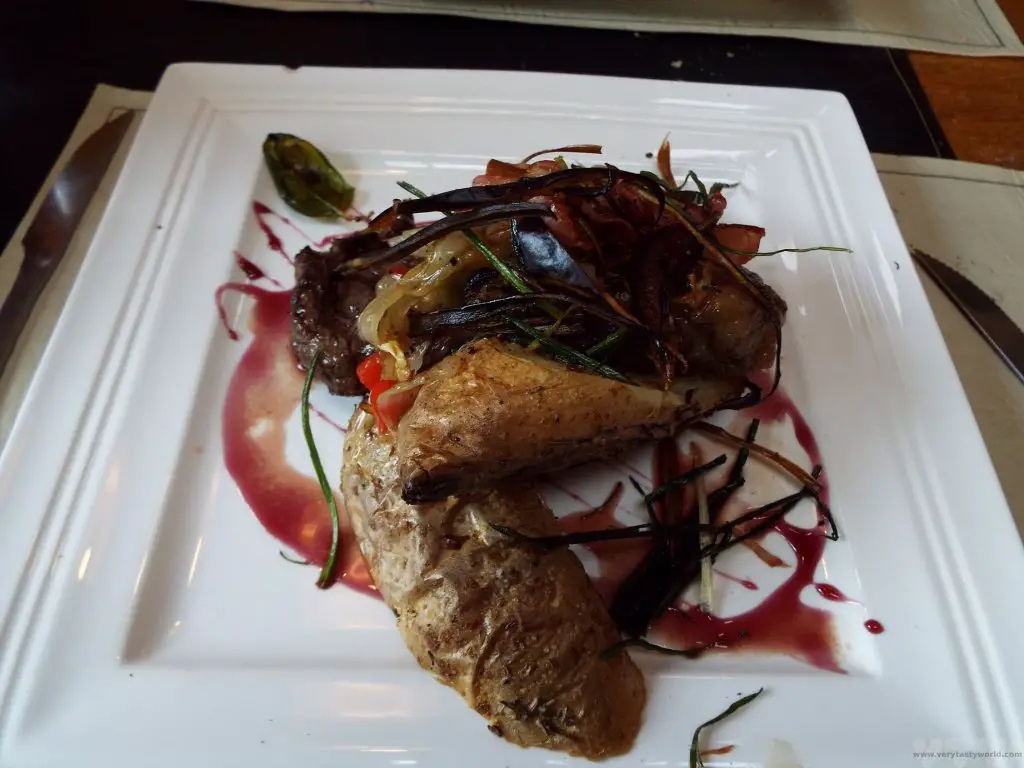
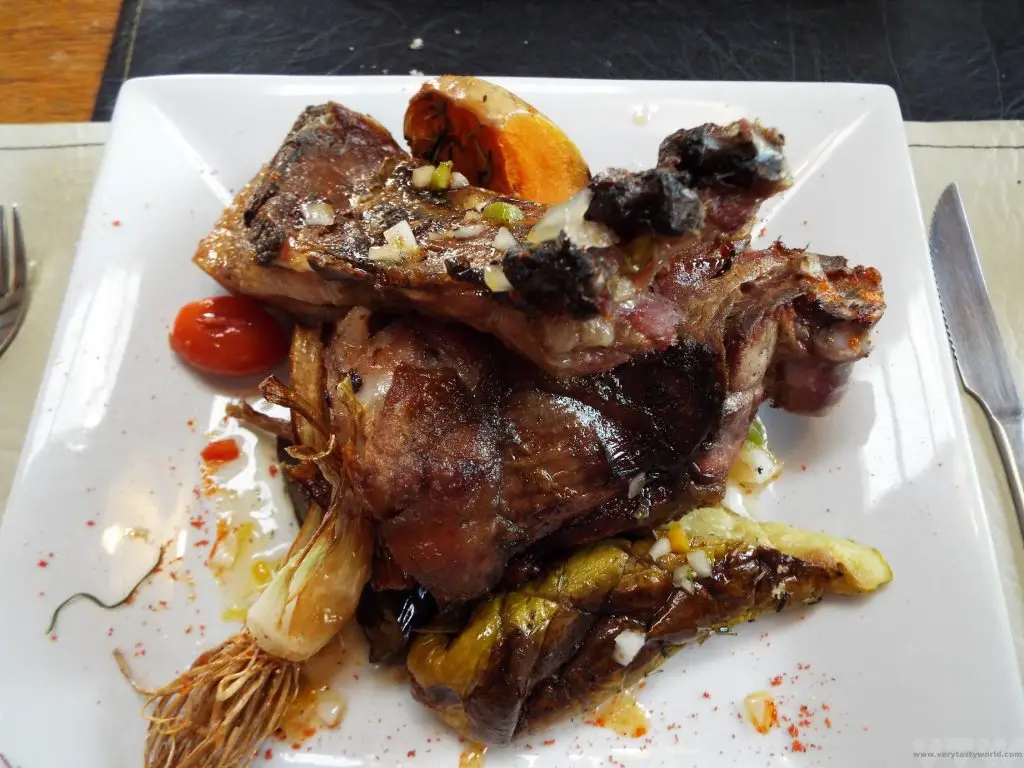
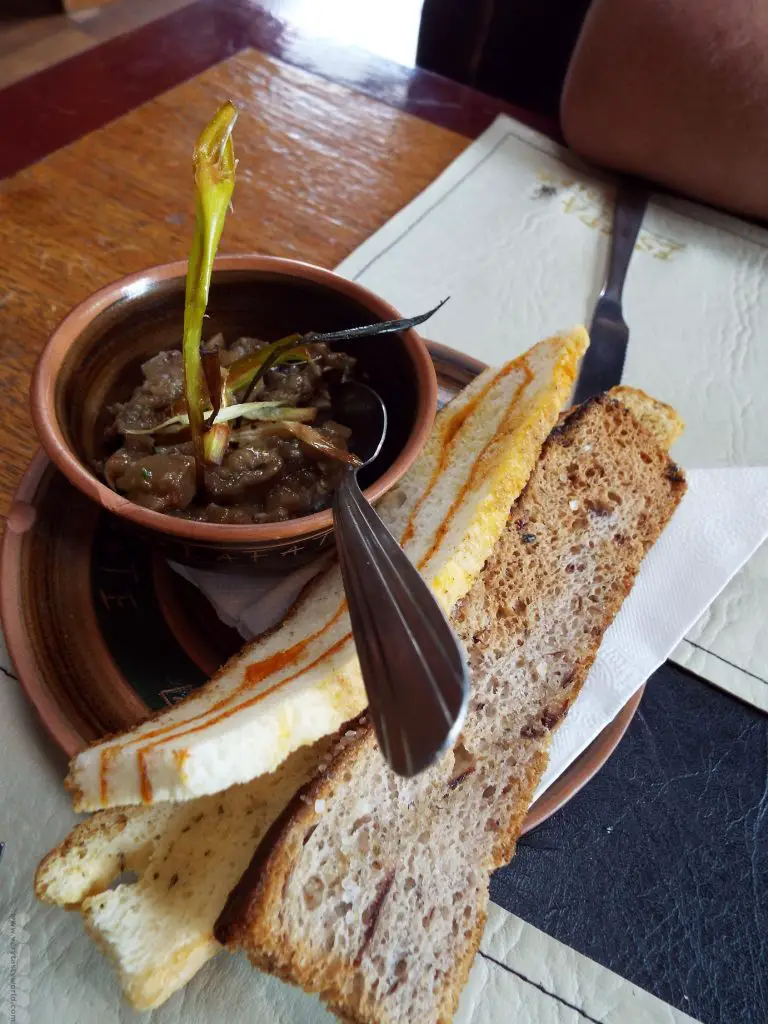
Essential Equipment for Hiking in El Chaltén
Where the serious climber will already have a special kit, there are a few items that, as enthusiastic casual walkers, we find to be indispensable. Walking shoes/hiking boots are an essential when walking in the area. We tend to wear our walking shoes on the flight so that we don’t have to pack them into our luggage, taking up valuable space.
The weather can be extremely changeable in El Chaltén. Make sure to carry waterproofs when walking. Ponchos are really useful because you can chuck them on quickly and they provide good coverage. They can also easily fit over your backpack, which helps prevent that getting wet, and will squish to a small size to minimise packing. You can also use them as a grond sheet or to shelter from the sun, so they are really versatile.
We always try to avoid single-use plastics in order to be as environmentally-friendly as we can, but this can sometimes be difficult when travelling, especially if the water quality in the area you are visiting isn’t suitable to drink and we need to buy bottled water. Fortunately the tap water in Patagonia is totally safe to drink, so we took collapsible water bottles and filled them at our hosteria each day before setting out. Then we topped up the water from any of the streams that we walked by.
We also recommend those all-important layers for hiking. You can easily add or discard layers depending on how energetic you are feeling and how windy the weather is.
If you are traveling in the area and enjoy walking it is definitely worth considering spending a couple of days hiking in El Chaltén, Patagonia – the landscapes are wonderful and there are walks suitable for all abilities.
Related Posts You May Enjoy

- Best Time To Visit Machu Picchu 2024 Update
- A 2 Week Patagonia Itinerary
- Day of the Dead in Campeche
- A Galapagos Land Based Itinerary
- RECIPE: How to Make Costa Rica’s Gallo Pinto
- A Tasty Puebla Food Tour
- Costa Rica Wildlife Sanctuary – Caño Negro
- Visit Torres del Paine National Park in Patagonia
- Atacama Desert Itinerary
Visiting the Studio Ghibli Museum
A Place of Awe and Wonder
The animations of Studio Ghibli, by founders Hayao Miyazaki and Isao Takahata and their protegees, are amongst the very best in the world. If you haven’t seen a Ghibli film we can’t emphasise enough quite how magical they are. For fans of anime (Japanese animation) and films in general, the Studio Ghibli Museum is top of the list of places to see when visiting Tokyo.
A teenage witch, her hair ruffled by the wind, rides her mother’s broom through the open skies. A giant robot unleashes molten destruction on the soldiers who have awakened him from centuries of slumber. A city worker recalls her childhood growing up in the 1960s. The skies above Kōbe are filled with buzzing agents of death, raining down fire upon a terrified population. A burgeoning writer seeks inspiration from a quaint antiques shop. A travelling warrior becomes infatuated with a feral wolf-child in a land scarred by war. A group of young people discover love and loss during their turbulent high-school years. A girl’s parents are turned into slobbering pigs. A father turns superhero, if only for a moment, when he stands up to a local biker gang. Two elated girls soar through the air inside a grinning cat bus, its headlight eyes tracing yellow streaks in the sky above the forest.
Gods and monsters. Love and loss. Jubilation and despair. The horrors of war. Childhood wonder. The passion of life. Welcome to the heart-soaring, euphoric, whimsical, terrifying, compassionate and, above all else, emotional world of Studio Ghibli. The remarkable films of Studio Ghibli show, without a shadow of a doubt, that cinema can be art. Often the terms ‘art’ and ‘cinema’ result in products that distance audiences, but Ghibli makes films that touch the soul, that can enrapture and delight everyone from toddlers to pensioners. Studio Ghibli Kamera Book.
It’s not possible to visit the studio itself. That’s just basically an office building. But Miyazaki and Takahata commissioned a museum dedicated to the art and technology of the animated form in 2001 and it is one of the most delightful museums we’ve ever visited.
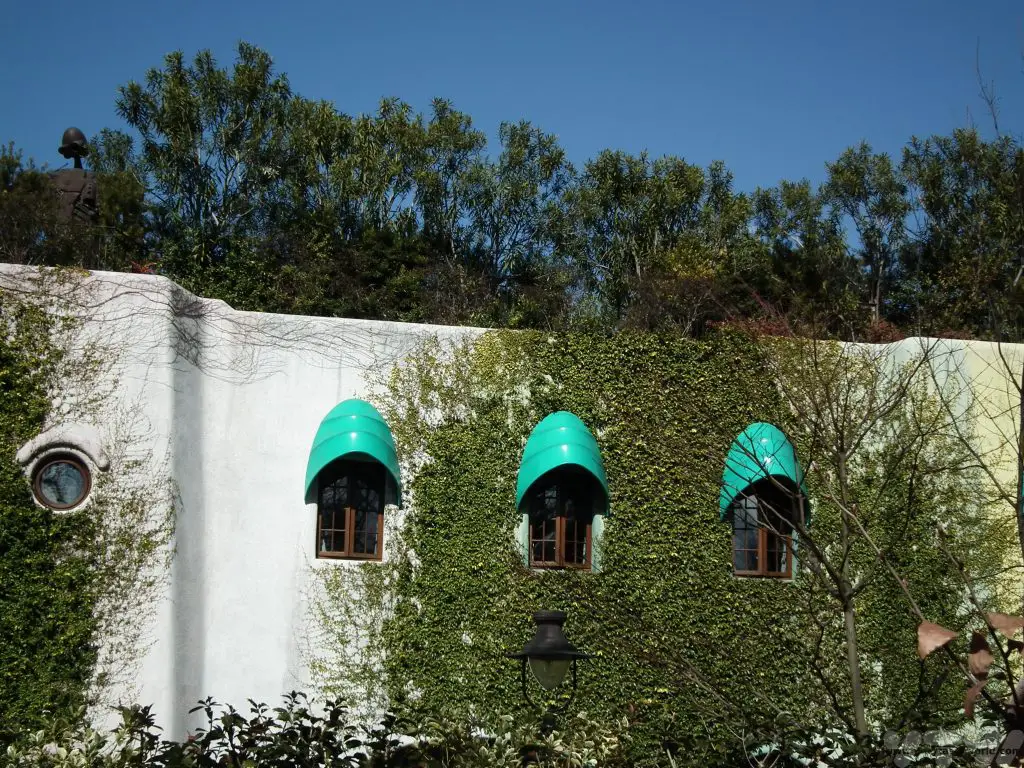
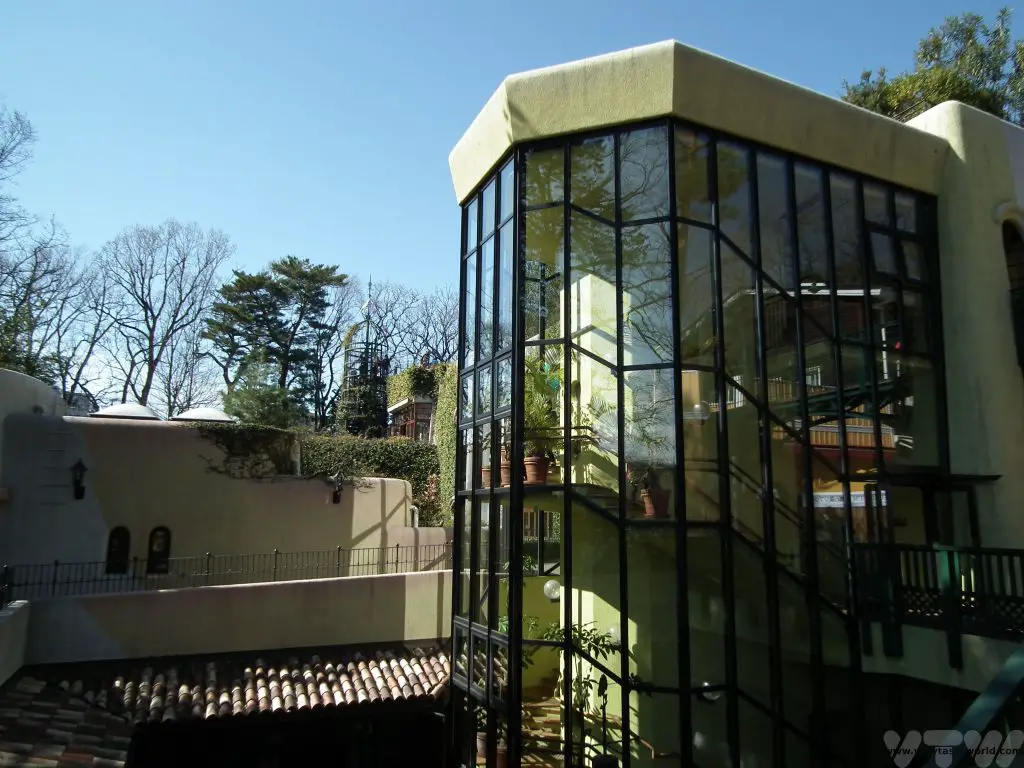
Visiting the Studio Ghibli Museum – Getting Tickets
If you’re planning on visiting the Studio Ghibli museum you can’t just turn up. The museum is so popular that you have to pre-book your tickets and also arrive at a specified time. The process for getting tickets is a bit convoluted especially if you don’t live in Japan or have contacts there. So (deep breath)…
If you are Japan you can buy tickets at Lawson konbini (convenience stores) which can be found all over the country.. The tickets go on sale from 10:00am (Japan time) on the 10th of each month for the following month. So really you have to be in Japan for several weeks to stand a chance of getting any for yourself and they will sell quickly. The museum has a page which links to an online booking system.
If you can’t get tickets via the link there are other options. A number of travel agencies can get tourist tickets which you can purchase directly from them in your home country.
Other travel agencies often have staff in Japan who may be able to go to Lawson to get tickets on your behalf. But book early! We’ve used services such as these in the past and it has worked very well. However, over the years, demand has increased and many travel agencies may also want you to buy other services, for example, they may request that you purchase your Japan Rail Pass from them, or book a couple of nights’ accommodation in Tokyo. This is frustrating, especially if you have already made your plans or can purchase these items more cheaply elsewhere. For example, we always search for the best deal for our JR Passes and usually stay in Japanese Business Hotels which are cheap and comfortable (if small), especially in Tokyo because, frankly, when you’re in Tokyo you don’t really care too much about your accommodation as there’s so much fun to be had in the city.
The tickets state a specified date and time of entry and, as a result, you will need to arrive on time. The face value of the tickets is an extremely reasonable ¥1000 for those over 19 years of age, with lower costs for children. But there is likely to be a handling fee if you purchase your ticket from an agent.
On Arrival At The Ghibli Museum
The museum is located in Mitaka, on the Chūō Line. There are direct trains from central Tokyo and you can use your Japan Rail Pass if you have one. It’s a short walk from the JR station. There is, however, a bus service which, for around ¥300 return, will take you directly to the museum. It’s easy to spot the bus stop.
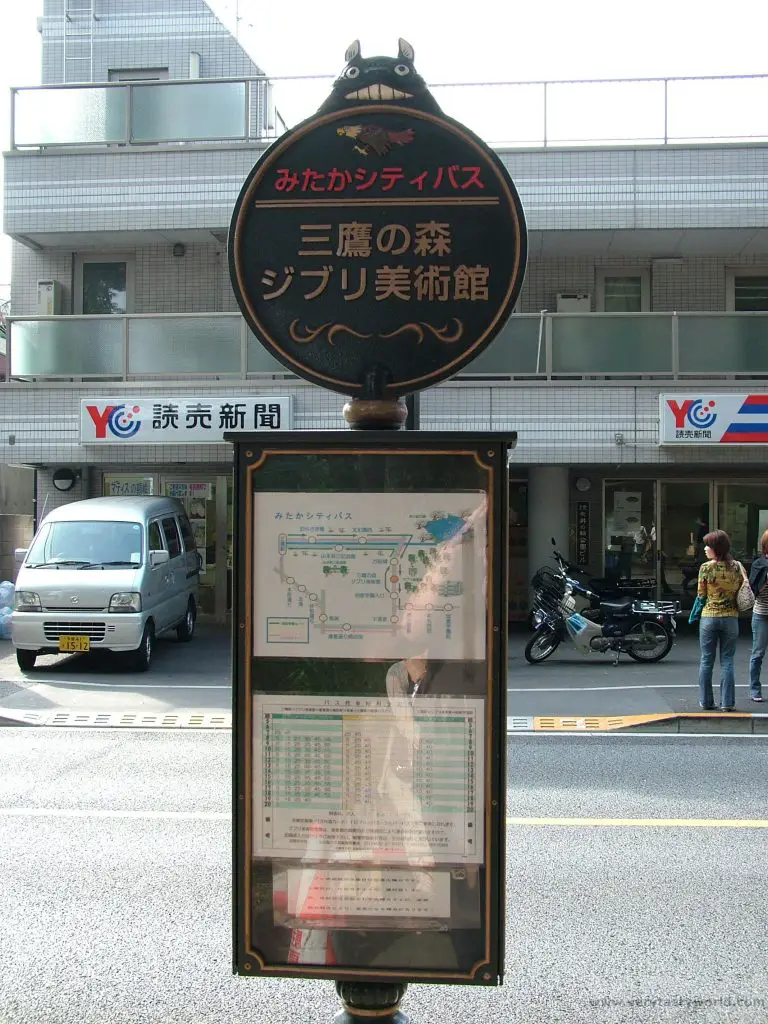

On arrival, walking along Kichijoji Avenue, which is adjacent to Inokashira Park, at the entrance of the delightfully colourful building you are greeted by a giant Totoro, which is the best possible welcome anyone could want, before you walk around the building to the real entrance.
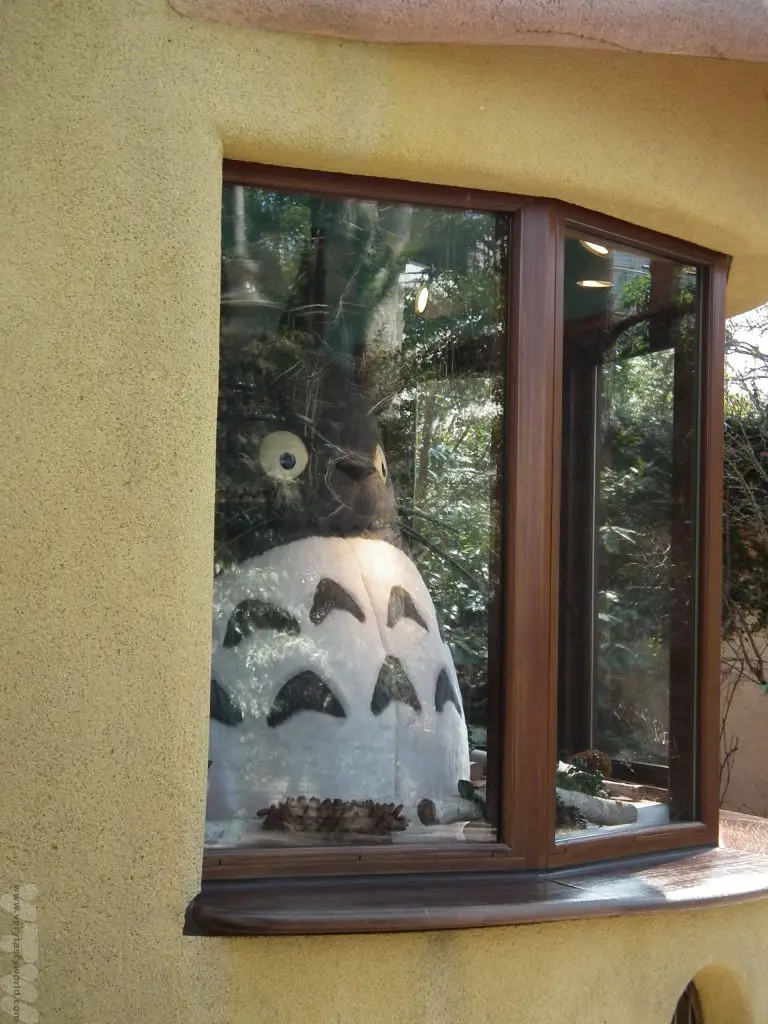
On arrival you exchange your voucher for a real ticket which has a film strip from a Ghibli animation inside. There is no time limit on your visit and the policy of limiting admissions means that the museum never feels crowded. You can wander freely through the building but you are requested not to take photos. This is actually a really good idea – it ensures that you enjoy the experience rather than try to record everything that you see. It also means that there are no (or at least minimal) spoilers from zillions of photos of the museum on the internet. If you wish, you can buy a book or a set of postcards of the museum from the shop – so that you have a memento.
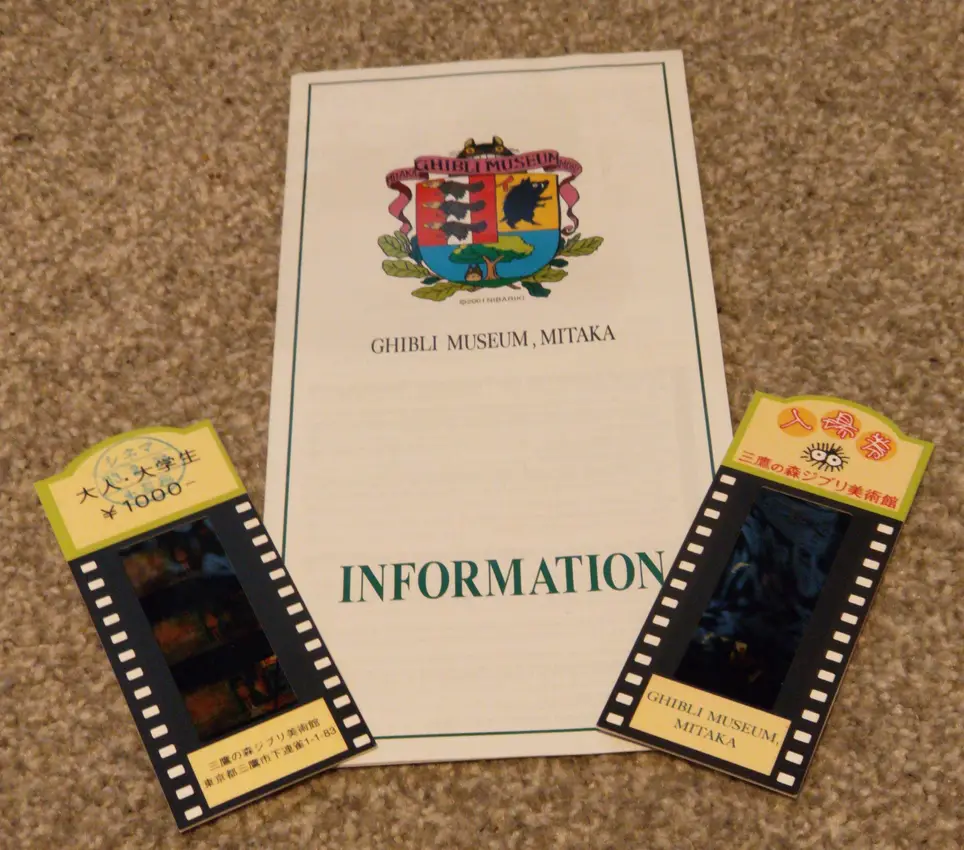
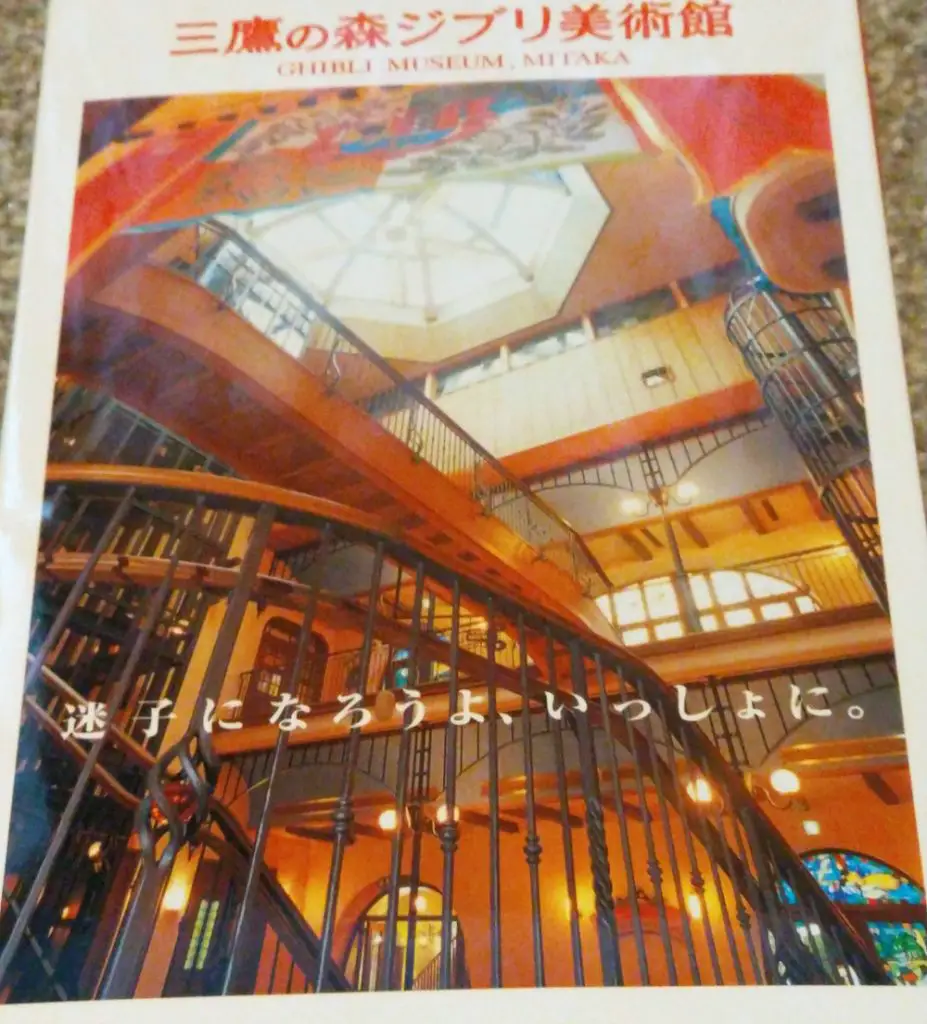
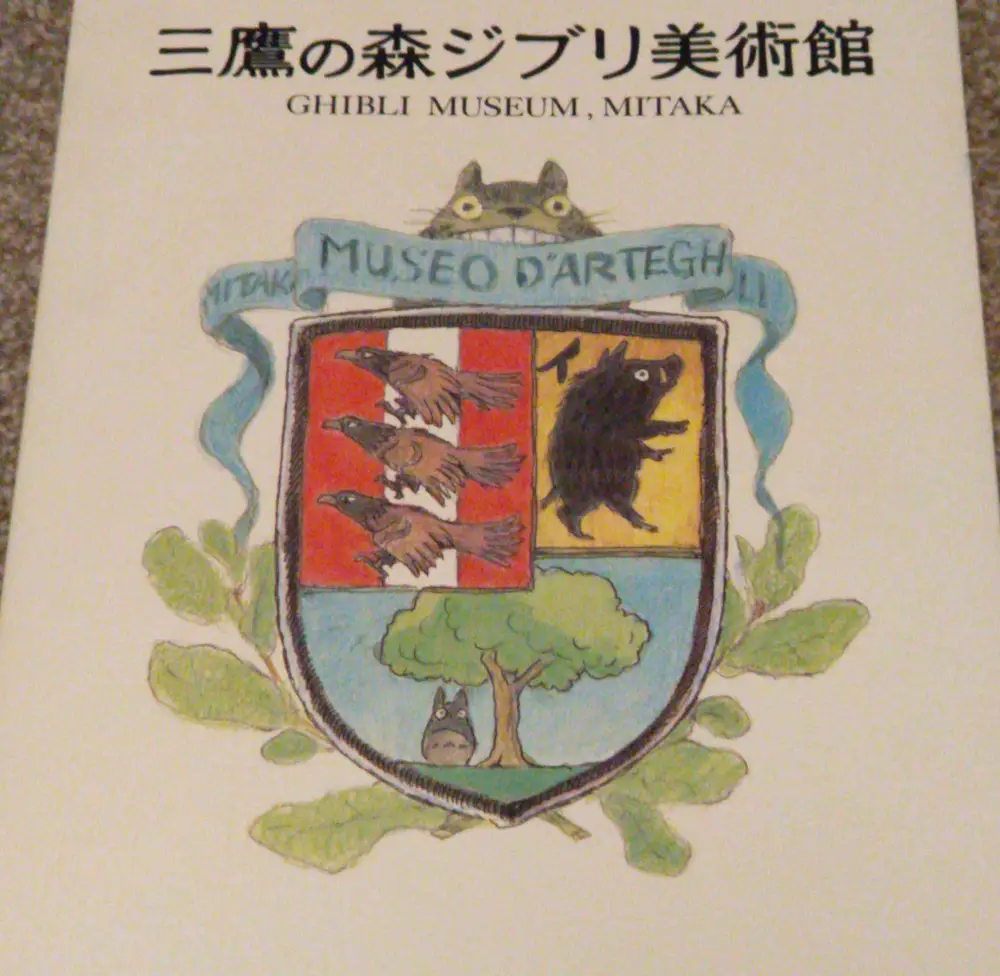
Miyazaki’s principle for designing the museum was ‘Let’s lose our way, together’. It’s a brilliant philosophy. There is no set route around the building and there are all sorts of spiral staircases, internal bridges and nooks and crannies to explore – some at a low level, suited to children… or adult sized children who are prepared to crouch and wiggle into small spaces. Just go wherever your curiosity takes you.
The first room after the entrance contains a Ghibli-inspired history of cinema technology. Periodically the lights are dimmed and a flashing Totoro zoetrope starts up – it’s a magical display as characters from the film rotate around a central point illustrating about how animation can create the illusion of movement. (Be aware that this is a stroboscope effect if you are sensitive to flashing lights.) Amongst the other exhibits in the room is a delightful display of the Laputa robot surrounded by doves. It truly is a room of wonders.
Upstairs there are further rooms to explore. Some of these have permanent exhibitions – such as the life-sized cat bus (from My Neighbour Totoro). Adults be aware that you are only allowed to play inside cat bus if you are under eight years of age, something that we feel is most unfair. There are a couple of rooms which represents an animation studio so that you can understand the technicalities and process of animation from start to finish.
The studio also has a number of temporary exhibitions which often showcase the work of animators from around the world. Isao Takahata, in particular, did a lot to promote the work of film-makers from around the world. We have enjoyed exhibitions showing the works of Pixar studios (themselves huge Ghibli fans) and Michel Ocelot’s remarkable animations.
Don’t forget to follow the steps to the roof – there you will find the gentle giant robot and mysterious control cube from Laputa, Castle in the Sky. (It’s okay to take photos outside the museum’s main building.)


Visiting the Studio Ghibli Museum – Exclusive Ghibli Films!
One of the biggest attractions about the museum is the opportunity to attend the screening of a short Ghibli film. You cannot see these anywhere else in the world and they are not available on DVD or on streaming services, they are totally exclusive to the museum. The films are around 20 minutes in length and there is a board outside the Saturn Theatre on the ground floor, indicating screening times. It’s worth getting to the waiting area a bit earlier than the start time to make sure you can get into the screening you wish to attend. (If you miss a screening there is plenty to keep you occupied until the next one.) We have been lucky to have visited the museum five times and have never seen the same film twice. You can buy picture books of the films as a memento.
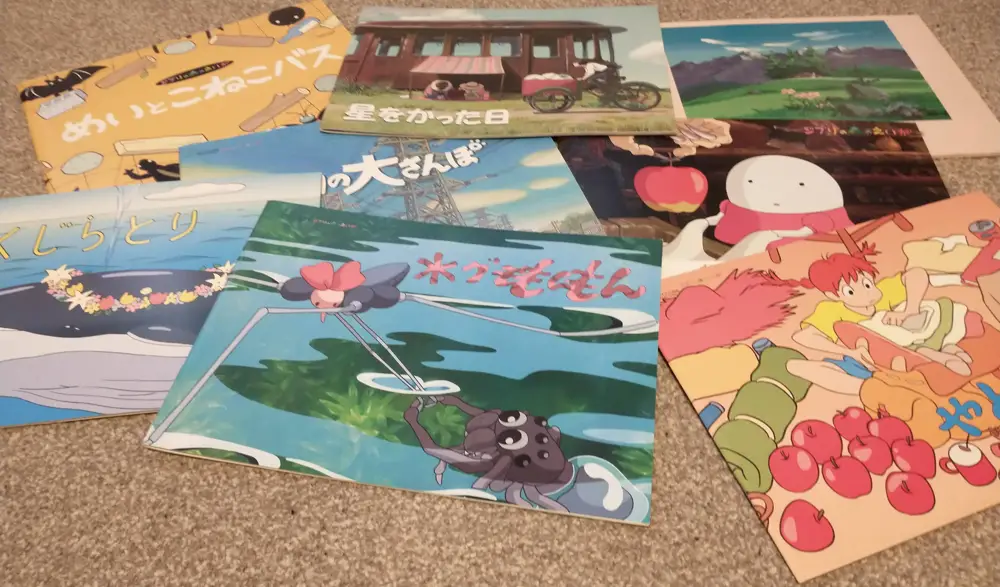
Shop Till You Drop
When you’re visiting the Studio Ghibli museum you’ll be delighted to discover that there is a bookshop where you can buy books and DVDs related to the films


And there’s also a souvenir shop where all sorts of gorgeous and tempting merchandise can be purchased. If you are a fan of the films, pack an extra suitcase for all the goodies. Over the years we have accumulated a lot of souvenirs.

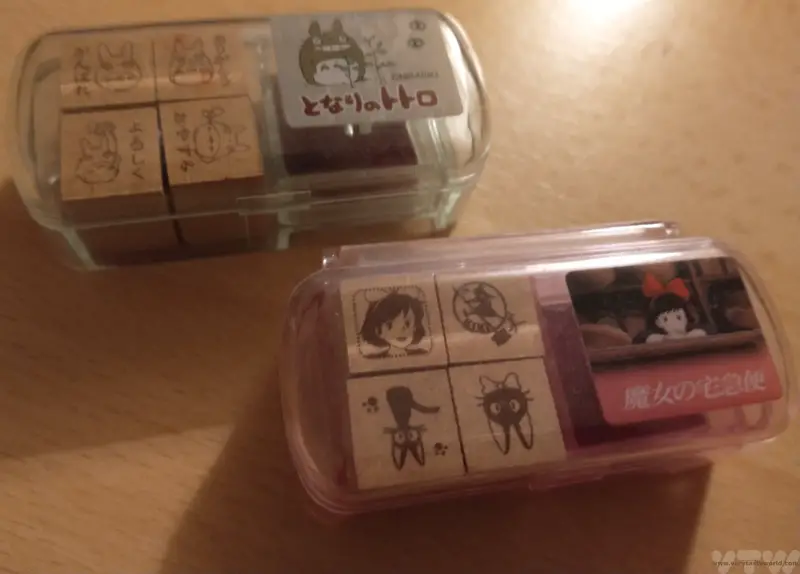


The bags are from the film Porco Rosso and are a souvenir in themselves.

It’s worth noting that Ghibli merchandise is also available throughout Japan. We managed to buy the biggest Totoro soft toy that we felt we could get onto a plane without having to buy an extra seat – bought at the very end of a long trip (which had involved lots of travelling on the shinkansen and it really wouldn’t have been practical to transport him all over Japan, gorgeous as he is) at a department store in Tokyo just before we headed out for the airport. And yes, we did get lots of funny looks from security guards at the airport, but Totoro has pride of place in our living room.

The design of the museum is so intricate and detailed, even outside the main building.
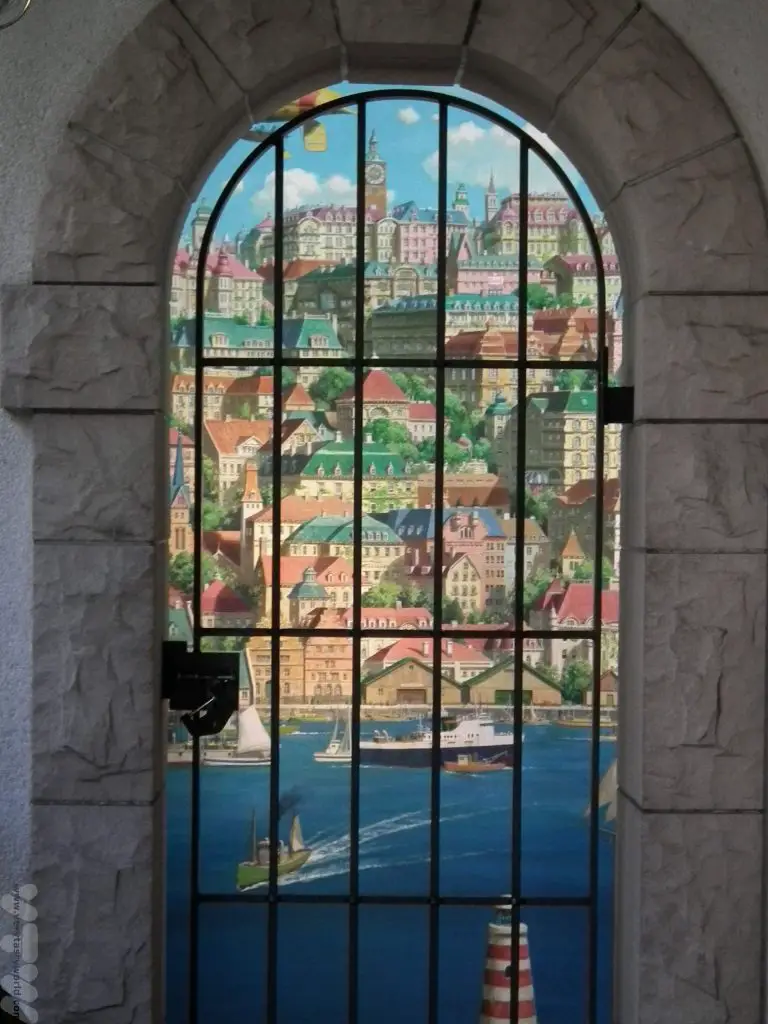
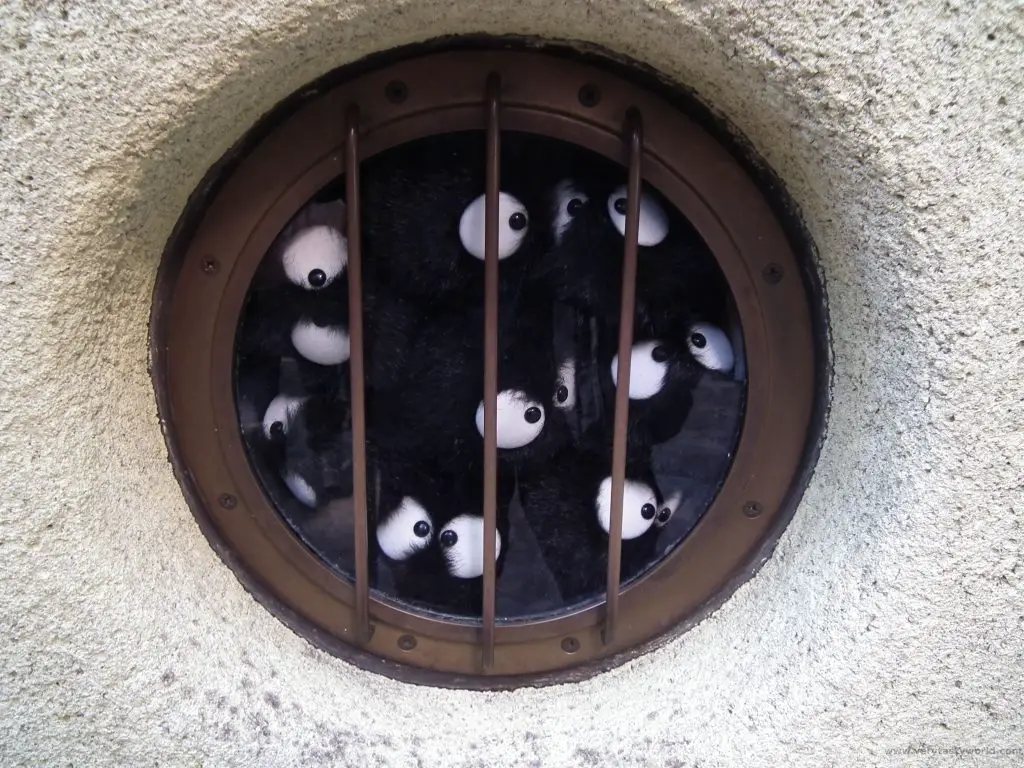
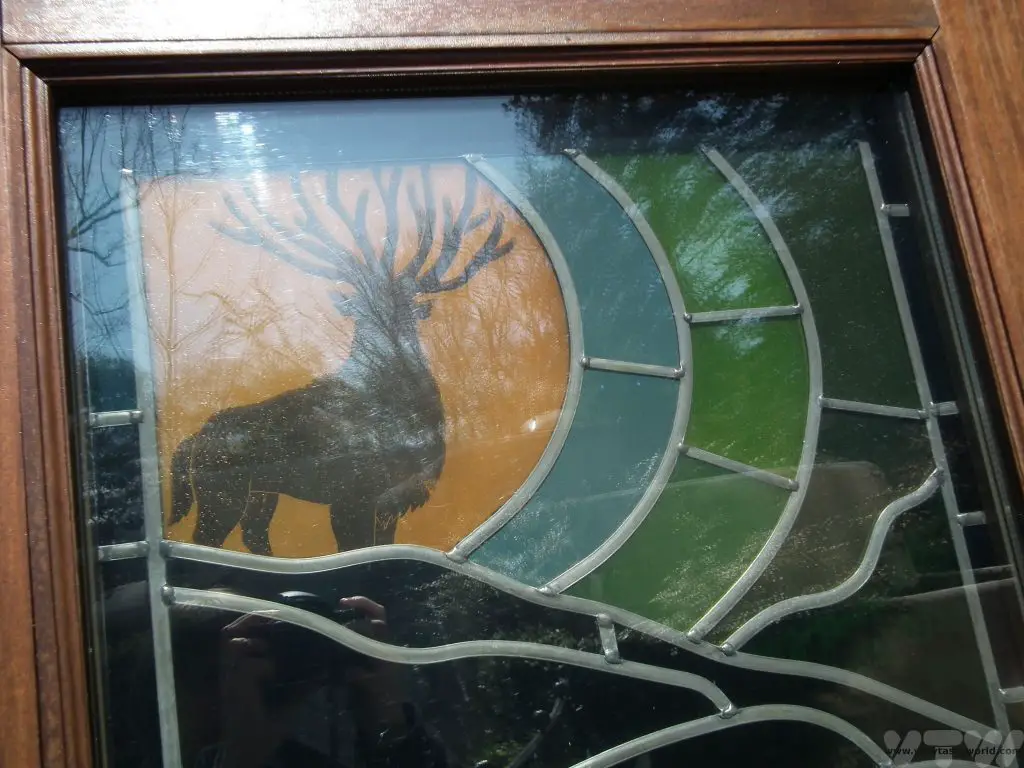
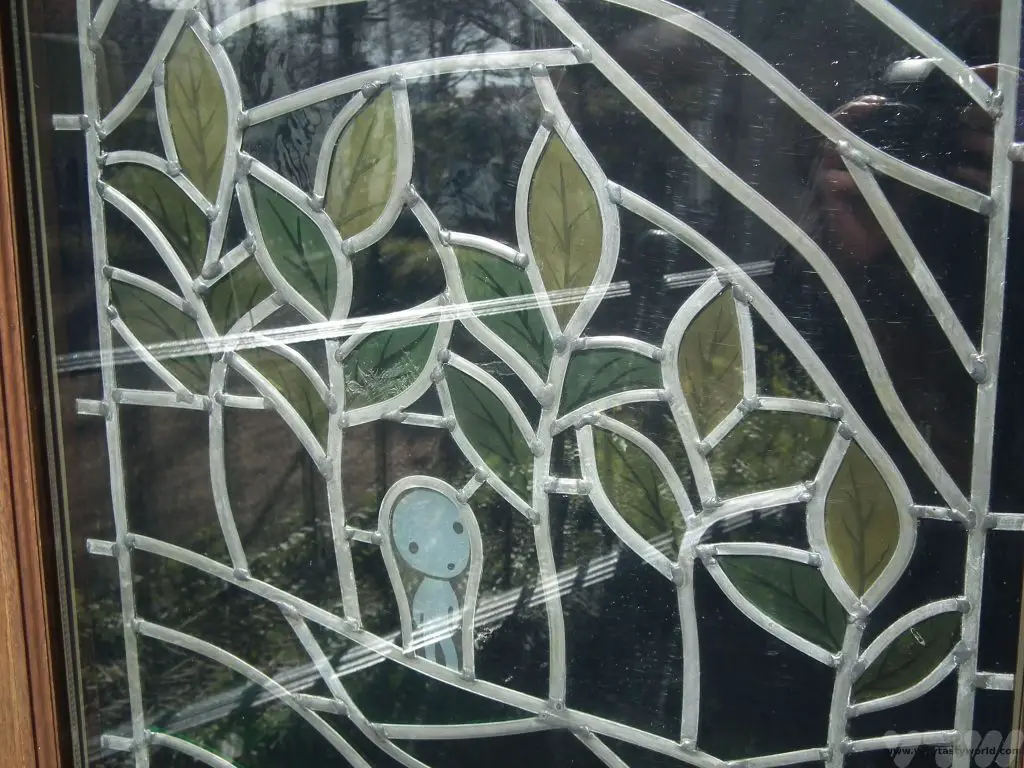
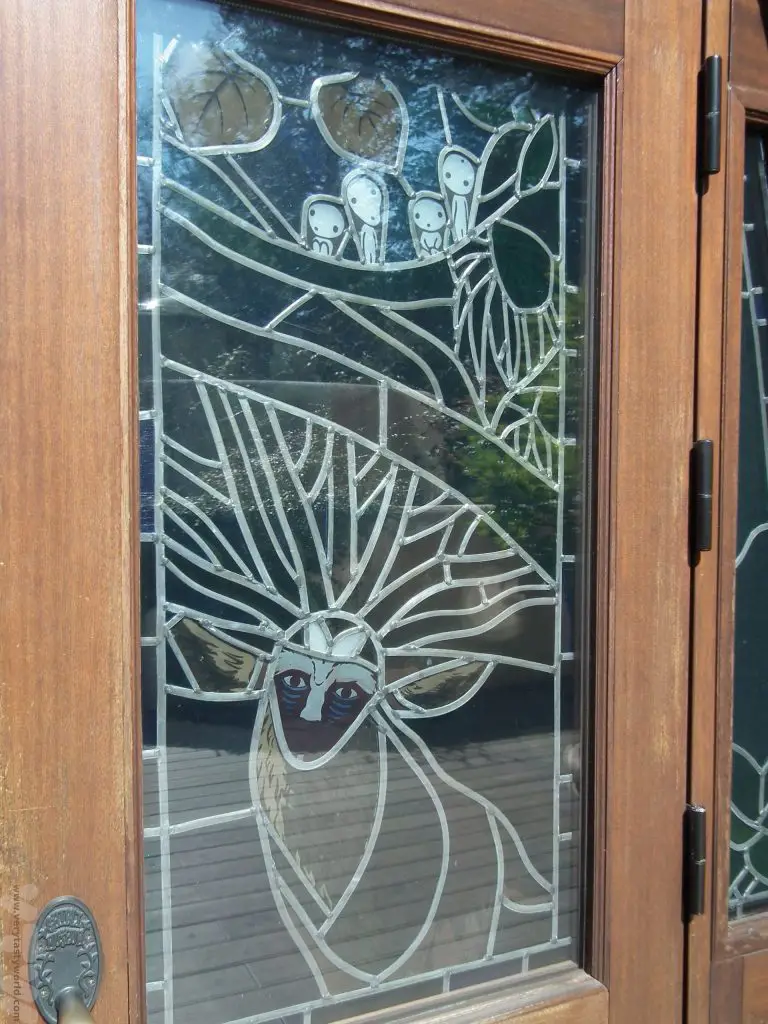
There is a café, The Straw Hat Cafe (featuring Mei’s hat from My Neighbour Totoro), adjacent to the museum which sells ice-cream, drinks and snacks.
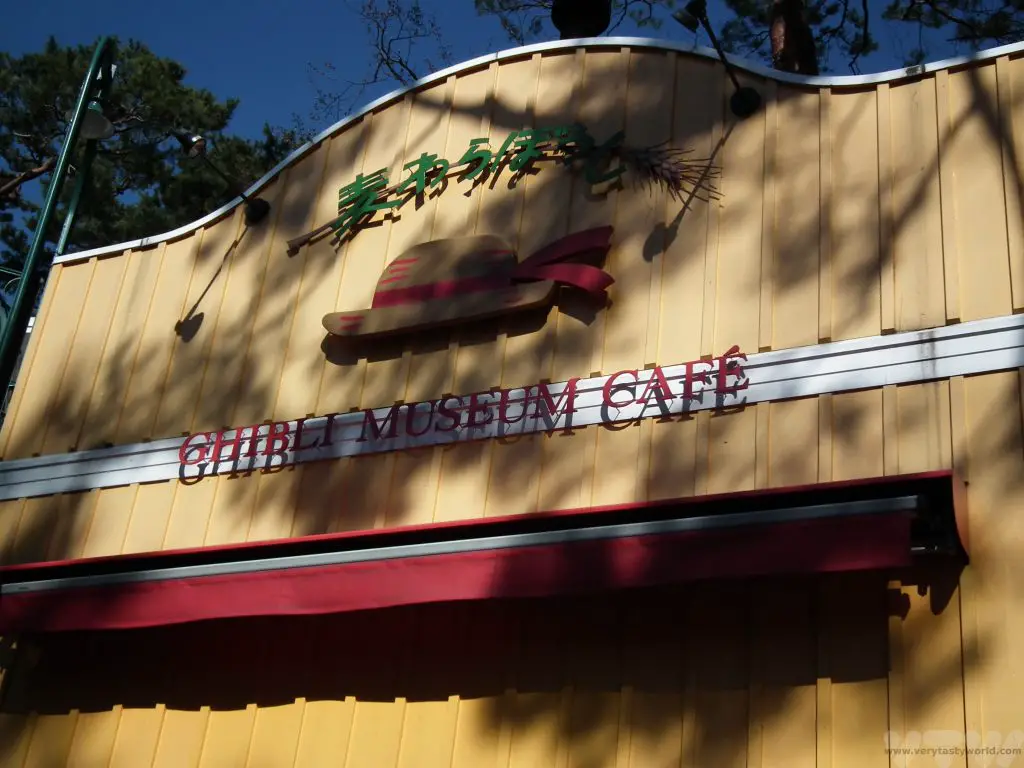
It’s become something of a tradition for us to enjoy a hot-dog and a cold beer – yes, you can even enjoy a bottle of Nausicaä beer! – at the end of the exploration.
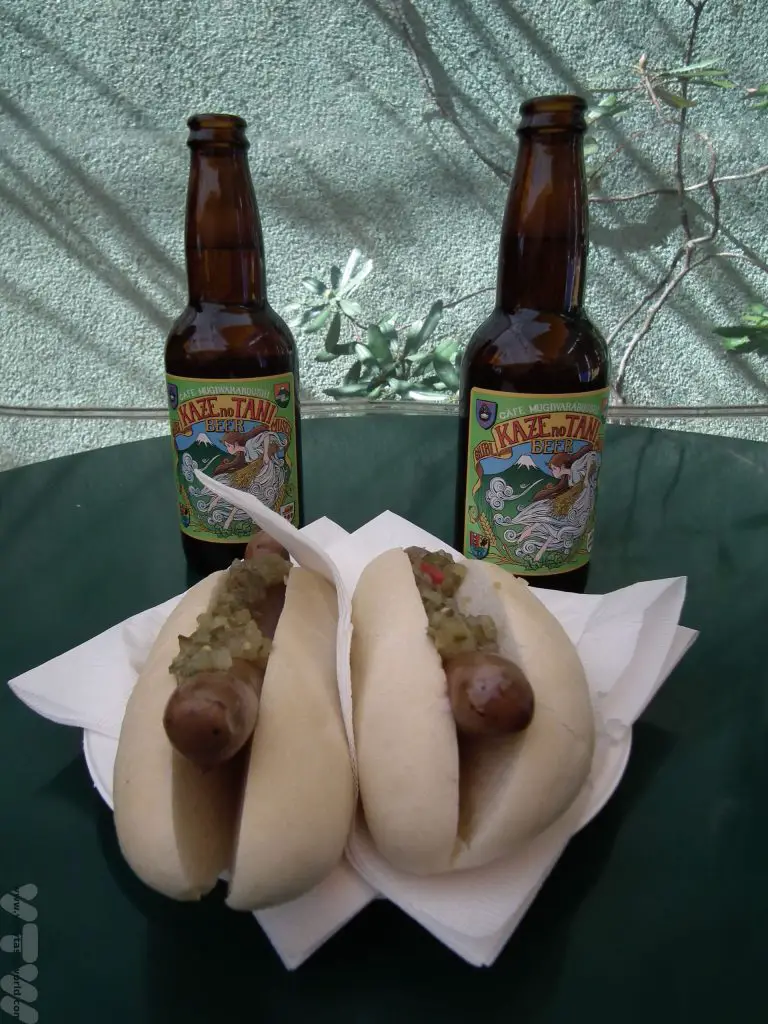
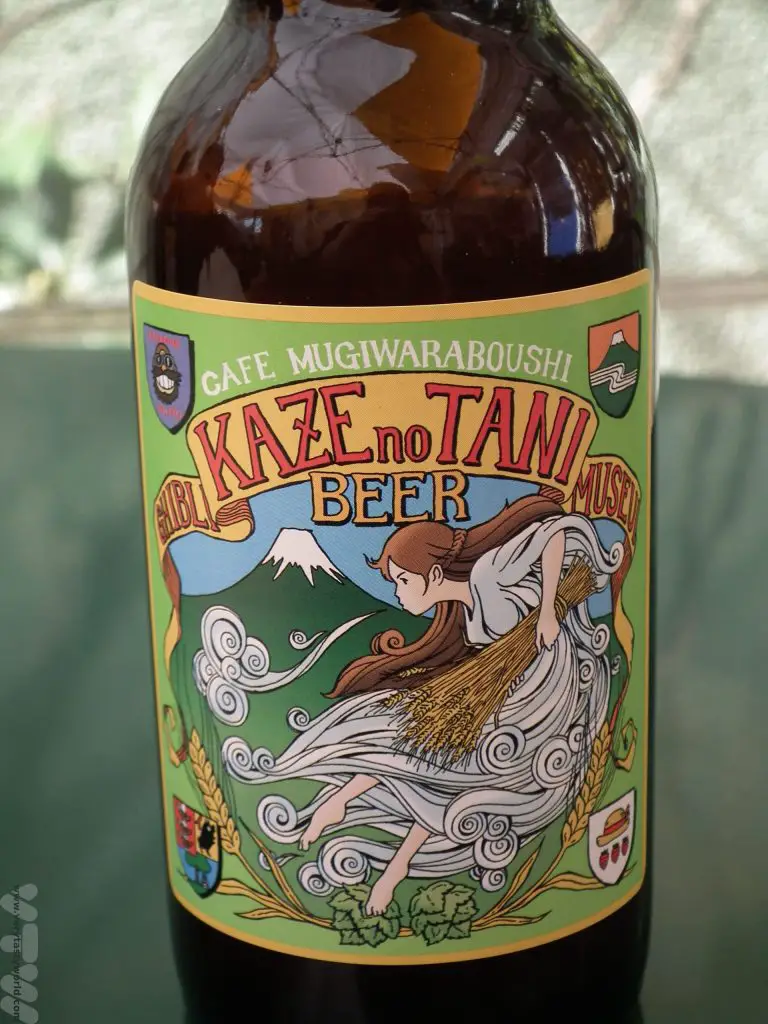
The Ghibli museum is emphatically one of the most wonderful places we have visited. It’s a triumph of imagination and design and is genuinely a place of wonders. Even if the process of obtaining tickets is somewhat convoluted, we can’t recommend this museum highly enough. We’d go again in an instant.
Related Posts You May Enjoy
Please note that this post contains affiliate links. If you click the link and decide to make a purchase we will earn a small commission, at no cost to you, which helps towards running this site.
RECIPE – Kabocha Korroke – Pumpkin Croquettes
Kabocha is a type of squash, often called a Japanese pumpkin. It is small-medium in size (around 25-30cm diameter). Its flesh is bright orange which contrasts beautifully with its dark green skin. They are also pretty easy to grow. And it is a truth universally acknowledged that home-grown vegetables are always more delicious than shop bought ones.


This year we grew three of the beauties in our little garden and the very first thing we wanted to make once harvested, was ‘korroke’, a Japanese version of croquettes (the word is spelled in katakana, the phonetic alphabet used for words of international origin). It’s the sort of dish that you would find in a Japanese izakaya (a bar that sells alcohol and tasty snacks/small dishes). They are simple to make and utterly scrumptious. Here’s our recipe for Kabocha Korroke – Pumpkin Croquettes:
Ingredients For Pumpkin Croquettes
1 kabocha pumpkin. If you can’t get a kabocha, other squash can be used. Pumpkin might be a bit too squishy but something like a butternut squash would work well.
1 egg (vegans can use corn starch mixed with warm water in an approximate ratio of 1:3)
50g (approx) Plain flour
50g (approx) Panko breadcrumbs
Pinch of salt
Oil for frying/spray oil for baking
Tonkatsu sauce to eat with (Brown sauce will work well if you can’t get tonkatsu)
Method
Cut the pumpkin in half and then into slices. Remove the seeds (we kept loads of seeds and dried them so that we can sow them next year).
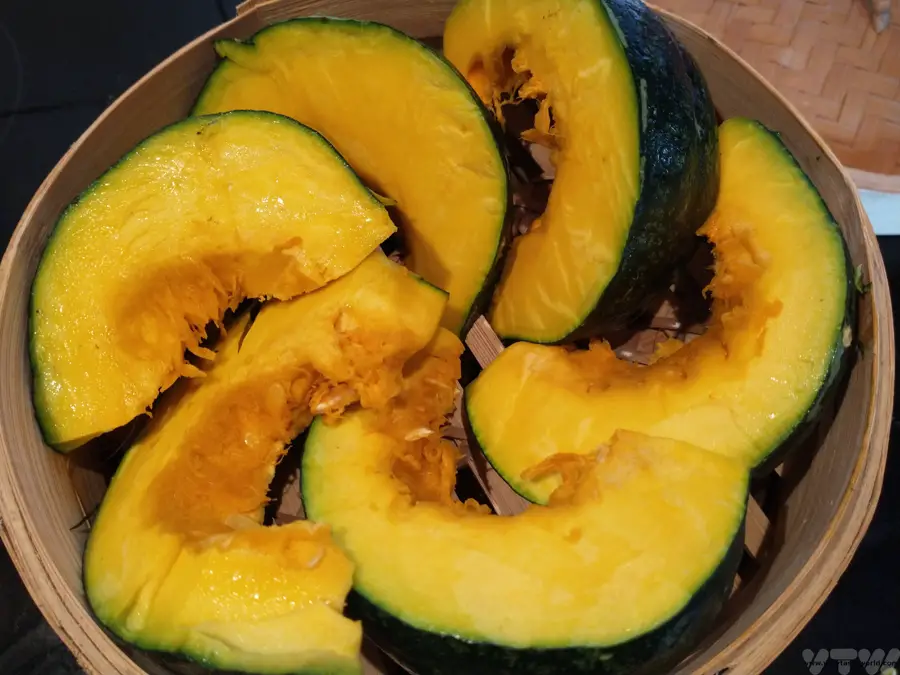
Arrange the slices into a steaming bowl. We tend to use the Asian style bamboo baskets as they stack very nicely and can just sit on top of a saucepan of boiling/simmering water.

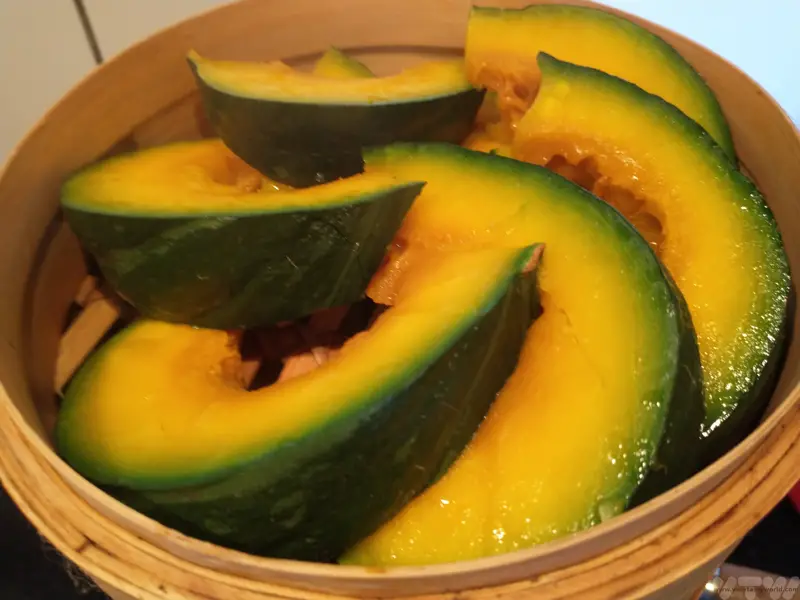
Steam for around 15 minutes or until the pumpkin is soft – a knife should easily sink into the flesh. (If you don’t have a steamer you can bake the pumpkin slices in the oven for around 40 minutes.)
Although the skin of the kabocha is edible, for the purposes of the korroke it is best to remove it. (You can treat yourself to pumpkin skin snacks – once they have cooled down a bit – while you continue the preparation.)
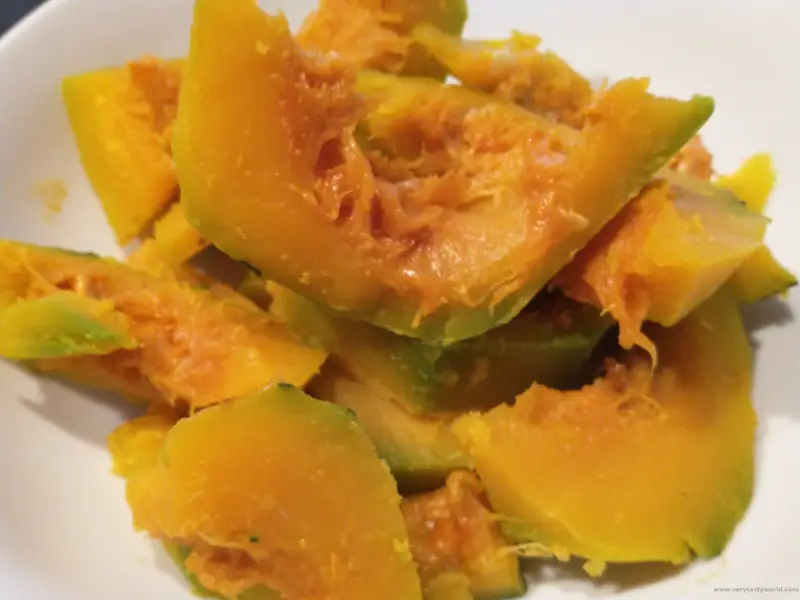
Add a pinch of salt and mash the pumpkin using a potato masher. It is possible to add other flavourings at this stage if you wish. Some recipes add sautéed onions, others lashings of butter, yet others include shichimi (Japanese seven spice mix). We just seasoned with the salt, which brings out the natural flavour of the kabocha, in this instance.
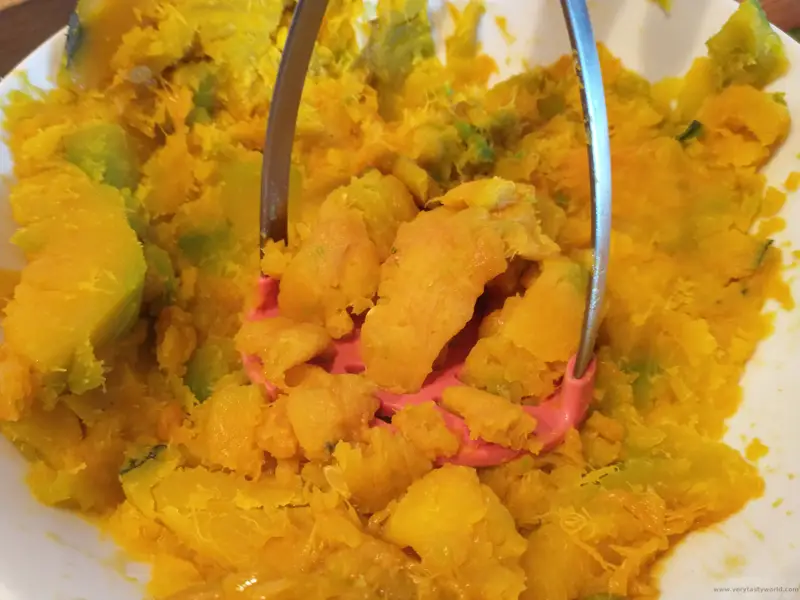
Form into patties.
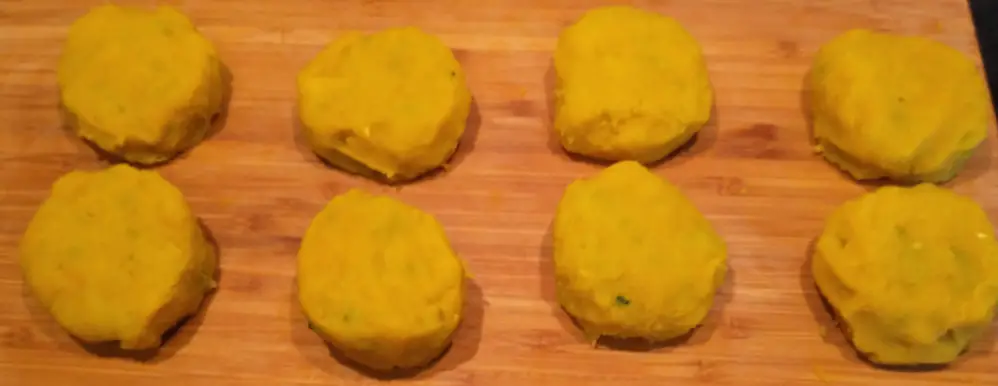
Panko are Japanese breadcrumbs. They are crispy and super dry, usually made from white bread. You can buy panko in most supermarkets these days but ordinary breadcrumbs will be fine if you can’t find them. Set out three bowls. One for flour, one for an egg, lightly beaten, and one for the panko.

Dip each patty in the flour, then the egg, then the panko. This process can get a little messy (especially if you are a clumsy cook). Do not attempt to take photos using your phone if you have sticky fingers.

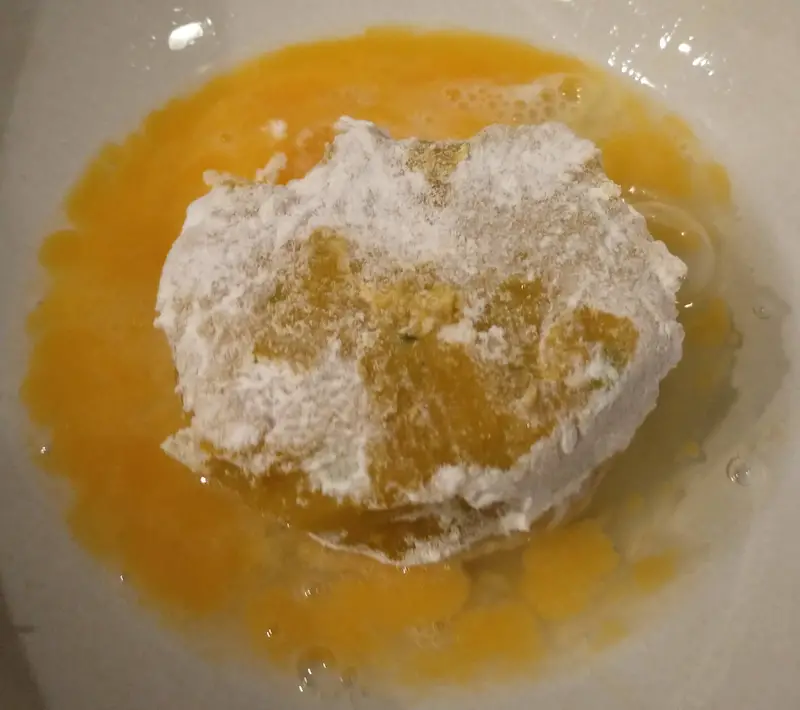
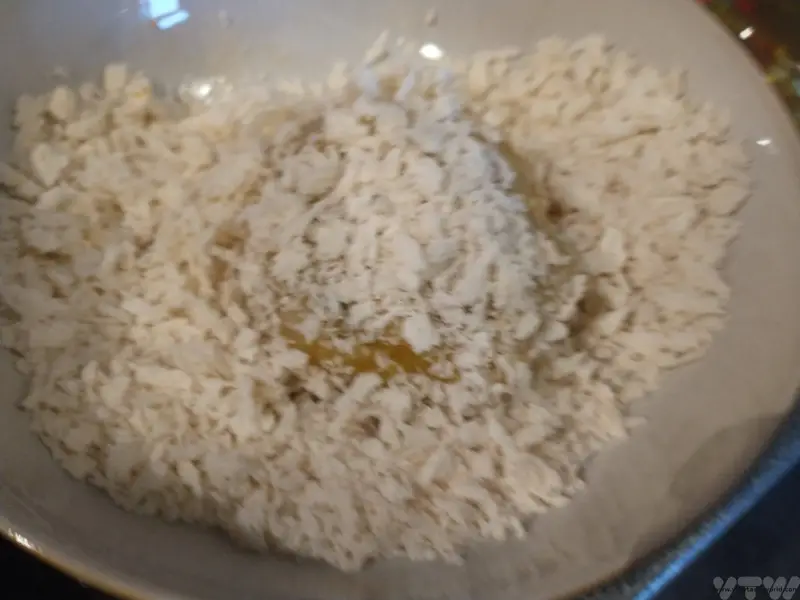
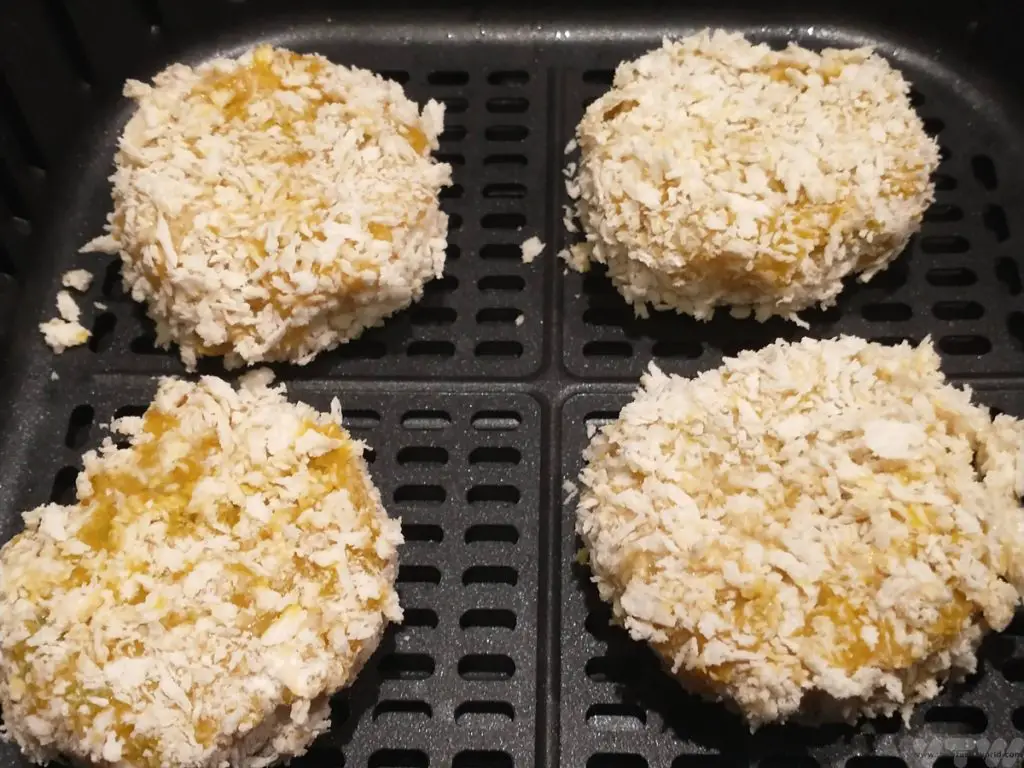
There are several options for cooking. Bear in mind that the pumpkin is already cooked so the korroke don’t need long. We’ve recently invested in an air fryer so thought we would use that. Just spray the patties with oil and cook at 190C for 4 minutes on each side. You can also bake them in the oven for about 8 minutes. Or you can fry them the old-fashioned way in vegetable oil for a couple of minutes on each side or until the panko are golden.

Then it’s time to scoff! Korroke are often served with tonkatsu sauce. This is a sweet and tangy sauce that perfectly complements the pumpkin. If you can’t find tonkatsu, brown sauce (the type you eat with a cooked breakfast) is a good substitution. Other accompaniments can include mayo or a soy based dipping sauce. Best served with a nice, cold beer. Or two.


- RECIPE Oyakodon Donburi
- Zero Waste Recipes Before Your Holiday
- RECIPE: Vegetable Biryani Tamil Nadu Style
- RECIPE: Vegan Wild Garlic Pesto
- Recipe: Venetian Pasta Sauce
- RECIPE: Biryani Raita Recipe
- RECIPE: How to Make Costa Rica’s Gallo Pinto
- Recipe: Japanese Simmered Pork Belly – Buta no Kakuni
- RECIPE: How to Make Umeboshi
Visit Quito, Ecuador
A Great Latitude
The remarkable Galapagos Islands are undoubtedly Ecuador’s top tourist attraction and many trips to the islands start out from Quito. The city itself has plenty to offer the visitor. We were lucky enough to undertake a largely land-based Galapagos tour but gave ourselves a couple of days on the Ecuadorian mainland before and after this trip, predominantly to give ourselves some days in hand in order to make sure we could catch our connecting flights, but also because we wanted to explore the city and surrounding area. There are all sorts of day trips available in and around the capital when you visit Quito.
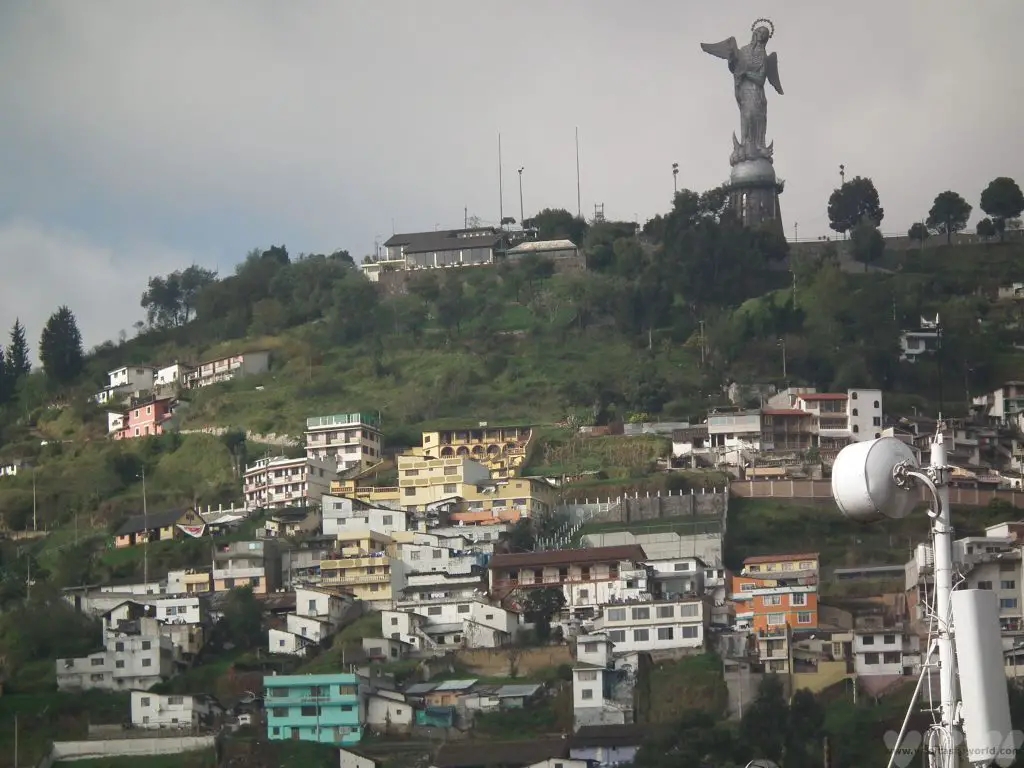
Quito is the second highest capital city in the world, located virtually on the equator and at an altitude of 2850m above sea level. If you’ve not spent time at that altitude it is really important to take it easy, even climbing a flight of stairs can leave you a little breathless when you first arrive. Many hotels in South American countries offer coca tea which is supposed to help with the effects of altitude sickness, although if you do feel ill make sure you seek medical attention.
When you visit Quito, the Centro Histórico is a great place to stay. San Francisco de Quito was founded by Sebastián de Benalcázar in 1534 and the colonial architecture is considered to be so important that the city is designated a UNESCO world heritage site (along with Krakow in Poland). It also has some of the best bars and restaurants in the city. Our hotel had a good view over Santo Domingo Plaza, one of many colonial plazas.
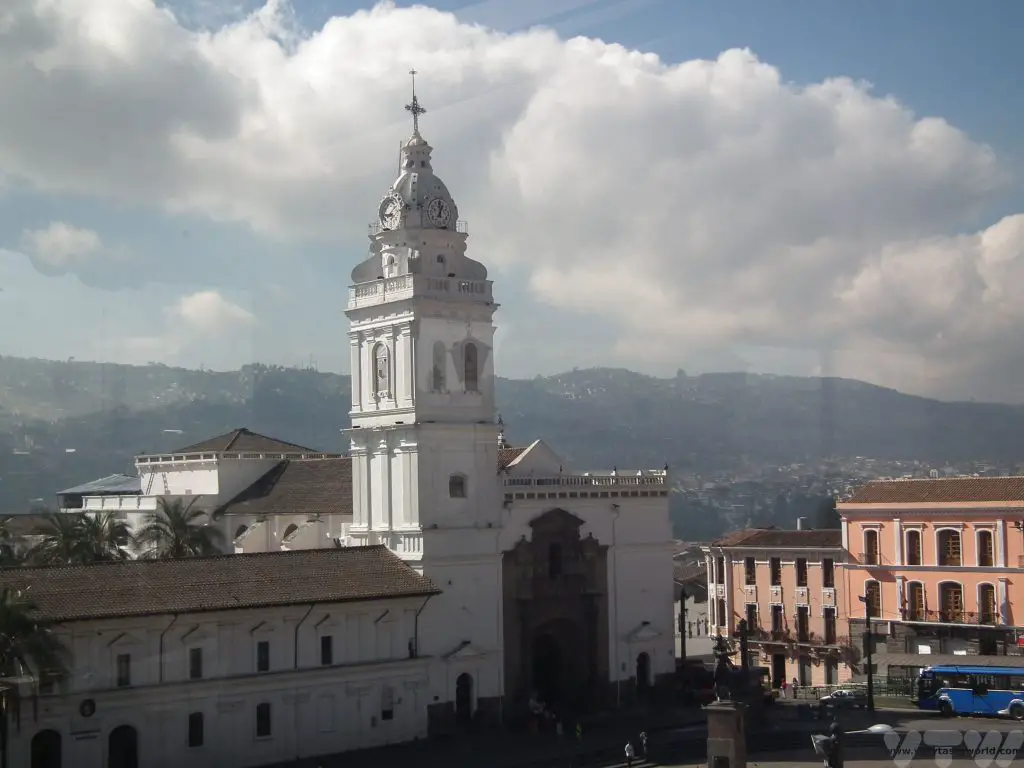
It is very pleasant just wandering through the city.
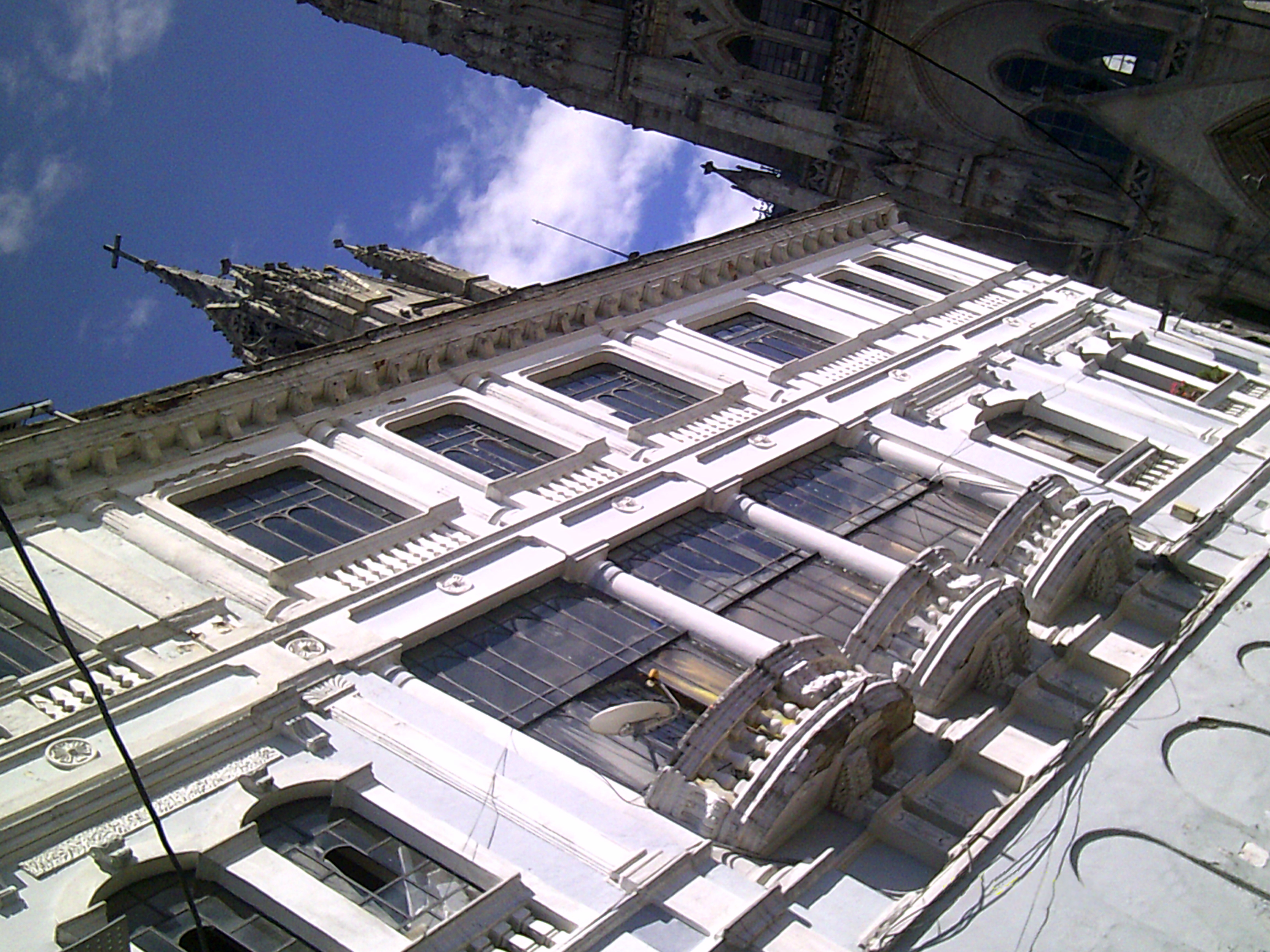
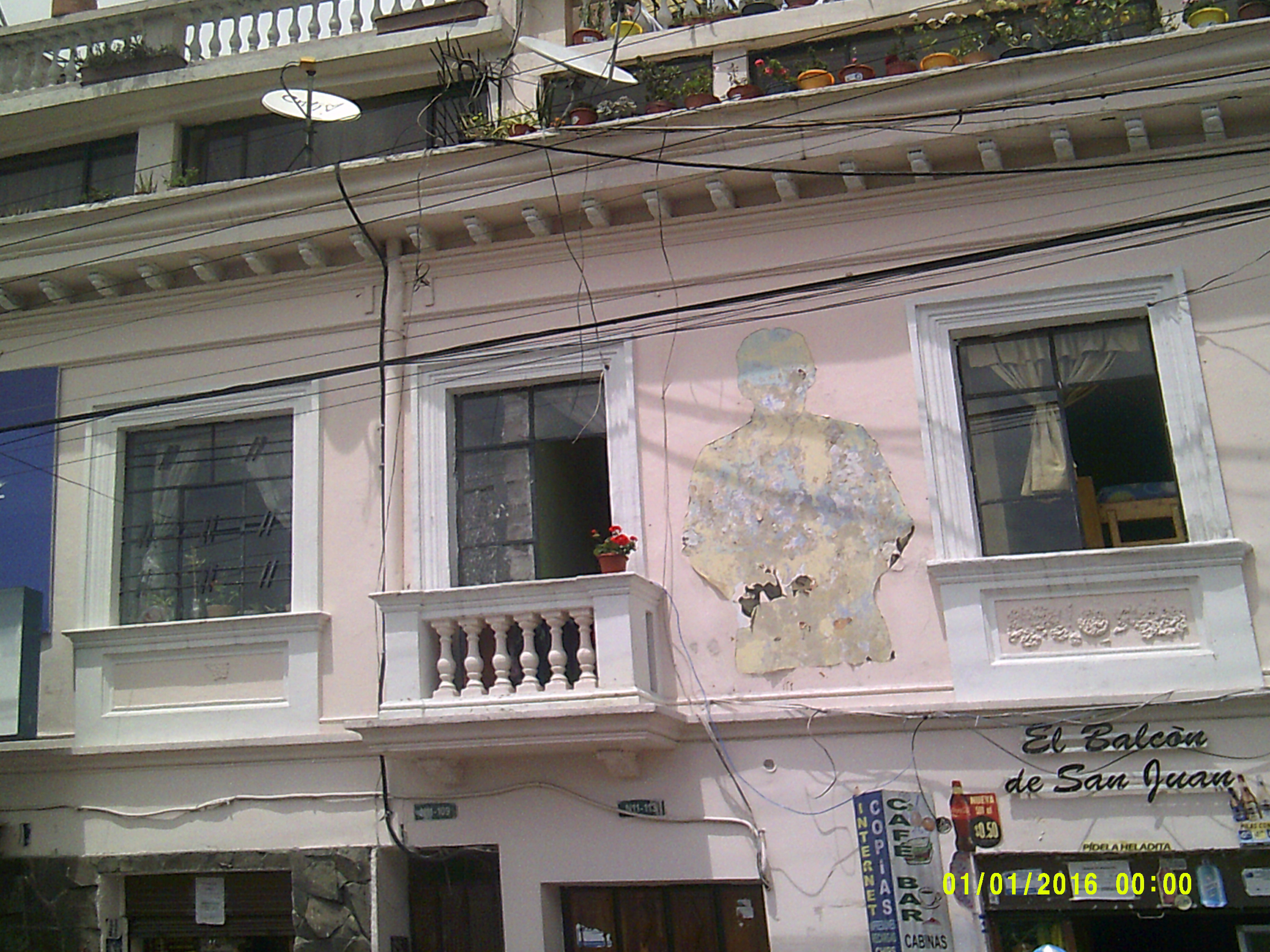
Basílica del Voto Nacional – Basilica of the National Vow, a Roman Catholic church, is located atop a hill. Apparently it is the largest neo-Gothic basilica in the Americas and is still officially unfinished. There is a local legend that when it is finally completed the end of the world will be nigh.

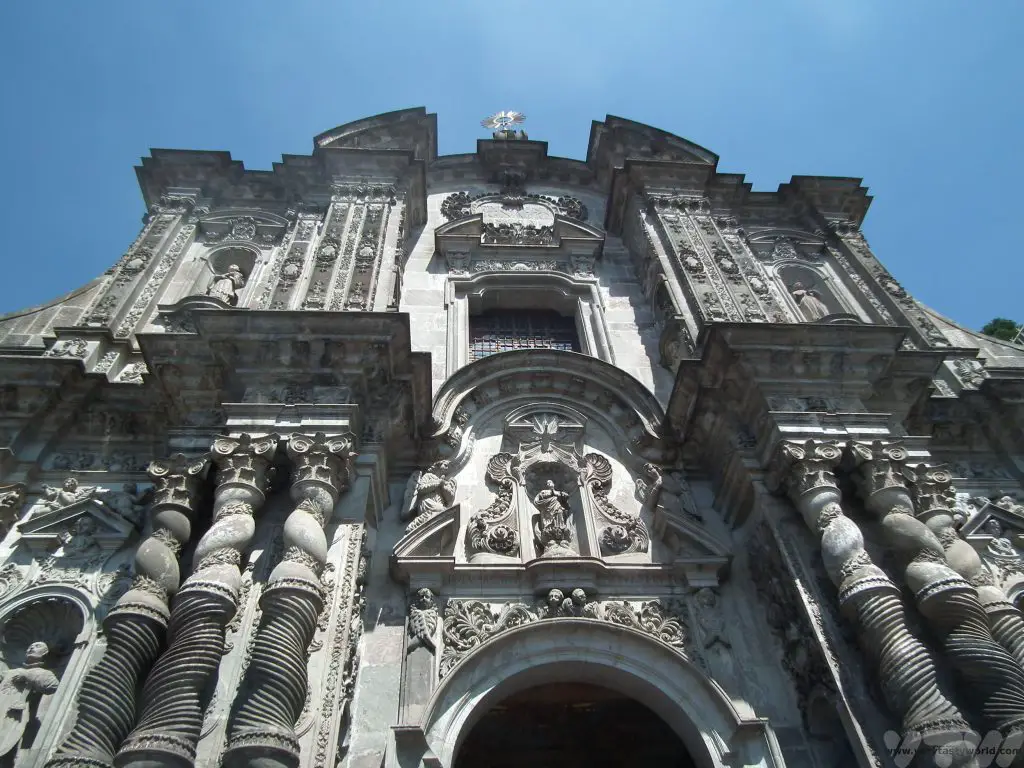

La Iglesia de la Compañía de Jesús, known locally as la Compañía, is a Jesuit church which was completed in 1765. Its interior is decorated with wood carvings, gilded plaster and gold leaf in an astonishingly ornate style.
The Plaza de Indepencia is a focal point with its expansive square.
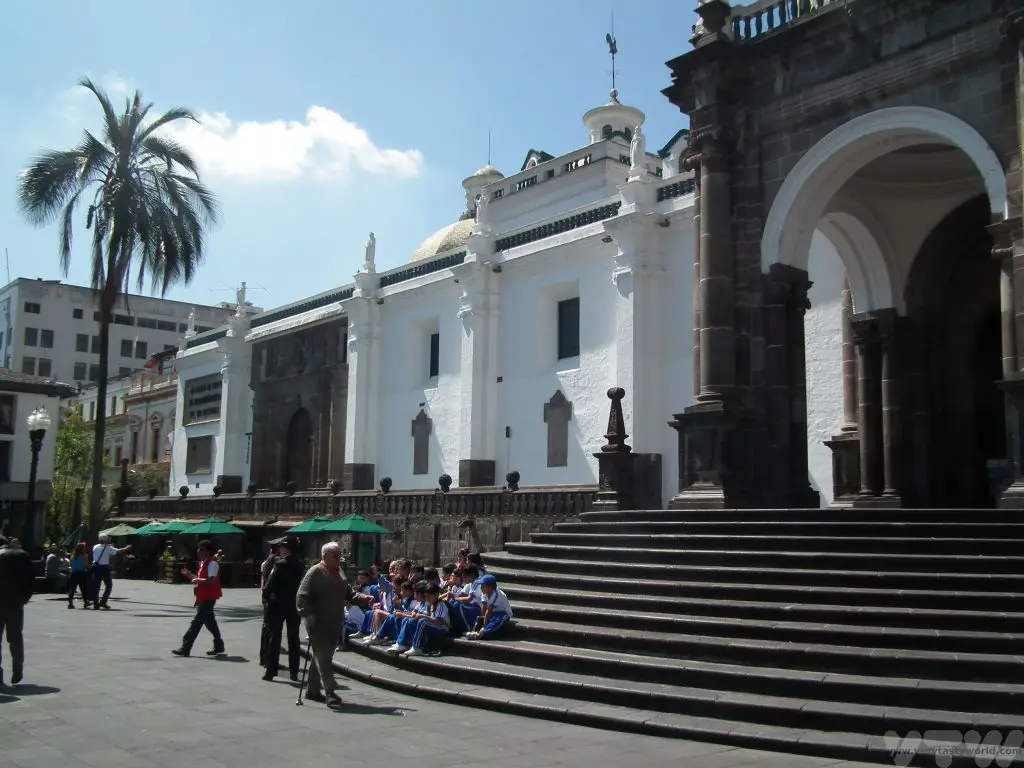
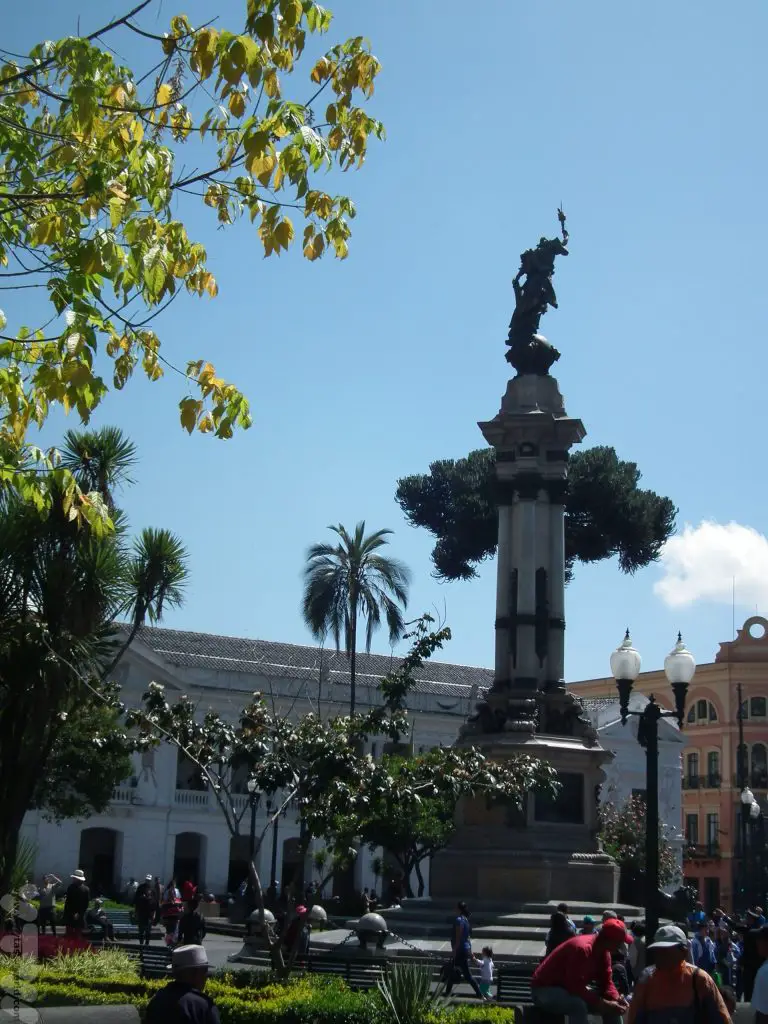
There are lots of shops and restaurants in the area but, notably, just around the corner from the Plaza is a chocolate shop which offers the most amazing chocolate delicacies. To be fair, there are loads of chocolate shops offering amazing chocolate delicacies (Central and South American countries are quite rightly famous for their chocolate), but it was in this one that we discovered Pacari chocolate. The chocolate isn’t cheap but it’s the best quality we’ve ever tried. The company is really ethical as well; a fair trade organisation they support local farmers in Ecuador by paying a good wage and working with them directly. The chocolate is also 100% organic and absolutely stonkingly delicious.
We brought home a multitude of different chocolate bars: the ‘pure’ choc – at 60% cacao – but also some of the flavoured ones. Many are flavoured with fruits: passion fruit and cherry really captured the flavours of the fruit, lemon verbena’s zing was a lovely contrast with the smooth, silky chocolate. We had enjoyed corn in various guises throughout our trip so toasted corn kernels in the chocolate added a satisfying crunch and the corn flavour also came through very well. Of course we had to try the chilli chocolate. It’s surprisingly subtle – the first flavour you taste is that of dark chocolate then, after a few seconds comes a gentle warmth (definitely not the fiery heat of a chilli) that lingers on the palette long after the chocolate has gone.
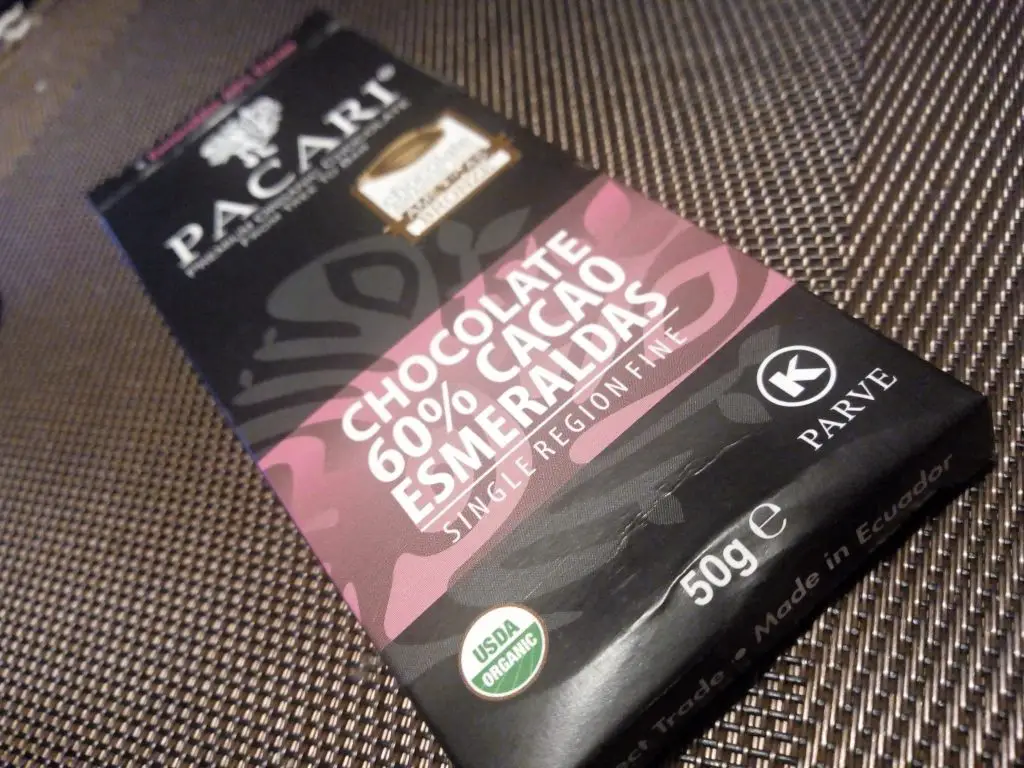
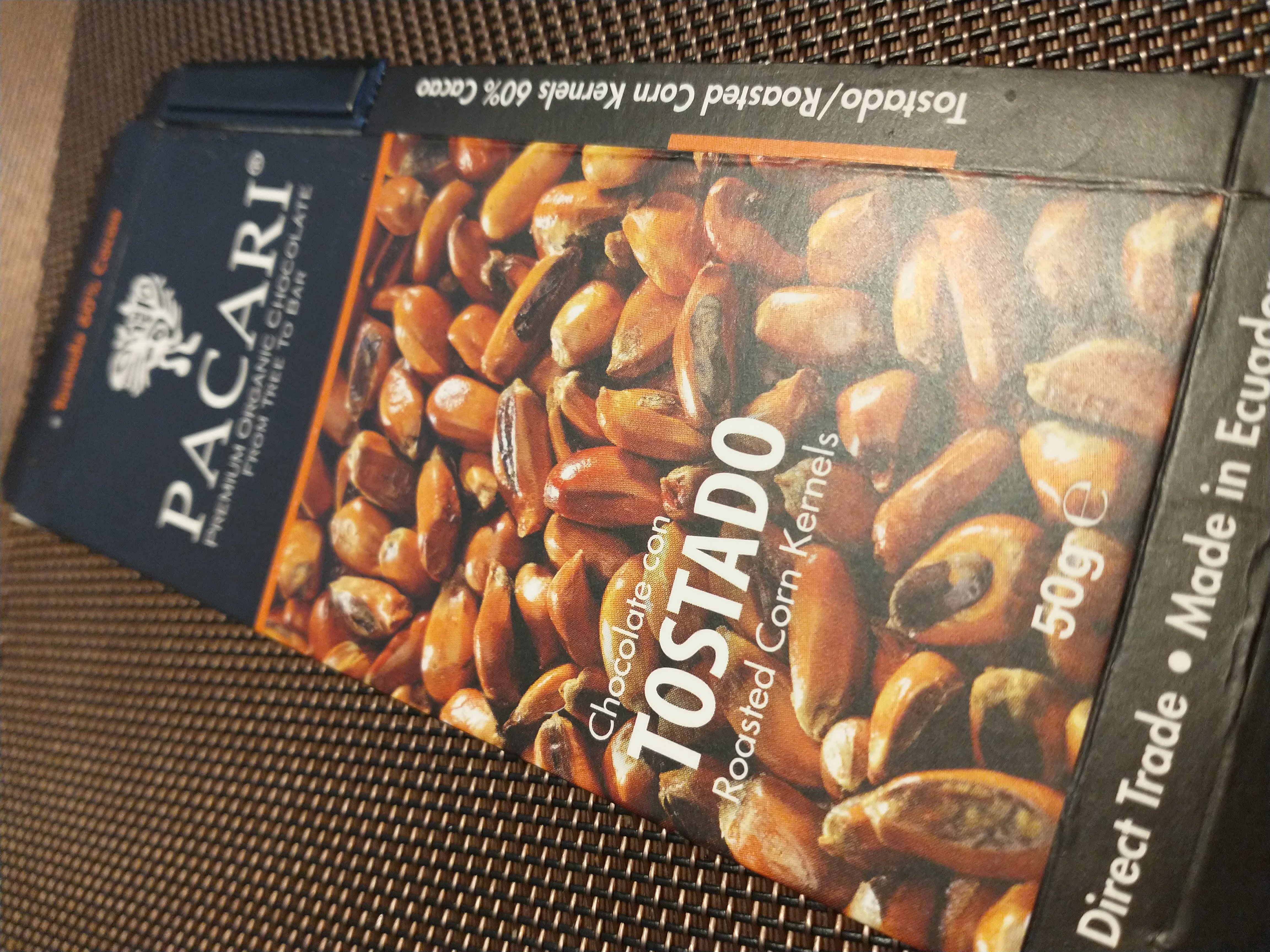
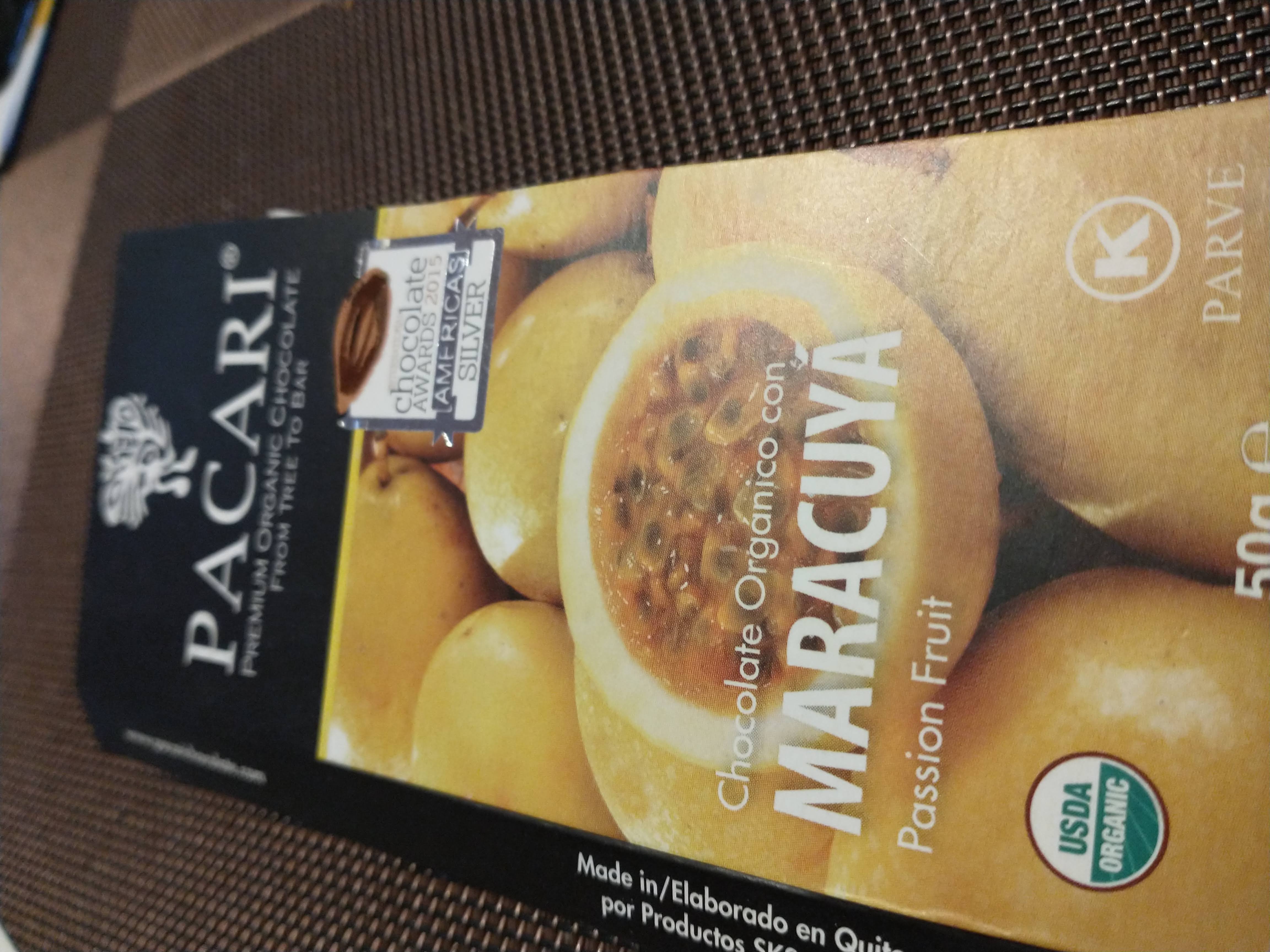
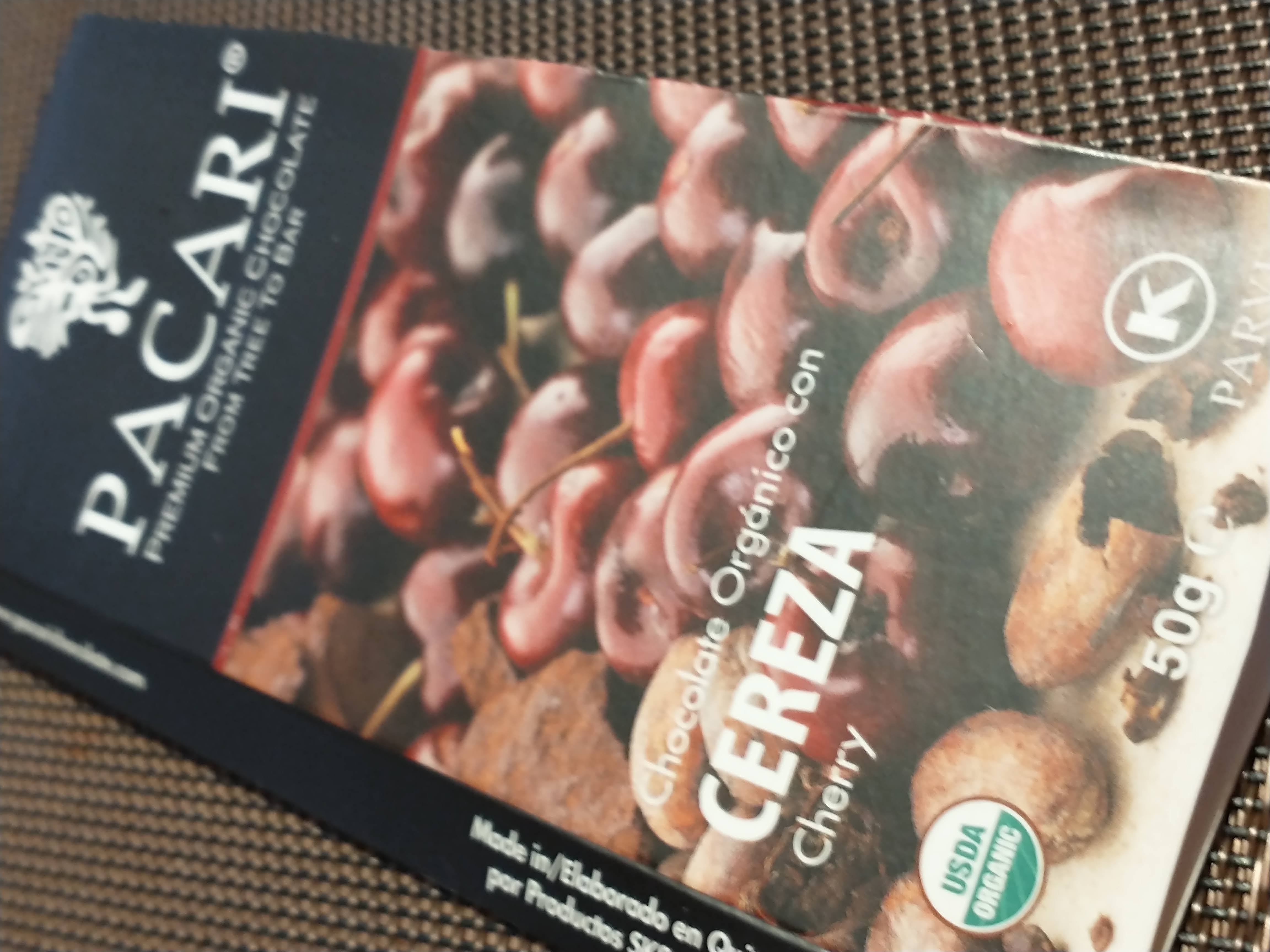
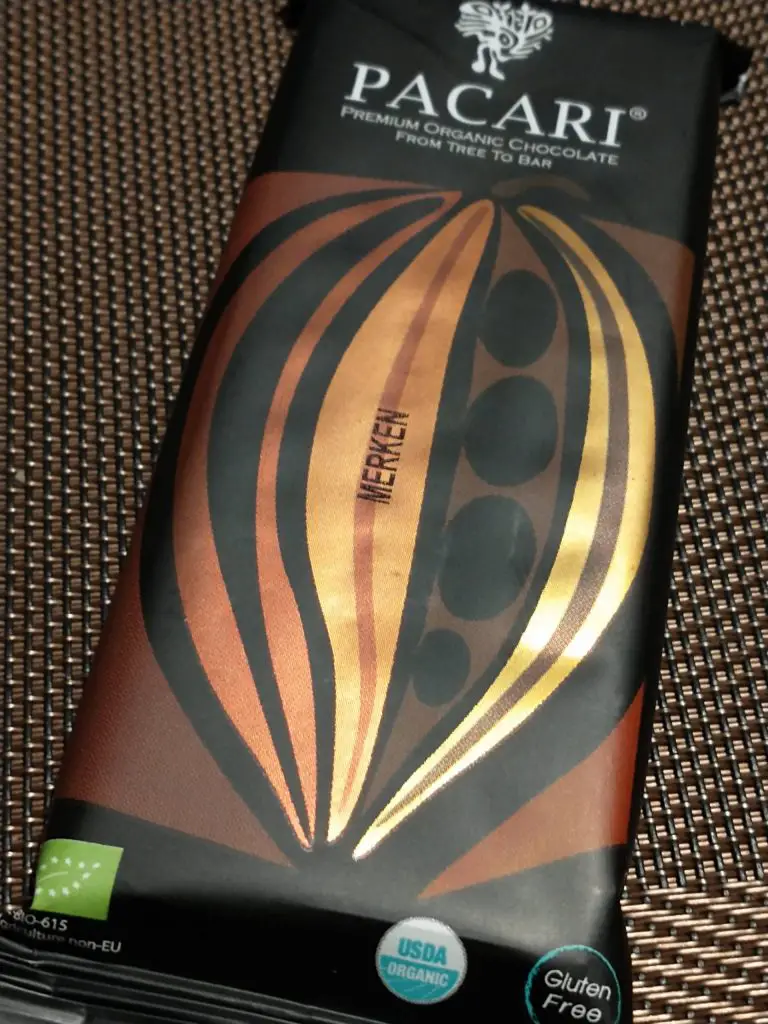
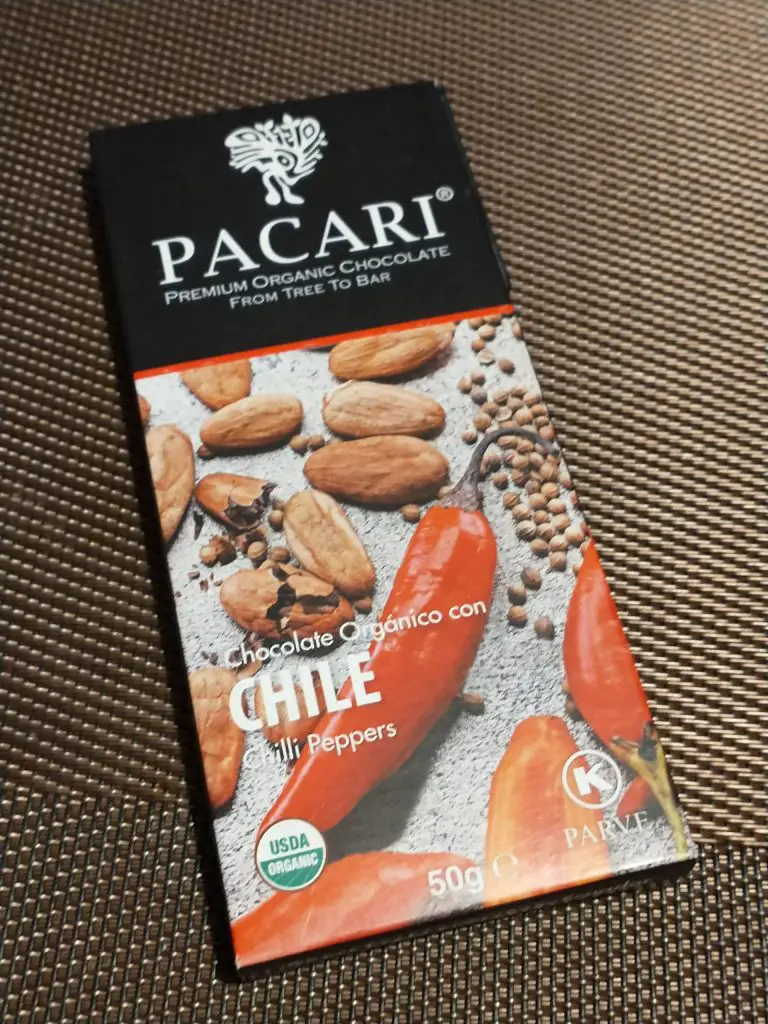
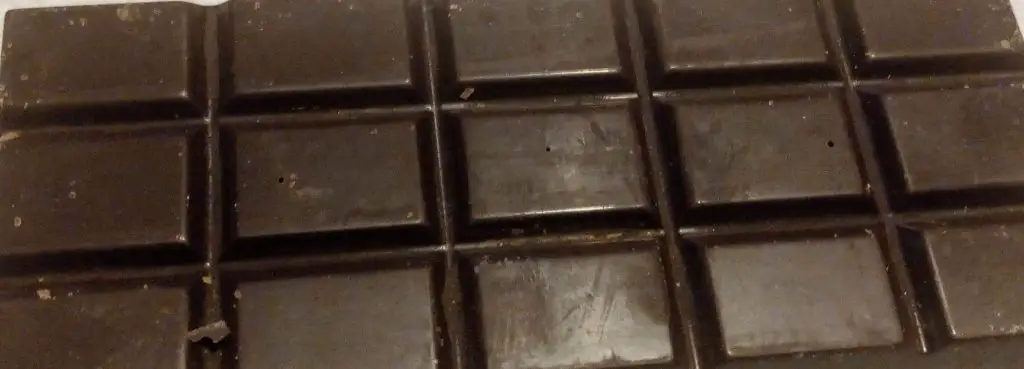
It is possible to buy Pacari chocolate around the world (they also try to offset their carbon footprint) but we’ve found that it is significantly more expensive than in Quito (and it’s pretty expensive in Quito, but emphatically worth every cent), so if you do find yourself in Ecuador, we recommend stuffing every square centimetre of spare space in your luggage with the chocolate before you travel home.
Visit Quito – City Tour
There are lots of city tours available when you visit Quito and most hotels will be able to put you in touch with a company that can suit your budget, whether it’s a group tour or a private guide. Some of the guides are very flexible and can adapt a standard tour to suit your interests so it’s definitely worth asking what options are available.
The Equator is one of the most popular tourist attractions (after all, the word Ecuador means ‘equator’) and it’s difficult not get excited at being able to stand in both the northern and southern hemispheres at the same time. There are two sites, located a short drive of around 25km outside Quito. Amusingly, the official equator site at La Mitad del Mundo (the Middle of the World) isn’t quite on the equator itself, thanks to an error by a French expedition in 1736.
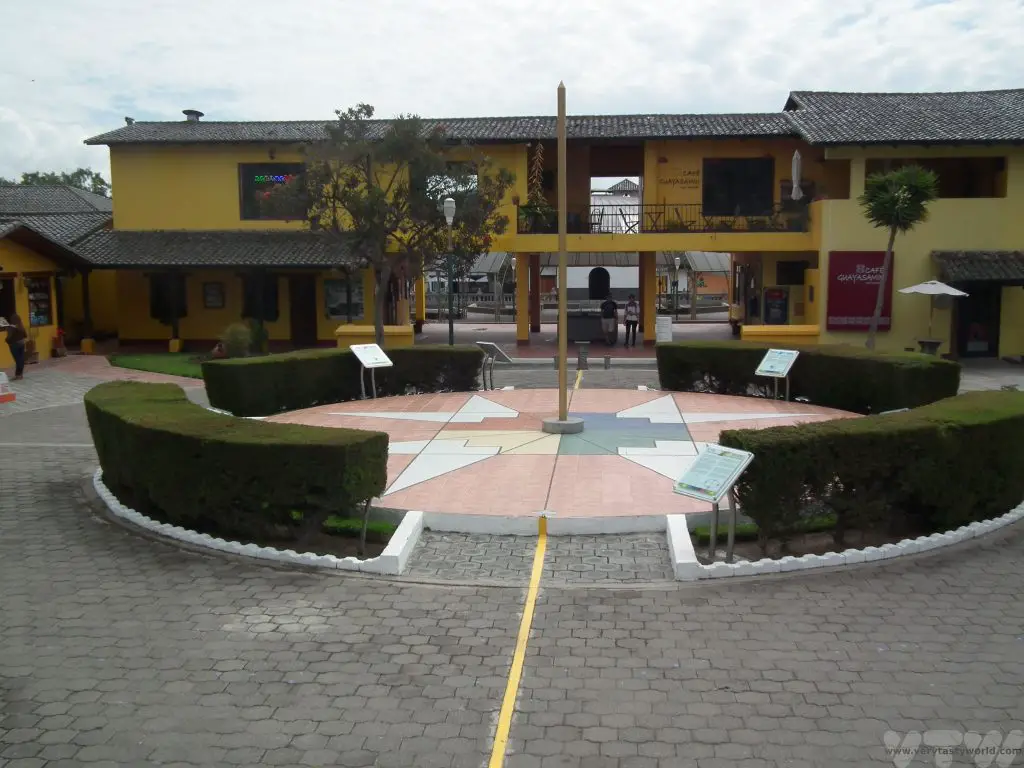
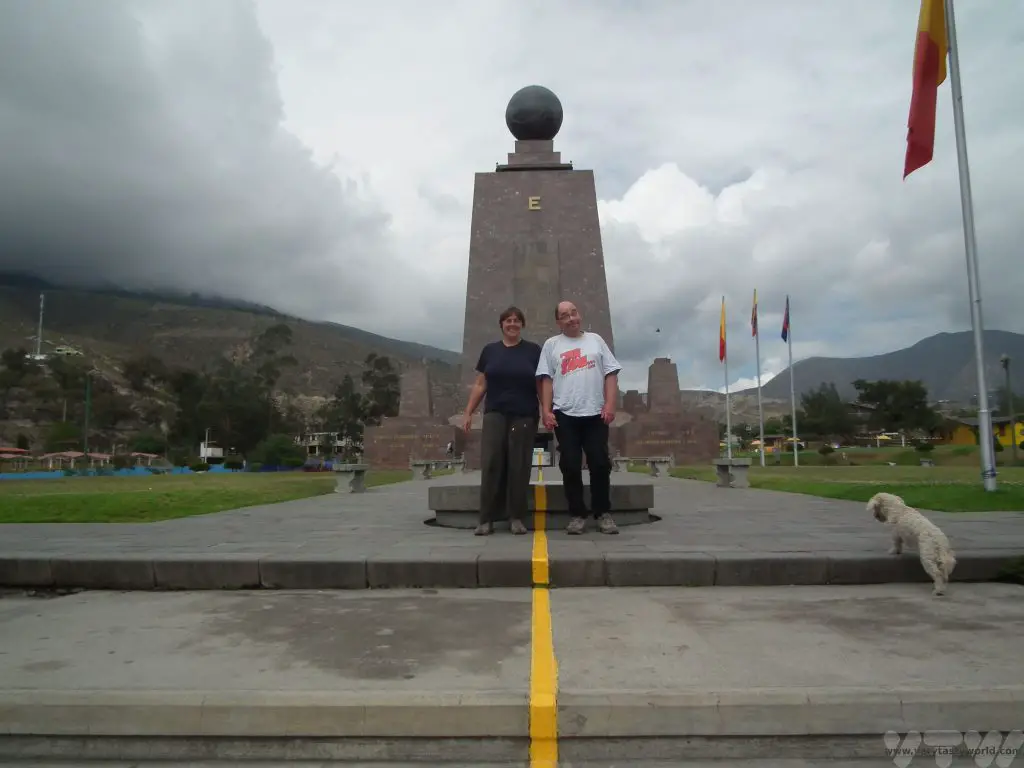
It seems it was the Incas who, several centuries earlier and without the use of GPS, managed to locate the correct location for the equator so we headed over to the Intiñan museum which is just a few minutes away from the incorrect official monument. The museum has an official equator line and also some exhibits showing traditional culture. You can also undertake various activities such as looking at the Coriolis Effect (whether waters swirls down a plughole clockwise, anti-clockwise or straight down depending on which hemisphere you are in – it won’t make a spot of difference), balancing an egg on a nail or walking along the equator with your eyes closed. It’s all ridiculous and hugely touristy but it’s enjoyable fun nevertheless.
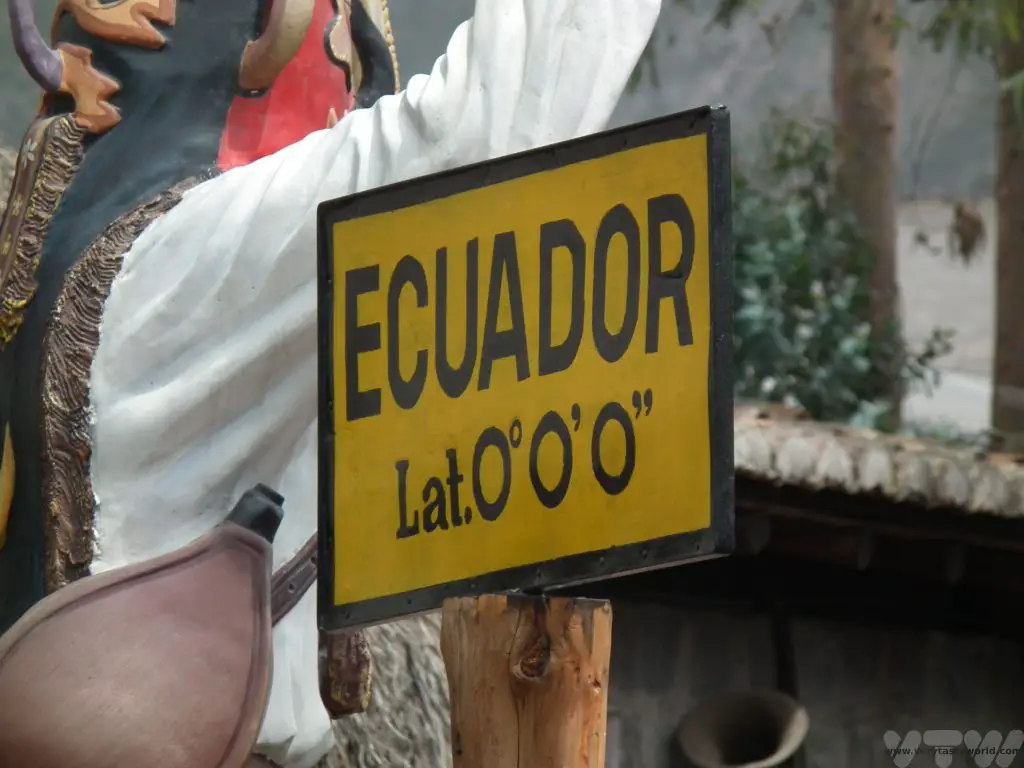
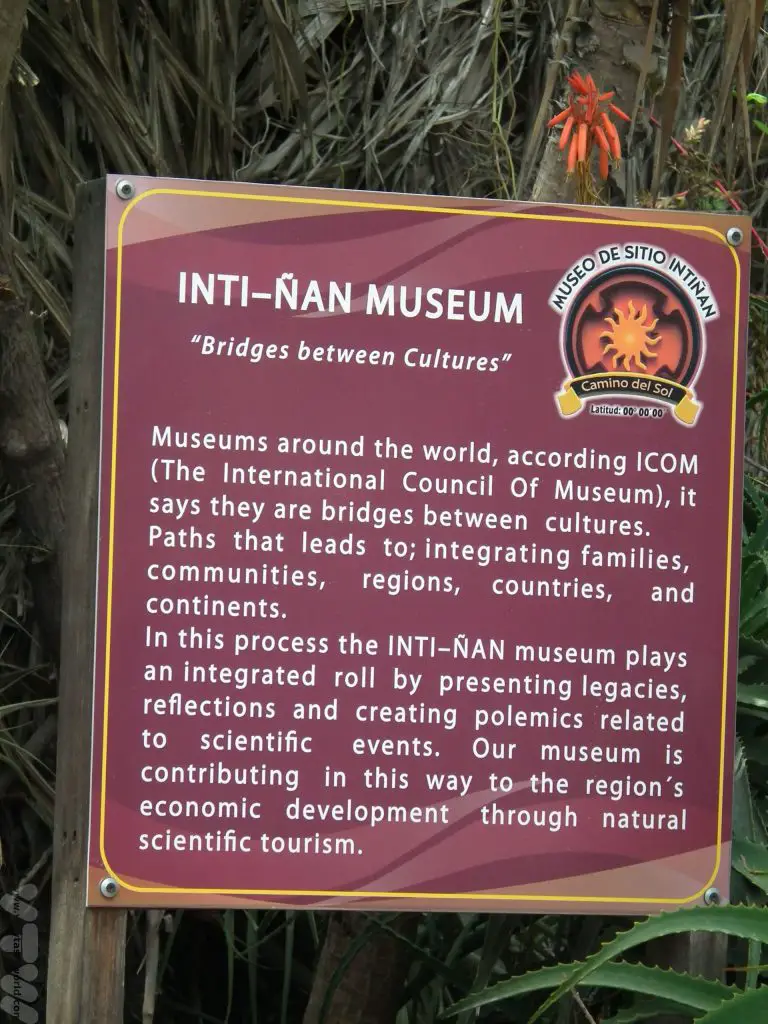
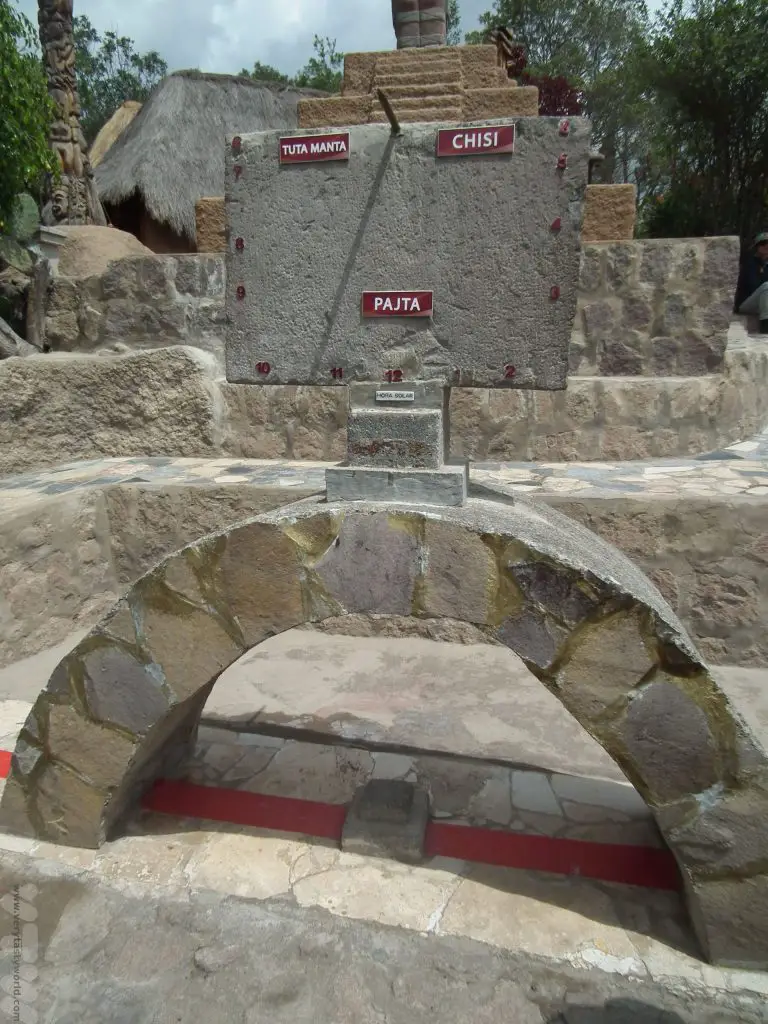
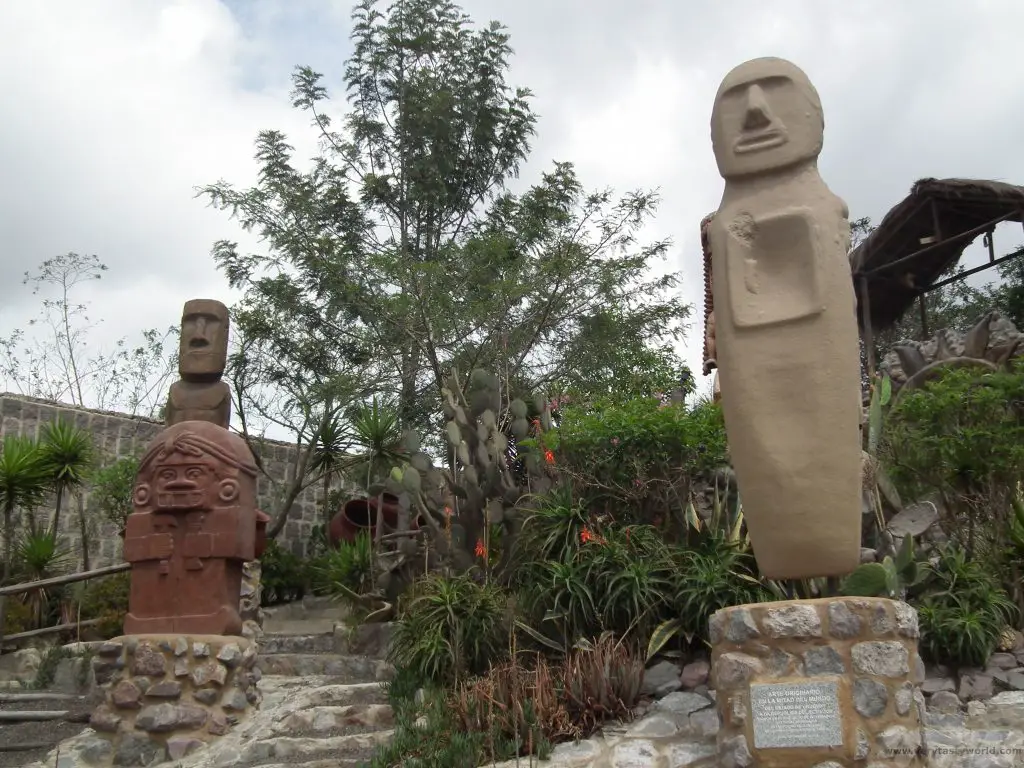
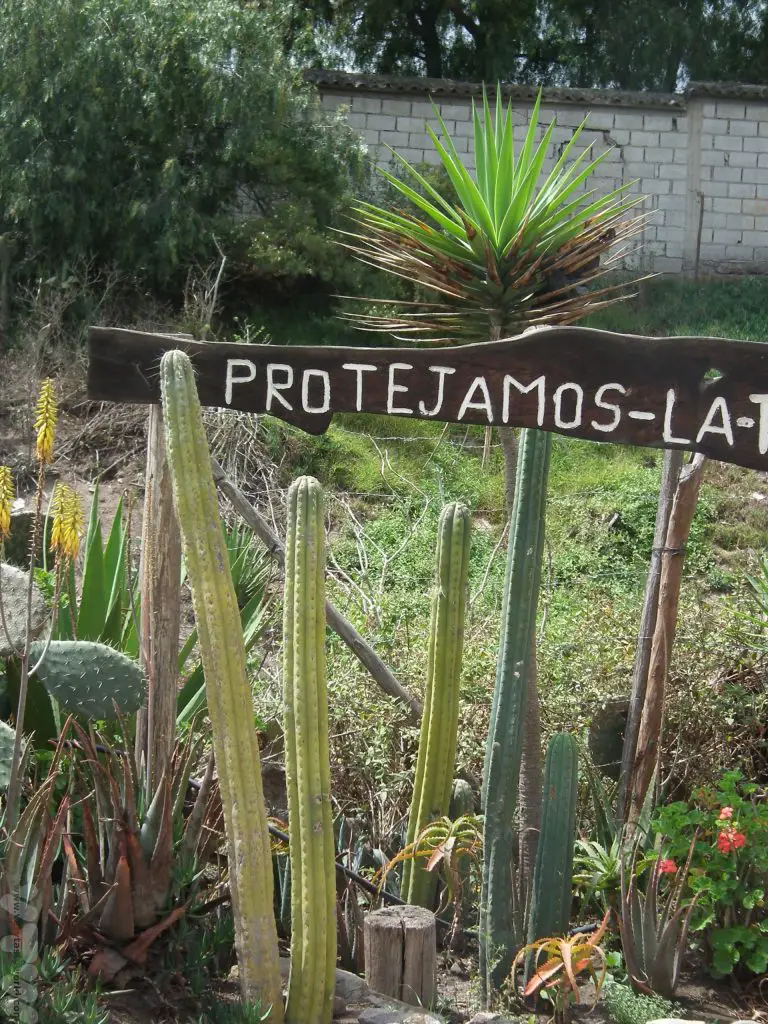
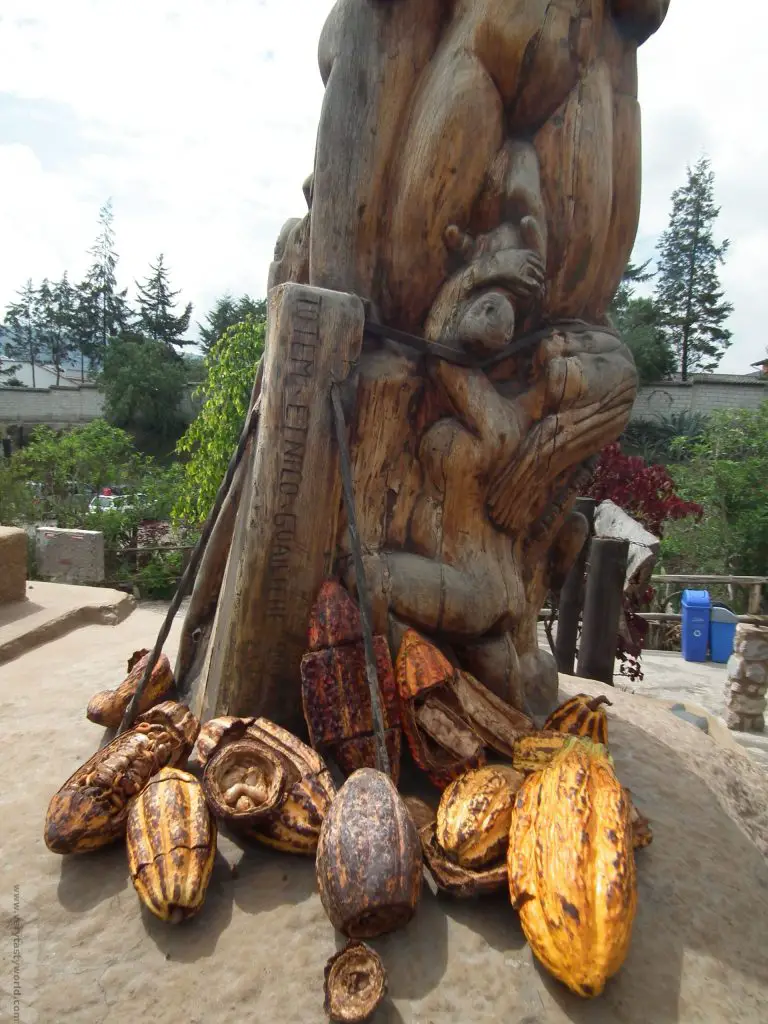
Anyway, whether you are standing on the real equator or not, it’s great to take photos astride a line – whichever one it is.
We made a brief stop to view the Pululahua Crater. It’s a caldera (from an extinct volcano) although you can still see a couple of volcanic cones. The area has plenty of fertile soil so farming here is profitable. It’s possible to walk in the area – the caldera is about five km across – but we only really had time to enjoy the view.
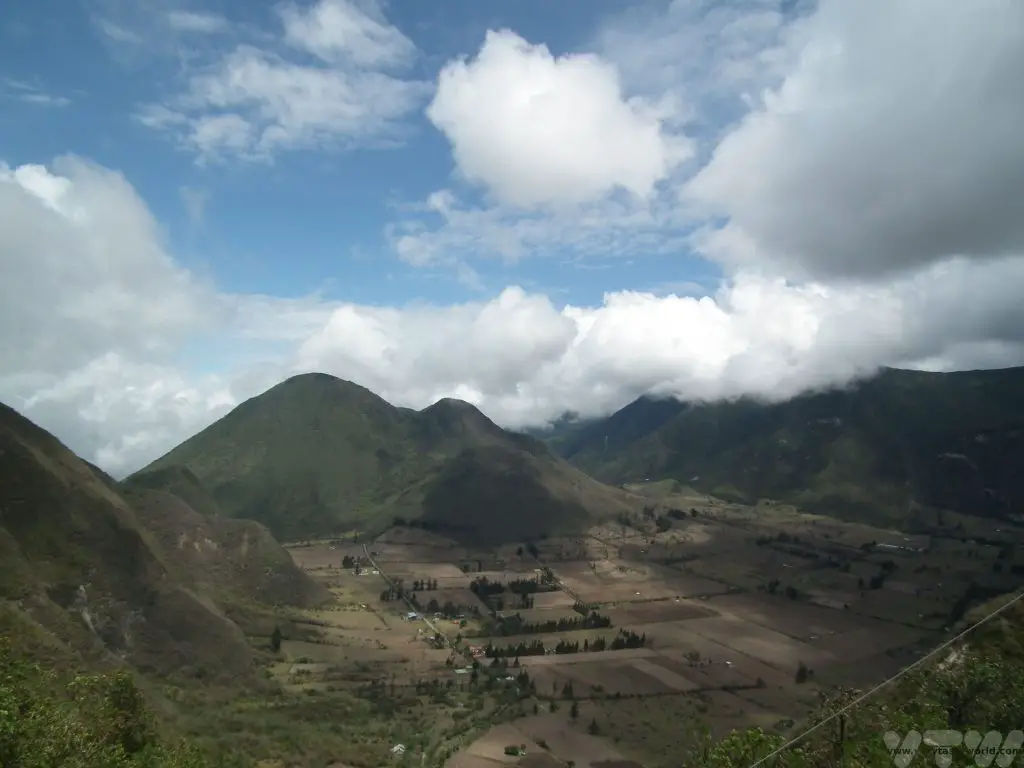
Back in Quito, the Teleferico offers a cable car lift to the top of Cruz Loma which affords fantastic views across the city as well as ‘Volcanoes Avenue’, a splendid vista revealing fourteen peaks across the Andes… if the weather is co-operating. Otherwise it’s a nice ride up and down a mountain in a cable car! It’s located in Pichincha and the site also offers an amusement park, restaurants, a shopping centre and other activities, so there’s plenty to do if the views aren’t spectacular.
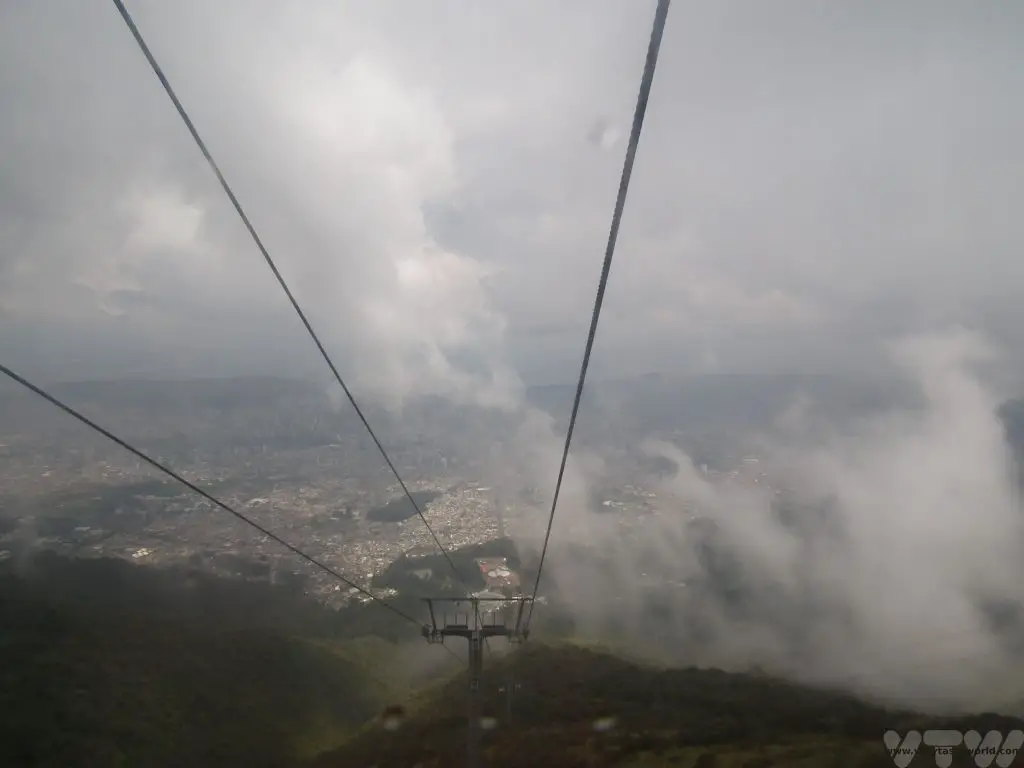
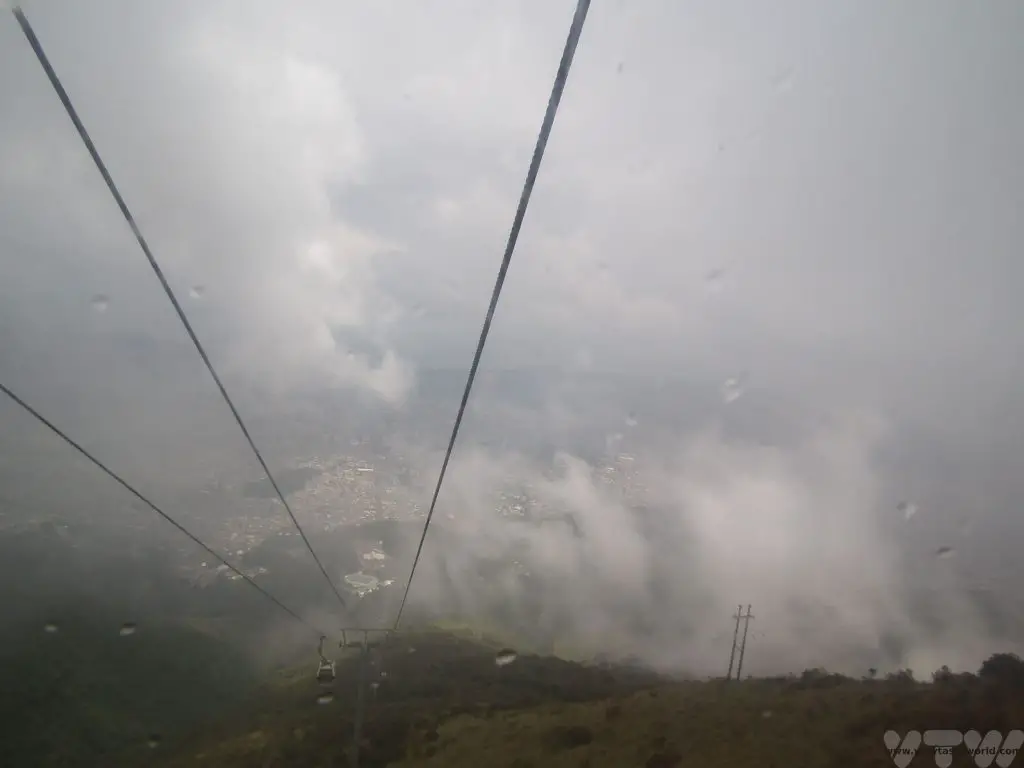
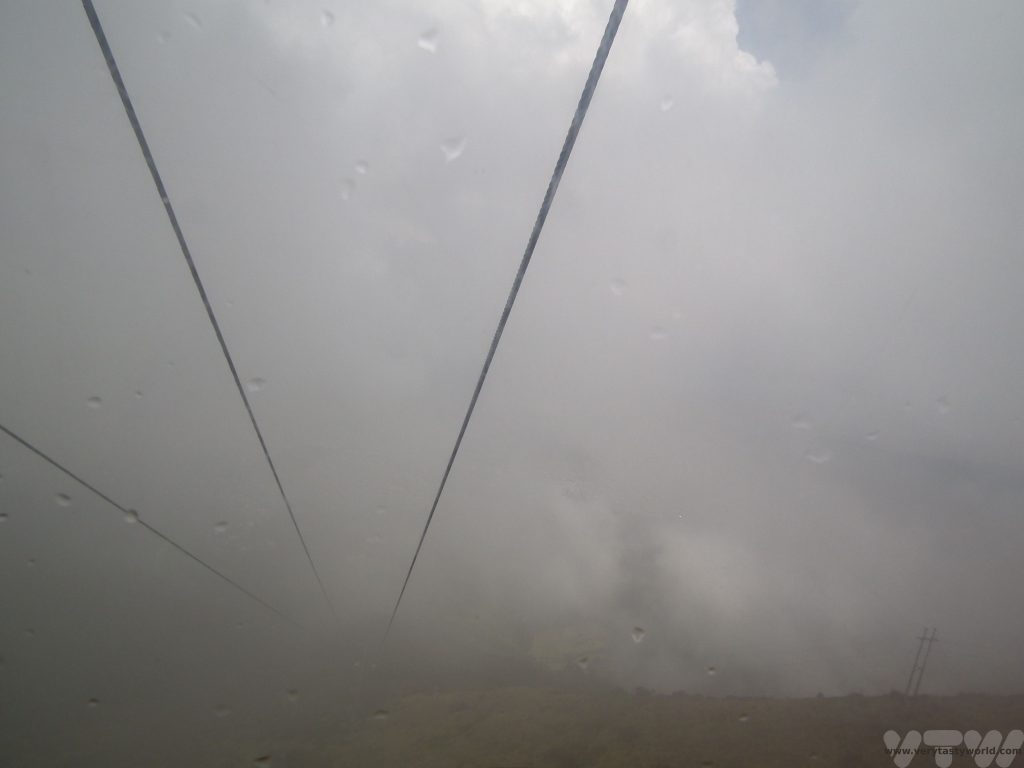
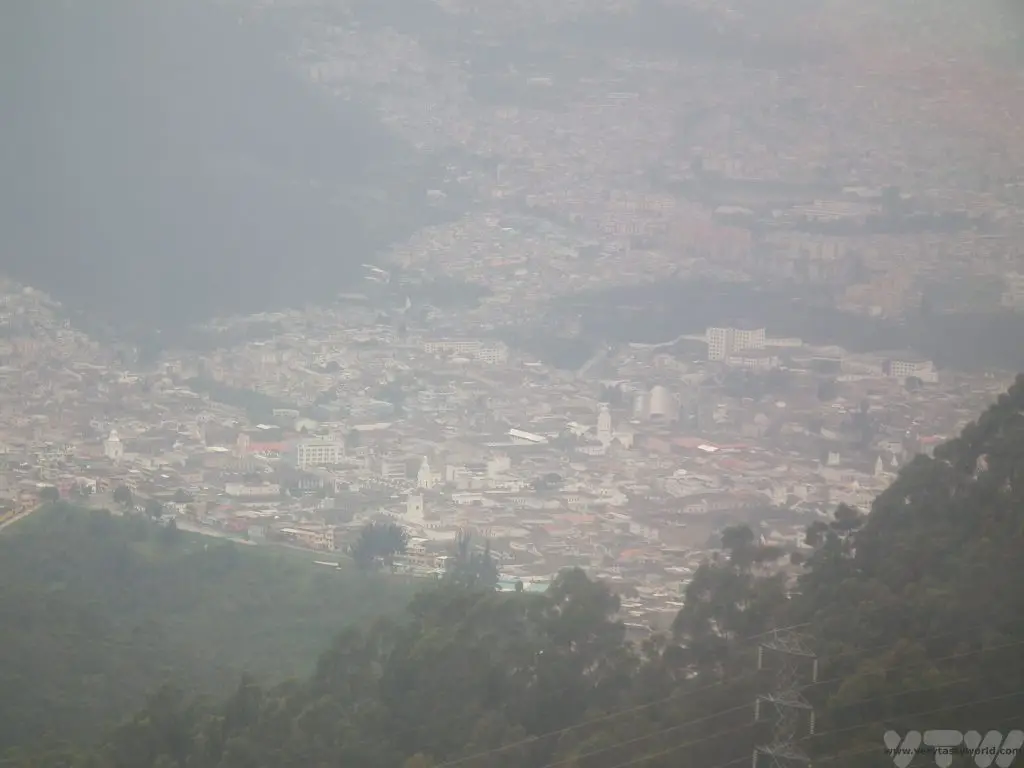
A slightly more unusual stop was a visit to the Fundación Guayasamín Museum, the house with an adjacent art gallery of local artist Oswaldo Guayasamín, widely considered to be one of Ecuador’s greatest artists. The house is located on a hill overlooking Quito in the Bellavista neighbourhood and has been left as he lived in it. It contains many artworks; his own as well as an impressive collection of pre-Columbian, colonial and modern art, and you can also see his studio. We were invited to watch a video about the artist so that we could learn about his life and works.
The adjacent gallery, known as the Chapel of Man, has an exterior on the form of a massive cube with a conical dome atop. Inside it offers multiple levels in which to explore a range of artworks. Guayasamín’s art is big and bold and very much reflects Ecuadorian landscapes and culture. He was also particularly interested in the inequalities in society and many of his works are powerful – and moving – representations of injustice. Photography wasn’t allowed inside the gallery.
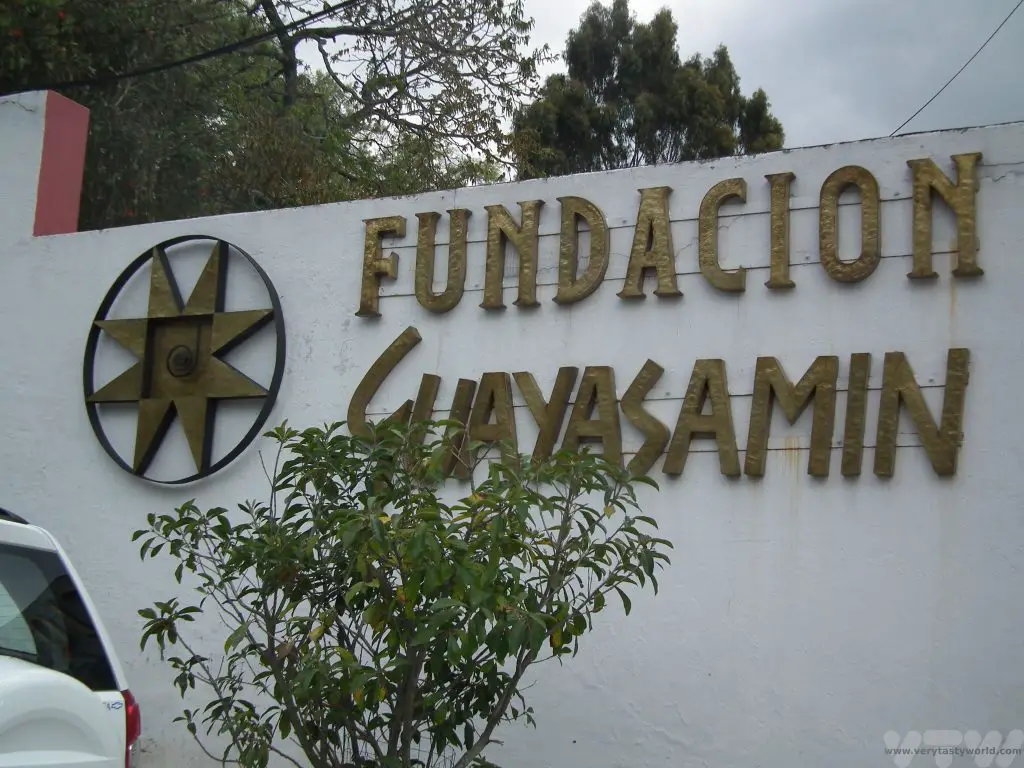

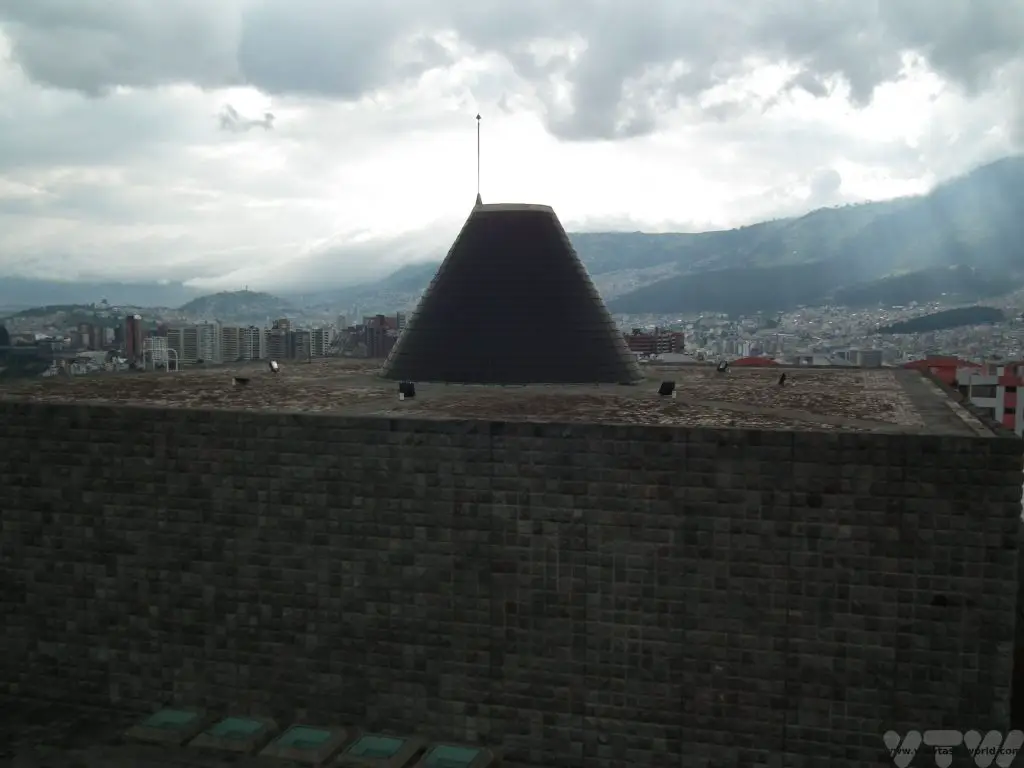
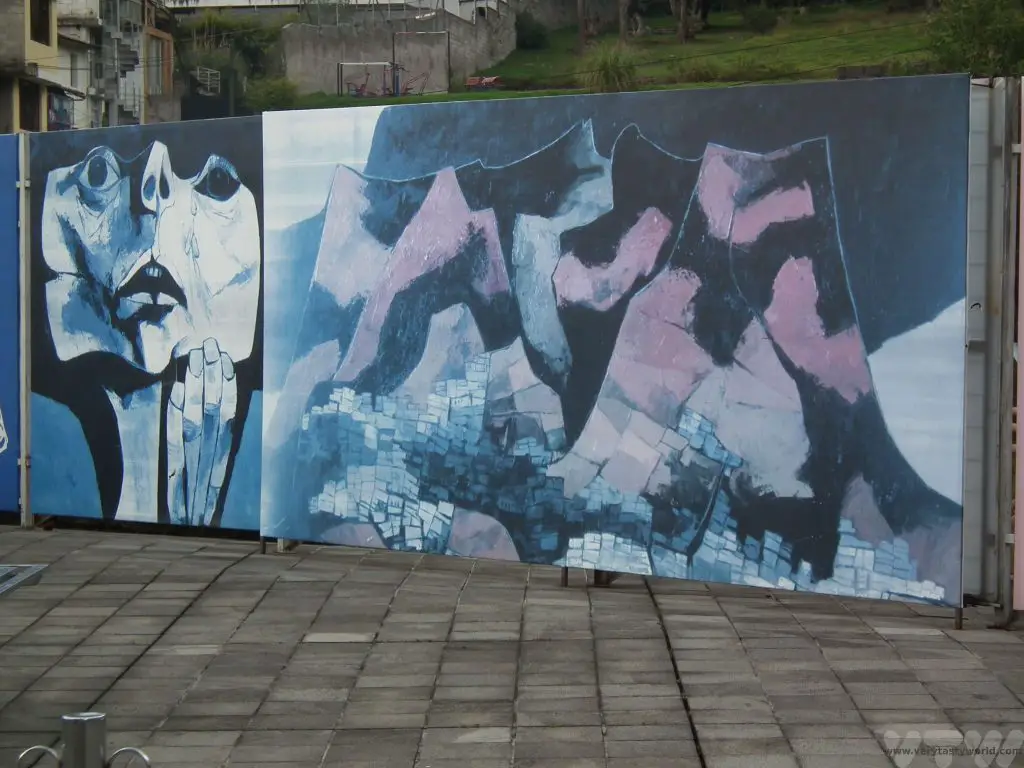
Visit Quito – Day Trips Further Out
There are loads of day trips to explore the area surrounding Quito. Again, your accommodation will likely be able to help you find and book a trip that suits your interests, even if it might be at quite short notice. (We arrived from the airport late in the afternoon and managed to organise a day trip for the following morning.) Many companies offer coach trips that can pick you up from your accommodation (and a whole bunch of other tourists up from their accommodation, so bear in mind that the first hour of the trip could well involve sitting on a coach collecting people – which was fine for us as we could doze for a bit to catch up with the jetlag). But the greater the number of people that join the excursion, the lower the cost, and it’s often nice to have company on a day trip as well. Full day trips usually include lunch at a local restaurant.
Quilotoa Crater Lake
This was a full day trip, primarily to see the crater lake, which is located some 180 km from Quito. The journey takes a couple of hours direct from Quito, so other activities were incorporated into the trip to break up the day.
First stop was a market where we could see local produce for sale…
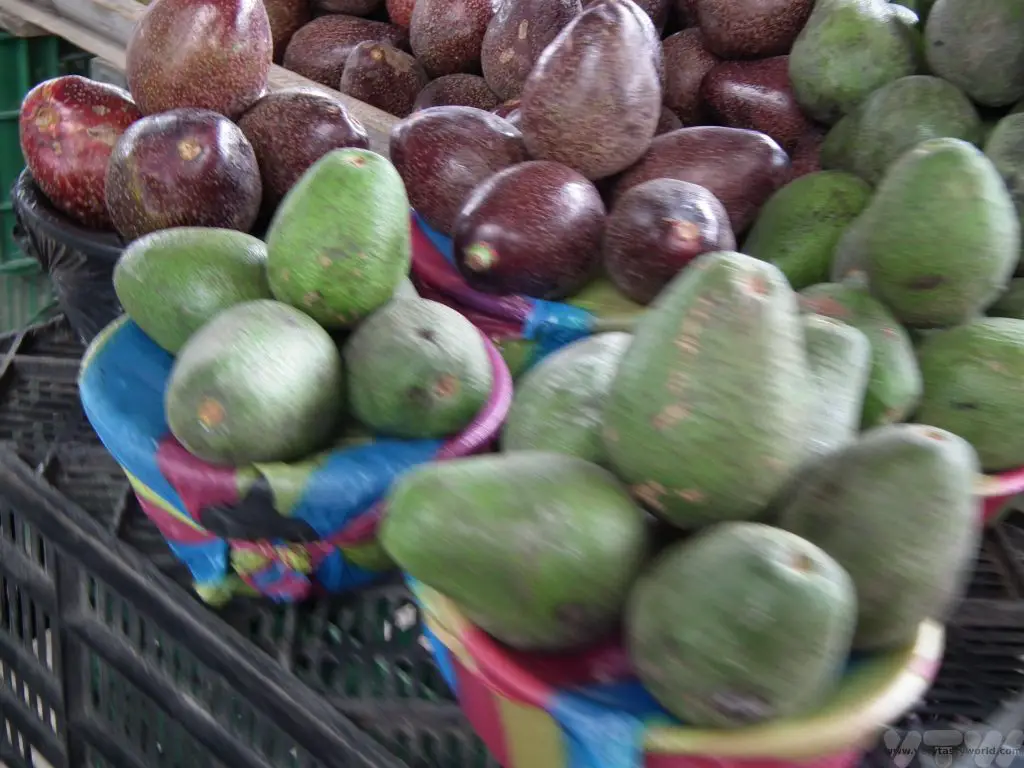
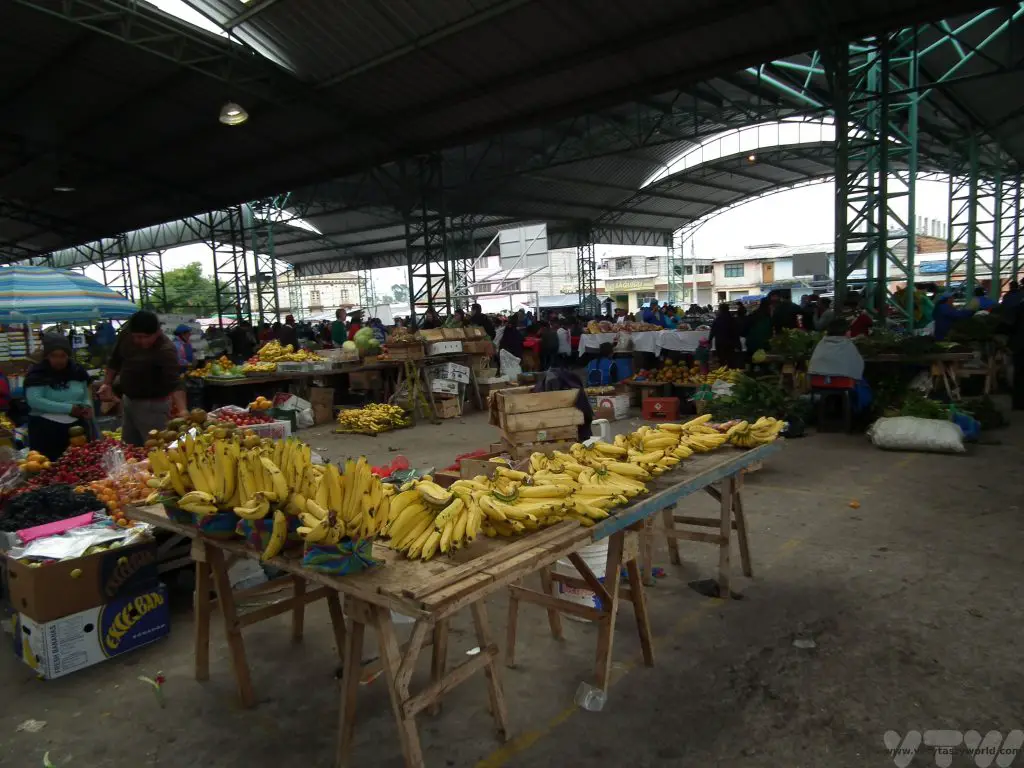
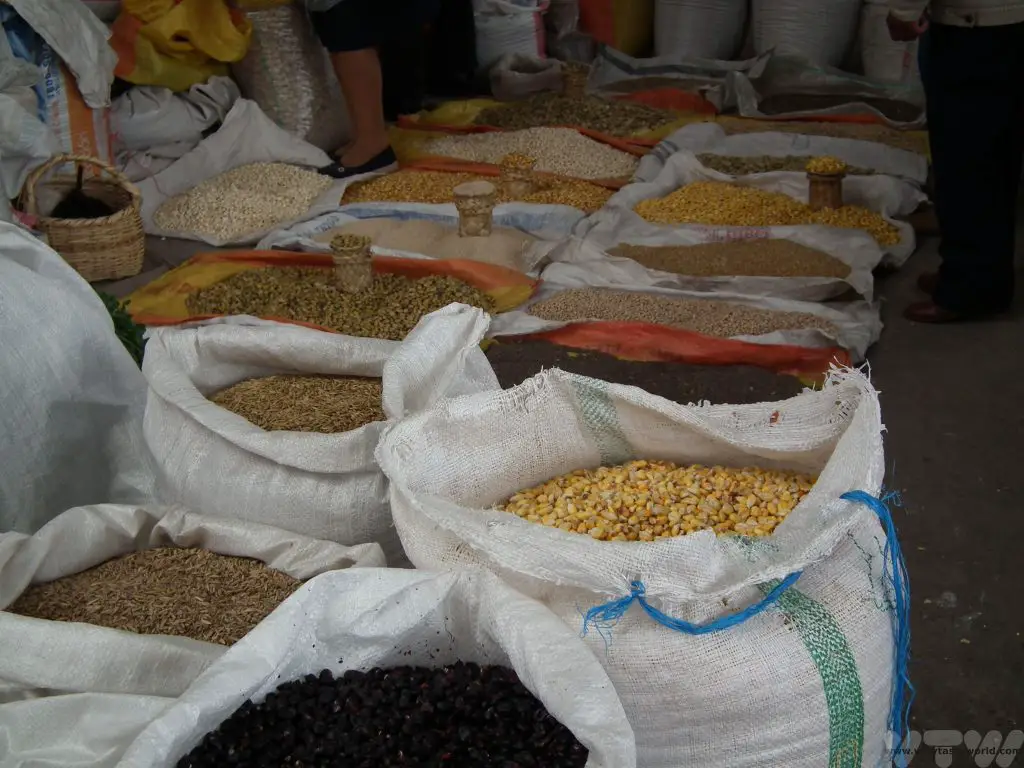
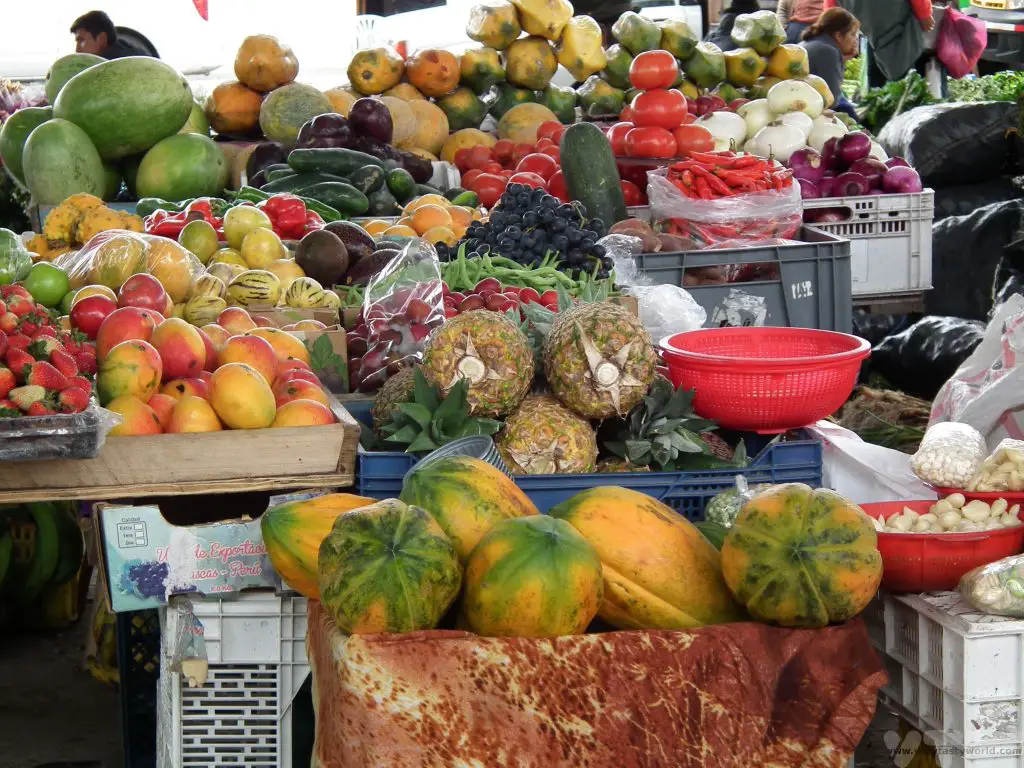
…And then onto the lake itself. It’s a caldera caused by the collapse of the volcano when it erupted in 1280. The crater filled with water over the years and now forms a lake, some 3km in diameter. It is possible to walk around the rim on a trail (it’s about 7.5 km) but we didn’t have enough time for this, so there’s a pleasant half hour stroll to the lake itself. It’s worth remembering that you are at altitude so the hike back up to the rim may take longer if you have not yet acclimatised. Also bear in mind that the sun is strong, even on a cloudy day, so make sure you have sun protection. The caldera itself is beautiful.
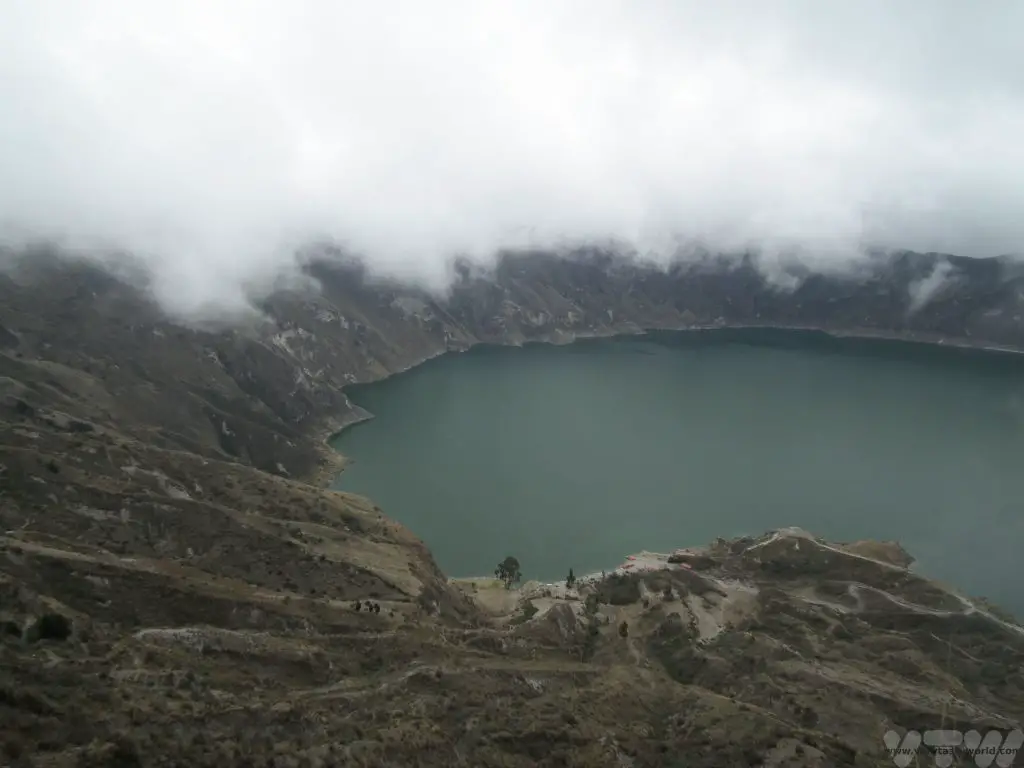
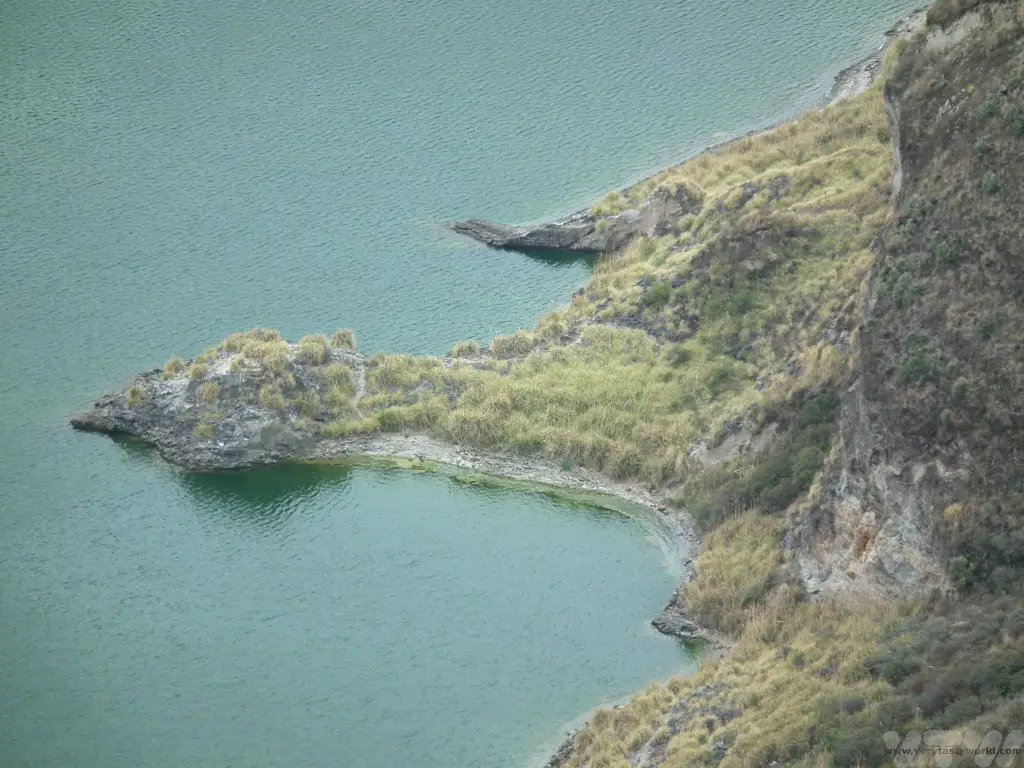
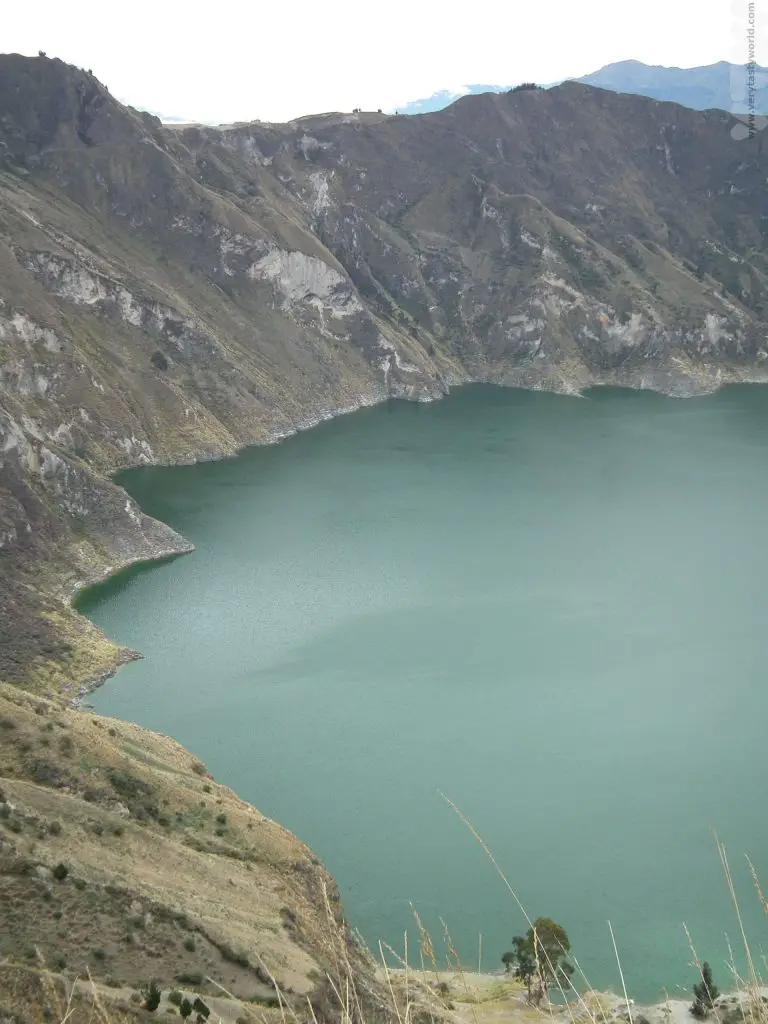
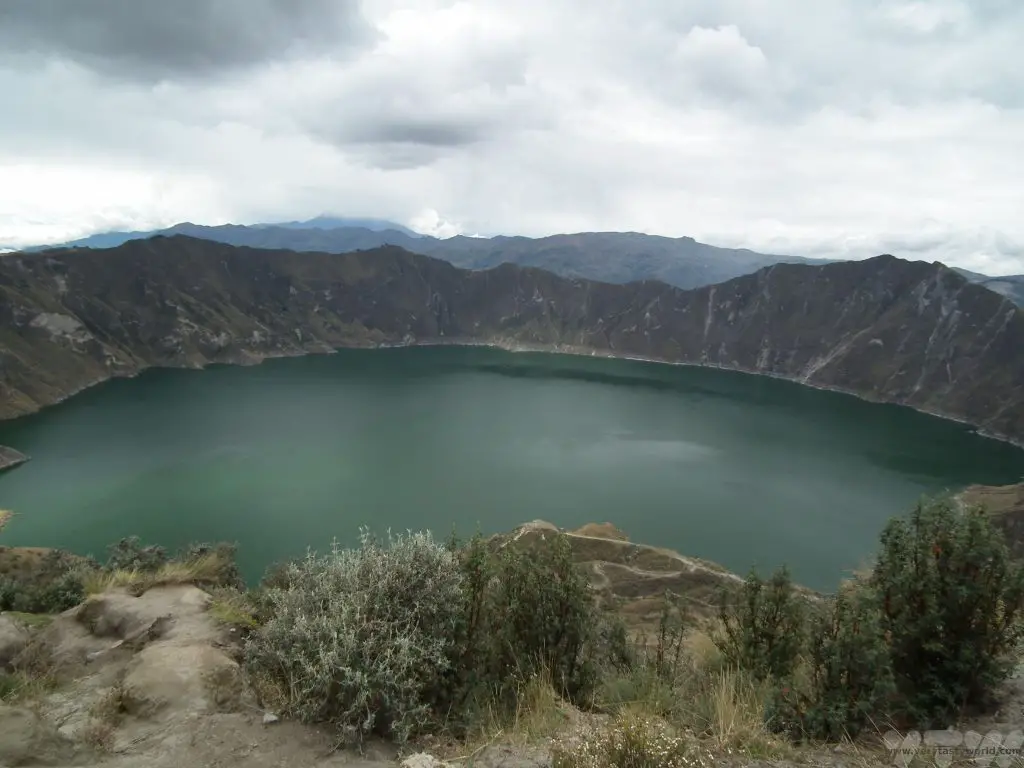
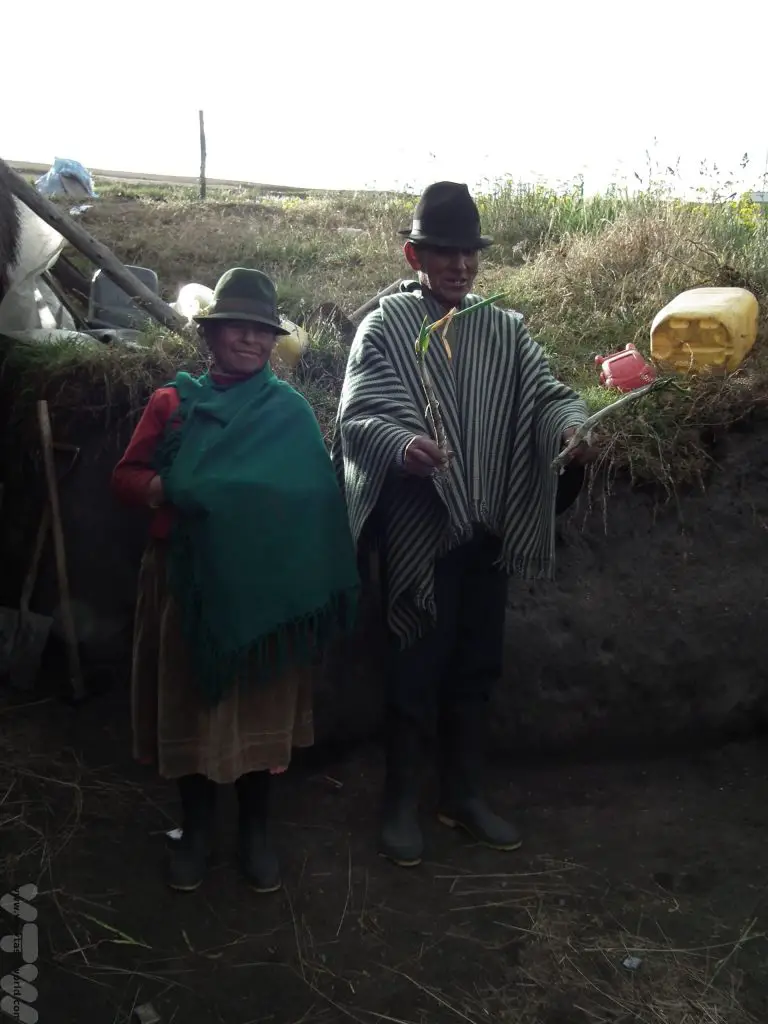
We also stopped off at Tigua to visit a local family home.
And in the late afternoon, as we headed back into Quito to do the reverse of the hotel pickups, we just happened to pass by the Cotopaxi volcano at sunset so the driver stopped off to let us all have a photo stop. Well, with a view like this it would have been rude not to.
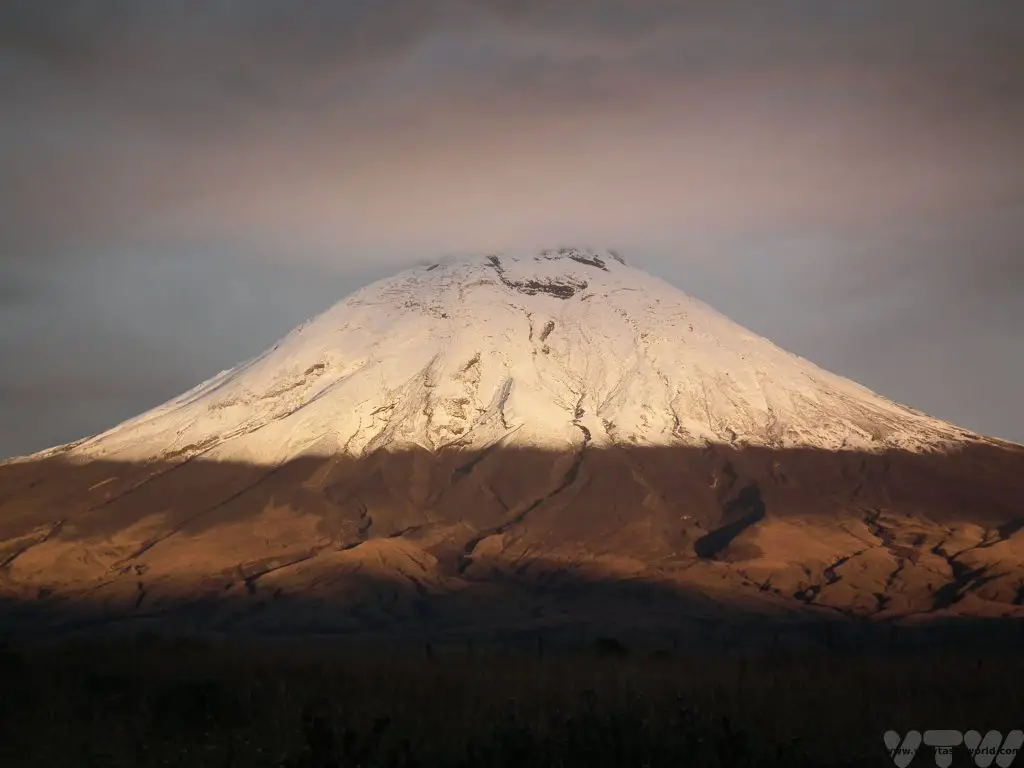
It’s also worth noting there are lots of trips and activities at Cotopaxi – from climbing up it to mountain biking down it (at vast speed) as well as horse riding and jeep tours. Local tour operators and hotels will be available to find something that suits.
Bellavista Cloud Forest
We had long wanted to visit a cloud forest and booked directly with the organisation. They arranged a pick-up from our hotel in the central district – very early in the morning – to take us and a group of other people on a drive to the cloud forest that took a couple of hours. After breakfast at the lodge we embarked on a guided walk. Unfortunately the best time to see the birds is around 6:30am – about the time of our Quito pickup. Some people stay overnight in order to be able to take the early morning walks in order to get a greater chance of viewing the birds. It’s also worth noting that we found the experience to be expensive. Still, the walk was lovely and the guide knowledgeable. These are actually colour photos but the forest was so wonderfully cloudy they have an evocative black and white feel to them.
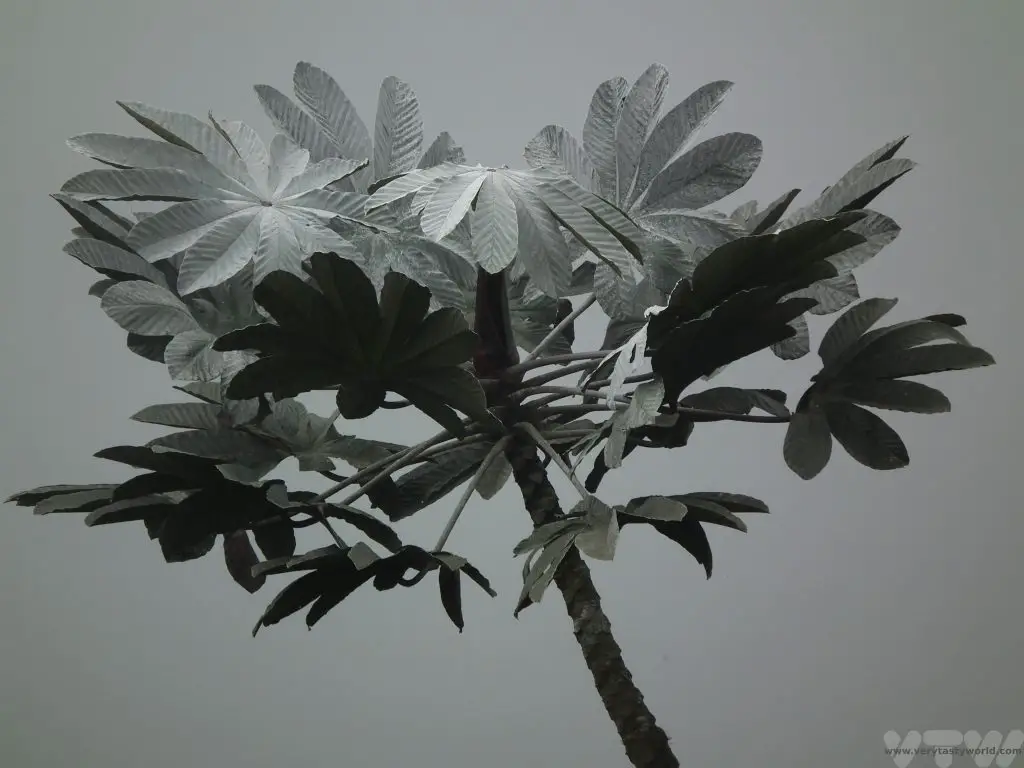


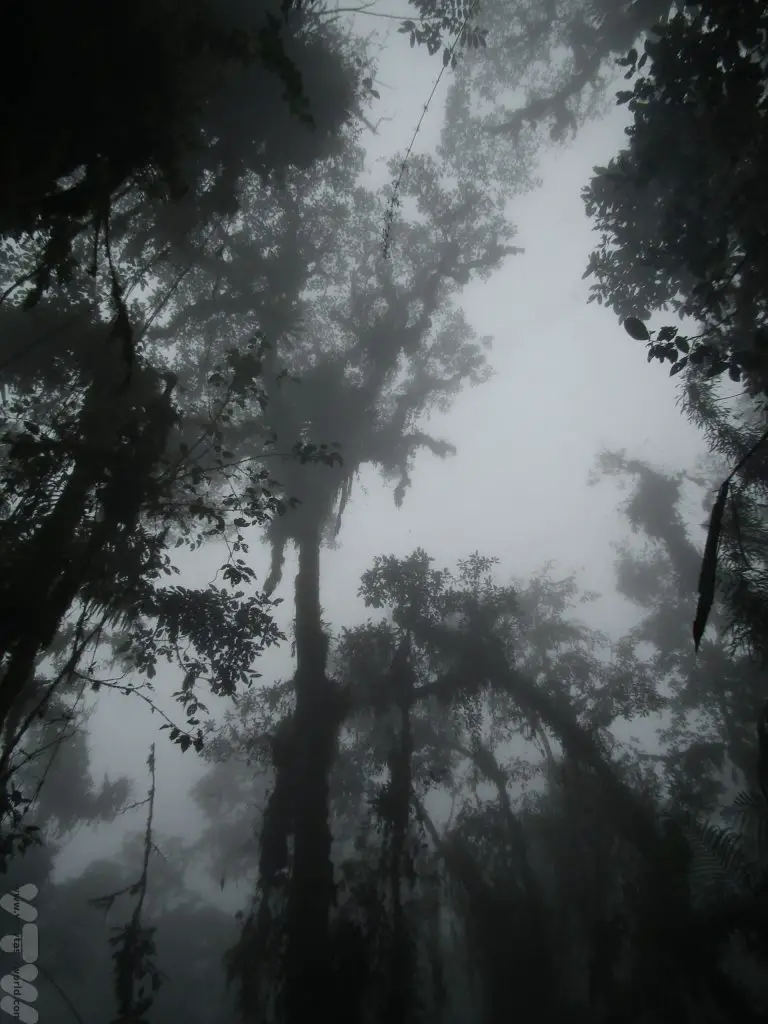
It was also nice to be able to see gorgeously colourful and beautifully iridescent hummingbirds, and other birds, using the feeders that were located around the lodge, flitting, darting and hovering.
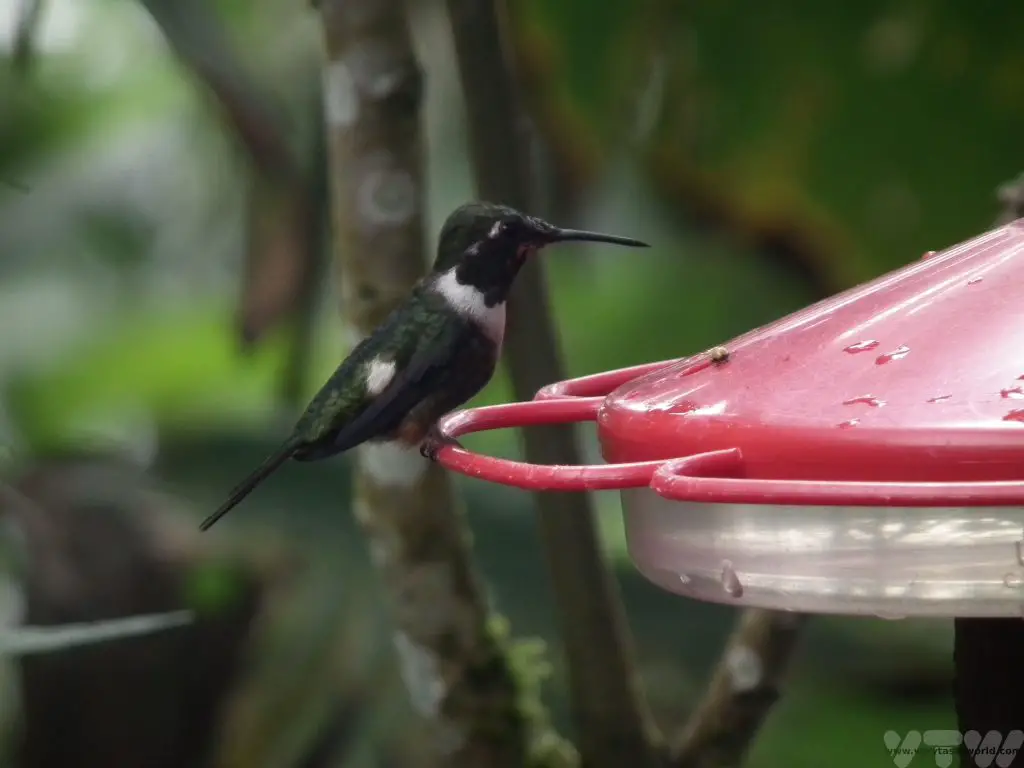
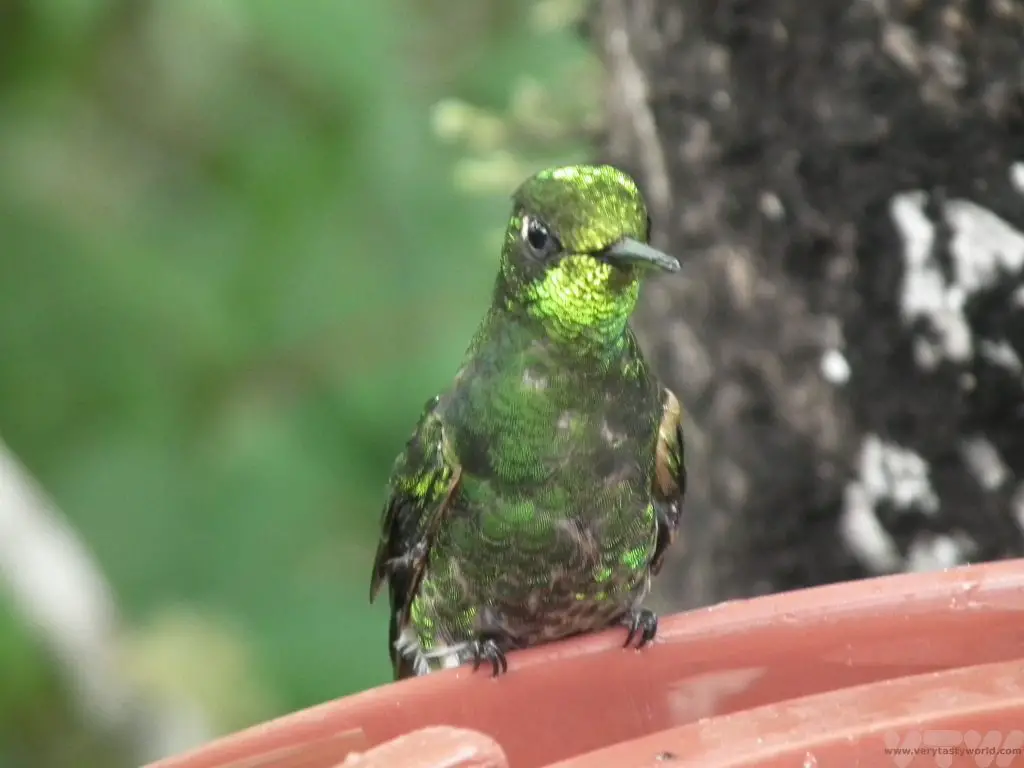
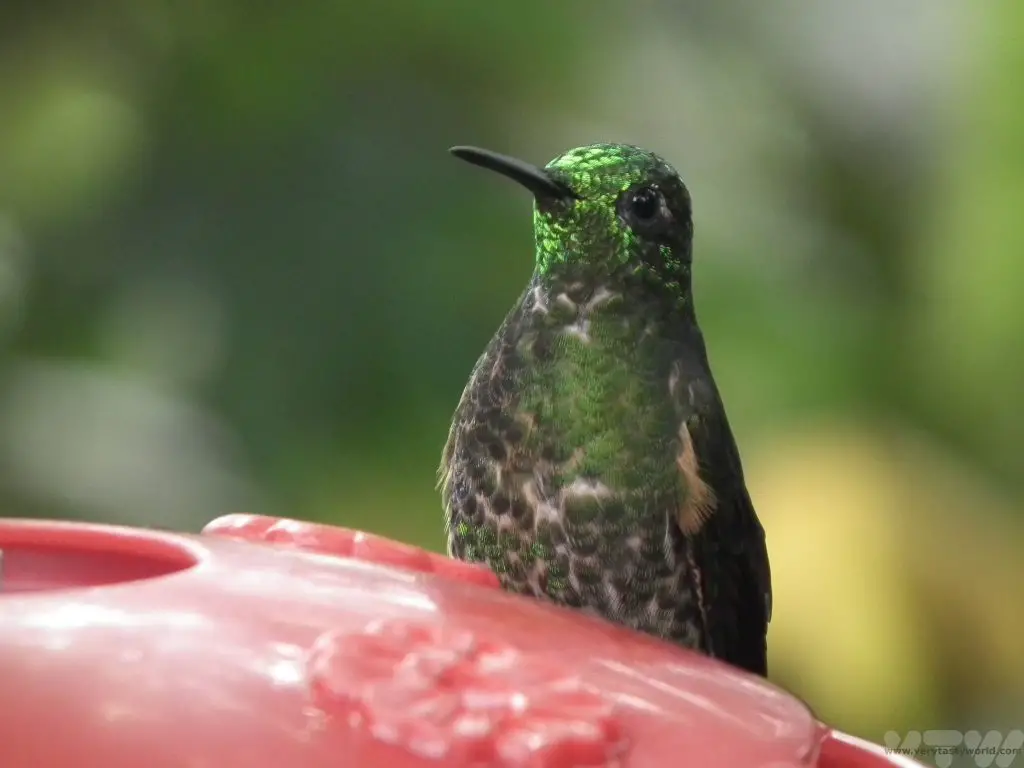
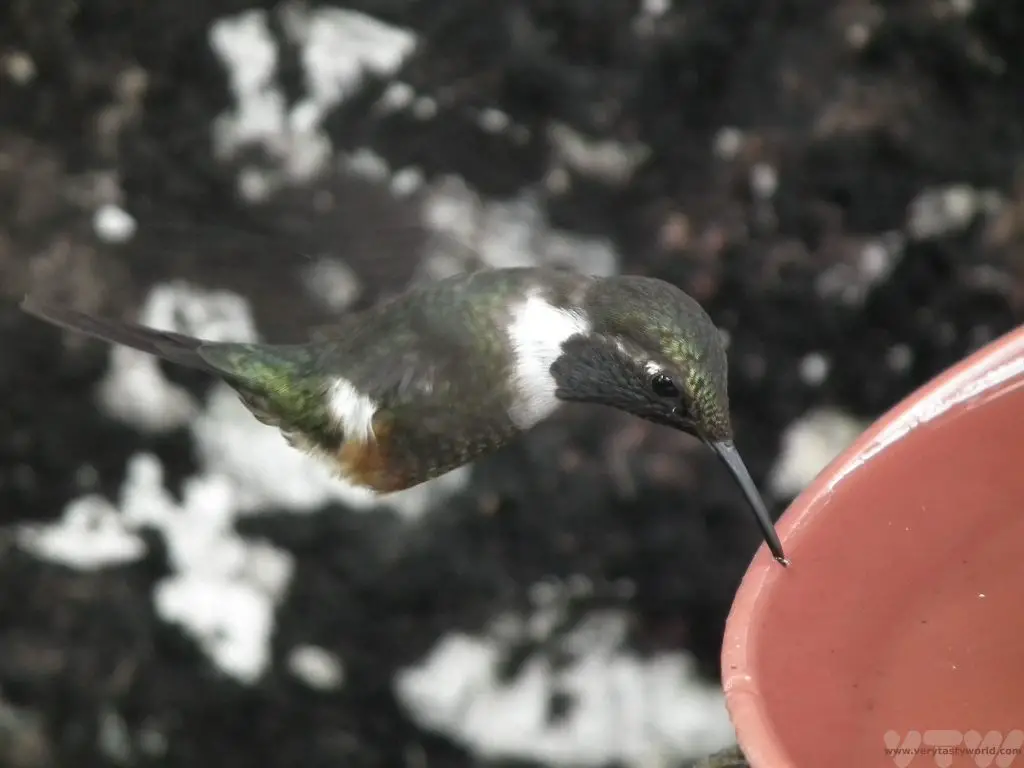
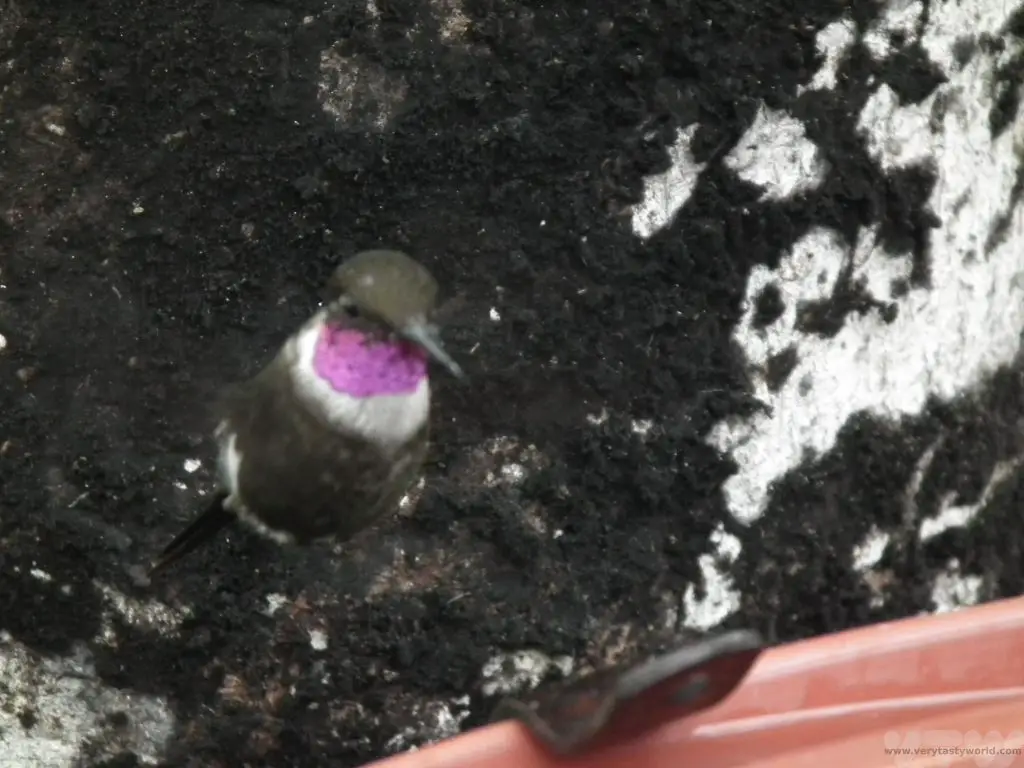
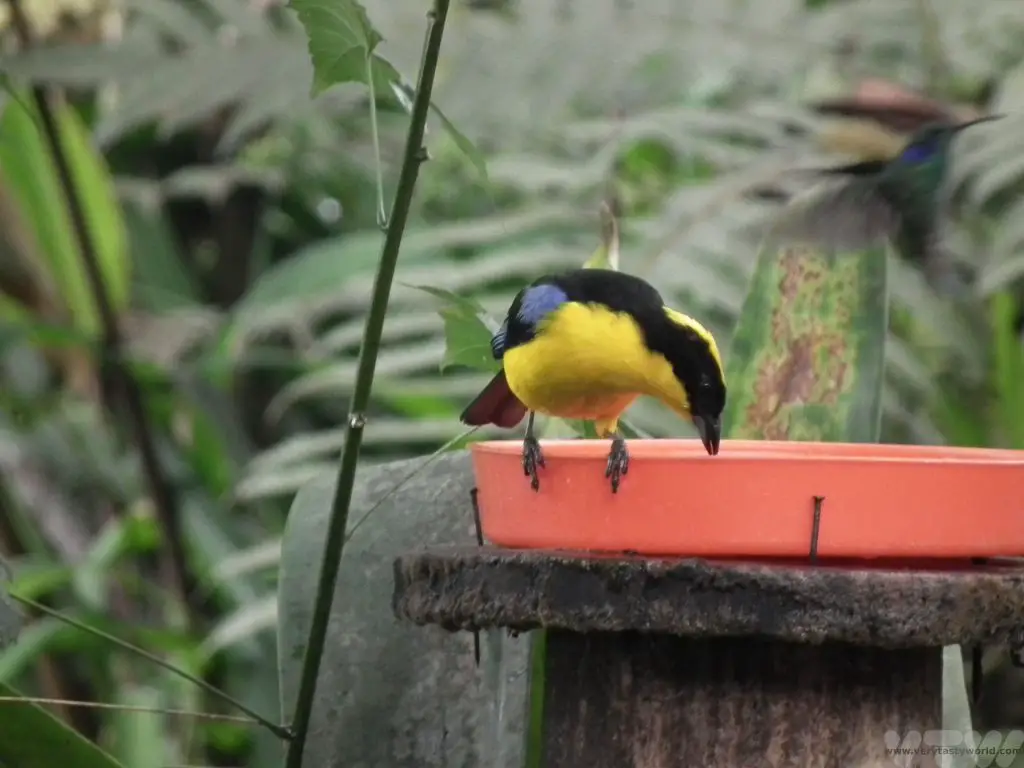
Even if the Galapagos are your primary reason for visiting Ecuador, there are loads of activities in the area when you visit Quito – whether wildlife, activity or cultural – and it is definitely worth incorporating these into your itinerary if you have time.
Related Posts You May Enjoy

- Best Time To Visit Machu Picchu 2024 Update
- A 2 Week Patagonia Itinerary
- Day of the Dead in Campeche
- A Galapagos Land Based Itinerary
- RECIPE: How to Make Costa Rica’s Gallo Pinto
- A Tasty Puebla Food Tour
- Costa Rica Wildlife Sanctuary – Caño Negro
- Visit Torres del Paine National Park in Patagonia
- Atacama Desert Itinerary






